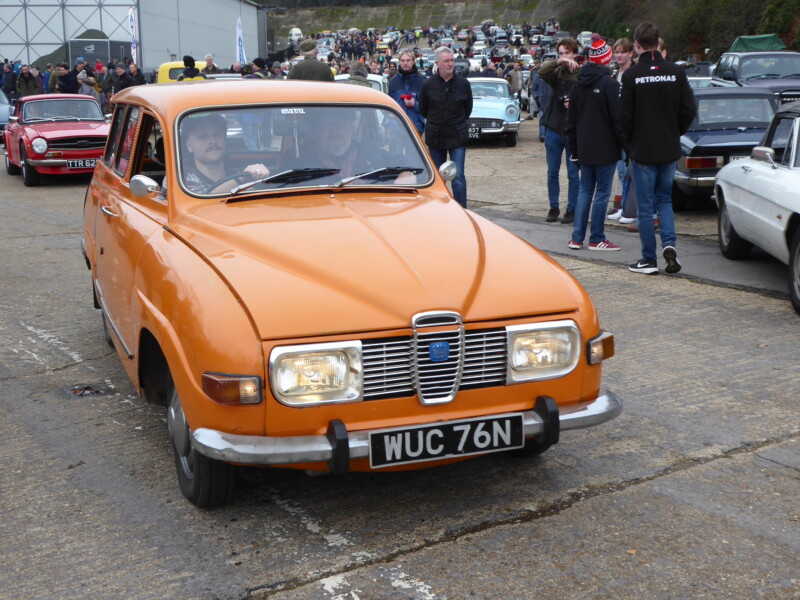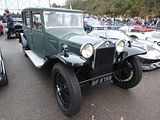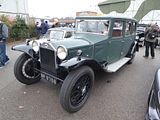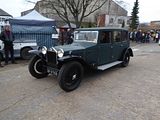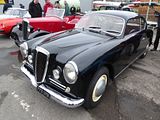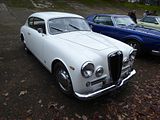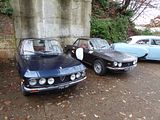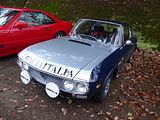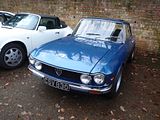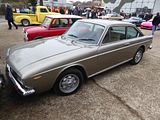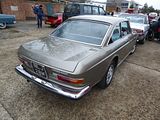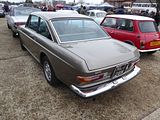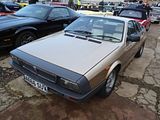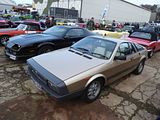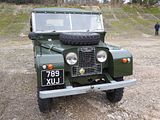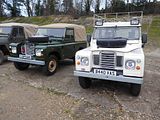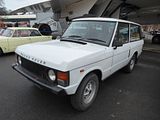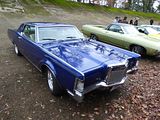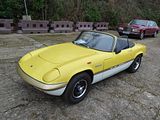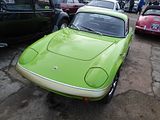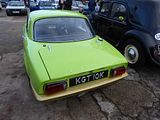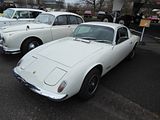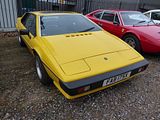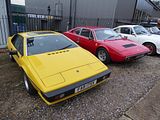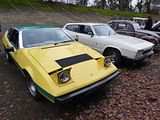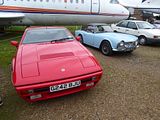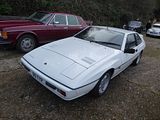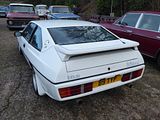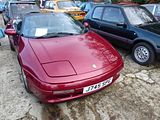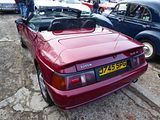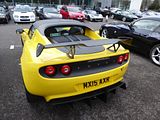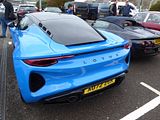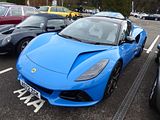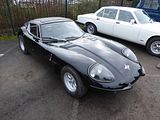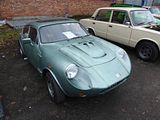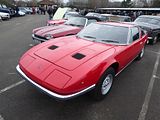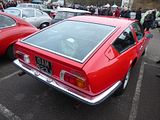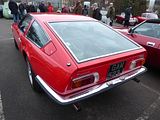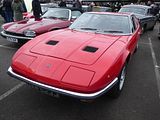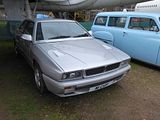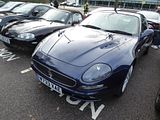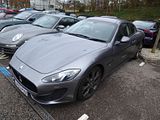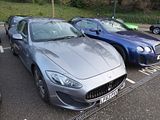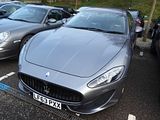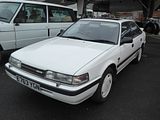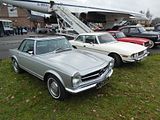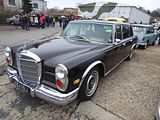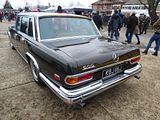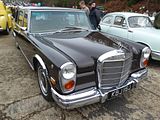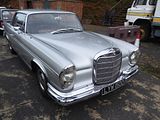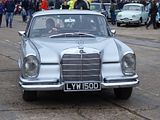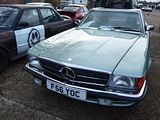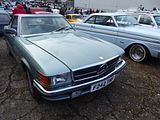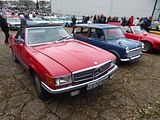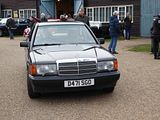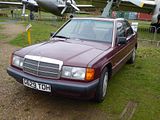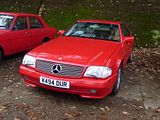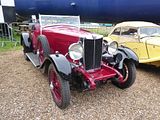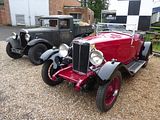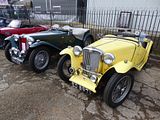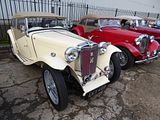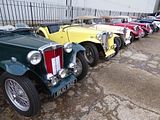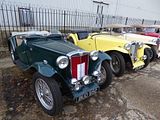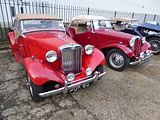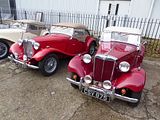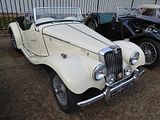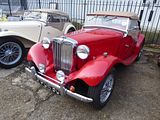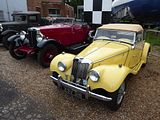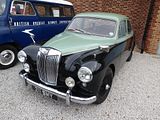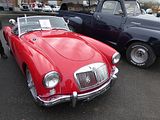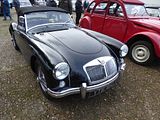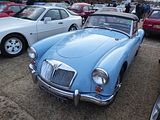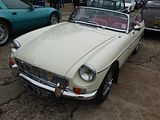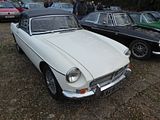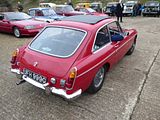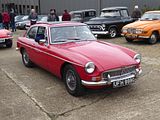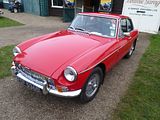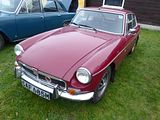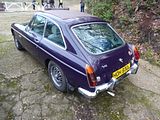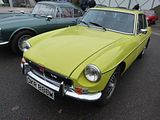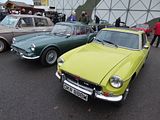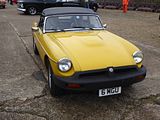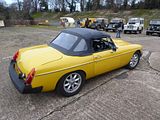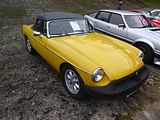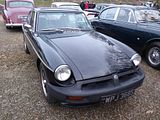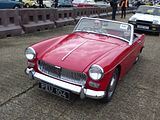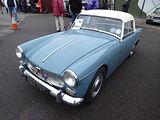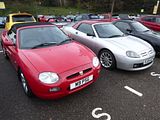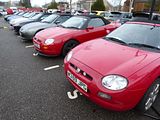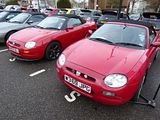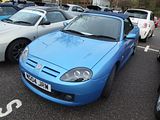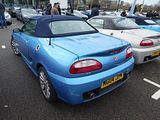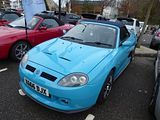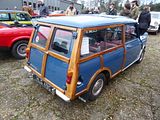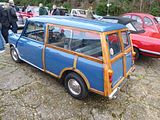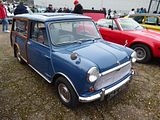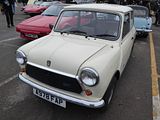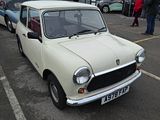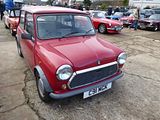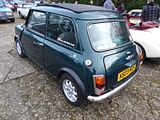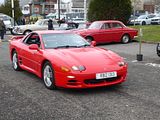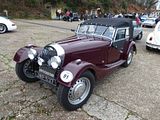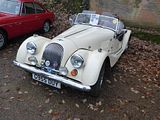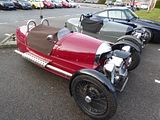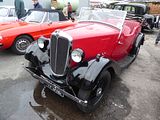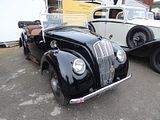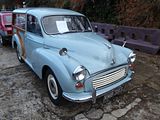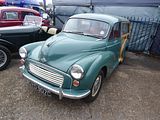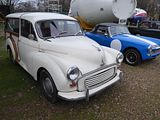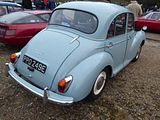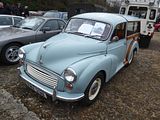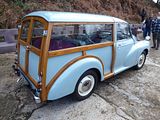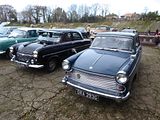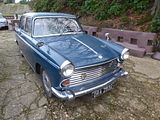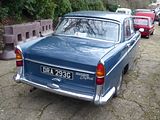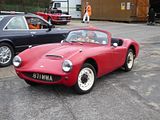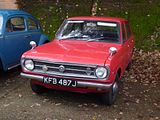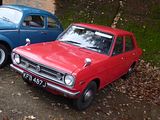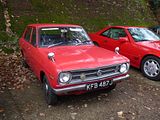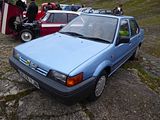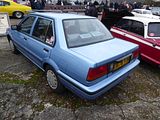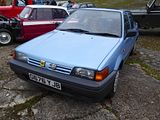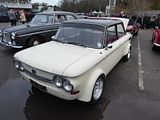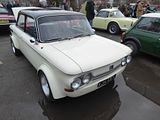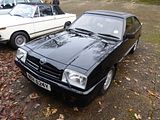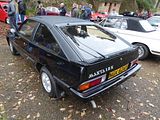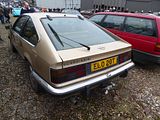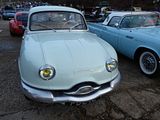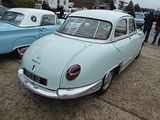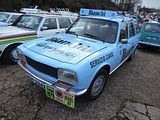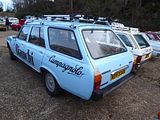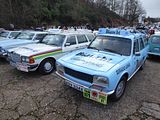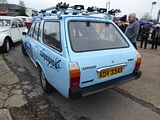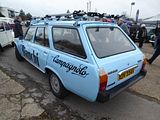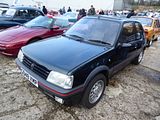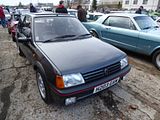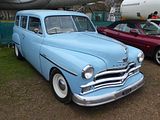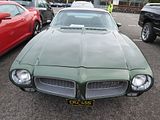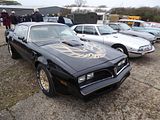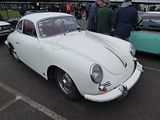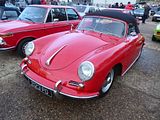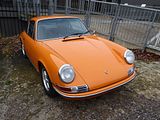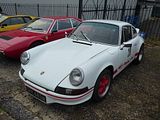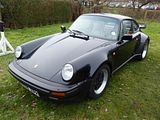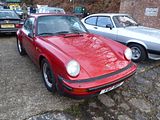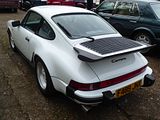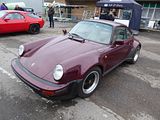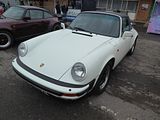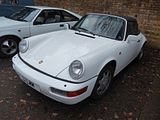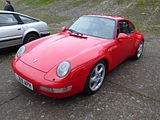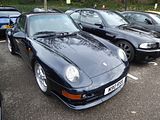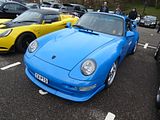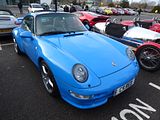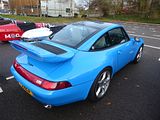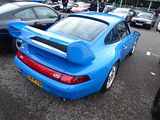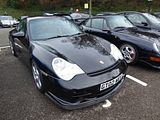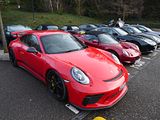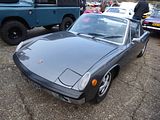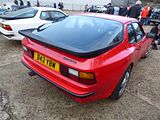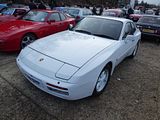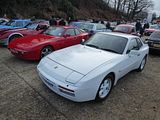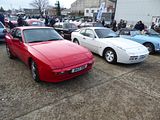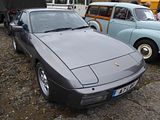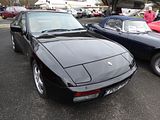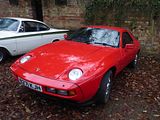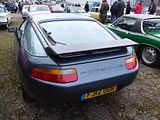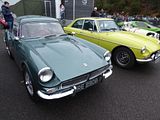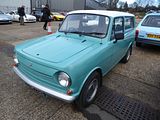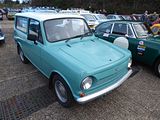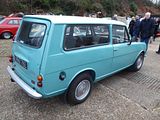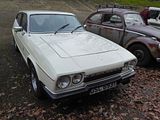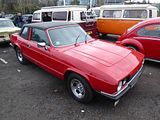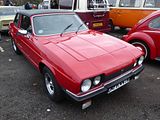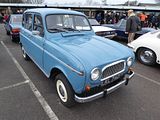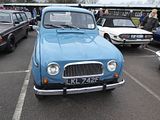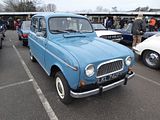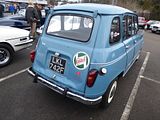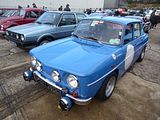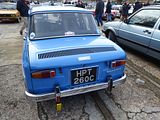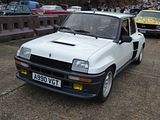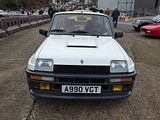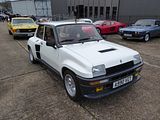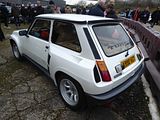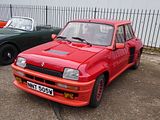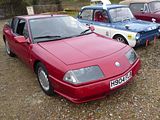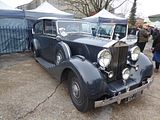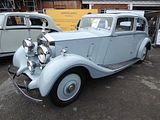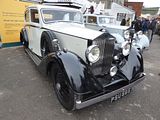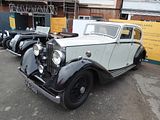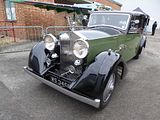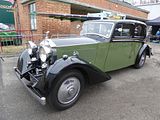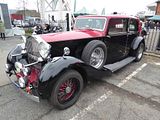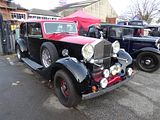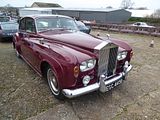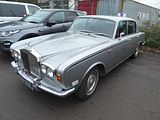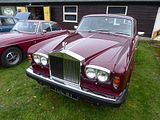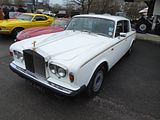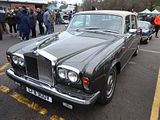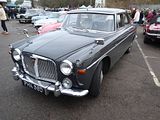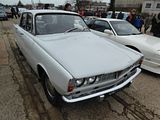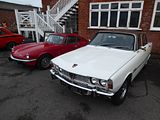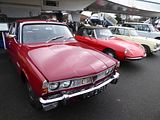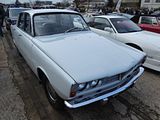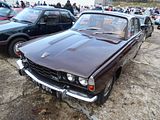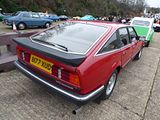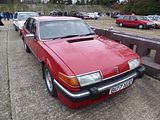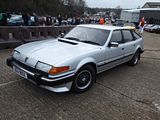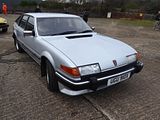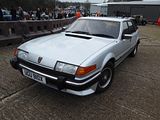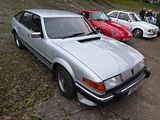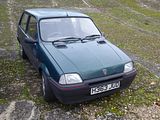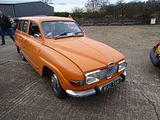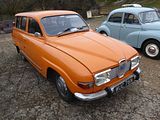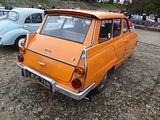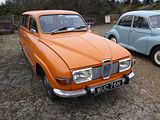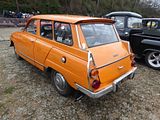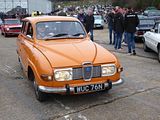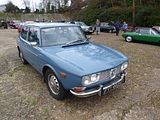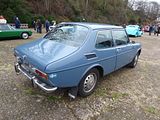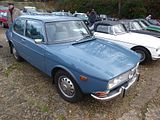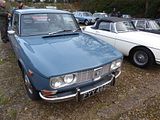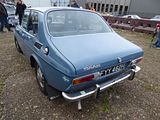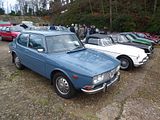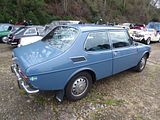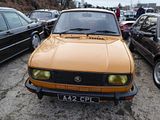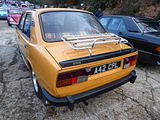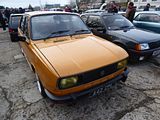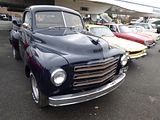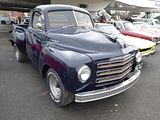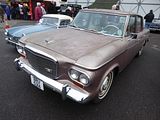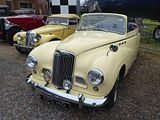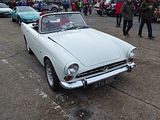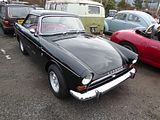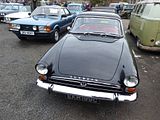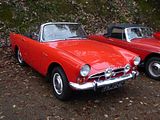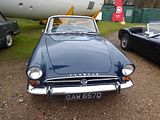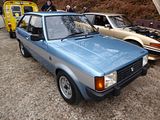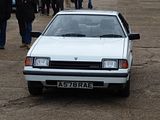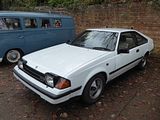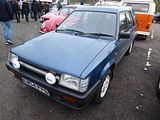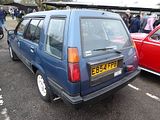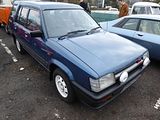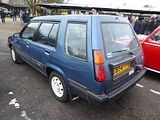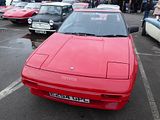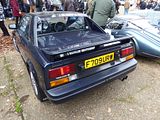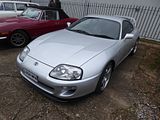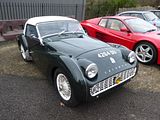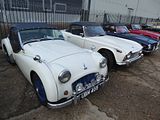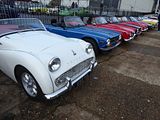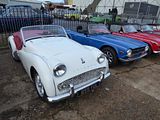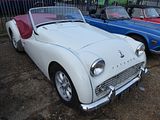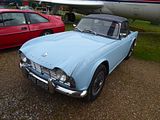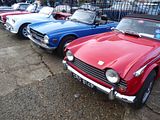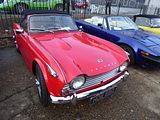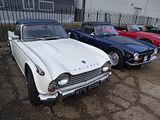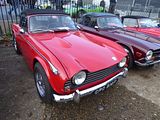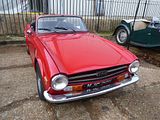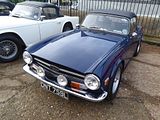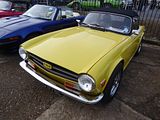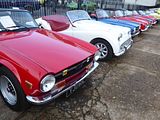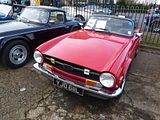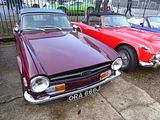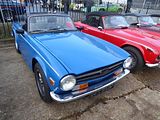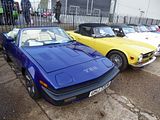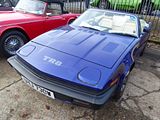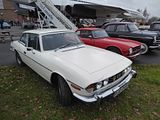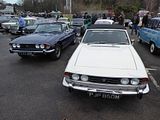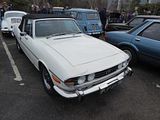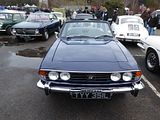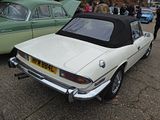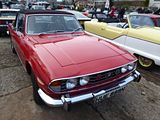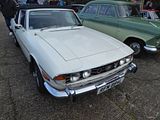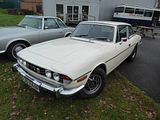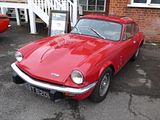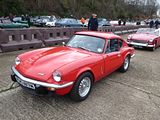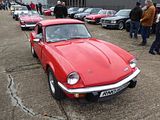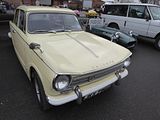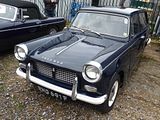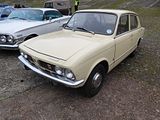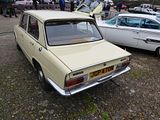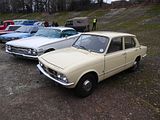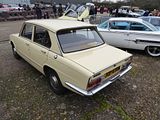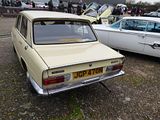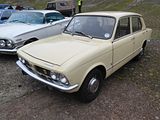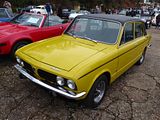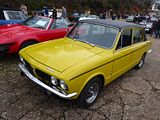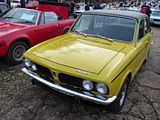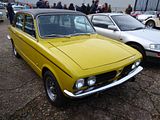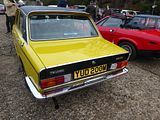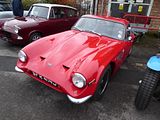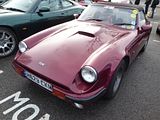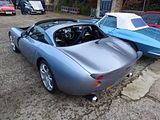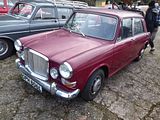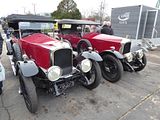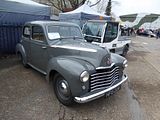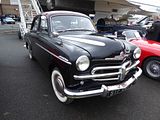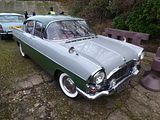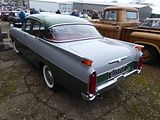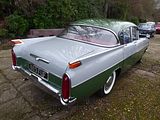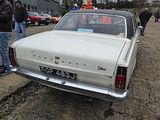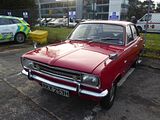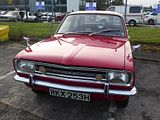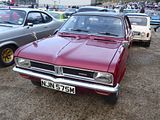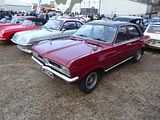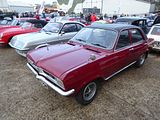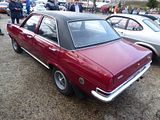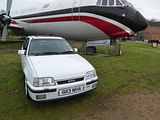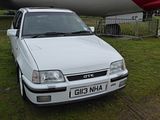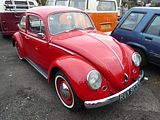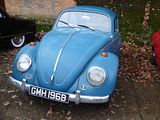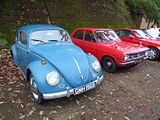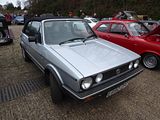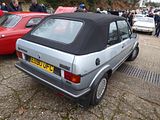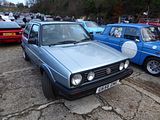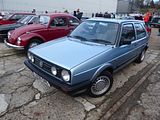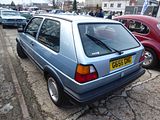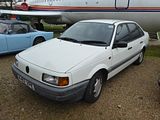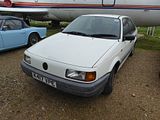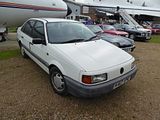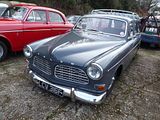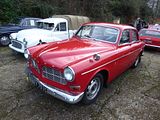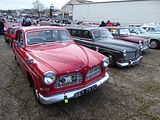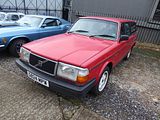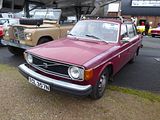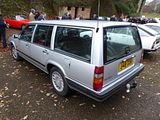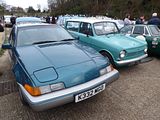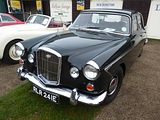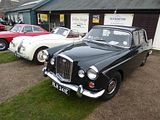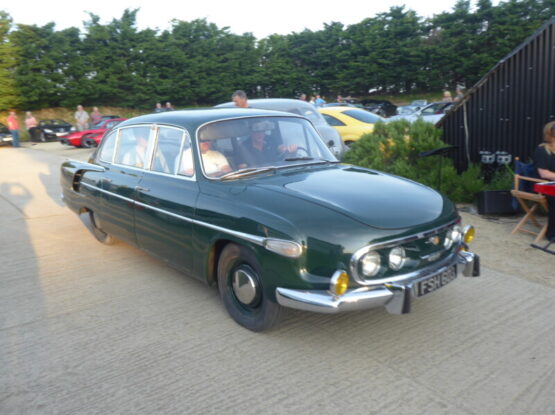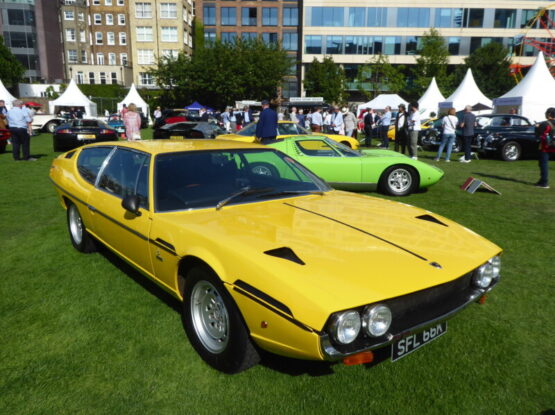LANCIA
One of the best-known of pre-war Lancia is the Lambda, an innovative car which was first shown in 1922. A number of these were present. Built in 9 series over a 10 year period, the Lambda pioneered a number of technologies that soon became commonplace in our cars. For example, it was the first car to feature a load-bearing monocoque-type body, (but without a stressed roof) and it also pioneered the use of an independent suspension (the front sliding pillar with coil springs).Vincenzo Lancia even invented a shock absorber for the car and it had excellent four wheel brakes. The narrow angle V4 engine which powered is not something which was widely copied. Approximately 11,200 Lambdas were produced. Most of them had the open Torpedo style body, but some of the last Series 8 and 9 cars had Weyman saloon bodies.
Designed by Vittorio Jano, the Lancia Aurelia was launched in 1950 and production lasted until the summer of 1958. The very first Aurelias were the B10 Berlinas. They used the first production V6 engine, a 60° design developed by Francesco de Virgilio who was, between 1943 and 1948 a Lancia engineer, and who worked under Jano. The first cars had a capacity of 1754 cc, and generated 56 hp. During production, capacity grew from 1.8 litres to 2.5 litres across six distinct Series. Prototype engines used a bore and stroke of 68 mm x 72 mm for 1569 cc; these were tested between 1946 and 1948. It was an all-alloy pushrod design with a single camshaft between the cylinder banks. A hemispherical combustion chamber and in-line valves were used. A single Solex or Weber carburettor completed the engine. Some uprated 1991 cc models were fitted with twin carburettors. At the rear was an innovative combination transaxle with the gearbox, clutch, differential, and inboard-mounted drum brakes. The front suspension was a sliding pillar design, with rear semi-trailing arms replaced by a de Dion tube in the Fourth series. The Aurelia was also first car to be fitted with radial tyres as standard equipment. Aurelia was named after Via Aurelia, a Roman road leading from Rome to France. The B21 version was released in 1951 with a larger 1991 cc 70 hp engine and a 2-door B20 GT coupé appeared that same year. It had a shorter wheelbase and a Ghia-designed, Pininfarina-built body. The same 1991 cc engine produced 75 hp in the B20. In all, 500 first series Aurelias were produced. This is generally believed to the first car to use the name GT, or Gran Turismo. The B20 GT Aurelia had a successful career in motorsport, too. In the 1951 Mille Miglia the 2-litre Aurelia, driven by Giovanni Bracco and Umberto Maglioli, finished 2nd beaten only by the Ferrari America. The same year it took first in class and 12th overall at LeMans. Modified Aurelias took the first three places on 1952’s Targa Florio with Felice Bonetto as the winner and another win on Lièges-Rome-Lièges of 1953.
Lancia replaced the long-running Appia with a new model in 1963, the Fulvia. Like the larger Flavia which had been shown 3 years earlier, it came with front wheel drive, and a host of exquisite engineering which ensure that even though it was expensive, it was actually not profitable for its maker, and was a direct contribution to the marque’s bankruptcy and take over by Fiat in 1969. It was not long before the initial Berlina saloon model was joined by a Coupe. First seen in 1965. the Coupe proved to be the longest lived of all Fulvia variants, surviving until 1976 when it was effectively replaced by the 1300cc version of the Beta Coupe. Before that, it had undergone a steady program of updates, with more powerful engines, including a capacity increase from the initial 1200cc of the narrow angle V4 to 1300 and then later 1600cc, and the car was developed into a successful rally machine for the late 60s. The Sport Zagato version was designed by Ercole Spada at Zagato and was intended to be the more sporting model of the range. It was also considerably more expensive. Early cars had an unusual side hinged bonnet, but this was changed on the Series 2 models which were launched in 1970, and which also switched to all-steel bodies. Seen here was a nice Coupe in S3 guise.
The Flavia was updated further in 1971, an evolution of the Series II Flavia Coupé and a stable mate to the 2000 Berlina model The car’s bodyshell was designed and made by Pininfarina. The interior was also designed by Pininfarina and bears a striking resemblance to that of the Ferrari 330 GT. The cosmetic changes to the 2000 Coupé were largely confined to a new grille (matte black instead of chrome) with headlamps incorporated into the now wider intake, new bumpers (with rubber strips on the HF), and the tail was shorn of its vestigial tailfins, with a raised and squared decklid. The interior did not undergo significant changes, merely refinement of the previous design. The powerplant was adopted from the 2000 sedan and available in two states of tune: carburettors on the 2000 Coupé, Bosch electronic fuel injection and engine management on the 2000 HF which raised its output to 123 bhp, which was the same as contemporary BMW and Alfa Romeo models. This improvement, however, was never publicised by Lancia because the marketing department believed that their targeted customers would less favourably respond to a campaign that emphasised power and performance rather than quality, technical sophistication and riding comfort. The HF was recognizable by the body-side rub-strip, wooden Nardi steering wheel, and magnesium alloy wheels by Cromodora. Both versions had a 5-speed manual transmission with a dog-leg gearbox arrangement. The Lancia 2000 and 2000 HF coupé were technologically advanced for the day with features such as 5 speed transmission, power assisted steering and electronic fuel injection on the 2000 HF. The cars offer sporty but also very refined and comfortable transport and are very capable in modern traffic and motorway cruising. They are very well appointed with polished stainless steel brightwork, as opposed to chromed mild steel. The 2000 and 2000 HF Coupé are considered to be some of the last true Lancia cars, designed before Fiat took control of the company in 1969. The cars do not suffer the corrosion problems associated with later generation Lancias and are generally regarded as being more resistant than contemporary rivals from other manufacturers. The cars were expensive when new and hence only sold in small numbers, and they are particularly rare now, so seeing one of these elegant machines was a real treat.
Considered to be part of the Beta family, though there is an awful lot about the car that is very different from the front wheel drive models was the MonteCarlo, no fewer than eight examples of which were displayed. First conceived in 1969, with a a final design completed by 1971 by Paolo Martin at Pininfarina, what was initially known as the Fiat X1/8 Project, was originally designed as Pininfarina’s contender to replace Fiat’s 124 Coupe, but it lost out to Bertone’s cheaper design, which became the Fiat X1/9. Rather than scrap the proposal completely, it was developed further, when Fiat commissioned Pininfarina to build a 3.0 litre V6 mid-engined sports car. An X1/8 chassis was used as the start point, and developed for the first time in-house by Pininfarina and not based on any existing production car. Due to the 1973 Oil Crisis, the project was renamed X1/20 and updated to house a 2.0 litre engine. The first car to be made out of the X1/20 Project was the Abarth SE 030 in 1974. The project was passed to Lancia, and the road car was launched at the 1975 Geneva Motor Show as the Lancia Beta MonteCcarlo. It was the first car to be made completely in-house by Pininfarina. Lancia launched the MonteCarlo as a premium alternative to the X1/9, with the 2 litre twin cam engine rather than the X1/9’s single cam 1300. Both used a similar, based on the Fiat 128, MacPherson strut front suspension and disc brakes at both front and rear. Lancia Beta parts were limited to those from the existing Fiat/Lancia standard parts bin, the transverse mount version of the Fiat 124’s twin cam engine and the five speed gearbox and transaxle. MonteCarlos were available as fixed head “Coupés” and also as “Spiders” with solid A and B pillars, but a large flat folding canvas roof between them. Sales were slow to get started, and it soon became apparent that there were a number of problems with a reputation for premature locking of the front brakes causing particular alarm. Lancia suspended production in 1979 whilst seeking a solution, which meant that the car was not produced for nearly two years. The second generation model, known simply as MonteCarlo now, was first seen in late 1980. The braking issue was addressed by removing the servo, as well as few other careful mechanical tweaks. The revised cars also had glass panels in the rear buttresses, improving rear visibility somewhat, and there was a revised grille. In the cabin there was a new three spoke Momo steering wheel in place of the old two spoke one, as well as revamped trim and fabrics. The engine was revised, with a higher compression ratio, Marelli electronic ignition and new carburettors which produced more torque. It was not enough for sales to take off, and the model ceased production in 1982, although it took quite a while after that to shift all the stock. Just under 2000 of the Phase 2 cars were made, with 7798 MonteCarlos made in total.
LAND ROVER
The Land Rover was conceived by the Rover Company in 1947 during the aftermath of World War II. Before the war Rover had produced luxury cars which were not in demand in the immediate post-war period and raw materials were strictly rationed to those companies building construction or industrial equipment, or products that could be widely exported to earn crucial foreign exchange for the country. Also, Rover’s original factory in Coventry had been bombed during the war, forcing the company to move into a huge “shadow factory” built just before the war in Solihull near Birmingham, previously used to construct Bristol Hercules aircraft engines. This factory was now empty but starting car production there from scratch would not be financially viable. Plans for a small, economical car known as the M Type were drawn up, and a few prototypes made, but would be too expensive to produce. Maurice Wilks, Rover’s chief designer came up with a plan to produce a light agricultural and utility vehicle, of a similar concept to the Willys Jeep used in the war, but with an emphasis on agricultural use. He was possibly inspired by the Standard Motor Company, who faced similar problems and were producing the highly successful Ferguson TE20 tractor in their shadow factory in Coventry. More likely, he used his own experience of using an army-surplus Jeep on his farm in Anglesey, North Wales. His design added a power take-off (PTO) feature since there was a gap in the market between jeeps and tractors (which offered the feature but were less flexible as transport). The original Land Rover concept (a cross between a light truck and a tractor) is similar to the Unimog, which was developed in Germany during this period. The first prototype had a distinctive feature — the steering wheel was mounted in the middle of the vehicle. It hence became known as the “centre steer”. It was built on a Jeep chassis and used the engine and gearbox out of a Rover P3 saloon car. The bodywork was handmade out of an aluminium/magnesium alloy called Birmabright, to save on steel, which was closely rationed. The choice of colour was dictated by military surplus supplies of aircraft cockpit paint, so early vehicles only came in various shades of light green. The first pre-production Land Rovers were being developed in late 1947 by a team led by engineer Arthur Goddard. Tests showed this prototype vehicle to be a capable and versatile machine. The PTO drives from the front of the engine and from the gearbox to the centre and rear of the vehicle allowed it to drive farm machinery, exactly as a tractor would. It was also tested ploughing and performing other agricultural tasks. However, as the vehicle was readied for production, this emphasis on tractor-like usage decreased and the centre steering proved impractical in use. The steering wheel was mounted off to the side as normal, the bodywork was simplified to reduce production time and costs and a larger engine was fitted, together with a specially designed transfer gearbox to replace the Jeep unit. The result was a vehicle that didn’t use a single Jeep component and was slightly shorter than its American inspiration, but wider, heavier, faster and still retained the PTO drives. The Land Rover was designed to only be in production for two or three years to gain some cash flow and export orders for the Rover Company so it could restart up-market car production. Once car production restarted, however, it was greatly outsold by the off-road Land Rover, which developed into its own brand that remains successful today. Many of the defining and successful features of the Land Rover design were in fact the result of Rover’s drive to simplify the tooling required for the vehicle and to use the minimum amount of rationed materials. As well as the aluminium alloy bodywork (which has been retained throughout production despite it now being more expensive than a conventional steel body due to its ideal properties of light weight and corrosion resistance) other examples include the distinctive flat body panels with only simple, constant-radius curves (originally used because they could be cut and formed by hand from aluminium sheet on a basic jig) and the sturdy box-section ladder chassis, which on series vehicles was made up from four strips of steel welded at each side to form a box, thus cutting down on the complex operations required when making a more conventional U- or I-section frame. Land Rover entered production in 1948 with what has later been termed the Series I. This was launched at the Amsterdam Motor Show. It was designed for farm and light industrial use, with a steel box-section chassis and an aluminium body. Originally the Land Rover was a single model offering, which from 1948 until 1951 used an 80-inch wheelbase and a 1.6-litre petrol engine producing around 50 bhp. The four-speed gearbox from the Rover P3 was used, with a new two-speed transfer box. This incorporated an unusual four-wheel-drive system, with a freewheel unit (as used on several Rover cars of the time). This disengaged the front axle from the manual transmission on the overrun, allowing a form of permanent 4WD. A ring-pull mechanism in the driver’s footwell allowed the freewheel to be locked to provide more traditional 4WD. This was a basic vehicle: tops for the doors and a roof (canvas or metal) were optional extras. In 1950, the lights moved from a position behind the grille to protruding through the grille. From the beginning it was realised that some buyers would want a Land Rover’s abilities without the spartan interiors. In 1949, Land Rover launched a second body option called the “Station Wagon”, fitted with a body built by Tickford, a coachbuilder known for their work with Rolls-Royce and Lagonda. The bodywork was wooden-framed and had seating for seven people. Tickford was well equipped in comparison with the standard Land Rover, having leather seats, a heater, a one-piece laminated windscreen, a tin-plate spare wheel cover, some interior trim and other options. The wooden construction made them expensive to build. The Tickford was taxed as a private car, which attracted high levels of Purchase Tax unlike the original Land Rover. As a result, fewer than 700 Tickfords were sold, and all but 50 were exported. In 1952 and 1953, a larger 2.0-litre petrol engine was fitted. This engine has Siamese bores, meaning that there are no water passages for cooling between the cylinders. During 1950, the unusual semi-permanent 4WD system was replaced with a more conventional setup, with drive to the front axle being taken through a simple dog clutch. Around this time the Land Rover’s legal status was also clarified. As mentioned above, the Land Rover was originally classed as a commercial vehicle, meaning it was free from purchase tax. However, this also meant it was limited to a speed of 30 mph on British roads. After an appeal to the Law Lords after an owner was charged with exceeding this limit, the Land Rover was classified as a “multi-purpose vehicle” which was only to be classed as a commercial vehicle if used for commercial purposes. The 1954 model year brought major changes. The 80-inch wheelbase model was replaced by an 86-inch wheelbase model, and a 107-inch wheelbase “pick up” version was introduced. The extra wheelbase was added behind the cab area to provide additional load space. In mid-1954 the “spread bore” petrol engine was introduced (from engines 5710xxxx), allowing better cooling between the cylinders. This had been introduced in the Rover car the year before. The engine was modified again in 1955 (from engine 1706xxxxx), sometimes known as the ‘later’ spread bore. September 1955 saw the introduction of the first five-door model, on the 107-inch chassis known as the “station wagon” with seating for up to ten people. The 86-inch station wagon was a three-door, seven-seater. The new station wagons were very different from the previous Tickford model, being built with simple metal panels and bolt-together construction instead of the complex wooden structure of the older Station Wagon. They were intended to be used both as commercial vehicles as people-carriers for transporting workmen to remote locations, as well as by private users. Like the Tickford version, they came with basic interior trim and equipment such as roof vents and interior lights. The Station Wagons saw the first expansion of the Land Rover range. Station Wagons were fitted with a “Safari Roof” which consisted of a second roof skin fitted on top of the vehicle. This kept the interior cool in hot weather and reduced condensation in cold weather. Vents fitted in the roof allowed added ventilation to the interior. While they were based on the same chassis and drivetrains as the standard vehicles, Station Wagons carried different chassis numbers, special badging, and were advertised in separate brochures. Unlike the original Station Wagon, the new in-house versions were highly popular. In mid-1956 the wheelbases were extended by 2 inches to 88 inches and 109 inches and the front chassis cross-member was moved an inch forward, to accommodate the new diesel engine, to be an option the following year. This change was made to all models with the exception of the 107 Station Wagon, which would never be fitted with a diesel engine, and would eventually be the last series I in production. These dimensions were to be used on all Land Rovers for the next 25 years. In 1957 a brand new 2.0-litre diesel engine was introduced that, despite the similar capacity, was not related to the petrol engines used. The petrol engines of the time used the rather out-dated inlet-over-exhaust valve arrangement; the diesel used the more modern overhead valve layout. This diesel engine was one of the first high-speed diesels developed for road use, producing 52 hp at 4,000 rpm.
The Series III had the same body and engine options as the preceding IIa, including station wagons and the One-Ton versions. Little changed cosmetically from the IIA to the Series III. The series III is the most common series vehicle, with 440,000 of the type built from 1971 to 1985. The headlights were moved to the wings on late production IIA models from 1968/9 onward (ostensibly to comply with Australian, American and Dutch lighting regulations) and remained in this position for the series III. The traditional metal grille, featured on the series I, II and IIA, was replaced with a plastic one for the series-III model. The 2.25-litre engine had its compression raised from 7:1 to 8:1, increasing the power slightly (the high compression engine had been an optional fit on the IIa model for several years). During the series-III production run from 1971 until 1985, the 1,000,000th Land Rover rolled off the production line in 1976. For many years, a SWB Land Rover was the shortest 7-seat vehicle available in Europe. The series III saw many changes in the later part of its life as Land Rover updated the design to meet increased competition. This was the first model to feature synchromesh on all four gears, although some late H-suffix SIIA models (mainly the more expensive Station Wagons) had used the all-synchro box. In keeping with early 1970s trends in automotive interior design, both in safety and use of more advanced materials, the simple metal dashboard of earlier models was redesigned to accept a new moulded plastic dash. The instrument cluster, which was previously centrally located, was moved to the driver’s side. Long-wheelbase Series-III vehicles had the Salisbury rear axle (the differential housing and axle case are one piece)[clarification needed] as standard, although some late SIIA 109-inch vehicles had them too. In 1980, the 2.25-litre petrol and diesel engines received five main bearing crankshafts to increase rigidity and the transmission, and axles and wheel hubs were strengthened. This was the culmination of a series of updates to the transmission that had been made since the 1960s to combat the all-too-common problem of the rear axle half-shafts breaking in heavy usage. This problem was partly due to the design of the shafts themselves. Due to the fully floating design of the rear wheel hubs, the half shafts can be removed very quickly without even having to jack the vehicle off the ground. The tendency for commercial operators to overload their vehicles exacerbated this flaw which blighted the series Land Rovers in many of their export markets and established a reputation that continues in many markets to the present day. This is despite the 1982 re-design (mainly the increase of driving-splines from 10 to 24 to reduce stress) that all but solved the problem. Also, new trim options were introduced to make the interior more comfortable if the buyer so wished (many farmers and commercial users preferred the original, non-trimmed interior). These changes culminated in April 1982 with the introduction of the “County” spec. Station Wagon Land Rovers, available in both 88-inch and 109-inch types. These had all-new cloth seats from the Leyland T-45 Lorry, soundproofing kits, tinted glass and other “soft” options designed to appeal to the leisure owner/user. Of more interest was the introduction of the High Capacity Pick Up to the 109-inch chassis. This was a pick-up truck load bay that offered 25% more cubic capacity than the standard pick-up style. The HCPU came with heavy-duty suspension and was popular with public utility companies and building contractors.
The first-generation Range Rover was produced between 1969 and 1996. It was available only in a 2-door body until 1981. (Before then, 4-door models had been produced by specialist firms). Unlike other 4x4s such as the Jeep Wagoneer, the original Range Rover was not designed as a luxury vehicle. It was up-market compared to preceding Land Rover models, but the early Range Rovers had fairly basic, utilitarian, interiors with vinyl seats and plastic dashboards that were designed to be washed down with a hose. Convenience features such as power steering, carpeted floors, air conditioning, cloth/leather seats, and wooden interior trim were fitted later. The Range Rover was a body-on-frame design with a box section ladder type chassis, like the contemporary Series Land Rovers. The Range Rover used coil springs as opposed to leaf springs, permanent four-wheel drive, and four-wheel disc brakes. The Range Rover was originally powered by various Rover V8 engines and diesel engines. Originally, the Range Rover was fitted with a detuned 130 hp version of the Buick-derived Rover V8 engine. In 1984, the engine was fitted with Lucas fuel injection, boosting power to 155 bhp. The 3.5-litre (3,528 cc) engine was bored out to a displacement of 3.9 litres for the 1990 model year, and 4.2-litre in 1992 for the 108-inch Long Wheelbase Vogue LSE (County LWB [long wheelbase] in North America). One of the first significant changes came in 1981, with the introduction of a four-door body. Shortly after twin thermo fan technology was introduced to reduce significant overheating problems 1970s models experienced in Australia. In 1988, LR introduced a 2.4-litre turbodiesel (badged Vogue Turbo D) with 112 bhp, manufactured by Italian VM Motori. The same engine was available in the Rover SD1 passenger car. The diesel project was codenamed project Beaver. During the project, 12 world records were broken, including the fastest diesel off-roader to reach 100 mph (160 km/h), and the furthest a diesel off-roader has travelled in 24 hours. In 1990 project Otter was unveiled. This was a mildly tuned 2.5-litre, 119 bhp version of the ‘Beaver’ 2.4. In 1992, Land Rover finally introduced their own diesel engines in the Range Rover, beginning with the 111 bhp 200TDi, first released in the Land Rover Discovery and following in 1994, the 300 TDi, again with 111 bhp. The first generation was known as the Range Rover until almost the end of its production when Land Rover introduced the name Range Rover Classic to distinguish it from its successors. The original model served as the basis for the 1989 introduced 1st generation Discovery (directly based on the standard (short) wheelbase Range Rover), and for the 2nd generation Range Rover, based on the LWB chassis of the Classic.
LINCOLN
For the 1970 model year, Lincoln introduced the fifth-generation Lincoln Continental. Building on the success of the Mark III introduced the year before, Lincoln sought to modernize the Continental for the 1970s after a nine-year production run. Although shorter in wheelbase and slightly narrower than 1958–1960 Lincolns, the addition of 5-mph bumpers make 1977–1979 Lincolns the longest automobiles ever produced by Ford Motor Company. The fifth-generation Lincoln Continental reverted back to body-on-frame construction, the first Lincoln to do so since 1957. To save on its engineering and development costs, the Continental was no longer given its own chassis, instead given a longer-wheelbase version of the Mercury Marquis chassis (stretched from 124 inches to 127 inches; 1974–1979 vehicles received a 127.2-inch wheelbase). The 1974 four-door sedan was listed at US$8,238 and 29,351 were sold. Shared with the LTD and Marquis, the Continental was equipped with coil springs at all four corners. From 1970 to 1974, the Continental was fitted with front disc and rear drum brakes; from 1975 to 1979, four-wheel disc brakes were available. The 460 cubic-inch V8 returned as the standard engine, becoming available from 1970 to 1977; from 1970 to 1972, the 460 remained exclusive to Lincoln. In an effort to increase fuel economy and comply with emissions standards, Lincoln added a 400 cubic-inch V8 for California for 1977, with the 460 remaining available in 49 states. For 1978, the 400 became standard (with the 460 as an option), with the 460 discontinued for 1979. Both engines were paired with the Ford C6 3-speed automatic transmission. In a major departure from its fourth-generation predecessor, the 1970 Lincoln Continental’s Marquis-based frame forced the sedan to abandon “suicide doors” for conventional front-hinged doors. As with its predecessor and the Mercury Marquis, the Lincoln Continental was offered as a two-door hardtop and as a four-door “pillared hardtop” sedan (B-pillar with frameless door glass). Unlike Ford or Mercury, no Lincoln two-door convertible was introduced. Shared with the Mark series, the fifth-generation Continental was equipped with vacuum-operated hidden headlamps; as a fail-safe, the headlamp doors were designed to open in the event of failure (a dashboard indicator light indicated their status). During its production, the fifth-generation Lincoln Continental was sold in two versions, with a major revision in 1975. Following the downsizing of the full-size General Motors and Chrysler product lines, the Lincoln Continental became the largest mass-market automobile produced worldwide for the 1977 model year. It was surpassed only by purpose-built limousines such as the long-wheelbase version of the Mercedes-Benz 600, the Rolls-Royce Phantom VI, and the ZIL-4104. Following the 1979 downsizing of the Ford LTD and Mercury Marquis, the Lincoln Continental was marketed as the final “traditional” or “large” sedan in the United States. For 1970, Lincoln introduced a redesigned Continental two-door, Continental four-door, and Continental Town Car; sold only as a four-door, the Town Car was distinguished by a vinyl roof. For 1971, the grille underwent a minor styling change, partially in an effort to better distinguish the Continental from the Mercury Marquis. The grille and headlight doors were redesigned, with the latter painted in body colour. Rear-wheel ABS brakes (called Sure-Trak) was optional. For 1972, several functional changes were made, as the 460 V8 decreased in compression; though intended to decrease emissions and adapt to unleaded gasoline, output dropped. The tradition of Lincoln-exclusive engines came to an end, as Mercury began use of the 460 in the Mercury Marquis and Colony Park as an option. Minor styling changes were made, as the grille and the fenders were restyled; to better separate the Continental from the Mark IV, Lincoln reintroduced chrome fender trim. For the first time since 1967, the Continental was equipped with a hood ornament. On the inside, more rear seat legroom was added. For 1973, the Lincoln Continental was brought into compliance with federal crash regulations as it was fitted with a 5-mph front bumper. While a number of vehicles underwent significant revisions to comply with the regulation, the Continental was able to meet the standard by moving its front bumper several inches forward and fitting it with rubber-tipped impact overriders. The rear bumper was modified in a similar manner, with a 2 1/2 mph rating; in total, the Continental gained nearly 5 inches in length. As a counterpart to the Continental Town Car, a two-door Continental Town Coupe was introduced. In a similar fashion as the Town Car, the Town Coupe was distinguished by its padded vinyl top. For 1974, the Lincoln Continental was given a new grille, moving from an egg-crate style to a waterfall design. As part of federal regulations, a 5-mph bumper was added to the rear, leading to a redesign of the rear bumper; the taillamps were moved from inside the bumper to above it. After 5 years on the market, Lincoln made an extensive revision to the Continental. Coinciding with the 1975 introduction of the Mercury Grand Marquis, Lincoln and Mercury sought to better visually differentiate their two flagship model lines, in spite of their mechanical commonality. As part of the revision, the Lincoln Continental was able to adopt a greater degree of styling commonality with the Continental Mark IV. For 1975, the exterior of the Lincoln Continental underwent a major revision. Although the body below the beltline saw only minor change with the taillights redesigned with vertical units, the roofline was completely restyled. To separate itself from the Mark IV, the two-door Continental/Town Coupe adopted a fully pillared roofline with a square opera window in the C-pillar. In place of the pillared hardtop shared with the Mercury Marquis and Ford LTD, the four-door Continental/Town Car adopted a wide B-pillar; to distinguish itself from the Cadillac Sixty Special Brougham; Town Cars were given the oval opera window introduced on the Mark IV. Along with the styling upgrades, 1975 Lincolns received substantial upgrades to the braking system. Designed by Bendix, the Lincoln Continental became one of the first American cars equipped with a 4-wheel disc brake system (as an option). To further improve the emissions performance of the 460 V8, the engine was fitted with catalytic converters, ending its compatibility with leaded regular gasoline. For 1976, the exterior remained essentially the same as the year before (marking the first carryover styling year for Lincoln since 1963). In an effort to price the Continental more competitively, Lincoln deleted a number of previously-standard features, making them extra cost options. For 1977, the Lincoln Continental would undergo another exterior revision. The wide Mercury-style grille was replaced by a narrower, Rolls-Royce-style radiator grille, nearly identical to the Mark V grille. Variations of such grilles would continue to front Lincolns through 1997. In another trim revision, the “Continental” script was removed from the rear fenders. For 1978, the dashboard was updated for the first time, as the Lincoln Continental adopted a revised version of the Mercury Grand Marquis dashboard. In addition to increasing parts commonality, the update was done to save weight; the plastic-frame Mercury dashboard was lighter than the previous steel-frame version. In a similar move, Lincoln redesigned the rear fender skirts, adopting a version that covered less of the rear wheels. Alongside the optional sliding glass sunroof, a fixed glass moonroof with an interior sunshade was introduced (for the first time since the 1955 Ford Skyliner). For 1979, the interior underwent further updating, as the Mercury-sourced dashboard received additional wood trim. The 460 V8 was deleted from the Lincoln/ Mark V model line entirely, leaving the 400 V8 as the sole engine.
LOTUS
The original Elan was introduced in 1962 as a roadster, although an optional hardtop was offered in 1963 and a coupé version appeared in 1965, and there were examples of all of these here. The two-seat Lotus Elan replaced the elegant, but unreliable and expensive to produce Lotus Elite. It was the first Lotus road car to use a steel backbone chassis with a fibreglass body. At 1,600 lb (726 kg), the Elan embodied the Colin Chapman minimum weight design philosophy. Initial versions of the Elan were also available as a kit to be assembled by the customer. The Elan was technologically advanced with a DOHC 1557 cc engine, 4-wheel disc brakes, rack and pinion steering, and 4-wheel independent suspension. Gordon Murray, who designed the spectacular McLaren F1 supercar, reportedly said that his only disappointment with the McLaren F1 was that he couldn’t give it the perfect steering of the Lotus Elan. This generation of the two-seater Elan was famously driven by the character Emma Peel on the 1960s British television series The Avengers. The “Lotus TwinCam” engine was based on Ford Kent Pre-Crossflow 4-cylinder 1498 cc engine, with a Harry Mundy-designed 2 valve alloy chain-driven twin-cam head. The rights to this design was later purchased by Ford, who renamed it to “Lotus-Ford Twin Cam”. It would go on to be used in a number of Ford and Lotus production and racing models. Seen here was an example of the Sprint.
Introduced in 1967, the Elan +2 had a longer wheelbase and two rear seats and so was intended for those Lotus customers who needed space to carry (small) people in the back, without sacrificing the same basic principles which made the Elan so appealing. A fast and agile sport coupe, a number of different engines were fitted over the years, with the later models having 130 bhp and a 5 speed gearbox at their disposal, which gave a top speed of 120 mph and 0–60 acceleration of 7.9 seconds and 0-100 mph 21.8 seconds. 5,200 Elans +2 were made, with production ceasing in 1975. Fewer than 1,200 of these cars remain on the roads today. Their relative rarity, beautiful lines, impressive performance and practicality are the main factors for the rising interest on these cars among collectors.
The silver Italdesign concept that eventually became the Esprit was unveiled at the Turin Motor Show in 1972 as a concept car, and was a development of a stretched Lotus Europa chassis. It was among the first of designer Giorgetto Giugiaro’s polygonal “folded paper” designs. Originally, the name Kiwi was proposed, but in keeping with the Lotus tradition of having all car model names start with the letter “E”, the name became Esprit. The production Esprit was launched in October 1975 at the Paris Auto Show, and went into production in June 1976, replacing the Europa in the Lotus model lineup. These first cars eventually became known as S1 Esprits. With a steel backbone chassis and a fibreglass body, the Esprit was powered by the Lotus 907 4-cylinder engine, as previously used in the Jensen Healey. This engine displaced 2.0 litre, produced 160 bhp in European trim 140 bhp in US/Federal trim, and was mounted longitudinally behind the passengers, as in its predecessor. The transaxle gearbox was a 5-speed manual unit, previously used in the Citroën SM and Maserati Merak; it featured inboard rear brakes, as was racing practice at the time. The Series 1 embodied Lotus’ performance through light weight mantra, weighing less than 1,000 kg (2,205 lb). The original Esprit was lauded for its handling and is said to have the best steering of any Esprit. However, it was generally regarded as lacking power, especially in markets such as the United States where the engine was down-rated for emissions purposes. Lotus’ claim of 0-60 mph in 6.8 seconds and a top speed of 138 mph may be thought of as optimistic – actual road test times indicated 0-60 mph in 8 seconds and a top speed of around 133 mph. The S1 Esprit can be distinguished from later Esprits by a shovel-style front air dam, Fiat X1/9 tail lights, lack of body-side ducting, and Wolfrace alloy wheels. Inside the car, the most obvious indication of an S1 Esprit is a one-piece instrument cluster with green-faced Veglia gauges. The car gained fame through its appearance in the James Bond film The Spy Who Loved Me (1977) where a fictionally-modified version was featured in a long action sequence. Bond’s Esprit car is first chased on road, by a motorcycle, then by another car, and then a helicopter, then converts into a submarine for an undersea battle. A series of improvements made to the Esprit during its initial run culminated in the S2 Esprit, which was introduced in 1978. The most obvious of these changes are intake and cooling duct “ears” located behind the rear quarter window, tail lights from the Rover SD1, and an integrated front spoiler. S2 Esprits also used 14-inch Speedline alloy wheels designed specifically for Lotus. Other changes included relocating the battery from above the right side fuel tank (under the rear quarter window) to the rear of the car, adding an access door to the engine cover, as well as replacing the instrument cluster made by Veglia with individual gauges made by Smiths and using different style of switches on the dashboard. During this era, a special edition car was released to commemorate Lotus’s racing victories and their victory in the 1978 F1 World Championship. Sharing the black and gold colour scheme of Lotus’ then F1 sponsor, John Player & Sons, these cars are commonly known as the John Player Special (JPS) Esprits. The “JPS” Esprit has the same mechanicals as the regular two-litre S2. According to Lotus themselves a limited series of 300 was built, but most likely the total was considerably lower.Lotus’ records of production figures are notoriously vague, but best estimates suggest that 149 JPS Esprits were produced. The S2.2 was produced as a stop-gap model from May 1980, almost identical to the S2 but with an enlarged (2.2 litre) type 912 engine used. This kept horsepower the same, but bumped up torque from 140 lb·ft to 160 lb·ft. Importantly, the S2.2 also introduced the use of a galvanised chassis, although it did not benefit from the succeeding S3’s chassis improvements. These cars are extremely rare even among Esprits: according to Lotus themselves, only 88 were produced in its thirteen-month production span. In 1980 the first factory turbocharged Esprit was launched. Initially, this was another special edition model commemorating F1 ties and reflecting current sponsorship, this time in the blue, red and chrome livery of Essex Petroleum, and is therefore known as the Essex Esprit. The new turbocharged dry-sump type 910 engine produced 210 hp and 200 lb·ft of torque. 0-60 mph could be achieved in 6.1 seconds, with a top speed of 150 mph. These performance improvements were coupled to a redesign and strengthening of the chassis and rear suspension, where an upper link was added to alleviate strain on the driveshafts, along with brake improvements. The Essex cars introduced a Giugiaro-designed aerodynamic body kit with a rear lip spoiler, prominent louvered rear hatch, more substantial bumpers, a deeper front airdam, and air ducts in the sills just ahead of the rear wheels, which were 15″ Compomotive three piece items. Internally, scarlet leather, combined with a roof-mounted Panasonic stereo, made for a dramatic environment. 45 Essex Esprits were built, interspersed and followed by a number of non Essex-liveried but otherwise identical specification dry-sump turbo cars. Two Essex-spec Turbo Esprits – one in white and the other in copper – were featured in the James Bond film For Your Eyes Only (1981), although these were scripted as the same vehicle – the white one was destroyed by an anti-burglar explosion system in Spain, while the copper red one was a “rebuild” of the original (actually a joke between Bond and Q in the latter’s laboratory), and was fully functional (the copper exterior paint colour for the replacement car was chosen to make the car stand out more in filming against the snowy background of Cortina, Italy, the only locale in which it appears). By the close of 1980, Lotus was effectively building three different models of Esprit, with distinct chassis designs and body moulds – the Domestic S2.2, the Export S2.2, and the dry-sump Turbo Esprit. Introduced in April 1981, the Turbo Esprit and S3 Esprits marked a necessary consolidation: both new models had a common chassis, inheriting much of the configuration of the Essex cars, whilst body production was based on a single common set of moulds. The S3 continued to use the 2.2 litre type 912 engine of the S2.2, whilst the Turbo Esprit reverted to a less complex wet-sump lubrication system, retaining the power and torque outputs of its dry-sump predecessor. The interior for both cars was revised and featured new trim; combined with changes to the body moulds this resulted in more headroom and an enlarged footwell. Externally, the Turbo Esprit retained the full aerodynamic body kit of the Essex cars, and featured prominent ‘turbo esprit’ decals on the nose and sides; the S3 gained the more substantial bumpers, yet retained the simpler sill line and glazed rear hatch of the S2.2 body style. Both models were supplied with 15″ BBS alloy wheels. For the 1985 model year, the S3 and Turbo underwent some slight alterations to the bodywork and to the front suspension. In April 1986, the final incarnations of the Giugiaro-styled Esprit were announced, with raised engine compression giving rise to the ‘HC’ moniker. This increased the output of the naturally aspirated engine to 172 hp and 160 lb·ft for the Esprit HC, and to 215 hp and 220 lb/ft for the Turbo Esprit HC, with the increased torque available at a lower rpm. For markets with stringent emissions requirements (mainly the United States), Lotus introduced the HCi variant, teaming the higher compression engine with Bosch KE-Jetronic fuel injection and a catalytic converter- the first fuel-injected Esprits. This engine had the same peak power as the carburettor version, but at a somewhat higher engine speed, and torque dropped to 202 lb·ft.
The Eclat was announced in October 1975. It used a 1973 cc 160 hp Lotus 907 Slant Four engine. Later cars (1980–1982) used a larger 2174 cc Lotus 912 engine, however, because of emission regulations modifications it still only produced 160 bhp. It did, however, produce more torque and thus improved the car’s performance. Both were versions of the Lotus 900 series engine series, which was also used in naturally aspirated and turbo charged versions in the Lotus Esprit. Early cars either had a four speed Ford gearbox or the five speed gearbox derived by Lotus from Austin Maxi components. Later cars used a Getrag five speed gearbox. Some cars (524) were fitted with three-speed automatic gearboxes. The Eclat had disc brakes at the front, and inboard drum brakes at the rear. Air conditioning and power steering were offered as options. The different equipments of the Series 1 cars were called 520, 521, 522, 523, and 524. The 520 has a four-speed transmission, a Ford bolt pattern, steel wheels, and smaller brakes. The remainder of the range have a 114.3 mm bolt pattern, the same disc brakes as the Elite, and GKN alloy wheels. They also received a twin exhaust and various other comfort items such as a clock and a cigar lighter. The 522 added power steering and the 523 also received air conditioning. The 524 is like the 523 but with the automatic transmission. Some other cars were also fitted with the automatic, and Lotus accommodated a variety of changes to the cars. There were also sporty versions of the 520 and 521 called the Eclat Sprint, with a black-and-white paint job, an oil cooler, and a variety of other performance upgrades. Approximately 1500 examples of the Eclat were produced
Known internally as the Type 89, the Excel, built from 1982 to 1992, was a development of the earlier Lotus Eclat, which itself was based on the Type 75 Elite. Although a promising design, the Elite and Eclat had suffered from numerous quality control issues which were difficult for owners to accept given the price of the cars. The Excel was a concerted effort to address these, and it stood every chance of so doing, as it took advantage of the relationship with Toyota. This had started when Toyota engaged Lotus to assist with engineering work on the Supra. During this period, Toyota then became a major shareholder in Lotus. Part of the deal between the two included the use of many Toyota mechanical components in Lotus’ cars. The original Excel (aka the Eclat Excel) used the W58 manual transmission, driveshafts, rear differential, 14×7 in alloy wheels, and door handles from the Supra Mk II, which was made from 1982 to 1986. The engine was the familiar all-aluminium, DOHC 2.2 litre Lotus 912 Slant Four which was also used in the Lotus Esprit S3. During its lifetime, the Excel received two major upgrades. With the introduction of the Excel SE which had a 180 bhp engine vs the standard 160 bhp car in October 1985, the bumpers, wing and interior was changed, including a new dashboard. In October 1986 the Excel SA with automatic gearbox was introduced. Further facelifts in 1989 saw Citroën-derived mirrors, as featured on the Esprit, and 15 inch OZ alloy wheels to a similar pattern as the Esprit’s. According to Lotus records, only 1 Excel was manufactured to USA specification. The lack of release in the USA was due to the high emission regulations (which would hinder the car’s performance), and poor sales of the car in Europe.
There has only ever been one front wheel drive model with Lotus badges on it, the “M100” Elan sports car. Like many specialist produced cars of the era, there was a long wait for this car form when news first broke that it was under development to the actual release of cars people could buy. The M100 Elan story goes back to 1986 and the purchase of Lotus by General Motors which provided the financial backing to develop a new, small, affordable car in the same spirit as the original Elan, the last of which had been built in December 1972. A development prototype, the M90 (later renamed the X100) had been built a few years earlier, using a fibreglass body designed by Oliver Winterbottom and a Toyota-supplied 1.6-litre engine and transmission. Lotus was hoping to sell the car through Toyota dealerships worldwide, badged as a Lotus Toyota, but the project never came to fruition and the prototype was shelved, although Lotus’s collaboration with Toyota had some influence on the design of the Toyota MR2. The idea of a small roadster powered by an outsourced engine remained, however, and in late 1986 Peter Stevens’s design for the Type M100 was approved and work began by Lotus engineers to turn the clay styling buck into a car that could be built. This process was completed in just under three years, a remarkably short time from design to production car. The M100 Elan was conceived as a mass-market car and in particular one that would appeal to US buyers. Consequently, Lotus put an enormous effort (for such a small firm) into testing the car; over a two-year period 19 crash cars and 42 development vehicles were built, logging nearly a million test miles in locations from Arizona to the Arctic. The Elan was driven at racing speeds for 24 hours around the track at Snetterton. Finally each new car was test-driven for around 30 miles at Lotus’s Hethel factory to check for any manufacturing defects before being shipped to dealers. The choice of front-wheel drive is unusual for a sports car, but according to Lotus sales literature, “for a given vehicle weight, power and tyre size, a front wheel drive car was always faster over a given section of road. There were definite advantages in traction and controllability, and drawbacks such as torque steer, bump steer and steering kickback were not insurmountable.” This was the only front-wheel-drive vehicle made by Lotus. Every model made since the M100 Elan, such as the Lotus Elise, has been rear-wheel drive. The M100 Elan’s cornering performance was undeniable (on release the Elan was described by Autocar magazine as “the quickest point to point car available”). Press reaction was not uniformly positive, as some reviewers found the handling too secure and predictable compared to a rear-wheel-drive car. However, the Elan’s rigid chassis minimised roll through the corners and has led to its description as ‘the finest front wheel drive [car] bar none’. Unlike the naturally aspirated version, the turbocharged SE received power steering as standard, as well as tyres with a higher ZR speed rating. The M100 Elan used a 1,588 cc double overhead camshaft (DOHC) 16-valve engine, sourced from the Isuzu Gemini and extensively modified by Lotus (a third generation of this engine was later used in the Isuzu Impulse), which produced 162 hp. 0–60 acceleration time was measured by Autocar and Motor magazine at 6.5 seconds, and a top speed of 137 mph was recorded. Significant differences in the Isuzu-Lotus engine from the original include a new exhaust system, re-routed intake plumbing for better thermodynamic efficiency, improved engine suspension, and major modifications to the engine control unit to improve torque and boost response. Almost all models featured an IHI turbocharger. Two variants were available at launch, the 130 bhp Elan 1.6 (retailing at £17,850) and the 162 bhp Turbo SE (£19,850). Initial sales were disappointing, perhaps because its launch coincided with a major economic recession in the UK and USA, and perhaps also because it coincided with the cheaper Mazda MX-5 which was arguably similar in concept, though the MX-5 was quite intentionally nostalgic and old fashioned (apeing the original Elan), while the M100 was deliberately futuristic, modern and forward looking. The Elan was regarded as a good product in a bad market, but was also very expensive to make (the cost to design and produce the dashboard alone was more than the total cost of the Excel production line), and sales figures were too low to recoup its huge development costs. Altogether 3,855 Elans were built between November 1989 and July 1992, including 129 normally aspirated (non-turbo) cars. 559 of them were sold in the US, featuring a ‘stage 2 body’ which had a different rear boot spoiler arrangement together with a lengthened nose to accommodate a USA-compliant crash structure and airbag, and 16-inch wheels (optional in most markets, standard in the U.S.) instead of 15-inch as on the UK model. A limited edition of 800 Series 2 (S2) M100 Elans was released during the Romano Artioli era (produced June 1994–September 1995) when it was discovered that enough surplus engines were available to make this possible. According to Autocar magazine, the S2 addressed some of the concerns over handling, but power was reduced to 155 bhp and the 0–60 acceleration time increased to 7.5 seconds, due to the legislative requirement to fit a catalytic converter in all markets. The S2s have very similar performance to the USA vehicles, having an identical engine management system calibration and a slightly lower overall vehicle weight.
It is now over 20 years since Lotus launched the Elise, a model which showed a return to the core values of simplicity and light-weight which were cornerstones of Colin Chapman’s philosophy when he founded the marque in 1955. The first generation Elise was produced for just over 4 years, with a replacement model, the Series 2 arriving in October 2000. It came about as the Series 1 could not be produced beyond the 2000 model production year due to new European crash sustainability regulations. Lacking the funding to produce a replacement, Lotus needed a development partner to take a share of investment required for the new car. General Motors offered to fund the project, in return for a badged and GM-engined version of the car for their European brands, Opel and Vauxhall. The result was therefore two cars, which although looking quite different, shared much under the skin: a Series 2 Elise and the Vauxhall VX220 and Opel Speedster duo. The Series 2 Elise was a redesigned Series 1 using a slightly modified version of the Series 1 chassis to meet the new regulations, and the same K-series engine with a brand new Lotus-developed ECU. The design of the body paid homage to the earlier M250 concept, and was the first Lotus to be designed by computer. Both the Series 2 Elise and the Opel Speedster/Vauxhall VX220 were built on the same production line, in a new facility at Hethel. Both cars shared many parts, including the chassis, although they had different drive-trains and power-plants. The VX220 carried the Lotus internal model identification Lotus 116, with the code name Skipton for the launch 2.2 normally aspirated version and Tornado for the 2 litre Turbo which came out in 2004. Fitted with 17 inch over the Elise’s 16 inch front wheels, the Vauxhall/Opel version ceased production in late 2005 and was replaced by the Opel GT for February 2007, with no RHD version for the United Kingdom. The Elise lived on. and indeed production only ceased at the end of 2021 and there have been countless different versions produced in that time. Whilst the first of the Series 2 cars came with the Rover K-Series engine, and that included the 111S model which had the VVC engine technology producing 160 hp , a change came about in 2005 when Lotus started to use Toyota engines. This was initially due to Lotus’ plans to introduce the Elise to the US market, meaning that an engine was needed which would comply with US emissions regulations. The selected 1.8 litre (and later 1.6 litre) Toyota units did, and the K-series did not. that MG-Rover went out of business in 2005 and engine production ceased confirmed the need for the change. Since then, Lotus have offered us track focused Elise models like the 135R and Sport 190, with 135 bhp and 192 bhp respectively, as well as the 111R, the Sport Racer, the Elise S and Elise R. In 2008 an even more potent SC model, with 218 bhp thanks to a non-intercooled supercharger was added to the range. In February 2010, Lotus unveiled a facelifted version of the second generation Elise. The new headlights are now single units; triangular in shape they are somewhat larger than the earlier lights. The cheapest version in Europe now has a 1.6 litre engine to comply with Euro 5 emissions, with the same power output as the earlier 1.8 136bhp car. Lotus has been through some difficult times in recent years, but things are looking more optimistic again, with production numbers having risen significantly in the last couple of years, after a period when next to no cars were made.
Deliveries of the eagerly awaited and much delayed Emira are now underway so perhaps it was no surprise to find an example of the car here.
MARCOS
Designed by brothers Dennis and Peter Adams, this well-known car caused something of a sensation when it was shown at the 1964 Racing Car Show. Known as the Marcos 1800, it had a glassfibre body, with a wooden chassis and was offered for sale fully built or in kit form. This was to be the design that would become familiar to sports car enthusiasts for more than 30 years, even though the original plywood chassis would later be replaced by a steel chassis and the futuristic scalloped dashboard also vanished after a few years. The plywood chassis was glued together from 386 separate pieces and was not only light and strong, but also required a minimum up front investment to construct. The extremely low Marcos required a nearly supine driving position and fixed seats, mounted lower than the floor of the car. In return, the entire pedal set could be moved fore and aft with a knob on the dashboard. If this proved not to be enough Marcos also offered optional booster pillows. This setup, with the fixed seats, remained until the end of Marcos production in late 2007. The original Marcos 1800 had a two-spoke steering wheel and a novel dash with a prominent centre console, a rather expensive design which did not survive onto the Ford-engined cars. The entire nose portion, of a long and tapered design, was hinged at the front and was held down by latches behind the front wheelwells. It used the cast-iron four-cylinder 96 hp Volvo 1778 cc B18 unit with overdrive gearbox from the Volvo P1800S enough for a 116 mph top speed and a 0-60 mph time of 8.2 seconds. Successful in competition, the rather expensive 1800 sold very slowly, and after the first 33 cars the de Dion rear suspension was replaced by a live Ford axle. The price was dropped from ₤1500 to ₤1340, but it was not enough to make the car profitable. Cars were stockpiling in 1966, and after 106 (or 99) had been built, the 1800 was replaced by the Ford-engined 1500. Normally fitted with a four-speed manual transmission a five-speed one was also available, allowing for a higher top speed. According to some sources, a few of the last cars built had the 2 litre Volvo B20 engine fitted, as did some of the racing cars. The 1800 is the only Marcos that is eligible for historic racing and as such is considerably more valuable today than later models. In 1966 the GT was changed to a pushrod inline-four Ford Kent engine of 1500 cc, in order to lower costs as the 1800 had been rather too expensive to market. The complex dash was also replaced with a flat polished wood unit, which was soon downgraded further yet to a mass-produced “wood-effect” one. Power and performance were both down on the 1800, but sales increased considerably. To hide the fact that a common Ford engine was used, Marsh replaced the rocker covers with Marcos ones and switched from Weber to Stromberg carburettors. An overbored Lawrencetune 1650 cc version was made available in 1967 (32 built) to ameliorate the power shortage, for the Marcos 1650 GT. The 1650 also had bigger disc brakes and a standard Webasto sunroof, but proved somewhat less than reliable It and the 1500 were both replaced by Ford’s new Crossflow four not much later, in late 1967. The 1600 proved to be the most popular model yet, with 192 cars built until early 1969. Weight was 740 kg (1,631 lb) and disc brakes up front were standard, although power assist was an optional extra. Production ended in October 1969 as the new steel chassis was not well suited for the crossflow engine. A new model, the 2 litre, appeared at the January 1969 London Show with the engine changed to the Ford Essex V4 engine from the Ford Corsair – while a V6 engine had already appeared at the top of the lineup in 1968. Also in 1969, the plywood chassis was gradually replaced by a square section steel one, which shortened production time and saved on cost. These steel framed cars required a lower sill panel and have reshaped rear bumpers, as well as some subtle interior differences. The wooden chassis had also begun to meet a certain amount of resistance from buyers. There seem to have been no V4-engined wooden cars made, although there is a few months overlap between the introduction dates. The V4 received most of the same standard and optional equipment (except the overdrive) and the same central bonnet bulge as did the V6 models; very few of the Marcos 2 litres still have their V4 engines, as a V6 swap is a rather quick job and makes for a much faster car than the original’s 85 hp. It was not exactly a success story, 78 2 litres were most likely built, although numbers as low as 40 have also been mentioned. New at the October 1968 London Show was the more powerful Marcos 3 litre. Fitted with the double-carb Ford Essex V6 engine and transmission from the Ford Zodiac, production beginning in January 1969. Max power was 140 bhp and aside from the badging, this car is most easily recognised by the large, central bonnet bulge necessary to clear the larger engine. The 3 litre had a four-speed manual with a Laycock-de-Normanville Overdrive for the third and fourth gears fitted. In December 1969 a twin-carburetted 3-litre Volvo B30 straight-six became available (initially only for the US), and in 1971 eleven or twelve cars were fitted with the 150 bhp Triumph 2.5-litre straight-six. These were called the Marcos 2½ litre. As the bonnet was a close fit over the various larger engines, this resulted in a corresponding variation in the bonnet design as regards changes designed to clear engine air intakes, often the only external sign of the type of engine fitted. All inline-sixes required a rather angular bulge right of centre on the bonnet to clear the carburettors. Around this time, some V6 cars begun sporting single rectangular headlights (not on US-market cars), borrowed from the Vauxhall Viva HB. Later in 1969 the six-cylinder cars, as with their four-cylinder counterparts, received the new steel chassis. Either 100 or 119 of the wood-chassied V6 cars were built. The Ford V6 version achieved over 120 mph on test and the Volvo-engined model was not far behind it, but the heavy cast-iron engines increased nose-heaviness in comparison to the four-cylinder variants. With US sales going strong, Marcos production was up to three per week and they had to invest in a bigger space in 1969. Cars for the North Americas market had Volvo’s inline-six cylinder, 3 litre engines with a standard Borg-Warner Type 35 automatic transmissions. They sat on tubular steel space frames, have a higher ride height, and no headlight covers – all of this was in order to get US road certification. Air conditioning was also listed as an option by New York-based importers Marcos International Inc. Delays and problems with the federalised cars were beginning to mount. In 1970, 27 exported cars were impounded by US Customs for supposedly not meeting federal law, causing Marcos to withdraw entirely from the US market. Together with the development costs of the Mantis and the introduction of VAT on kit cars on the horizon, Marcos had to close its doors for what turned out to be the first time. About sixty US market cars were built, some of which were brought back after the US market dried up in 1970 and converted to RHD for sale in the home market. Production of the Volvo 3 litre continued for the rest of the world, with these cars fitted with a four-speed manual transmission. Either 80 or 172 of the Volvo I6-engined Marcos were built until early 1972, with the final one destined to become the last Marcos built for the next ten years. After Marcos had run out of money the company was sold to Hebron & Medlock Bath Engineering in mid-1971. They themselves had to call in the receivers only six months later. The Rob Walker Garage Group bought the factory only to sell off everything, including some finished cars such as all six Mark 2 1600s built. Jem Marsh bought up spares and other parts at the liquidation sale and proceeded to run a company servicing existing Marcos, until he resumed production of Marcos kits in 1981. he original GT continued to be built until 1989 or 1990, being developed into its altered Mantula form. This was further developed into more powerful and aggressively-styled designs, culminating in the 1994 LM600 (which competed in the 1995 Le Mans 24-hour race).
The Mini Marcos is an automobile produced in limited numbers between 1965 and 1970 by Marcos, from 1974 to 1981 by D & H Fibreglass Techniques Limited and again between 1991 and 1996 by Marcos. It was based on the DART design by Dizzy Addicott who finally sold the project to Jeremy Delmar-Morgan. Jeremy marketed the Mini DART as the Mini Jem. Jem Marsh of Marcos cars separately developed the project into the Mk I Mini Marcos and despite the similarity of the name, had nothing to do with the Mini Jem. In Sweden the Mini Marcos was sold by Elmhorn-Troberg Racing Service. The Marcos was sold as a kit car utilizing a fibreglass/GRP Monocoque with running gear & subframes from a Mini. During its life it went through five versions with changes including sliding windows (Mark II), which also had a modified front licence plate holder. An optional rear hatch appeared with the Mark III and a standard rear hatch and wind-up windows for the Mark IV which also received somewhat longer and taller bodywork. The Midas succeeded the Mk IV Mini Marcos which at that time was being made by D&H Fibreglass Techniques Limited in Oldham, but the latter marque was subsequently revived by Marcos with the Mark V. Following the closure of the Marcos company, the Mini Marcos moulds were acquired by Rory McMath of Marcos Heritage Spares who has re-launched the car as the Heritage Mk. VI and GT, the latter being a racing version. The Mini Marcos was the only British car to finish (in 15th place) in the 1966 24 Hours of Le Mans: the drivers were Jean-Louis Marnat and Claude Ballot-Léna. The 1966 Le Mans car was used for several more races, then sold and finally stolen in Paris in October 1975. Many people searched for it, but it took until December 2016 to be found. Marcos entered a works car for the 24 Hours race of 1967 but the car fell out after just 13 laps. It also set four British land speed class records. These are the flying mile, half mile, half kilometre and kilometre for cars up to 1600 cc.
MASERATI
The Maserati Indy (Tipo AM 116) is a four-seater fastback grand tourer produced from 1969 to 1975. The Indy was conceived as an alternative to the Ghibli offering a V8 engine and room for four people; it effectively replaced both the ageing six-cylinder 2+2 Maserati Sebring—which descended from the 1957 3500 GT— and the first generation Quattroporte. Two coachbuilders showed their proposals at the November 1968 Salone dell’automobile di Torino, both based on a Maserati 4.2-litre chassis. On Ghia’s stand there was the Simùn, a 2+2 berlinetta designed by Giorgetto Giugiaro; on Carrozzeria Vignale’s, a sleek 4-seater fastback penned by Giovanni Michelotti. Both coachbuilders had already an established relationship with Maserati, as Vignale had been responsible for the 3500 GT Spyder, Mexico and Sebring, while Giugiaro had recently penned the Ghibli at Ghia. Vignale’s prototype was preferred, and the production model was launched by Maserati at the Geneva Motor Show the following March. The car was christened Indy in honour of Maserati’s two victories at the Indy 500. At its launch in 1969 the Indy was offered with a 4.2-litre V8 engine. From 1970 a 4.7-litre Indy 4700 was offered alongside the 4200; the same year some interior updates were introduced, including seats with retractable headrests and a new dashboard. In 1972, Maserati added the Indy 4900 to the range, equipped with the new 4.9-litre V8. Production of the Indy ended in 1975. In total 1,104 were produced, 440 of them Indy 4.2s, 364 Indy 4.7s and 300 Indy 4.9s. These days the cars worth a fraction of the prices charged for a Ghibli, which makes them something of a bargain to my mind.
The Ghibli name was resurrected with the unveiling at the 62nd Turin Motor Show in April 1992. of the 1992 Ghibli (Tipo AM336). Like the V8 Maserati Shamal, it was an evolution of the previous Biturbo coupés; the doors, interior, and basic bodyshell were carried over from the Biturbo. It was powered by updated 24-valve Biturbo engines: a 2.0-litre V6 coupled to a six-speed manual transmission for the Italian market, and a 2.8-litre V6 for export, at first with a 5-speed manual, then from 1995 with the 6-speed. A 4-speed automatic was optional. The coupé was built for luxury as well as performance, and its interior featured Connolly leather upholstery and burl elm trim. At the 1994 Geneva Motor Show, Maserati launched an updated Ghibli. A refreshed interior, new wing mirrors, wider and larger 17″ alloy wheels of a new design, fully adjustable electronic suspension and ABS brakes were added. The Ghibli Open Cup single-make racing car was announced in late 1994. Two sport versions were introduced in 1995. The first was the Ghibli Kit Sportivo, whose namesake handling kit included wider tyres on OZ “Futura III” split-rim wheels, specific springs, dampers and anti-roll bars. The second was the limited edition Ghibli Cup, which brought some features of the Open Cup racer into a road-going model; it debuted at the December 1995 Bologna Motor Show. it mounted a 2-litre engine upgraded to 330 PS. At the time the Ghibli Cup had the highest ever per litre power output of any street legal car, surpassing the Bugatti EB110 and Jaguar XJ220. Chassis upgrades included tweaked suspension and Brembo brakes. Visually the Cup was recognizable from its 5-spoke split-rim Speedline wheels and badges on the doors. Only four paint colours were available: red, white, yellow and French blue. The sporty theme continued in the Cup’s cabin with black leather, carbon fibre trim, aluminium pedals and a MOMO steering wheel. A second round of improvements resulted in the Ghibli GT in 1996. It was fitted with 7-spoked 17″ alloy wheels, black headlight housings, and had suspension and transmission modifications. On 4 November 1996 on the Lake Lugano, Guido Cappellini broke the flying kilometre’s World Speed Record on water in the 5-litre class piloting a composite-hulled speedboat powered by the biturbo V6 from the Ghibli Cup and run by Bruno Abbate’s Primatist/Special Team, at an average speed of 216,703 km/h. To celebrate the world record Maserati made 60 special edition Ghiblis called the Ghibli Primatist. The cars featured special Ultramarine blue paintwork and two-tone blue/turquoise leather interior trimmed in polished burr walnut. Production of the second generation Ghibli ended in summer 1998.
After producing BiTurbo based cars for 17 years, Maserati replaced their entire range with a new model in July 1998, the 3200 GT. This very elegant 2+2 grand tourer was styled by Italdesign, whose founder and head Giorgetto Giugiaro had previously designed, among others, the Ghibli, Bora and Merak. The interior design was commissioned to Enrico Fumia. Its name honoured the Maserati 3500 GT, the Trident’s first series production grand tourer. Sold mainly in Europe, the 3200 GT was powered by the twin-turbo, 32-valve, dual overhead cam 3.2-litre V8 engine featured in the Quattroporte Evoluzione, set up to develop 370 PS (365 hp). The car was praised for its styling, with the distinctive array of tail-lights, consisting of LEDs, arranged in the shape of boomerang being particularly worthy of comment. The outer layer of the ‘boomerang’ provided the brake light, with the inner layer providing the directional indicator. The car was also reviewed quite well by the press when they got to drive it in early 1999, though it was clear that they expected more power and excitement. That came after 4,795 cars had been produced, in 2001, with the launch of the 4200 models. Officially called the Coupé and joined by an open-topped Spyder (Tipo M138 in Maserati speak), these models had larger 4.2 litre engines and had been engineered so the cars could be sold in America, marking the return to that market for Maserati after an 11 year gap. There were some detailed styling changes, most notable of which were the replacement of the boomerang rear lights with conventional rectangular units. Few felt that this was an improvement. The cars proved popular, though, selling strongly up until 2007 when they were replaced by the next generation of Maserati. Minor changes were made to the model during its six year production, but more significant was the launch at the 2004 Geneva Show of the GranSport which sported aerodynamic body cladding, a chrome mesh grille, carbon fibre interior trim, and special 19-inch wheels. It used the Skyhook active suspension, with a 0.4 inch lower ride height, and the Cambiocorsa transmission recalibrated for quicker shifts. The exhaust was specially tuned to “growl” on start-up and full throttle. The GranSport was powered by the same 4244 cc, 90° V8 petrol engine used on the Coupé and Spyder, but developing 400 PS (395 hp) at 7000 rpm due primarily to a different exhaust system and improvements on the intake manifolds and valve seats. A six-speed paddle shift transmission came as standard. The GranSport has a claimed top speed of 180 mph (290 km/h) and a 0–62 mph (0–100 km/h) time of 4.8 seconds.
The Maserati GranTurismo and GranCabrio (Tipo M145) are a series of a grand tourers produced from 2007 to 2019. They succeeded the 2-door V8 grand tourers offered by the company, the Maserati Coupé, and Spyder. The GranTurismo set a record for the most quickly developed car in the auto industry, going from design to production stage in just nine months. The reason being that Ferrari, after selling off Maserati to the Fiat Chrysler Group, took the designs of the proposed replacement of the Maserati Coupé and after some modifications, launched it as the Ferrari California. Unveiled at the 2007 Geneva Motor Show, the GranTurismo has a drag coefficient of 0.33. The model was initially equipped with a 4.2-litre V8 engine developed in conjunction with Ferrari. The engine generates a maximum power output of 405 PS and is equipped with a 6-speed ZF automatic transmission. The 2+2 body was derived from the Maserati M139 platform, also shared with the Maserati Quattroporte V, with double-wishbone front suspension and a multilink rear suspension. The grand tourer emphasises comfort in harmony with speed and driver-enjoyment. The better equipped S variant was unveiled at the 2008 Geneva Motor Show and features the enlarged 4.7-litre V8 engine shared with the Alfa Romeo 8C Competizione, rated at 440 PS at 7,000 rpm and 490 Nm (361 lb/ft) of torque at 4,750 rpm. At the time of its introduction, it was the most powerful road-legal Maserati offered for sale (excluding the homologation special MC12). The engine is mated to the 6-speed automated manual shared with the Ferrari F430. With the transaxle layout weight distribution improved to 47% front and 53% rear. The standard suspension set-up is fixed-setting steel dampers, with the Skyhook adaptive suspension available as an option along with a new exhaust system, and upgraded Brembo brakes. The seats were also offered with various leather and Alcantara trim options. The upgrades were made to make the car more powerful and more appealing to the buyers while increasing performance, with acceleration from 0–100 km/h (0–62 mph) happening in 4.9 seconds and a maximum speed of 295 km/h (183 mph). Aside from the power upgrades, the car featured new side skirts, unique 20-inch wheels unavailable on the standard car, a small boot lip spoiler, and black headlight clusters in place of the original silver. The variant was available in the North American market only for MY2009 with only 300 units offered for sale. The GranTurismo MC is the racing version of the GranTurismo S developed to compete in the FIA GT4 European Cup and is based on the Maserati MC concept. The car included a 6-point racing harness, 120 litre fuel tank, 380 mm (15.0 in) front and 326 mm (12.8 in) rear brake discs with 6-piston calipers at the front and 4-piston calipers at the rear, 18-inch racing wheels with 305/645/18 front and 305/680/18 rear tyres, carbon fibre bodywork and lexan windows throughout along with a race interior. All the weight-saving measures lower the weight to about 3,000 lb (1,361 kg). The car shares the 4.7-litre V8 engine from the GranTurismo S but is tuned to generate a maximum power output of 450 PS along with the 6-speed automated manual transmission. The GranTurismo MC was unveiled at the Paul Ricard Circuit in France. It went on sale in October, 2009 through the Maserati Corse programme. 15 GranTurismo MC racecars were developed, homologated for the European Cup and National Endurance Series, one of which was taken to be raced by GT motorsport organization Cool Victory in Dubai in January, 2010. Introduced in 2008, the GranTurismo MC Sport Line is a customisation programme based on the GranTurismo MC concept. Changes include front and rear carbon-fibre spoilers, carbon-fibre mirror housings and door handles, 20-inch wheels, carbon-fibre interior (steering wheel rim, paddle shifters, instrument panel, dashboard, door panels), stiffer springs, shock absorbers and anti-roll bars with custom Maserati Stability Programme software and 10 mm (0.4 in) lower height than GranTurismo S. The programme was initially offered for the GranTurismo S only, with the product line expanded to all GranTurismo variants and eventually all Maserati vehicles in 2009. Replacing both the GranTurismo S and S Automatic, the Granturismo Sport was unveiled in March 2012 at the Geneva Motor Show. The revised 4.7L engine is rated at 460 PS. The Sport features a unique MC Stradale-inspired front fascia, new headlights and new, sportier steering wheel and seats. The ZF six-speed automatic gearbox is now standard, while the six-speed automated manual transaxle is available as an option. The latter has steering column-mounted paddle-shifters, a feature that’s optional with the automatic gearbox. New redesigned front bumper and air splitter lowers drag coefficient from Cd=0.33 to 0.32. In September 2010, Maserati announced plans to unveil a new version of the GranTurismo – the MC Stradale – at the 2010 Paris Motor Show. The strictly two-seat MC Stradale is more powerful than the GranTurismo at 450 PS, friction reduction accounts for the increase, says Maserati, due to the strategic use of “diamond-like coating”, an antifriction technology derived from Formula 1, on wear parts such as the cams and followers. It is also 110 kg lighter (1,670 kg dry weight) from the GranTurismo, and more aerodynamic than any previous GranTurismo model – all with the same fuel consumption as the regular GranTurismo. In addition to two air intakes in the bonnet, the MC Stradale also receives a new front splitter and rear air dam for better aerodynamics, downforce, and improved cooling of carbon-ceramic brakes and engine. The body modifications make the car 48 mm (2 in) longer. The MC Race Shift 6-speed robotised manual gearbox (which shares its electronics and some of its hardware from the Ferrari 599 GTO) usually operates in an “auto” mode, but the driver can switch this to ‘sport’ or ‘race’ (shifting happening in 60 milliseconds in ‘race’ mode), which affects gearbox operations, suspension, traction control, and even the sound of the engine. The MC Stradale is the first GranTurismo to break the 300 km/h (186 mph) barrier, with a claimed top speed of 303 km/h (188 mph). The push for the Maserati GranTurismo MC Stradale came from existing Maserati customers who wanted a road-legal super sports car that looked and felt like the GT4, GTD, and Trofeo race cars. It has been confirmed by the Maserati head office that only 497 units of 2-seater MC Stradales were built in total from 2011 to 2013 in the world, Europe: 225 units, China: 45 units, Hong Kong: 12, Taiwan: 23 units, Japan: 33 units, Oceania: 15 units and 144 units in other countries. US market MC’s do not have the “Stradale” part of the name, and they are sold with a fully automatic six-speed transmission rather than the one available in the rest of the world. US market cars also do not come with carbon fibre lightweight seats like the rest of the world. The MC Stradale’s suspension is 8% stiffer and the car rides slightly lower than the GranTurismo S following feedback from racing drivers who appreciated the better grip and intuitive driving feel of the lower profile. Pirelli has custom-designed extra-wide 20-inch P Zero Corsa tyres to fit new flow-formed alloy wheels. The Brembo braking system with carbon-ceramic discs weighs around 60% less than the traditional system with steel discs. The front is equipped with 380 x 34 mm ventilated discs, operated by a 6 piston caliper. The rear discs measure 360 x 32 mm with four-piston calipers. The stopping distance is 33 m at 100 km/h (62 mph) with an average deceleration of 1.2g. At the 2013 Geneva Motor Show, an update to the GranTurismo MC Stradale was unveiled. It features an updated 4.7 litre V8 engine rated at 460 PS at 7,000 rpm and 520 Nm (384 lb/ft) of torque at 4,750 rpm, as well as the MC Race Shift 6-speed robotized manual gearbox which shifts in 60 milliseconds in ‘race’ mode. The top speed is 303 km/h (188 mph). All models were built at the historic factory in viale Ciro Menotti in Modena. A total of 28,805 GranTurismos and 11,715 units of the convertible were produced. The final production example of the GranTurismo, called Zéda, was presented painted in a gradient of blue, black and white colours.
MAZDA
Another rare Japanese car, this is a 626 GT complete with the 4WS features which was an unusual feature then, and indeed now. The fourth-generation Capella was released in May 1987. It used the updated GD platform and some versions remained in production in Japan until 1996. Engines were new, though they still emphasised torque rather than outright power. Most of the world received 1.6, 1.8, 2.0, and 2.2 (non-turbo) engines. The GT model had a 2.0-litre FE-DOHC engine that produced 148 (non-cat) or 140 PS (cat). Some models were available with a new 2.0 diesel RFT engine, notable for its use of a pressure wave supercharger (Comprex), that previously could be found in the Mazda Bongo commercial. Diesel models were also exported to Europe, usually with the naturally aspirated engine. By 1990, the 1.6 had been discontinued in most markets, although JDM models intended for commercial use still used the little B6 engine. The 626/Capella was available globally as a sedan, estate, five-door hatchback, and as a coupé – although the coupé was renamed MX-6 for the North American and Australian markets. In Japan, the five-door was sold as the “Capella CG” (for City Gear) and the coupé as the “Capella C2” (Composite Coupé). There was also a four-door hardtop sedan with unique bodywork, sold only in Japan, called the Mazda Persona. The estate version, intended as a true load carrier, was introduced in the northern-hemisphere spring of 1988 on a slightly modified platform (called the GV). The estate also had a seven-seat option in some markets. Five-speed manuals and four-speed automatics were offered, with a few export markets also receiving a four-speed manual. Four-wheel drive was introduced in July 1987 for some versions, although it was never made available in the coupé nor in the North American market. Another new option was 4-wheel-steering, introduced in February 1988, with Mazda’s system being electronic and more complex than the 4WS system introduced by Honda on their 1988 Prelude. This system was only available in the five-door and the coupé. While not particularly successful in the marketplace, Japanese consumers could choose this option for longer than could export customers. All of the body styles also had optional ABS. The final facelift made a driver’s side airbag an option for the buyer. The 626 line was facelifted for 1990, although mainstream Japanese production ended in 1991. Ford kept building a manual-only GD series sedan, called the Telstar Classic, aimed at fleet customers. The Capella station wagon was still available up until November 1997 (1996 in export markets). As part of a Japanese trend at the time, it was also developed into an “RV”, a sporting model with off-road pretensions. The Capella Van version, for commercial use only, actually continued in production until April 1999. It was equipped with the 1.6-litre B6 engine or the naturally aspirated diesel. When the new CG Capella was introduced in August 1994, the “Capella Cargo” received a facelift with a bigger grille and headlights and its name was changed to “Capella Wagon”. The last addition to the Japanese lineup was a two-wheel-drive version of the 2.0 GT engine which arrived in June 1996. UK trim levels were LX (1.8-litre 8v), GLX (1.8-litre 8v /2.0-litre 12v), GLX Executive (2.0-litre 12v) and GT (2.0-litre 16v) GLX Executive 4×4 (2.2-litre 12v) Some early 2.0GT models had four-wheel steering. There was also an estate model with either the 2.0-litre engine in GLX or GT trim, or the GLX Executive 4×4 2.2. The 2.0GT was also available in two-door coupe form. Most European markets received similar lineups, albeit with diesel options in many countries. After the introduction of the next generation 626 (a rebadged Mazda Cronos), the station wagon continued to be assembled (alongside its slightly lower priced sister, the Telstar GL). Only a 2.0-litre GLX was offered, with the 109 hp uncatalysed 12-valve engine.
MERCEDES-BENZ
Replacement for the 190SL cars of the 1950s were the “Pagoda” series of W113 cars. By 1955, Mercedes-Benz Technical Director Prof. Fritz Nallinger and his team held no illusions regarding the 190 SL’s lack of performance, while the high price tag of the legendary 300 SL supercar kept it elusive for all but the most affluent buyers. Thus Mercedes-Benz started evolving the 190 SL on a new platform, model code W127, with a fuel-injected 2.2 litre M127 inline-six engine, internally denoted as 220SL. Encouraged by positive test results, Nallinger proposed that the 220SL be placed in the Mercedes-Benz program, with production commencing in July 1957. However, while technical difficulties kept postponing the production start of the W127, the emerging new S-Class W112 platform introduced novel body manufacturing technology altogether. So in 1960, Nallinger eventually proposed to develop a completely new 220SL design, based on the “fintail” W 111 sedan platform with its chassis shortened by 11.8 in, and technology from the W112. This led to the W113 platform, with an improved fuel-injected 2.3 litre M127 inline-six engine and the distinctive “pagoda” hardtop roof, designated as 230 SL. The 230 SL made its debut at the prestigious Geneva Motor Show in March 1963, where Nallinger introduced it as follows: “It was our aim to create a very safe and fast sports car with high performance, which despite its sports characteristics, provides a very high degree of travelling comfort”. The W113 was the first sports car with a “safety body,” based on Bela Barényi’s extensive work on vehicle safety: It had a rigid passenger cell and designated crumple zones with impact-absorbing front and rear sections built into the vehicle structure. The interior was “rounded,” with all hard corners and edges removed, as in the W111 sedan. Production of the 230 SL commenced in June 1963 and ended on 5 January 1967. Its chassis was based on the W 111 sedan platform, with a reduced wheelbase by 11.8 in, recirculating ball steering (with optional power steering), double wishbone front suspension and an independent single-joint, low-pivot swing rear-axle with transverse compensator spring. The dual-circuit brake system had front disc brakes and power-assisted rear drum brakes. The 230 SL was offered with a 4-speed manual transmission, or an optional, very responsive fluid coupled (no torque converter) 4-speed automatic transmission, which was popular for US models. From May 1966, the ZF S5-20 5-speed manual transmission was available as an additional option, which was particularly popular in Italy. The 2,308 cc M127.II inline-six engine with 150 hp and 145 lb/ft torque was based on Mercedes-Benz’ venerable M180 inline-six with four main bearings and mechanical Bosch multi-port fuel injection. Mercedes-Benz made a number of modifications to boost its power, including increasing displacement from 2,197 cc, and using a completely new cylinder head with a higher compression ratio (9.3 vs. 8.7), enlarged valves and a modified camshaft. A fuel injection pump with six plungers instead of two was fitted, which allowed placing the nozzles in the cylinder head and “shooting” the fuel through the intake manifold and open valves directly into the combustion chambers. An optional oil-water heat exchanger was also available. Of the 19,831 230 SLs produced, less than a quarter were sold in the US. Looking identical, the 250 SL was introduced at the 1967 Geneva Motor Show. Production had already commenced in December 1966 and ended in January 1968. The short one-year production run makes the 250 SL the rarest of the W113 series cars. The 250 SL retained the stiffer suspension and sportier feel of the early SLs, but provided improved agility with a new engine and rear disc brakes. Range also improved with increased fuel tank capacity from 65 litres to 82. Like its predecessor, the 250 SL was offered with a 4-speed automatic transmission, and 4-speed or ZF 5-speed manual transmissions. For the first time, an optional limited slip differential was also available. The main change was the use of the 2,496 cc M129.II engine with a larger stroke, increased valve ports, and seven main bearings instead of four. The nominal maximum power remained unchanged at 150 hp, but torque improved from 145 lb/ft to 159 lb/ft. Resiliency also improved with a new cooling water tank (“round top”) with increased capacity and a standard oil-water heat exchanger. The 250 SL also marked the introduction of a 2+2 body style, the so-called “California Coupé”, which had only the removable hardtop and no soft-top: a small fold-down rear bench seat replaced the soft-top well between passenger compartment and boot. It is estimated that only 10% of the 250SLs that were brought into America were California Coupes. Of the 5,196 250 SLs produced, more than a third were sold in the US.The 280 SL was introduced in December 1967 and continued in production through 23 February 1971, when the W 113 was replaced by its successor, the entirely new and substantially heavier R107 350 SL. The main change was an upgrade to the 2,778 cc M130 engine with 170 hp and 180 lb/ft, which finally gave the W 113 adequate power. The performance improvement was achieved by increasing bore by 4.5 mm (0.2 in), which stretched the limits of the M180 block, and required pairwise cylinder casts without cooling water passages. This mandated an oil-cooler, which was fitted vertically next to the radiator. Each engine was now bench-tested for two hours prior to being fitted, so their power specification was guaranteed at last. The M130 marked the final evolution of Mercedes-Benz’ venerable SOHC M180 inline-six, before it was superseded by the entirely new DOHC M110 inline-six introduced with R107 1974 European 280 SL models. For some time, it was also used in the W 109 300 S-Class, where it retired the expensive 3 liter M189 alloy inline-six. Over the years, the W 113 evolved from a sports car into a comfortable grand tourer, and US models were by then usually equipped with the 4-speed automatic transmission and air conditioning. Manual transmission models came with the standard 4-speed or the optional ZF 5-speed, which was ordered only 882 times and thus is a highly sought-after original option today. In Europe, manual transmissions without air conditioning were still the predominant choice. Of the 23,885 280 SLs produced, more than half were sold in the US.
Most imposing was this example of the 600 model, a high-end large luxury sedan and limousine produced by Mercedes-Benz from 1963 to 1981. Generally, the short-wheel-base (SWB) models were designed to be owner-driven, the long-wheel-base (LWB), often incorporating a central divider with power window, by a chauffeur. The forerunner of the modern Maybach marque, the 600 “Grosser Mercedes” (“Grand Mercedes”) succeeded the Type 300 “Adenauer” as the company’s flagship and most expensive model. Positioned well above the 300-series Mercedes-Benz W112. Its few competitors included certain models of Rolls-Royce and Bentley, the Cadillac Fleetwood 75, stretched Lincoln Continental Lehmann-Peterson, and the Chrysler Imperial Crown Ghia. The 600 marked the last super-luxury model the brand produced in an unbroken line with its demise in 1981 since the model 60 hp Simplex from 1903. The 600 came in two main variants: a short wheelbase 4-door sedan, available with a power divider window separating the front seats from the rear bench seat, although most were built without this feature; along wheelbase 4-door Pullman limousine (with two additional rear-facing seats separated from the driver compartment by a power divider window, of which 304 were built), and a 6-door limousine (with two forward-facing jump-seats at the middle two doors and a rear bench-seat). A number of the Pullman limousines were made as landaulets, with a convertible top over the rear passenger compartment. Two versions of the convertible roof were made- long roof, and short roof. Of them, the short roof, which opens only above the last, third row of seats, is the more common version. Rarer, especially by the 6 door Landaulets, is the long roof, called- Presidential Roof. In all, 59 Pullman Landaulets were produced, and of them, only 26 were 6 door landaulets. And of these 26, only very few- 9, were 6 doors Landaulets with the long Presidential type opening roof. One of these 9 cars was used by the former Yugoslavian president Josip Broz Tito. Landaulets like these were notably used also by the German government, as during the 1965 state visit of Queen Elizabeth II. Also the Vatican, in addition to a elongated Mercedes 300 type D, 4 door convertible, have used for the Pope, specially ordered 4 door Pullman Convertible, which now resides in the Mercedes Benz Factory Museum. Production of the Landaulet versions of 600 model, ended in 1980. Mercedes also made two coupés, one as a gift for retiring long-time Mercedes chief designer Rudolf Uhlenhaut, and the other to Fritz Nallinger. head of Research and development centre of Mercedes in the 50s and 60s. These cars had a wheelbase 22 cm (8.6 inches) shorter than the SWB sedan. A third was much later constructed by 600 experts and restorers Karl Middelhauve & Associates of Wausau, Wisconsin from a SWB sedan. Karl Middelhauve has also created a pair of matching Chevrolet El Camino-style coupes from 600 SWB sedans. One of them has a Vortech supercharger. Some purists question the reason for modifying a classic such as an original 600 into a modified vehicle, while other purists think Karl is extending function in the true spirit of the “Grosser” Mercedes. A single example of a SWB 4-door landaulet, combining the handling of a short-wheelbase with the qualities of a landaulet, was built by Mercedes in 1967 for former racing driver Count von Berckheim. The 600’s great size, weight, and numerous hydraulically driven amenities required more power than Mercedes’ largest engine at that time, the 3-litre 6-cylinder M189, could produce. A new V8 with more than twice the capacity was developed, the 6.3 L M100. It featured single overhead camshafts (SOHC) and Bosch mechanical fuel injection. It developed 300 Hp, however the total usable output was 250 Hp as 50 Hp was used to power the hydraulic convenience system. The 600’s complex 150-bar (2,176 psi) hydraulic pressure system powered the automobile’s windows, seats, sun-roof, boot lid, and automatically closing doors. Adjustable air suspension delivered excellent ride quality and sure handling over any road surface. Production began in 1964 and continued through to 1981. During this time, production totalled 2,677 units, comprising 2,190 Saloons, 304 Pullmans, 124 6-door Pullmans and 59 Landaulets.
The Mercedes range of the 1960s was quite complex, with body styles and mechanical updates proceeding at a different rate, and even by referring to the cars by their internal development codes (the “W” number), they are still quite hard to define unambiguously. In the W111 family, the Coupe was the first to appear, a replacement for the two-door W120 “Ponton” models, and work on it began in 1957. Since most of the chassis and drivetrain were to be unified with the sedan, the scope was focused on the exterior styling. Some of the mockups and prototypes show that Mercedes-Benz attempted to give the two-door car a front styling almost identical to what would be realised in the Pagoda (W113), but ultimately favoured the work of engineer Paul Bracq. The rear featured small tailfins, subtle compared to the fintails’ and evocative of the later squarish styling of the W108/W109. Production began in late 1960, with the coupe making its debut at the 75th anniversary of the opening of Mercedes-Benz Museum in Stuttgart in February of the next year. The convertible followed at the Frankfurt Auto Show a few months later. Almost identical to the coupe, its soft-top roof folded into a recess behind the rear seat and was covered by a tightly fitting leather “boot” in the same colour as the seats. Unlike the previous generation of two-door ponton series, the 220SE designation was used for both the coupe and convertible; both received the same version of the 2195 cc M127 engine. Options included a sliding sunroof for the coupe, automatic transmission, power steering, and individual rear seats. In March 1962, Mercedes-Benz released the exclusive two-door M189-powered 300SE. Like the 300 sedan, it was based on the W111 chasis but shared both Daimler’s top-range 2996 cc fuel-injected engine and the unique W112 chassis designation, efforts on Mercedes’ part to distance it from the maker’s modest W110 and W111 lineups and link it to the prestigious W188 300S two-door luxury sports tourer. It was distinguished by a chrome strip, and featured air suspension and a higher level of interior trim and finish. In summer of 1965, Mercedes-Benz launched replacements for both W111 and W112 sedans, the W108 and W109 respectively. With the tailfin fashion well eroded by the mid 1960s, the new design was based on the restrained W111 coupe, widened and squared off. Work on a future new chassis that would fully replace the Ponton-derived W111/W112 and W108/W109 was well under way. With a concept car of the first S-Class shown in 1967, Daimler declined to develop a two-door W108/W109 vehicle, instead continuing production of the aging W111/W112 with modest changes. The 220SE was superseded in early autumn 1965 by the 250SE, which featured the new 2496cc M129 engine. Producing 150 hp. it gave the vehicle a significant improvement in top speed, to 120 mph. Visibly the only changes affected the new 14-inch rims, which came with new hub cabs and beauty rings accommodating the larger disk brakes and new rear axle from the W108 family. In November 1967 the 250 SE was superseded by the 280 SE. It was powered by the new 2778 cc M130 engine, which produced 160 hp. The top speed was hardly affected, but acceleration improved to 10.5 seconds. Inside the car received a wood veneer option on the dashboard and other minor changes, including door lock buttons and different heater levers. The hubcaps were changed yet again to a new one piece wheelcover, and the exterior mirror was changed. Despite its smaller engine, the 280 SE could outperform the early 1950s M189 powered 300 SE, resulting in the more expensive model’s retirement. The coupe and cabriolet retained their shared model model designation until replaced by a new-generation chassis in 1968. A final model was added in August 1969, the 280 SE 3.5. The car was fitted with the brand-new M116 3499 cc V8. It produced 200 hp, and had a top speed of 130 mph and a 0-100 km/h at 9.5 seconds. To accommodate the large engine, the car’s front grille was widened; front and rear bumpers were also modified with the addition of rubber strips. The rear lenses changed to a flatter cleaner design. This change was carried across the standard 280 SE. As the top of its range, the 280 SE 3.5 is seen as an ideological successor to the W112 300 SE, though it lacked the W112’s air suspension. The last 280 SE was produced in January 1971, with the 280 SE 3.5 ending in July. The total production over the decade was: 220 SEb – 16,902, 250 SE – 6,213, 280 SE – 5,187, and 280 SE 3.5 – 4,502 units. Not including 3,127 W112 300 SE models, the grand total of 2-door W111 models was 32,804 of which 7,456 were convertibles. These days the cars are much sought after and prices, especially for the convertible, are high and still rising.
With prices of the classic Pagoda model having risen to unaffordable for most people attention has started to switch to it successor, the R107 SL range, which had a long production life, being the second longest single series ever produced by the automaker, after the G-Class. The R107 and C107 took the chassis components of the mid-size Mercedes-Benz W114 model and mated them initially to the M116 and M117 V8 engines used in the W108, W109 and W111 series. The SL variant was a 2-seat convertible/roadster with standard soft top and optional hardtop and optional folding seats for the rear bench. The SLC (C107) derivative was a 2-door hardtop coupe with normal rear seats. The SLC is commonly referred to as an ‘SL coupe’, and this was the first time that Mercedes-Benz had based a coupe on an SL roadster platform rather than on a saloon, replacing the former saloon-based 280/300 SE coupé in Mercedes lineup. The SLC was replaced earlier than the SL, with the model run ending in 1981, with a much larger model, the 380 SEC and 500SEC based on the new S class. Volume production of the first R107 car, the 350 SL, started in April 1971 alongside the last of the W113 cars; the 350 SLC followed in October. The early 1971 350SL are very rare and were available with an optional 4 speed fluid coupling automatic gearbox. In addition, the rare 1971 cars were fitted with Bosch electronic fuel injection. Sales in North America began in 1972, and cars wore the name 350 SL, but had a larger 4.5L V8 with 3 speed auto (and were renamed 450 SL for model year 1973); the big V8 became available on other markets with the official introduction of the 450 SL/SLC on non-North American markets in March 1973. US cars sold from 1972 through 1975 used the Bosch D Jetronic fuel injection system, an early electronic engine management system. From July 1974 both SL and SLC could also be ordered with a fuel-injected 2.8L straight-6 as 280 SL and SLC. US models sold from 1976 through 1979 used the Bosch K Jetronic system, an entirely mechanical fuel injection system. All US models used the 4.5 litre engine, and were called 450 SL/SLC. In September 1977 the 450 SLC 5.0 joined the line. This was a homologation version of the big coupé, featuring a new all-aluminium five-litre V8, aluminium alloy bonnet and boot-lid, and a black rubber rear spoiler, along with a small front-lip spoiler. The 450SLC 5.0 was produced in order to homologate the SLC for the 1978 World Rally Championship. Starting in 1980, the 350, 450 and 450 SLC 5.0 models (like the 350 and 450 SL) were discontinued in 1980 with the introduction of the 380 and 500 SLC in March 1980. At the same time, the cars received a very mild makeover; the 3-speed automatic was replaced by a four-speed unit, returning to where the R107 started in 1971 with the optional 4 speed automatic 350SL. The 280, 380 and 500 SLC were discontinued in 1981 with the introduction of the W126 series 380 and 500 SEC coupes. A total of 62,888 SLCs had been manufactured over a ten-year period of which just 1,636 were the 450 SLC-5.0 and 1,133 were the 500 SLC. Both these models are sought by collectors today. With the exception of the SL65 AMG Black Series, the SLC remains the only fixed roof Mercedes-Benz coupe based on a roadster rather than a sedan. Following the discontinuation of the SLC in September 1981, the 107 series continued initially as the 280, 380 and 500 SL. At this time, the V8 engines were re-tuned for greater efficiency, lost a few hp and consumed less fuel- this largely due to substantially higher (numerically lower) axle ratios that went from 3.27:1 to 2.47:1 for the 380 SL and from 2.72:1 to 2.27:1 for the 500 SL. From September 1985 the 280 SL was replaced by a new 300 SL, and the 380 SL by a 420 SL; the 500 SL continued and a 560 SL was introduced for certain extra-European markets, notably the USA, Australia and Japan. Also in 1985, the Bosch KE Jetronic was fitted. The KE Jetronic system varied from the earlier, all mechanical system by the introduction of a more modern engine management “computer”, which controlled idle speed, fuel rate, and air/fuel mixture. The final car of the 18 years running 107 series was a 500 SL painted Signal red, built on August 4, 1989; it currently resides in the Mercedes-Benz museum in Stuttgart.
It is quite sobering to realise that the W201 is now a 40 year old design. Mercedes spent over £600 million researching and developing the 190 and subsequently said it was ‘massively over-engineered’. It marked a new venture for Mercedes-Benz, finally giving it a new smaller model to compete with the likes of the BMW 3 Series. The W201-based 190 was introduced in November 1982, and was sold in right-hand drive for the UK market from September 1983. Local red tape in Bremen (which produced commercial vehicles at the time) prevented Daimler-Benz from building the 190 there, so production was started in Sindelfingen at a capacity of just 140,000 units per year. Eventually after just the first year, Bremen was cleared for production of the 190, replacing its commercial vehicle lines, and there the 190 was built with the first running modifications since release. Initially there were just two models, the 190 and 190 E. Each was fitted with an M102 1,997 cc displacement engine. The 190 was fitted with an M102.921 90 hp engine and the 190 E fitted with an M102.962 122 hp engine. In September 1983, the 190 E 2.3 (2,299 cc) was released for the North American market only (although a 190 E 2.3 appeared in other countries later), fitted with a 113 hp M102.961 engine. This reduction in power was due to the emissions standards in the North American market at the time. The intake manifold, camshaft, and fuel injection system were refined in 1984, and the engine produced 122 hp. The carburettor 190 was revised in 1984 as well, increasing its horsepower rating to 105 hp. 1984 also saw the arrival of the 2.3-16 “Cosworth.” In 1985, the 190 E 2.3 now came fitted with the M102.985 engine, producing 130 hp until it was revised in 1987 to use Bosch KE3-Jetronic Injection, a different ignition system, and a higher compression ratio, producing 136 hp. 1987 marked the arrival of the first inline-six equipped 190, the 190 E 2.6. Fitted with the M103.940 engine, the 190 E 2.6 provided 160 hp with a catalyst and 164 hp without. In the North American market, the 190 E 2.6 was sold until 1993, the end of the W201 chassis’s production. From 1992-1993 the 2.6 was available as a special “Sportline” model, with an upgraded suspension and interior. The 190 E 2.3 was sold until 1988, then went on a brief hiatus until it was sold again from 1991 until 1993. The W201 190 D is known for its extreme reliability and ruggedness with many examples doing more than 500,000 miles without any major work. The 190 D was available in three different engines. The 2.0 was the baseline, and was never marketed in North America. The 2.2, with the same power as the 2.0, was introduced in September 1983. It was only available in model years 1984 and 1985, and only in the USA and Canada. The 2.5 was available in the late 80’s and early 90’s. The 2.5 Turbo, while sold in mainland Europe, but not the UK for many years, was available to American buyers only in 1987 and is now somewhat of a collectors item. The exterior of the 2.5 Turbo is different from other models in that it has fender vents in the front passenger side wing for the turbo to breathe. Although the early cars were very basic and not very powerful, they sold strongly, and things only got better as the model evolved, with the result that over 1.8 million had been produced by the time the W202 model arrived in 2002 to replace it.
Designed in 1984, and launched in 1989, the R129 was based on the shortened floorpan of the Mercedes-Benz W124 and featured many innovative details for the time, for instance electronically controlled damping (Adaptive Damping System ADS, optional) and a hidden, automatically extending roll-over bar. The R107’s somewhat dated rear suspension with semi-trailing arms gave way to a modern multi-link axle. The number of standard features was high, with electric action for the windows, mirrors, seats and hydraulic convertible top. This car has the distinction of being the first passenger vehicle to have seat belts integrated into the seats as opposed to anchoring to the floor, B-pillar, and transmission tunnel. Initially, there were three different engines available: 300 SL with a M103 3.0 L 12-valve SOHC I6 (188 bhp), a 300 SL-24 with a M104 3.0 L 24-valve DOHC I6 (228 bhp) and the 500 SL with a M119 5.0 L 32-valve DOHC V8 (322 bhp) . These were joined in July 1992 by the 600 SL with a M120 6.0 L 48-valve DOHC V12 (389 bhp). There was a choice of 5-speed manual or 4–5 speed automatic for the six-cylinder cars; the V8 and V12 could only be ordered with a 4-speed automatic gearbox. In autumn 1993 Mercedes-Benz rearranged names and models. Also, the 300 SL and 300 SL-24 were respectively replaced by: SL 280 with a M104 2.8 L 24-valve DOHC I6 (190 bhp) and the SL 320 with a M104 3.2 L 24-valve DOHC I6 (228 bhp). Only the 280 was available with a manual gearbox. SL 500 and 600 continued with their respective engines.Starting in 1993, the cars were re-designated. For example, 500 SL became SL 500. Starting in model year 1994, Mercedes-Benz offered special SL models from time to time, such as the Mille Miglia edition cars of model year 1994 or the SL edition of model year 2000. 1994 cars had minor updates for the car and then in 1995 there was a minor facelift for the car, with the front fender vents updated to only 2 rounded slots, rather than 3 squared slots, and bumpers in body colour. The V8 and V12s were upgraded to 5 speed electronic transmission, the previous transmission was hydraulic 4-speed. A second facelift occurred in 1998 with many detailed changes applied, including new external mirrors, 17″ wheels and new bumpers. Also new were the engines, a SL 280 with a M112 2.8 L 18-valve SOHC V6 (201 bhp); SL 320 with a M112 3.2 L 18-valve SOHC V6 (221 bhp) and a SL 500 with a M113 5.0 L 24-valve SOHC V8 (302 bhp). The V12 engine remained unchanged. The car was replaced by the R230 generation SL in 2001, after 213,089 had been built. There were a number of very low volume AMG versions of the car, including this SL70 AMG. This was powered by a 7.1 litres (7,055 cc) V12 engine developing 496 PS (489 bhp) at 5,500 rpm and a maximum torque of 720 Nm (531 lb/ft) at 3,900 rpm. It was a bored out version of M120 6.0 V12 and with a longer stroke. Produced between 1996 and 1997, just 150 units were made.
MG
The MG 14/40 or MG 14/40 Mark IV is a sports car that was made by MG and launched in 1927. It was based on the contemporary Morris Oxford flatnose and was a development of the MG 14/28 and was built at Edmund Road, Cowley, Oxford where MG had moved in September 1927. During production it became the first model to carry an MG Octagon badge on its radiator, the previous cars had retained a Morris Oxford badge. The change of name from 14/28 to 14/40 seems mainly to have been a marketing exercise and the reason for the Mark IV is unclear although it has been suggested that it represented the fourth year of production. Externally the cars are very difficult to tell apart. There were some changes to the 14/28 chassis and suspension and the brake servo was deleted. Production ended in 1929, after approximately 700 cars had been built
The first of the T Series sports cars appeared in 1936, to replace the PB. Visually they were initially quite similar, and as was the way in the 1930s, updates came frequently, so both TA and TB models were produced before global hostilities caused production to cease. Whilst the TC, the first postwar MG and launched in 1945, was quite similar to the pre-war TB, sharing the same 1,250 cc pushrod-OHV engine, it had a slightly higher compression ratio of 7.4:1 giving 54.5 bhp at 5200 rpm. The makers also provided several alternative stages of tuning for “specific purposes”. It was exported to the United States, even though only ever built in right-hand drive. The export version had slightly smaller US specification sealed-beam headlights and larger twin rear lights, as well as turn signals and chrome-plated front and rear bumpers. The body of the TC was approximately 4 inches wider than the TB measured at the rear of the doors to give more cockpit space. The overall car width remained the same resulting in narrower running boards with two tread strips as opposed to the previous three. The tachometer was directly in front of the driver, while the speedometer was on the other side of the dash in front of the passenger. 10,001 TCs were produced, from September 1945 to Nov. 1949, more than any previous MG model. It cost £527 on the home market in 1947.
The post-war TC was replaced in 1950 by the TD, which combined the TC’s drivetrain, a modified hypoid-geared rear axle, the MG Y-type chassis, a familiar T-type style body and independent suspension using coil springs from the MG Y-type saloon. A 1950 road-test report described as “most striking” the resulting “transformation … in the comfort of riding”. Also lifted from the company’s successful 1¼-litre YA saloon for the TD was the (still highly geared) rack and pinion steering. In addition the TD featured smaller 15-inch disc type road wheels, a left-hand drive option and standard equipment bumpers and over-riders. The car was also 5 inches wider with a track of 50 inches. For the driver the “all-weather protection” was good by the standards of the time. For night driving, instrument illumination was “effective but not dazzling, by a pale green lighting effect”. There was still no fuel gauge, but the 12 gallon tank capacity gave a range between refuelling stops of about 300 miles and a green light on the facia flashed a “warning” when the fuel level was down to about 2½ gallons. In 1950 the TD MkII Competition Model was introduced, produced alongside the standard car, with a more highly tuned engine using an 8.1:1 compression ratio giving 57 bhp at 5,500 rpm. The higher compression ratio engine was offered with export markets in mind, and would not have been suitable for the UK, where thanks to the continued operation of wartime fuel restrictions, buyers were still limited to 72 octane “Pool petrol”. The TD MkII also featured twin fuel pumps, additional Andrex dampers, and a higher ratio rear-axle. Nearly 30,000 TDs had been produced, including about 1700 Mk II models, when the series ended in 1953 with all but 1656 exported, 23,488 of them to the US alone.
Final version of the popular T Series sports car was the TF, launched on the 15 October 1953. Although it looked quite a bit different, this was really just a facelifted TD, fitted with the TD Mark II engine, headlights faired into the wings, a sloping radiator grille concealing a separate radiator, and a new pressurised cooling system along with a simulated external radiator cap. This XPAG engine’s compression ratio had been increased to 8.1:1 and extra-large valves with stronger valve springs and larger carburettors increased output to 57.5 bhp at 5,500 rpm. In mid-1954 the engine capacity was increased by 17 per cent to 1466 cc and designated XPEG. The bore was increased to 72 mm and compression raised to 8.3:1 giving 63 bhp at 5,000 rpm and a 17 per cent increase in torque. The car was now designated TF1500, and externally distinguished by a cream background enamel nameplate on both sides of the bonnet, placed just to the rear of the forward bonnet-release buttons. Production ended at chassis number TF10100 on 4 April 1955 after 9,602 TFs had been manufactured, including two prototypes and 3,400 TF1500s. A number of replica models have been built in more recent years, with the Naylor of the mid 1980s being perhaps the best known.
Successor to the Y Series was the Magnette ZA, announced on 15 October 1953 and debuted at the 1953 London Motor Show. Deliveries started in March 1954. Production continued until 1956, when 18,076 had been built. It was the first monocoque car to bear the MG badge. The Magnette was designed by Gerald Palmer, designer of the Jowett Javelin. It was the first appearance of the new four cylinder 1489 cc B-Series engine with twin 1¼ inch SU carburettors delivering 60 bhp driving the rear wheels through BMC’s new four speed manual gearbox with synchromesh on the top three ratios. Suspension was independent at the front using coil springs and had a live axle with half elliptic leaf springs at the rear. The steering was by rack and pinion. Hydraulically operated Lockheed 10 in (254 mm) drum brakes were fitted to front and rear wheels. When leaving the factory the Magnette ZA originally fitted the recently developed belted textile-braced, radial-ply Pirelli Cinturato 165HR14 tyres (CA67). The car had leather trimmed individual front seats and rear bench seat. The dashboard and door cappings were in polished wood. Although the heater was standard, the radio was still an optional extra. Standard body colours were black, maroon, green, and grey. The ZA was replaced by the Magnette ZB that was on announced 12 October 1956. Power was increased to 64 hp by fitting 1½ inch carburettors, increasing the compression ratio from 7.5 to 8.3, and modifying the manifold. The extra power increased the top speed to 86 mph and reduced the 0-60 mph time to 18.5 seconds. A semi-automatic transmission, marketed as Manumatic was fitted as an option on 496 1957 Magnettes. A Varitone model featured larger rear window and optional two tone paintwork, using a standard Pressed Steel body shell, the rear window opening enlarged in the Morris Motors body shop, Cowley, before painting 18,524 ZBs were built.
The MGA replaced the long running T Series sports cars and presented a complete styling break from MG’s earlier sports cars. Announced on 26 September 1955, the car was officially launched at the Frankfurt Motor Show. A total of 101,081 units were sold through the end of production in July 1962, the vast majority of the 58.750 cars made were exported. Only 5869 cars were sold on the home market, the lowest percentage of any British car. It was replaced by the MGB. The MGA design dates back to 1951, when MG designer Syd Enever created a streamlined body for George Philips’ TD Le Mans car. The problem with this car was the high seating position of the driver because of the limitations of using the TD chassis. A new chassis was designed with the side members further apart and the floor attached to the bottom rather than the top of the frame sections. A prototype was built and shown to the BMC chairman Leonard Lord. He turned down the idea of producing the new car as he had just signed a deal with Donald Healey to produce Austin-Healey cars two weeks before. Falling sales of the traditional MG models caused a change of heart, and the car, initially to be called the UA-series, was brought back. As it was so different from the older MG models it was called the MGA, the “first of a new line” to quote the contemporary advertising. There was also a new engine available, therefore the car did not have the originally intended XPAG unit but was fitted with the BMC corporate B-Series type allowing a lower bonnet line. The MGA convertible had no exterior door handles, however the coupe did. It was a body-on-frame design and used the straight-4 1489cc “B series” engine from the MG Magnette saloon driving the rear wheels through a 4-speed gearbox. Suspension was independent with coil springs and wishbones at the front and a rigid axle with semi-elliptic springs at the rear. Steering was by rack and pinion. The car was available with either wire-spoked or steel-disc road wheels. The 1489 cc engine fitted with twin H4 type SU Carburettors produced 68 hp at first, but was soon uprated to 72 hp. Lockheed hydraulic drum brakes were used on all wheels. A high-performance Twin-Cam model was added for 1958. It used a high-compression (9.9:1 later 8.3:1) DOHC aluminium cylinder head version of the B-Series engine producing 108 hp. Due to detonation problems, a 100 bhp low-compression version was introduced later. Four-wheel disc brakes by Dunlop were fitted, along with Dunlop peg drive knock-off steel wheels similar to wheels used on racing Jaguars, unique to the Twin-Cam and “DeLuxe” MGA 1600 and 1600 MkII roadsters. These wheels and chassis upgrades were used on a small number of the “DeLuxe” models built after Twin-Cam production came to a halt. Aside from the wheels, the only outside identifier was a “Twin-Cam” logo near the vent aside the bonnet. A careful look at the rear wheel vents would also reveal another feature unique to Twin-Cam and DeLuxe: those 4 wheel Dunlop disc brakes . The temperamental engine was notorious for warranty problems during the course of production, and sales dropped quickly. The engine suffered from detonation and burnt oil. Most of the problems with the Twin-Cam engine were rectified with the low-compression version, but by then the damage had been done. Many restored Twin-Cams are running more reliably today than they ever did during production. The Twin-Cam was dropped in 1960 after 2,111 had been produced. Production ended in April 1960, but had slowed to a trickle long before. In May 1959 the standard cars also received an updated engine, now at 1588 cc producing 79.5 bhp . At the front disc brakes were fitted, but drums remained in the rear. Externally the car was very similar to the 1500 with differences including: amber or white (depending on market) front turn indicators shared with white parking lamps, separate stop/tail and turn lamps in the rear, and 1600 badging on the boot and the cowl. 31,501 of these were produced in less than three years. A number of 1600 De Luxe versions were produced with leftover special wheels and four-wheel disc brakes of the departed Twin-Cam, or using complete modified Twincam chassis left redundant by the discontinuance of that model. Seventy roadsters and 12 coupés were built. The engine size was increased again to 1622 cc by increasing the bore from 75.4 mm to 76.2 mm for the 1961 Mark II MGA. The cylinder head was also revised with larger valves and re-engineered combustion chambers. Horsepower increased to 90 bhp. It also had a higher ratio 4:1 rear axle, which made for more relaxed high-speed driving. An inset grille and Morris Mini tail lamps appearing horizontally below the deck lid were the most obvious visual changes. 8,198 Mark II roadsters and 521 coupés were built. As with the 1600 De Luxe, there were also some Mark II De Luxe versions; 290 roadsters and 23 coupés were produced.
As one of Britain’s most popular classic cars, it was no surprise to find several examples of the MGB here, with cars from throughout the model’s long life, both in Roadster and MGB GT guise, as well as one of the short-lived V8 engined cars. Launched in October 1962, this car was produced for the next 18 years and it went on to become Britain’s best selling sports car. When first announced, the MGB was an innovative, modern design, with a monocoque structure instead of the traditional body-on-frame construction used on both the MGA and MG T-types and the MGB’s rival, the Triumph TR series, though components such as the brakes and suspension were developments of the earlier 1955 MGA and the B-Series engine had its origins back in 1947. The lightweight design reduced manufacturing costs while adding to overall vehicle strength, and with a 95hp 3-bearing 1798cc engine under the bonnet, performance was quite respectable with a 0–60 mph time of just over 11 seconds. The car was rather more civilised than its predecessor, with wind-up windows now fitted as standard, and a comfortable driver’s compartment offered plenty of legroom. The roadster was the first of the MGB range to be produced. The body was a pure two-seater but a small rear seat was a rare option at one point. By making better use of space the MGB was able to offer more passenger and luggage accommodation than the earlier MGA while being 3 inches shorter overall. The suspension was also softer, giving a smoother ride, and the larger engine gave a slightly higher top speed. The four-speed gearbox was an uprated version of the one used in the MGA with an optional (electrically activated) overdrive transmission. A five-bearing engine was introduced in 1964 and a number of other modifications crept into the specification. In late 1967, sufficient changes were introduced for the factory to define a Mark II model. Alterations included synchromesh on all 4 gears with revised ratios, an optional Borg-Warner automatic gearbox, a new rear axle, and an alternator in place of the dynamo with a change to a negative earth system. To accommodate the new gearboxes there were significant changes to the sheet metal in the floorpan, and a new flat-topped transmission tunnel. US market cars got a new safety padded dashboard, but the steel item continued for the rest of the world. Rostyle wheels were introduced to replace the previous pressed steel versions in 1969 and reclining seats were standardised. 1970 also saw a new front grille, recessed, in black aluminium. The more traditional-looking polished grille returned in 1973 with a black “honeycomb” insert. Further changes in 1972 were to the interior with a new fascia. To meet impact regulations, in late 1974, the chrome bumpers were replaced with new, steel-reinforced black rubber bumpers, the one at the front incorporating the grille area as well, giving a major restyling to the B’s nose, and a matching rear bumper completed the change. New US headlight height regulations also meant that the headlamps were now too low. Rather than redesign the front of the car, British Leyland raised the car’s suspension by 1-inch. This, in combination with the new, far heavier bumpers resulted in significantly poorer handling. For the 1975 model year only, the front anti-roll bar was deleted as a cost-saving measure (though still available as an option). The damage done by the British Leyland response to US legislation was partially alleviated by revisions to the suspension geometry in 1977, when a rear anti-roll bar was made standard equipment on all models. US emissions regulations also reduced horsepower. In March 1979 British Leyland started the production of black painted limited edition MGB roadsters for the US market, meant for a total of 500 examples. Due to a high demand of the limited edition model, production ended with 6682 examples. The United Kingdom received bronze painted roadsters and a silver GT model limited editions. The production run of home market limited edition MGBs was split between 421 roadsters and 579 GTs. Meanwhile, the fixed-roof MGB GT had been introduced in October 1965, and production continued until 1980, although export to the US ceased in 1974. The MGB GT sported a ground-breaking greenhouse designed by Pininfarina and launched the sporty “hatchback” style. By combining the sloping rear window with the rear deck lid, the B GT offered the utility of a station wagon while retaining the style and shape of a coupe. This new configuration was a 2+2 design with a right-angled rear bench seat and far more luggage space than in the roadster. Relatively few components differed, although the MGB GT did receive different suspension springs and anti-roll bars and a different windscreen which was more easily and inexpensively serviceable. Although acceleration of the GT was slightly slower than that of the roadster, owing to its increased weight, top speed improved by 5 mph to 105 mph because of better aerodynamics. 523,826 examples of the MGB of all model types were built, and although many of these were initially sold new in North America, a lot have been repatriated here.
Sitting alongside the MGB in the MG range was the smaller Midget, and there were a couple of these cars here, a Series 3 model and one of the later rubber-bumpered cars. The 1961 Midget resurrected the name that was used by MG for their smallest car, the M Type, in the late 20s, was the Midget announced in 1961, and was essentially a slightly more expensive badge-engineered version of the MkII Austin-Healey Sprite. The original ‘Frogeye’ Sprite had been introduced specifically to fill the gap in the market left by the end of production of the MG T-type Midget as its replacement, the MGA had been a significantly larger and more expensive car with greater performance. Many existing MG enthusiast and buyers turned to the Sprite to provide a modern low-cost sports car and so a badge-engineered MG version reusing the Midget name made sense. The new Midget differed from the Sprite only in its grille design, badging, colour options and having both leather seats and more external chrome trim as standard to justify its higher purchase price. Mechanically the car was identical to its Austin-Healey counterpart, retaining the rear suspension using quarter-elliptic leaf springs and trailing arms from the ‘Frogeye’. The engine was initially a 948 cc A-Series with twin SU carburettors producing 46 hp at 5500 rpm and 53 lb/ft at 3000 rpm. Brakes were 7″ drums all round. A hard top, heater, radio and luggage rack were available as factory-fitted extras. In October 1962 the engine was increased to 1098 cc, raising the output to 56 hp at 5500 rpm and 62 lb/ft at 3250 rpm, and disc brakes replaced the drums at the front. Wire spoked wheels became available. The doors had no external handles or locks and the windows were sliding Perspex side-screens. A heater was still an optional extra. The car sold well, with 16,080 of the small-engined version and 9601 of the 1098 being made before the arrival in 1964 of the Mark II. Externally the main changes were to the doors, which gained wind-up windows, swivelling quarter lights, external handles and separate locks. The windscreen also gained a slight curvature and was retained in a more substantial frame. The hood, though modified, continued to have a removable frame that had to be erected before the cover was put on. The rear springs were replaced by more conventional semi-elliptic types which gave a better ride. The engine block was strengthened and larger main bearings were fitted, increasing the power to 59 hp at 5750 rpm and torque to 65 lbf·ft at 3500 rpm. A total of 26,601 were made. 1967 saw the arrival of the Mark III. The engine now grew to 1275 cc using the development seen on the Mini-Cooper ‘S’. Enthusiasts were disappointed that this was a detuned version of the 76-bhp Cooper ‘S’ engine, giving only 65 hp at 6000 rpm and 72 lbf·ft at 3000 rpm. A reduced compression ratio of 8.8:1 was used instead of the 9.75:1 employed on the Cooper S engine. The Midget used the 12G940 cylinder head casting that was common to other BMC 1300 cars, whereas the Cooper ‘S’ had a special head with not only larger inlet, but also larger exhaust valves; however, these exhaust valves caused many ‘S’ heads to fail through cracking between the valve seats. The detuned engine was used for reasons of model range placement – with the Cooper ‘S’ spec engine, the Midget would have been faster than the more expensive MGB. The hydraulic system gained a separate master cylinder for the clutch. The hood was now permanently attached to the car, with an improved mechanism making it much easier to use. Minor facelift changes were made to the body trim in late 1969 with the sills painted black, a revised recessed black grille, and squared off taillights as on the MGB. The 13″ “Rostyle” wheels were standardised, but wire-spoked ones remained an option. The square-shaped rear wheel arches became rounded in January 1972 and later that year a Triumph steering rack was fitted, giving a gearing that was somewhat lower than earlier Midgets. A second exhaust silencer was also added in 1972. Alternators were fitted instead of dynamos from 1973 onwards. Many consider the round-arch Midgets with chrome bumpers produced for model years 1972 and 1974 to be the most desirable. These round-arch cars started leaving the Abingdon factory in late 1971. Between 1966 and the 1969 face lift, 22,415 were made, and a further 77,831 up to 1974.
There was quite an array of the most recent MG sportscar here, with MGF and TF models from the Owners Club in a double row. MG re-entered the sports car market in 1995 with the launch of the MGF Two versions of this mid-engined and affordable rival to the Mazda MX5 were offered: both of which used the 1.8 litre K-Series 16-valve engine. The cheaper of the two put out 118 hp and the more costly VVC model (by dint of its variable valve control) had 143 hp. Rover Special Projects had overseen the development of the F’s design and before finalising the styling bought-in outside contractors to determine the most appropriate mechanical configuration for the new car. Steve Harper of MGA Developments produced the initial design concept in January 1991 (inspired by the Jaguar XJR-15 and the Ferrari 250LM), before Rover’s in house design team refined the concept under the leadership of Gerry McGovern. The MGF used the Hydragas suspension, a system employing interconnected fluid and gas displacers, which gave the car a surprisingly compliant ride and which could be tuned to provide excellent handling characteristics. The MG F quickly shot to the top of the affordable sports car charts in Britain and remained there until the introduction of the MG TF in 2002. The MG F underwent a facelift in Autumn of 1999 which gave the car a revised interior as well as styling tweaks and fresh alloy wheels designs. There was also the introduction of a base 1.6 version and a more powerful 160 hp variant called the Trophy 160, which had a 0-60 mph time of 6.9 seconds. It was only produced for a limited time. An automatic version with a CVT called the Steptronic was also introduced. A comprehensive update in 2002 resulted in the MG TF, named after the MG TF Midget of the 1950s. Based upon the MG F platform but heavily redesigned and re-engineered, the most significant mechanical changes were the abandonment of Hydragas suspension in favour of conventional coil springs, the new design of the air-induction system that along with new camshafts produces more power than in MG F engines, and the torsional stiffness of the body increased by 20%. Various cosmetic changes included a revised grille, redesigned front headlights, bumpers, side air-intake grills and changes to the rear boot,. The car continued to sell well. Production was suspended when MG-Rover went out of business, but resumed again in 2007 when Nanjing built a number more.
MINI
Along with the Morris Mini Traveller. the Austin Mini Countryman was a two-door estate car with double “barn”-style rear doors. Both were built on a slightly longer chassis of 84 inches (2.1 m) compared to 80.25 inches (2.038 m) for the saloon. The early Morris Mini Traveller and Austin Mini Countryman cars had an internal fuel tank located on the left hand side of the rear load area. This is identifiable by the fuel filler cap being on the left hand side of the car just below the rear window. In October 1961 the fuel tank was relocated to the underneath of the car and the filler cap was moved to low down on the right hand side of the car – the same configuration that was already in use on the Mini Van. From the start of production both models had a decorative, non-structural, ash wood trim on the rear body, in the style of a pre-war shooting-brake. This gave the car a similar appearance to the larger Morris Minor Traveller and gave rise to these cars simply being called a woodie. It is a popular misconception that the difference between the Traveller and the Countryman is the wood trim. An all steel version of both the Traveller and the Countryman without the wood trim was launched for export markets in April 1961 and for the home market in October 1962, but the woodie version remained more popular. In October 1967 the Mk2 version was launched with the same changes as the saloon. Approximately 108,000 Austin Mini Countrymans and 99,000 Morris Mini Travellers were built. Variations of this model were also built in South Africa, by Innocenti in Italy and by Industria de Montagem de Automoveis in Portugal. The models were replaced by the Clubman Estate in the autumn of 1969.
This City model dates from the mid 80s when Mini sales remained notable enough for the car to continue being developed (in small ways).
This is the British Open Classic which was made in June 1992, and based on the Mayfair. They all came in British Racing Green and had chrome bumpers, grille, and handles, body-colour door mirrors, black wheelarch extensions and sill finishers and coachlines with “British Open Classic” decals and coat of arms. The interior featured Stone Beige Countryman Tweed upholstery with leather inserts and green piping, cream leather steering wheel, matching doorcards and seatbelts, label stitched to seats reading “By Appointment to Her Majesty the Queen”. Equipment included an electrically operated full-length Webasto sunroof, Minilite-style alloy wheels, R552 stereo, opening rear windows. A similar folding sunroof that appeared on the British Open Classic had been an option in 1991 only in Japan, but the model was known as the ‘Canvas Top.’ Only 400 were made. Some unsold models were registered as 1992s, but this model was only officially sold in Japan in 1991. One difference between the British Open Classic and the Japanese Canvas Top model was the fact that the Japanese canvas top could be opened from the rear as well as the front. Opening from the rear was done manually by first releasing two latches on the inside rear of the top akin to those commonly found on convertible tops, and physically pushing the top forward. Opening from the front was accomplished via an electric motor just like in the British Open Classic. The British Open Classic was also made for other markets in larger numbers, these can be identified by either being left hand drive, fuel injected or no tweed inserts in the seats. UK spec Open Classics were all carburettor engines but the shell is single point injection as it has the bracket on the bulk head to the right of the carburettor. Unlike most limited editions the Open Classic has opening rear windows and a two pod dash, i.e. no rev counter. The export version has a three pod dash (this seems to vary, a German version and an Italian version are known, which have two pod dashes, so further research please). Also, there are export versions in existence, which are black, again, known are German and Italian cars. The Italian version also has beige cloth upholstery, without leather trimmings, also prepared for a radio (speakers, cables and antenna, but delivered without actual stereo unit). 1000 were made for the UK.
MITSUBISHI
Following the successful showing of the Mitsubishi HSR and Mitsubishi HSX concept cars at the 1989 Tokyo Motor Show, Mitsubishi developed a production car which they called the 3000 GTO as a technologically advanced 2+2 seater sports coupe to compete with the Honda NSX, Mazda RX-7, Nissan 300ZX, Skyline GT-R, Subaru SVX and the Toyota Supra. They resurrected the GTO name, last used in the mid 1970s and the top spec Galant Coupe model, and the car went on to serve as Mitsubishi’s flagship for the remainder of the decade. However, despite the cachet of the badge at home, it was marketed as the Mitsubishi 3000GT and as the Dodge Stealth outside Japan; the company was concerned that connoisseurs would object to the evocative nameplate from the highly regarded Ferrari 250 GTO and Pontiac GTO being used on a Japanese vehicle. However, regardless of its badge or eventual target market, every car was built on the same production line at Mitsubishi’s plant in Nagoya, Japan. Its introduction in Japan in 1990 was unfortunately timed, as it coincided with the softening of the Japanese economy, known as the “bubble economy” which had an effect on sales. The car was packed with technology and many of Mitsubishi’s contemporary performance-enhancing technologies, such as full-time four-wheel drive, four-wheel steering, active aerodynamics featuring automatically adjusting front and rear spoilers, sport/tour exhaust modes and electronically controlled suspension (ECS). These “Active Aerodynamics” were not used on the Dodge Stealth. Visually, both the GTO/3000GT and Stealth featured pop-up headlights and noticeable “caps” on the bonnet to accommodate the ECS controllers at the top of the strut turrets. However the rest of factory body kit differed in styling with their respective badges. Most notable are the Dodge signature cross-hairs on the Stealth front bumper fascia, Ferrari inspired gills on the 3000GT rocker panels, Crescent shaped spoiler on the Stealth commonly referred to as the “Banana Wing” and front Active Aero air dam on 3000GT VR4. A mildly revised second generation car appeared in 1994. As the price increased, Mitsubishi also steadily removed some of the or costly (and gimmicky) technology features, and towards the end of production the front end was revised to incorporate fixed rather than pop up headlights. The car was phased out in 1999 for all markets apart from Japan, where it ran for another year.
MORGAN
Oldest Morgan here was a “Flat Rad”, the name given to the first of the 4-wheeled cars, produced from 1935. and more correctly called the 4-4. The first cars had the sliding pillar suspension of the three-wheeler plus an underslung live rear axle sitting over Z-section cross-section chassis side rails, carried in leaf springs. The first cars had a 34 bhp 1122 Coventry Climax four cylinder engine, a crossflow with overhead inlet and side exhaust valves. In competition form it had a slightly smaller capacity of 1098cc and it put out a healthy 50 – 60 bhp. The car enjoyed considerable success with a lightened car winning the Tourist Trophy in 1937 on handicap and in 1938 if finished second in class at Le mans. In 1939, Morgan changed to the 1267 cc overhead valve Standard Special engine which was both lighter and more powerful. Post was the name was changed to Plus 4 and in 1950 the engine was replaced by the much larger 2088cc 68 bhp Standard engine from the Vanguard and the body was revised to be slightly wider and roomier. The bodies were made of steel over a wooden frame. three different styles were offered: a two seater, a four seat tourer and a drophead coupe. This last was more sophisticated with a fixed windscreen frame sliding windows and a three position hood. The first of the cowled radiator cars arrived in 1953.
There were plenty of examples of the “classic” Morgan shape here, too.
First referred to in 2011, and launched in production spec in 2012, the Three Wheeler has been a huge success for Morgan, and for a while the company simply could not build them fast enough. Relatively affordable, compared to the other products in the range, this fun machine has a 2 litre S&S engine coupled to an MX-5 gearbox, and a weight of 550 kg, which is enough to give it a top speed of around 115 mpg and a 0- 60 time of less than 5 seconds.
MORRIS
Oldest of the Morris cars seen here was this example of the Eight, which was produced from 1935 to 1948, inspired by the sales popularity of the similarly shaped Ford Model Y. The success of the car enabled Morris to regain its position as Britain’s largest motor manufacturer. The Eight was powered by a Morris UB series 918 cc four-cylinder side-valve engine with three bearing crankshaft and single SU carburettor with maximum power of 23.5 bhp. The gearbox was a three-speed unit with synchromesh on the top two speeds and Lockheed hydraulic brakes were fitted. Coil ignition was used in a Lucas electrical system powered by a 6 volt battery and third brush dynamo. The body which was either a saloon or open tourer was mounted on a separate channel section chassis with a 7 feet 6 inches wheelbase. The tourer could reach 58 mph and return 45 mpg; the saloons were a little slower. The chrome-plated radiator shell and honeycomb grille were dummies disguising the real one hidden behind. In September 1934 the bare chassis was offered for £95. For buyers of complete cars prices ranged from £118 for the basic two-seater to £142 for the four door saloon with “sunshine” roof and leather seats. Bumpers and indicators were £2 10 shillings (£2.50) extra. Compared with the similarly priced, but much lighter and longer established Austin 7, the 1934/35 Morris Eight was well equipped. The driver was provided with a full set of instruments including a speedometer with a built in odometer, oil pressure and fuel level gauges and an ammeter. The more modern design of the Morris was reflected in the superior performance of its hydraulically operated 8 inch drum brakes. The Morris also scored over its Ford rival by incorporating an electric windscreen wiper rather than the more old-fashioned vacuum powered equivalent, while its relatively wide 45 inch track aided directional stability on corners. The series I designation was used from June 1935 in line with other Morris models, cars made before this are known as pre-series although the official Morris Motors designation was by the model year even though they were introduced in October 1934. Of the 164,102 cars produced approximately 24,000 were tourers.
No surprise to see the evergreen Morris Minor here as this is a very popular classic. The Minor was conceived in 1941. Although the Nuffield Organization was heavily involved in war work and there was a governmental ban on civilian car production, Morris Motors’ vice chairman, Miles Thomas, wanted to prepare the ground for new products to be launched as soon as the war was over. Vic Oak, the company’s chief engineer, had already brought to Thomas’ attention a promising junior engineer, Alec Issigonis, who had been employed at Morris since 1935 and specialised in suspension design but he had frequently impressed Oak with his advanced ideas about car design in general. Issigonis had come to Oak’s particular attention with his work on the new Morris Ten, which was in development during 1936/7. This was the first Morris to use unitary construction and was conceived with independent front suspension. Issigonis designed a coil-sprung wishbone system which was later dropped on cost grounds. Although the design would later be used on the MG Y-type and many other post-war MGs the Morris Ten entered production with a front beam axle. Despite his brief being to focus on the Ten’s suspension Issigonis had also drawn up a rack and pinion steering system for the car. Like his suspension design this was not adopted but would resurface in the post-war years on the MG Y-type, but these ideas proved that he was the perfect candidate to lead the design work on a new advanced small car. With virtually all resources required for the war effort, Thomas nonetheless approved the development of a new small family car that would replace the Morris Eight. Although Oak (and Morris’ technical director, Sidney Smith) were in overall charge of the project it was Issigonis who was ultimately responsible for the design, working with only two other draughtsmen. Thomas named the project ‘Mosquito’ and ensured that it remained as secret as possible, both from the Ministry of Supply and from company founder William Morris (now Lord Nuffield), who was still chairman of Morris Motors and, it was widely expected, would not look favourably on Issigonis’ radical ideas. Issigonis’ overall concept was to produce a practical, economical and affordable car for the general public that would equal, if not surpass, the convenience and design quality of a more expensive car. In later years he summed up his approach to the Minor; that he wanted to design an economy car that “the average man would take pleasure in owning, rather than feeling of it as something he’d been sentenced to” and “people who drive small cars are the same size as those who drive large cars and they should not be expected to put up with claustrophobic interiors.” Issigonis wanted the car to be as spacious as possible for its size and comfortable to drive for inexperienced motorists. Just as he would with the Mini ten years later, he designed the Mosquito with excellent roadholding and accurate, quick steering not with any pretence of making a sports car, but to make it safe and easy to drive by all. As work proceeded, there were plenty of battle to overcome, to get Issigonis’ ideas approved, and not all of them were. The production car, called the Minor was launched at the British Motor Show at Earls Court in London on October 27, 1948. At the same show Morris also launched the new Morris Oxford and Morris Six models, plus Wolseley variants of both cars, which were scaled-up versions of the new Minor, incorporating all the same features and designed with Issigonis’ input under Vic Oak’s supervision. Thus Issigonis’ ideas and design principles underpinned the complete post-war Morris and Wolseley car ranges. The original Minor MM series was produced from 1948 until 1953. It included a pair of four-seat saloons, two-door and (from 1950) a four-door, and a convertible four-seat Tourer. The front torsion bar suspension was shared with the larger Morris Oxford MO, as was the almost-unibody construction. Although the Minor was originally designed to accept a flat-4 engine, late in the development stage it was replaced by a 918 cc side-valve inline-four engine, little changed from that fitted in the 1935 Morris 8, and producing 27.5 hp and 39 lbf·ft of torque. This little engine pushed the Minor to just 64 mph but delivered 40 mpg. Brakes were four-wheel drums. Early cars had a painted section in the centre of the bumpers to cover the widening of the production car from the prototypes. This widening of 4 inches is also visible in the creases in the bonnet. Exports to the United States began in 1949 with the headlamps removed from within the grille surround to be mounted higher on the wings to meet local safety requirements. In 1950 a four-door version was released, initially available only for export, and featuring from the start the headlamps faired into the wings rather than set lower down on either side of the grille. The raised headlight position became standard on all Minors in time for 1951. From the start, the Minor had semaphore-type turn indicators, and subsequent Minor versions persisted with these until 1961 An Autocar magazine road test in 1950 reported that these were “not of the usual self-cancelling type, but incorporate[d] a time-basis return mechanism in a switch below the facia, in front of the driver”. It was all too easy for a passenger hurriedly emerging from the front passenger seat to collide with and snap off a tardy indicator “flipper” that was still sticking out of the B-pillar, having not yet been safely returned by the time-basis return mechanism to its folded position. Another innovation towards the end of 1950 was a water pump (replacing a gravity dependent system), which permitted the manufacturer to offer an interior heater “as optional equipment”. When production of the first series ended, just over a quarter of a million had been sold, 30 per cent of them the convertible Tourer model. In 1952, the Minor line was updated with an Austin-designed 803 cc overhead valve A-series engine, replacing the original side-valve unit. The engine had been designed for the Minor’s main competition, the Austin A30, but became available as Austin and Morris were merged into the British Motor Corporation. The new engine felt stronger, though all measurements were smaller than the old. The 52 second drive to 60 mph was still calm, with 63 mph as the top speed. Fuel consumption also rose to 36 mpg. An estate version was introduced in 1952, known as the Traveller (a Morris naming tradition for estates, also seen on the Mini). The Traveller featured an external structural ash (wood) frame for the rear bodywork, with two side-hinged rear doors. The frame was varnished rather than painted and a highly visible feature of the body style. Commercial models, marketed as the Morris Quarter Ton Van and Pick-up were added in May 1953. Rear bodies of the van versions were all steel. The 4-seat convertible and saloon variants continued as well. The car was again updated in 1956 when the engine was increased in capacity to 948 cc. The two-piece split windscreen was replaced with a curved one-piece one and the rear window was enlarged. In 1961 the semaphore-style trafficators were replaced by the flashing direction indicators, these were US-style red at the rear (using the same bulb filament as the brake lamp) and white at the front (using a second brighter filament in the parking lamp bulb) which was legal in the UK and many export markets at the time (such as New Zealand). An upmarket car based on the Minor floorpan using the larger BMC B-Series engine was sold as the Riley One-Point-Five/Wolseley 1500 beginning in 1957: versions of this Wolseley/Riley variant were also produced by BMC Australia as the Morris Major and the Austin Lancer. In December 1960 the Morris Minor became the first British car to sell more than 1,000,000 units. To commemorate the achievement, a limited edition of 350 two-door Minor saloons (one for each UK Morris dealership) was produced with distinctive lilac paintwork and a white interior. Also the badge name on the side of the bonnet was modified to read “Minor 1,000,000” instead of the standard “Minor 1000”. The millionth Minor was donated to the National Union of Journalists, who planned to use it as a prize in a competition in aid of the union’s Widow and Orphan Fund. The company, at the same time, presented a celebratory Minor to London’s Great Ormond Street Hospital for Sick Children, but this car was constructed of cake.The final major upgrades to the Minor were made in 1962. Although the name Minor 1000 was retained, the changes were sufficient for the new model to be given its own ADO development number. A larger version of the existing A-Series engine had been developed in conjunction with cylinder head specialist Harry Weslake for the then new ADO16 Austin/Morris 1100 range. This new engine used a taller block than did the 948 cc unit, with increased bore and stroke bringing total capacity up to 1,098 cc. Although fuel consumption suffered moderately at 38 mpg, the Minor’s top speed increased to 77 mph with noticeable improvements in low-end torque, giving an altogether more responsive drive. Other changes included a modified dashboard layout with toggle switches, textured steel instrument binnacle, and larger convex glove box covers. A different heater completed the interior upgrade, whilst the larger combined front side/indicator light units, common to many BMC vehicles of the time, were fitted to the front wings. These now included a separate bulb and amber lens for indicators while larger tail lamp units also included amber rear flashers. During the life of the Minor 1000 model, production declined. The last Convertible/Tourer was manufactured on 18 August 1969, and the saloon models were discontinued the following year. Production of the more practical Traveller and commercial versions ceased in 1972, although examples of all models were still theoretically available from dealers with a surplus of unsold cars for a short time afterwards. 1,619,857 Minors of all variants were ultimately sold.
The Oxford was the Morris version of the Farina Saloons already seen in this report in Austin Cambridge guise, and lower down as the Wolseley 15/60. The first cars were the Series V, and in late 1961, concurrent with the updates to the rest of the range, these were replaced by the Series VI which used the larger 1622cc B Series engine and had altered styling front and rear, with the tail fins toned down somewhat. In this form the Oxford would continue to be sold until 1971.
NCS
This was a late arrival, and when I saw it, I admit I had no idea as to what it was, suspecting that it was indeed a kit car of some sort. It appears to be labelled as NCS, though I’ve not managed to find out any more than that.
NISSAN
The second-generation Nissan Sunny (B110) was launched in January 1970 and was known as the Datsun 1200 in export markets. This new model was slightly larger in all dimensions to match its market rival, the equally popular Toyota Corolla. The two companies continued a game of one-upmanship which had started when Toyota gave the Corolla an 1,100 cc engine and prominently featured the additional displacement over its Sunny rival. Predictably, Nissan responded by giving the second generation Sunny a 1,200 cc engine and a somewhat controversial marketing campaign with the theme “the car next to me looks small.” The Datsun 1200 featured MacPherson strut front suspension with optional disc brakes and an economical 1.2-litre A12-series engine, an enlarged version of the A10 used in the B10-series Sunny. A five-door station wagon was added to the Sunny range in addition to the three-door wagon. In April 1970 a GX (Grand Luxury) trim with twin-carburettor engine was added for the Japanese market. In January 1972 a minor facelift occurred in the Japanese market with a new hood, grille and other small modifications and equipment fitting. In August 1972 the GX-5 model was added in Japan, which improved on the GX by fitting a direct-fifth (non-overdrive) five-speed manual transmission. The Sunny Coupé 1200GX was offered as an alternative to the Toyota Corolla Levin and Toyota Sprinter Trueno, which were performance package trim levels on the more economical Corolla and Sprinter models. For the 1973 model year, US models were re-specified with energy-absorbing bumpers, fire-resistant interiors and other government-mandated safety items. The B110 made its racing debut at the Fuji 200-mile race on 23 November 1970 in the TS1300 class, a class dominated by the Toyota Corolla; only one works Nissan challenged Toyota yielding a victory for driver Makoto Suzuki. In the UK the Datsun 1200 was the first Japanese car to sell in large numbers, being the company’s best seller there when its sales soared from just over 6,000 cars in 1971 to more than 30,000 a year later. The 120Y model, launched there in the autumn of 1973, helped take the brand from strength to strength, as did the smaller Cherry models. It was well equipped for its price with disc brakes and reclining front seats. This model established Datsun as the top Japanese exporter of cars to the United Kingdom.
In 1986, Nissan’s design chief refused to follow the smoother, aerodynamic look of other cars, and told his design team to come up with an affordable, subcompact car. A squarer Pulsar N13 series was released as a result; innovations included a permanently four-wheel drive model with a viscous coupling which appeared in May 1986. In February 1987 a version with three viscous couplings was introduced: one for each axle and one in between. This was originally limited to a production of 200 cars, at a price increase 50 percent higher than for the regular four-wheel-drive version. For 1988 it became a regularly available model; this was very similar to the Attesa system which first appeared in the Bluebird soon thereafter. In 1986, the Pulsar won the Car of the Year Japan award. Capitalizing on the popularity of the larger R31 series Nissan Skyline, this generation shares many visual styling cues with the larger car. The N13 series EXA was spun off as its own model internationally, but retained the Pulsar NX name in the United States. It was designated as the N13 series, despite actually being based on the Nissan Sunny (B12) chassis. In Europe, the N13 Pulsar was usually sold under the Nissan Sunny name – however, this was not the same car as the Nissan Sunny (B12) sold elsewhere around the same time. In Greece the N13 Pulsar retained the Cherry nameplate. Some markets (such as the United Kingdom and Greece) received a lineup starting with a 1.0-liter engine, but in most countries the 1.3 was at the bottom of the lineup. A carburetted 1.6 was also on offer (fuel injected and catalysed in some countries), as was the 1.7-litre diesel engine. Typical equipment levels for the non-sporting models were LX and SLX. Four-wheel-drive was also available in the sedan. While the Pulsar was generally sold with Sunny badging in Europe, the Sunny Wagon (B12) was sold as part of the same Sunny family. The top version, called the Sunny GTi, initially had the 1.6-litre 16-valve engine with 110 PS at 6,400 rpm in the catalysed version. The version sold in countries unencumbered by emissions regulations produces 122 PS at 6,600 rpm. The GTi was quite discreet, with external changes limited to side skirts and small spoilers front and rear, as well as alloy wheels. It was not a particularly strong contender in the GTi market, to rectify this Nissan later introduced a more powerful and torquier 1.8-litre version. The replacement N14 car arrived in late 1991.
NSU
The NSU Prinz evolved into the somewhat larger bodied NSU Prinz 1000 (Typ 67a), introduced at the 1963 Frankfurt Motor Show. A sporting NSU 1000 TT (with a 1.1 litre engine) also appeared, which was later developed into the NSU (1200) TT and NSU TTS models. All had the same body with inline-four air-cooled OHC engines and were frequently driven as sports cars, but also as economical family cars as well. The engines were very lively, and highly reliable. Paired with the low total weight, excellent handling and cornering, both the NSU 1000 and the much higher powered NSU 1200 TT/TTS outperformed many sportscars. The Prinz 1000 lost the “Prinz” part of the name in January 1967, becoming simply the NSU 1000 or 1000 C depending on the equipment. It has 40 PS, while the 1200 TT has 65 PS and the most potent TTS version has 70 PS from only one litre.[The 1000 received large oval headlights, while the sportier TT versions have twin round headlights mounted within the same frame. The first 1000 TT has 55 PS and uses the engine first introduced in the larger NSU Typ 110. 14,292 examples of the 1000 TT were built between 1965 and 1967, when it was replaced by the bigger engined TT. This, with a 1.2-litre engine, was built until July 1972 for a total of 49,327 examples. The TT can be recognised by its broad black stripe between its headlights. The TTS was built especially for competition, being successful in both hillclimbs and circuit racing. It has a front-mounted oil cooler and was built in 2,402 examples from February 1967 until July 1971. It was briefly referred to as the “Prinz 1000 TTS” when first introduced. There was also a competition model of the TTS available for sale, with 83 PS. Production of the Typ 67a (NSU 1000) came to a halt in December 1972.
OPEL
There were two distinct generations of Manta, the car that Opel conceived to compete against the Ford Capri. The second, the Manta B, in Opel speak lasted far longer than the first. It was launched in August 1975. This two-door “three-box” car was mechanically based directly on the then newly redesigned Opel Ascona, but the overall design was influenced by the 1975 Chevrolet Monza. The Manta had more “sporty” styling, including a droop-snoot nose not seen on the Ascona, which was similar to the UK equivalent, the Cavalier Mk1. Engines were available ranging from the small 1.2-litre OHV engine, the 1.6-litre CIH and the 1.9-litre CIH. Also in 1976 the GT/E engine from the Manta A series was adapted into the Manta B programme spawning the GT/E Manta B series. In 1979 the GT/E had the engine replaced with the new 2.0 litre CIH and with a new designed Bosch L injection system. Power output was now 108 hp. The 1.9-litre engine gave way to the 2.0 litre S engine which was aspirated by a Varajet II carburettor. This engine was the most used engine by Opel at the time, and was to be found in several Opel Rekord cars. In 1978, a three-door hatchback version appeared to complement the existing two-door booted car. This shape was also not unique, being available on the Vauxhall Cavalier Sports Hatch variant. Both Manta versions received a facelift in 1982, which included a plastic front spoiler, sideskirts for the GT/E and GSi models, a small wing at the rear and quadruple air intakes on the grille. Also the 1.2-, 1.6- and 1.9-litre engines were discontinued and replaced by the 1.3-litre OHC engine, the 1.8-litre OHC and the 2.0-litre S and E CIH engines (although the 75 PS 1.9N continued to be available in a few markets). The GT/E was renamed and was called the GSi from 1983 (except in the UK where the GT/E name continued). Production of the Manta continued well after the equivalent Ascona and Cavalier were replaced by a front-wheel-drive model “Ascona C”. The Vauxhall Cavalier Mk1 Sportshatch and Coupe did not continue past 1981, and there were no coupe versions the MK2 Cavalier range. In 1982 the 1.8-litre Opel Family II engine from the Ascona C was fitted in the Manta B (replacing the CIH unit) making a more economical Manta B to drive. It could run 14 km per litre and use unleaded fuel. The 1.8 was very popular and was in production for 5 years (1982–1987). The 2.0S models where discontinued in 1984 and only the GSi was available with the “large” engine (GT/E in the UK). In 1986 Opel released the last Manta B model the Exclusive (1987 in the UK), giving it all of the best in equipment. Recaro seats with red cloth, grey leather like interior and the full bodypack known from the i200 models. This consisted of twin round headlights in a plastic cover, front spoiler and rear lower spoiler from Irmscher, sideskirts and the known 3 split rear spoiler of the Manta 400 (producing 80 kg (176 lb) of weight on the rear at 200 km/h). In the UK, the Exclusive GT/E models were available in colours such as Dolphin Grey with matching dark grey cloth seats with red piping. These also had the quad headlights, front spoiler but a rear bumper which housed the number plate, coupled with a black plastic strip between the rear light clusters. The rear spoiler was similar to the standard GT/E. Opel finally ceased the production of the Manta B in 1988, only producing the GSi version after 1986 (it was sold as the GT/E in the UK). Its successor, the Calibra – sold as a Vauxhall in Britain, and as an Opel everywhere else – was launched in 1989. The car seen here was a GT/E.
Big brother to the Manta was the Monza, an early version of which was seen here. The Monza was planned as a successor for the Commodore Coupé. Whilst the Commodore had been little more than a six cylinder Rekord, and indeed would continue to be so throughout the 80s, Opel planned a larger model to sit above it in the range, to replace the old Admrial and Diplomat saloons. The result was the large Senator saloon and Monza coupe, first seen in the autumn of 1977. The Monza would allow Opel to compete, so they thought with the Mercedes W126 coupé and the BMW 6 series. But what Opel hadn’t realised was that the old ways were too old. The car was big without being hugely luxurious. This did not mean that the Monza was not comfortable. There was plenty of space inside the car, and the enormous seats left you with a feeling of sitting in a much more upmarket brand than Opel. But the internals consisted of parts mainly borrowed from the Rekord, which meant cloth seats, and lots and lots of plastic on the dashboard and inner doors. Even the rev counter and the tachometer was taken directly from the Rekord E models, so that when you sat in one, the feeling was not that you drove a Monza, but more that you were driving a Rekord. If that wasn’t enough trouble for Opel, they also experienced gearbox problems. The engine range for the Monza A1 was the 3.0S, the 2.8S, the newly developed 3.0E and later the 2.5E (the 3.0 had 180 bhp and 248 Nm with fuel injection). The 3-speed Borg Warner automatic transmission from the Commodore range needed to be modified to cope with the new and improved power outputs. Opel’s own 4-speed manual gearboxes were not up to the job and, instead of putting in a more modern 5-speed manual gearbox, Opel turned to gearbox and transmission producer Getrag, and installed the Getrag 264 4-speed manual gearbox in the early Monzas. But when people bought a big, luxurious coupé they wanted modern products as well, and Opel obliged, as soon the Getrag 5-speed manual gearboxes, replaced the old 4-speed gearbox. The Monza, however, was good to drive. It handled quite well, thanks to the newly developed MacPherson strut system for the front of the car, as used on the Rekord E1 and E2, and the new independent rear suspension gave the car soft, yet firm and capable, driving characteristics and excellent stability for such a big car. When Opel realised that the public disliked the Rekord interior, they introduced the “C” package. The “C” cars where fitted with extra instruments (oil pressure, voltmeter etc.) and the interior was either red, dark blue, green, or brown. As all parts of the interior were coloured, it seemed more luxurious than it did previously. The A1 also came with a sports package or “S” package. The cars all were marked as “S” models on the front wings, and came with 15-inch Ronal alloy wheels, a 45% limited slip differential. In 1982, the Monza, Rekord and Senator all got a face-lift and was named the A2 (E2 for the Rekord). The A2 looked similar to the A1 overall but with some changes to the front end. The headlights increased in size, and the front looked more streamlined than that of the A1. Also the chrome parts like bumpers were changed to a matt black finish, or with plastic parts. The bumpers were now made of plastic and made the Monza take look less like the Manta, despite the huge size difference. The rear lights were the same and the orange front indicators was now with white glass, giving a much more modern look to the car. Overall the update was regarded as successful although retrospectively some of the purity of the lines of the early car were lost. At a time of rising fuel prices, the need for fuel efficiency was becoming paramount, and Opel decided to change the engine specifications of the Monza. This meant introducing both the straight 4 cylinder CIH 2.0E and the 2.2E engines from the Rekord E2. However, as the Monza weighed almost 1400 kg, and the 115 bhp of the two engines, the cars were underpowered and thus unpopular. The 2.5E was given a new Bosch injection system so between 136 and 140 bhp was available. The 2.8S was taken out of production. The 3.0E engine stayed the top of the range. The 3.0E was given an upgraded Bosch fuel injection and gained a small improvement in consumption. The last incarnation of the Monza was the GSE edition in 1983; basically the A2 car, but a high-specification model which had Recaro sports seats, digital LCD instruments, and an enhanced all-black interior. It also featured a large rear spoiler on the boot. Also GS/E models are equipped with a 40% limited slip differential, an addition that had to be ordered separately on earlier 3,0E cars when purchasing. By the time the Senator was updated to the new Senator B, in 1987 and the Monza cancelled, 43,812 Monzas had been built. There was no direct replacement,
PANHARD
Another of the day’s rarities, this is a Panhard Dyna PL17. Believe it or not, under that huge bonnet, powering a rather sizeable family saloon is a 2 cylinder engine with a capacity of a mere 851cc, which put out just 42 bhp. First presented in 1959, the model’s name was derived from “PL” for “Panhard et Levassor” (the original full name of the company), with the “17” coming from the sum of 5+6+6, being 5 CV (fiscal horses, in the French power rating system) plus 6 for the car’s six seats, plus 6 for the car’s economy of 6 L/100 km (47 mpg). The car was relatively expensive, though, costing more than a 1300cc Simca Aronde, and although it had roominess on its side, the lack of syncromesh in the gearbox made it hard to drive.
PEUGEOT
The 504 was noted for its robust body structure, long suspension travel, and torque tube drive shaft – enclosed in a rigid tube attached at each end to the gearbox housing and differential casing, relieving drive train torque reactions. The 504 ultimately achieved widespread popularity in far-flung rough-terrain countries – including Brazil, Argentina, Australia, Ivory Coast, Ghana, Cameroon, Benin, Kenya and Nigeria. More than three million 504s were manufactured in its European production, with production continuing globally under various licensing arrangements – including 27,000 assembled in Kenya and 425,000 assembled in Nigeria, using knock-down kits – with production extending into 2006. Marketed as Peugeot’s flagship saloon car, the 504 made its public debut on 12 September 1968 at the Paris Salon. The press launch which had been scheduled for June 1968 was at the last minute deferred by three months, and production got off to a similarly delayed start because of the political and industrial disruption which exploded across France in May 1968. The 504 was a sunroof-equipped four-door saloon, introduced with a carbureted 1,796 cc four-cylinder petrol engine 79 bhp with optional fuel injection. A column-mounted four-speed manual transmission was standard; a three-speed ZF 3HP12 automatic available as an upgrade. The 504 was European Car of the Year in 1969, praised for its styling, quality, chassis, ride, visibility, strong engine and refinement. 1969 was also when the 504 reached the Australian market. The 504 Injection two-door coupé and two-door cabriolet were introduced at the Salon de Geneva in March 1969. The engine produced the same 79 bhp as in the fuel-injected saloon, but the final drive ratio was slightly revised to give a slightly higher road speed of 20.6 mph (33.2 km/h) at 1,000 rpm. The 504 received a new four-cylinder 1971 cc engine, rated at 96 bhp (carburated) and 104 bhp (fuel-injected), and a four-cylinder 2112 cc diesel engine rated at 65 bhp. The 1796 cc engine remained available. In September 1970 an estate (“Break”) was added, featuring a higher rear roof, lengthened wheel base, and solid rear axle with four coil springs. It was joined by the 7-seat “Familiale”, which had all its occupants facing forward in three rows of seats. In April 1973, because of the oil crisis Peugeot presented the 504 L. It featured a coil sprung live rear axle and a smaller 1796 cc engine rated at 79 bhp (81 bhp for Automatic). The different rear axle required somewhat more space; this required some alterations to the floor pan which meant marginally less boot space and rear headroom. At the 1974 October Motor Show Peugeot presented a more powerful engine for the 504 coupé and cabriolet, now fitted with a 2664 cc V6 unit developed in collaboration with Volvo and Renault. This was the same engine that would be used for the 604 berline, to be introduced at Geneva five months later, in March 1975. The engine incorporated various innovative features such as an aluminium cylinder block, and a fuel-feed system that employed carburettors of differing type, one (type 34 TBIA) featuring a single chamber controlled directly according to the movement of the accelerator pedal, and the second being a twin chamber carburettor (type 35 CEEI) designed to operate simultaneously with the first, using a pneumatic linkage. Maximum output for the 504 coupé and cabriolet fitted with this new V6 engine was given as 136 bhp, supporting a top speed of 186 km/h (116 mph). During 1975, the first full year of production, 2643 of these six-cylinder 504 coupés and cabriolet were produced, which was considered a respectable number, although dwarfed by the 236,733 four-cylinder 504 “berlines” (saloons/sedans) and “breaks” (estates/station wagons) produced by Peugeot in France in the same year. Following the launch of the six-cylinder cars, the four-cylinder versions of the coupé and cabriolet 504s were delisted: they returned to the showrooms in 1978 in response, it was reported, to customer demand. At the Paris Motor Show of October 1976 the option of an enlarged diesel engine was introduced. The stroke of 83 mm remained the same as that of the existing 2112 cc diesel motor, but for the larger engine the bore was increased to 94 mm, giving an overall 2304 cc along with an increase in claimed power output from 65 to 70 bhp. The 2112 cc diesel engine would also find its way into the Ford Granada since Ford did not at the time produce a sufficient volume of diesel sedans in this class to justify the development of their own diesel engine. Peugeot 504 production in Europe was pruned back in 1979 with the launch of the Peugeot 505, although the 504 Pickup was introduced as a replacement for the 404 Pickup for the 1980 model year. The last European-made example rolled off the production line in 1983, although the pick up version continued in production, and was available in Europe until 1993. More than three million 504 passenger cars were produced in Europe. The 505 shared most of the Peugeot 504 mechanical parts, similarly to the Peugeot 604 and Talbot Tagora. As of December 2015, 197 examples of the Peugeot 504 are still in use in Britain.
Mindful of the success of the Golf GTi, in the class above, and how a small car with good handling could take more power, as the Mini Cooper had proved, Peugeot came up with the GTi in early 1984. The first models had a 1.6 litre XU5J engine, producing 105 PS, which was uprated in 1987 with a cylinder head with larger valves thus becoming XU5JA, which took the power output up to 115 bhp. Visually the car retained the good looks of the 3 door version of the regular models, but it featured plastic wheel arch extensions and trim, beefier front and rear bumper valances and judicious use of red badging and trim. The shell also underwent some minor changes, including larger wheel arches (to suit the larger wheels , and the suspension was redesigned and sat lower on the GTI with stiffer springs, different wishbones and a drop-linked anti-roll bar. Red was a dominant colour inside. The car was an instant hit. At the end of 1986, Peugeot followed up with a more potent model, the 1.9 GTi, whose XU9JA engine produced 128 PS. Internally the engine of this car and the 1.6 model are very similar, the main differences on 1.9 litre versions being the longer stroke, oil cooler, and some parts of the fuel injection system. The shorter stroke 1.6 litre engine is famed for being revvy and eager, while the 1.9 litre feels lazier and torquier. Outside the engine bay the main differences between the 1.6 GTi and the 1.9 GTi are half-leather seats on the 1.9 GTi vs. cloth seats and disc brakes all-round (1.9 GTi) vs. discs at the front and drum brakes at the back; as well as the 14-inch Speedline SL201 wheels on the 1.6 GTi vs. 15 inch Speedline SL299 alloys on the 1.9 GTi. The 205 is still often treated as a benchmark in group car tests of the newest GTI models or equivalent. Peugeot itself has never truly recreated this success in future GTI models, although they came very close with the highly regarded GTI-6 variant of the Peugeot 306.
PINZGAUER
PLYMOUTH
This is a 1950 Suburban. Prior to 1949, Plymouth had offered only a 4-door “woodie” station wagon, which was expensive not only to build, but also to buy. In 1949, Plymouth revolutionised the US station wagon market by introducing the industry’s first all-steel body station wagon, the Suburban. In addition, for the first time in a low-priced car, automatic “turn-the-key” ignition/starter combination was introduced. The Suburban featured a two-door body (plus tailgate) and seated six. The back row of seating folded flat to allow 42 inches of flat floor space, and became popular as a commercial wagon. The Suburban for 1950 was accompanied by a four-door Special Deluxe wagon, the last of the “woodies”, for those wanting something a little more traditional. There were two Plymouth wheelbases, with the Suburban riding on the shorter 111-inch platform (the Special Deluxe was 118.5 inches). Vinyl upholstery was used, as this was more hard-wearing for utilitarian use. Motive power was the Chrysler Corporation’s smallest six, a 217.8cid L-head that produced 97 bhp @ 3,800rpm. The Suburbans rode on 6.40×15 inch Goodyear tyres, though a 6.70×15 inch “Super Cushion” tyre option with higher gearing was offered, as was a high-clearance 18-inch wheel option. A “taxi package” was recommended to owners expecting to carry heavy loads, featuring heavy-duty chassis springs and shock absorbers, a 100amp/hr battery with a heat shield, and even heavier grade springs in seats and seat backs. The Suburban continued to 1955 with few changes other than annual styling applications (including a new body in 1953 and again in 1955). New for 1953 was the Hydrive automatic transmission, which was really a manual with a torque converter that eliminated shifting between second and third, sharing lubrication between engine and transmission. The 1954 models benefitted from a power upgrade to 117 bhp from the ageing L-head six, as well as an optional two-speed “Power-Flite” automatic. In 1955 Plymouth introduced a range of V8 engines, extending the power plant range to a 117 bhp 230cid L-head six, a polyspherical-head 157 bhp 241cid V8, a 167 bhp 260cid V8, and a 177 bhp 260cid V8 (with 4bbl carbs), the former two of which were available for the Suburban. All-new Virgil Exner styling and a good year for all manufacturers, contributed to Plymouth’s best year ever of 705,455 cars.
PONTIAC
The debut of the second-generation Firebird, for the 1970 model year was delayed until February 26, 1970, because of tooling and engineering problems; thus, its popular designation as a 1970½ model, while leftover 1969s were listed in early Pontiac literature without a model-year identification. This generation of Firebirds were available in coupe form only; after the 1969 model year, convertibles were not available until 1989. Replacing the “Coke bottle” styling was a more “swoopy” body style, while still retaining some traditional elements. The top of the rear window line going almost straight down to the lip of the trunk lid, a look that was to epitomise F-body styling for the longest period during the Firebird’s lifetime. The new design was initially characterized by a large B-pillar, until 1975 when the rear window was enlarged. There were two Ram Air 400 cu in (6.6 L) engines for 1970: the 335 hp L74 Ram Air 400 (366 hp in GTO) and the 345 hp LS1 Ram Air IV (370 hp in the GTO) that were carried over from 1969. The difference between the GTO and Firebird engines was that the secondary carburettor’s throttle linkage had a restrictor which prevented the rear barrels from opening completely, adjusting the linkage could allow full carburetor operation resulting in identical engine performance. For the 1970 and 1971 model years, all Firebirds equipped with radios had the antennae mounted “in-glass” in the windshield. The Pontiac 455 cu in (7.5 L) engine first became available in the second generation Firebird in 1971. The 455 engine was available in the L75 325 hp version and the LS5 335 hp HO version, which was the standard, and only engine option, for the Trans Am. The HO engine also included Ram Air IV. During a 1972 strike, the Firebird (and the similar F-body Camaro) were nearly dropped. Again the 455 HO was the only engine available for the Trans Am. Starting in 1972, and continuing until 1977, the Firebird was only produced at the Norwood, Ohio, facility. In 1973, the Trans Am added two new colors to the Cameo White, Buccaneer Red and Brewster Green. Of the colours, the Buccaneer Red cars seemed to be very popular with the public. Other exterior upgrades included the updated more modern nose bird and the new, soon to be iconic, hood bird option was the “RPO WW7 Hood Decal”, which was a $55 option exclusive to Trans Am. The “Trans Am” decals were a bit larger than previous versions, and shared the same accent colour schemes as the hood bird. Inside the 1973, Trans Am the standard interior equipment was almost the same as prior years. The new “Horse Collar” optional custom interior featured new seat coverings and door panels. The custom interior is well liked by the public as sporty and luxurious. Interior colours were limited to Black, White, Burgundy and Saddle but interestingly you could special order orange, red and blue carpet to any of the interiors colours. The 1973 Trans Am also had to meet the new safety and emissions requirements for 1973. There were now extra steel reinforcements in the bumper and core to support the fender. All Pontiac motors now had to be fitted with new EGR system, which delayed the SD-455 Program until late into production year. The 1973 Trans Am engine displaced 455 cubic inches, the base L75 and Super Duty LS2 option. The engines might have offered the same displacement, but that is where the similarity ended. The base 455 produced 40 fewer horsepower than the round port Super Duty 455. Horsepower for the base L75 455 was rated at 250@4000 rpm and 370 lb/ft @2800 rpm. Pontiac removed the H.O. designation from the base engine, and simply decaled the now nonfunctional shaker with “455”. The “all hand assembled” LS2 SD455 engine has so many differences from the base L75 that it would take up multiple paragraphs, so there are multiple page articles dedicated to these changes. Horsepower for the specially ordered LS2 SD-455 was rated at 290@4000 rpm and 395 lb/ft @3600 rpm. Pontiac engineer’s shaker decal was called the “SD-455.” The 1973 Trans Am introduced “Radial Tuned Suspension” to the automotive world. When ordered, it included the 15” radial tires. Radial Tuned Suspensions with radial tires delivered a much more comfortable ride, while providing outstanding cornering grip. Radial tyres where just coming onto the market and Pontiac’s Engineering department fully utilized the RTS option on future Trans Am. The 1973 Trans Am production was up over previous years, the L75 455 production had 3130 Automatics and 1420 Manuals. The Special Ordered $550 Option LS2 SD-455 production had 180 Automatics and 72 Manuals. The 1973 Trans Am has been consider by many as a pinnacle Trans Am offering SD power, great colour combinations, better that ever handling, refined exterior and interior styling and of course that outrageous hood bird. In 1973 and 1974, a special version of the 455, called the “Super Duty 455” (SD-455), was offered. The SD-455 consisted of a strengthened cylinder block that included four-bolt main bearings and added material in various locations for improved strength. Original plans called for a forged crankshaft, although actual production SD455s received nodular iron crankshafts with minor enhancements. Forged rods and forged aluminium pistons were specified, as were unique high-flow cylinder heads. The 480737 code cam (identical grind to the RAIV “041” cam) was originally specified for the SD455 engine and was fitted into the “pre-production” test cars (source: former Pontiac special projects engineer McCully), one of which was tested by both Hot Rod and Car and Driver magazines. However, actual production cars were fitted with the milder 493323 cam and 1.5:1 rocker ratios, due to the ever-tightening emissions standards of the era. This cam and rocker combination, combined with a low compression ratio of 8.4:1 advertised (7.9:1 actual) yielded 290 SAE net horsepower. Production SD455 cars did not have functional hood scoops, while the “pre-production” test cars did. McCully verified that no production SD455s released to the public were fitted with the 480737 cam. When asked about the compromises for the production SD455 engine, McCully responded, “Compression, camshaft, jetting, and vacuum advance”. He followed by stating that he would have preferred a compression ratio of 10.25:1, a camshaft with 041 valve timing, slightly richer carburettor jetting, and as much vacuum advance as the engine would tolerate. However, that proved to be impossible due to the emissions regulations of the era. Curb weights rose dramatically in the 1974 model year because of the implementation of 5 mph (8.0 km/h) telescoping bumpers and various other crash- and safety-related structural enhancements; SD455 Trans Ams weighed in at 3,850 lb (1,746 kg) in their first year of production (1974 model year; actually 1973). The 1974 models featured a redesigned “shovel-nose” front end and new wide “slotted” taillights. The model would continue with annual revisions right through to 1981.
The 1977 Firebird received a facelift that featured four rectangular headlamps. The shaker scoop was also revised for this year, with the early 1977-built T/As coming with off-center, lower-profile shaker scoops. The Formula hood was changed for the last time for the second generation with a much lower profile. The snowflake wheel became an option for all Firebirds and was standard with the Y82 appearance package, although it could be replaced with Rally II wheels as a credit option. For the Esprit, an optional appearance package RPO W60 called the “Skybird appearance package” became available, featuring an all blue exterior and interior. This package was originally slated to be called the “Bluebird” similar to the “Yellowbird” and “Redbird” packages to follow in the upcoming model years, but the name was already in use for a company that produced school buses. In 1977, General Motors began to source a larger selection of V8 engines to supply in the lower model Firebirds, and the Oldsmobile 350 V8, as well as the Chevrolet 350 V8, became options for the Firebird, Esprit, and Formula. Previously, the Chevrolet inline-six was the only outsourced engine in a Firebird. Pontiac made the 301 (4.9 L) V8 available for order in the lower Firebird models, but due to such high demand and popularity, they removed it’s availability from the Firebird model to allow enough 301 engines for the other Pontiac lines. It was re-introduced as an option in 1979 as production for the 400 ceased and tooling was converted over to the 301. The Trans Am had now three different engine options, the standard Pontiac L78 400, the optional extra cost Pontiac W72 400, and the Oldsmobile-sourced L80 403. 1977 also saw the cubic inch metrics on the shaker dropped in favour of the displacement of the cylinders. The shakers had a “6.6 Litre” decal for all L78 Pontiac 400 and L80 Oldsmobile 403 engines. Only the optional W72 Pontiac 400 received the “T/A 6.6” decal. As Pontiac had discontinued the 455 in the previous model year, a modified 400 Pontiac V8 dubbed the “T/A 6.6” RPO W72 with a single four-barrel 800CFM Rochester Quadrajet carburettor rated at 200 bhp at 3,600 rpm and a maximum torque of 325 lb/ft (441 Nm) at 2,400 rpm, as opposed to the regular “6.6 Litre” 400 (RPO L78) rated at 180 bhp. The T/A 6.6 equipped engines had chrome valve covers, while the base 400 engines had painted valve covers. For 1977, the W72 shared the same air cleaner and shared the same 500577 cast block as the L78, but received the 6×4 heads, whereas the L78 only received the 6×8 heads. The 6×4 heads were used on early Pontiac 350 blocks that helped increase the compression, and also had hardened valve seats for a higher RPM operating range. The Oldsmobile 403 was implemented as the 400 Pontiac could not satisfy emissions requirements for high-altitude states and California. Wanting to still offer a 6.6 litre option for the Trans Am, the 403 Olds was seen as a suitable replacement as when equipped with an A.I.R emissions system, it could satisfy the emissions criteria for these states and still offer the power the Trans Am was known for. The L80 Oldsmobile had slightly more power than the standard L78 Pontiac 400 at 185 hp and offered the same low-end torque of 320 lb/ft (430 Nm) at a more useable operating range of 2,200rpm. From 1977 to 1981, the Firebird used four square headlamps, while the Camaro continued to retain the two round headlights that had been shared by both second-generation designs. The 1977 Trans-Am special edition became famous after being featured in Smokey and the Bandit. The 1980 turbo model was used for Smokey and the Bandit II. Changes for 1978 were slight, with a switch from a honeycomb to a crosshatch pattern grille being the most notable change to the body style. The decals for the standard Trans Ams changed from the “looping style” lettering to the “block-style” font that would remain on the Firebird until the end of the second generation. T-tops in 1978 transitioned from Hurst units to Fisher (GM) in mid-year. Pontiac also introduced the Red Bird package on the Firebird Esprit model. Painted in Roman red with a matching deluxe red interior, it demonstrated gold accents with a unique Red Bird graphic on the b-pillars. It also included a Formula steering wheel with gold spokes and gold dash bezel, similar to the ones included in the Special Edition package, however, the red and gold steering wheel was exclusive to the Red Bird Esprit. The W72 engine option also saw a revision to the camshaft duration and the tuning of the Rochester Quadrajet which lead to a 10% increase of horsepower from the following year, bringing the total to 220 hp. Additionally, the earlier stronger and more durable 481988 cast block returned on the W72, denoted with a large “XX” cast protruding off the side of the block near the cast code. The WS6 special performance package developed by Herb Adams was introduced as a handling option for the Trans Am, including a larger diameter rear sway bar, tighter ratio steering box, 15×8-inch snowflake wheels, additional frame bracing, as well as other suspension changes. Delays in manufacturing prevented the rear disc brake (RPO J65) from being available on the 1978 model year. Approximately 23.1% (28,239) of Formulas and Trans Ams in 1978 had the WS6 option according to Pontiac sales information at the start of 1979. At the end of 1978, the WS6 handling package became available for the Formula models as well. The car would continue to evolve with detailed changes for a further three model years before being replaced by a completely new design for 1982.
PORSCHE
The 356 was created by Ferdinand “Ferry” Porsche (son of Dr. Ing. Ferdinand Porsche, founder of the German company), who founded the Austrian company with his sister, Louise. Like its cousin, the Volkswagen Beetle (which Ferdinand Porsche Senior had designed), the 356 was a four-cylinder, air-cooled, rear-engine, rear-wheel-drive car utilising unitised pan and body construction. The chassis was a completely new design as was the 356’s body which was designed by Porsche employee Erwin Komenda, while certain mechanical components including the engine case and some suspension components were based on and initially sourced from Volkswagen. Ferry Porsche described the thinking behind the development of the 356 in an interview with the editor of Panorama, the PCA magazine, in September 1972. “….I had always driven very speedy cars. I had an Alfa Romeo, also a BMW and others. By the end of the war I had a Volkswagen Cabriolet with a supercharged engine and that was the basic idea. I saw that if you had enough power in a small car it is nicer to drive than if you have a big car which is also overpowered. And it is more fun. On this basic idea we started the first Porsche prototype. To make the car lighter, to have an engine with more horsepower…that was the first two seater that we built in Carinthia (Gmünd)”. The first 356 was road certified in Austria on June 8, 1948, and was entered in a race in Innsbruck where it won its class. Porsche re-engineered and refined the car with a focus on performance. Fewer and fewer parts were shared between Volkswagen and Porsche as the ’50’s progressed. The early 356 automobile bodies produced at Gmünd were handcrafted in aluminium, but when production moved to Zuffenhausen, Germany in 1950, models produced there were steel-bodied. Looking back, the aluminium bodied cars from that very small company are what we now would refer to as prototypes. Porsche contracted with Reutter to build the steel bodies and eventually bought the Reutter company in 1963. The Reutter company retained the seat manufacturing part of the business and changed its name to Recaro. Little noticed at its inception, mostly by a small number of auto racing enthusiasts, the first 356s sold primarily in Austria and Germany. It took Porsche two years, starting with the first prototype in 1948, to manufacture the first 50 automobiles. By the early 1950s the 356 had gained some renown among enthusiasts on both sides of the Atlantic for its aerodynamics, handling, and excellent build quality. The class win at Le Mans in 1951 was clearly a factor. It was always common for owners to race the car as well as drive them on the streets. They introduced the four-cam racing “Carrera” engine, a totally new design and unique to Porsche sports cars, in late 1954. Increasing success with its racing and road cars brought Porsche orders for over 10,000 units in 1964, and by the time 356 production ended in 1965 approximately 76,000 had been produced. The 356 was built in four distinct series, the original (“pre-A”), followed by the 356 A, 356 B, and then finally the 356 C. To distinguish among the major revisions of the model, 356’s are generally classified into a few major groups. 356 coupés and “cabriolets” (soft-top) built through 1955 are readily identifiable by their split (1948 to 1952) or bent (centre-creased, 1953 to 1955) windscreens. In late 1955 the 356 A appeared, with a curved windshield. The A was the first road going Porsche to offer the Carrera 4 cam engine as an option. In late 1959 the T5 356 B appeared; followed by the redesigned T6 series 356 B in 1962. The final version was the 356 C, little changed from the late T6 B cars but with disc brakes to replace the drums.
The 911 traces its roots to sketches drawn by Ferdinand “Butzi” Porsche in 1959. The Porsche 911 was developed as a more powerful, larger and a more comfortable replacement for the 356, the company’s first model. The new car made its public debut at the 1963 Frankfurt Motor Show. The car was developed with the proof-of-concept twin-fan Type 745 flat-six engine, but the car presented at the auto show had a non-operational mockup of the single-fan 901 engine, receiving a working unit in February 1964. It originally was designated as the “Porsche 901” (901 being its internal project number). A total of 82 cars were built as which were badges as 901s. However, French automobile manufacturer Peugeot protested on the grounds that in France it had exclusive rights to car names formed by three numbers with a zero in the middle. Instead of selling the new model with a different name in France, Porsche changed the name to 911. Internally, the cars’ part numbers carried on the prefix 901 for years. Production began in September 1964, with the first 911s exported to the US in February 1965. The first models of the 911 had a rear-mounted 130 hp Type 901/01 flat-6 engine, in the “boxer” configuration like the 356, the engine is air-cooled and displaces 1,991 cc as compared to the 356’s four-cylinder, 1,582 cc unit. The car had four seats although the rear seats were small, thus it is usually called a 2+2 rather than a four-seater (the 356 was also a 2+2). A four or five-speed “Type 901” manual transmission was available. The styling was largely penned by Ferdinand “Butzi” Porsche, son of Ferdinand “Ferry” Porsche. Butzi Porsche initially came up with a notchback design with proper space for seating two rear passengers but Ferry Porsche insisted that the 356’s successor was to use its fastback styling. 7 prototypes were built based on Butzi Porsche’s original design and were internally called the Porsche 754 T7. Erwin Komenda, the leader of the Porsche car body construction department who initially objected, was also involved later in the design. In 1966, Porsche introduced the more powerful 911S with Type 901/02 engine having a power output of 160 PS. Forged aluminium alloy wheels from Fuchsfelge, with a 5-spoke design, were offered for the first time. In motorsport at the same time, the engine was developed into the Type 901/20 and was installed in the mid-engine 904 and 906 with an increased power output of 210 PS, as well as fuel injected Type 901/21 installed in later variants of the 906 and 910 with a power output of 220 PS. In August 1967, the A series went into production with dual brake circuits and widened (5.5J-15) wheels still fitted with Pirelli Cinturato 165HR15 CA67 tyres. and the previously standard gasoline-burning heater became optional. The Targa version was introduced. The Targa had a stainless steel-clad roll bar, as automakers believed that proposed rollover safety requirements by the US National Highway Traffic Safety Administration (NHTSA) would make it difficult for fully open convertibles to meet regulations for sale in the US, an important market for the 911. The name “Targa” came from the Targa Florio sports car road race in Sicily, Italy in which Porsche had several victories until 1973. The last win in the subsequently discontinued event was scored with a 911 Carrera RS against prototypes entered by Ferrari and Alfa Romeo. The road going Targa was equipped with a removable roof panel and a removable plastic rear window (although a fixed glass version was offered from 1968). The 110 PS 911T was also launched in 1967 with Type 901/03 engine. The 130 PS model was renamed the 911L with Type 901/06 engine and ventilated front disc brakes. The brakes had been introduced on the previous 911S. The 911R with 901/22 engine had a limited production (20 in all), as this was a lightweight racing version with thin fibreglass reinforced plastic doors, a magnesium crankcase, twin overhead camshafts, and a power output of 210 PS. A clutchless semi-automatic Sportomatic model, composed of a torque converter, an automatic clutch, and the four-speed transmission was added in Autumn 1967. It was cancelled after the 1980 model year partly because of the elimination of a forward gear to make it a three-speed. The B series went into production in August 1968, replacing the 911L model with 911E with fuel injection. It remained in production until July 1969. The 911E gained 185/70VR15 Pirelli Cinturato CN36.and 6J-15 wheels. The C series was introduced in August 1969 with an enlarged 2.2-litre engine. The wheelbase for all 911 and 912 models was increased from 2,211–2,268 mm (87.0–89.3 in), to help as a remedy to the car’s nervous handling at the limit. The overall length of the car did not change, but the rear wheels were relocated further back. Fuel injection arrived for the 911S (901/10 engine) and for a new middle model, 911E (901/09 engine). The D series was produced from Aug. 1970 to July 1971. The 2.2-litre 911E (C and D series) had lower power output of the 911/01 engine (155 PS) compared to the 911S’s Type 911/02 (180 PS, but 911E was quicker in acceleration up to 160 km/h. The E series for 1972–1973 model years (August 1971 to July 1972 production) consisted of the same models, but with a new, larger 2,341 cc engine. This is known as the “2.4 L” engine, despite its displacement being closer to 2.3 litres. The 911E (Type 911/52 engine) and 911S (Type 911/53) used Bosch mechanical fuel injection (MFI) in all markets. For 1972 the 911T (Type 911/57) was carbureted, except in the US and some Asian markets where the 911T also came with (MFI) mechanical fuel injection (Type 911/51 engine) with power increase over European models (130 hp) to 140 hp commonly known as a 911T/E. With power and torque increase, the 2.4-litre cars also got a newer, stronger transmission, identified by its Porsche type number 915. Derived from the transmission in the 908 race car, the 915 did away with the 901 transmission’s “dog-leg” style first gear arrangement, opting for a traditional H pattern with first gear up to the left, second gear underneath first, etc. The E series had the unusual oil filler behind the right side door, with the dry sump oil tank relocated from behind the right rear wheel to the front of it in an attempt to move the center of gravity slightly forward for better handling. An extra oil filler/inspection flap was located on the rear wing, for this reason it became known as an “Oil Klapper”, “Ölklappe” or “Vierte Tür (4th door)”. The F series (August 1972 to July 1973 production) moved the oil tank back to the original behind-the-wheel location. This change was in response to complaints that gas-station attendants often filled gasoline into the oil tank. In January 1973, US 911Ts were switched to the new K-Jetronic CIS (Continuous Fuel Injection) system from Bosch on Type 911/91 engine. 911S models also gained a small spoiler under the front bumper to improve high-speed stability. The cars weighed 1,050 kg (2,310 lb). The 911 ST was produced in small numbers for racing (the production run for the ST lasted from 1970 to 1971). The cars were available with engines of either 1,987 cc or 2,404 cc, having a power output of 270 PS at 8,000 rpm. Weight was down to 960 kg (2,120 lb). The cars had success at the Daytona 6 Hours, the Sebring 12 Hours, the 1000 km Nürburgring, and the Targa Florio. The G Series cars, with revised bodies and larger impact-absorbing bumpers arrived in the autumn of 1973 and would continue in production with few visual changes but plenty of mechanical ones for a further 16 years.
This is one of the legendary Carrera RS 2.7 cars. RS stands for Rennsport in German, meaning race sport. The Carrera name was reintroduced from the 356 Carrera which had itself been named after Porsche’s class victories in the Carrera Panamericana races in Mexico in the 1950s. The RS was developed to meet motorsport homologation requirements. Compared to a standard 911S, the Carrera 2.7 RS had a larger engine (2,687 cc) developing 210 PS with Bosch (Kugelfischer) mechanical fuel injection, revised and stiffened suspension, a “ducktail” rear spoiler, larger brakes, wider rear wheels and rear fenders, to fit 185/70VR15 & 215/60VR15 Pirelli Cinturato CN36 tyres. In RS Touring form it weighed 1,075 kg (2,370 lb), in Sport Lightweight form it was about 100 kg (220 lb) lighter, the saving coming from thin gauge steel used for parts of the body shell and also the use of thinner glass. In total, 1,580 units were made, though a lot have cars have since been converted to “look-a-likes”.
The 911 continued to evolve throughout the 1960s and early 1970s, though changes initially were quite small. The SC appeared in the autumn of 1977, proving that any earlier plans there had been to replace the car with the front engined 924 and 928 had been shelved. The SC followed on from the Carrera 3.0 of 1967 and 1977. It had the same 3 litre engine, with a lower compression ratio and detuned to provide 180 PS . The “SC” designation was reintroduced by Porsche for the first time since the 356 SC. No Carrera versions were produced though the 930 Turbo remained at the top of the range. Porsche’s engineers felt that the weight of the extra luxury, safety and emissions equipment on these cars was blunting performance compared to the earlier, lighter cars with the same power output, so in non-US cars, power was increased to 188 PS for 1980, then finally to 204 PS. However, cars sold in the US market retained their lower-compression 180 PS engines throughout. This enabled them to be run on lower-octane fuel. In model year 1980, Porsche offered a Weissach special edition version of the 911 SC, named after the town in Germany where Porsche has their research centre. Designated M439, it was offered in two colours with the turbo whale tail & front chin spoiler, body colour-matched Fuchs alloy wheels and other convenience features as standard. 408 cars were built for North America. In 1982, a Ferry Porsche Edition was made and a total of 200 cars were sold with this cosmetic package. SCs sold in the UK could be specified with the Sport Group Package (UK) which added stiffer suspension, the rear spoiler, front rubber lip and black Fuchs wheels. In 1981 a Cabriolet concept car was shown at the Frankfurt Motor Show. Not only was the car a true convertible, but it also featured four-wheel drive, although this was dropped in the production version. The first 911 Cabriolet debuted in late 1982, as a 1983 model. This was Porsche’s first cabriolet since the 356 of the mid-1960s. It proved very popular with 4,214 sold in its introductory year, despite its premium price relative to the open-top targa. Cabriolet versions of the 911 have been offered ever since. 911 SC sales totalled 58,914 cars before the next iteration, the 3.2 Carrera, which was introduced for the 1984 model year. Coupe models outsold the Targa topped cars by a big margin.
It was only really with the launch in 1989 of the 964 that a truly “new” model would appear. Designed by Benjamin Dimson in 1986, it featured significant styling revisions over previous 911 models, most prominently the more integrated bumpers. The 964 was considered to be 85% new as compared to its predecessor. The first 964s available in 1989 were all wheel drive equipped “Carrera 4” models; Porsche added the rear wheel drive Carrera 2 variant to the range in 1990. Both variants were available as a coupe, Targa or Cabriolet. The 964 Carrera was the last generation sold with the traditional removable Targa roof until the 2011 991. A new naturally aspirated engine called the M64 was used for 964 models, with a flat-6 displacement of 3.6 litres. Porsche substantially revised the suspension, replacing torsion bars with coil springs and shock absorbers. Power steering and ABS brakes were added to the 911 for the first time; both were standard. The exterior bumpers and fog lamps became flush with the car for better aerodynamics. A new electric rear spoiler raised at speeds above 50 mph and lowered down flush with the rear engine lid at lower speeds. A revised interior featured standard dual airbags beginning in 1990 for all North American production cars. A new automatic climate control system provided improved heating and cooling. Revised instrumentation housed a large set of warning lights that were tied into the car’s central warning system, alerting the driver to a possible problem or malfunction.
Replacing the 964, the 993 models were first seen in October 1993, with production starting a few weeks later. Its arrival marked the end of air-cooled 911 models. The 993 was much improved over, and quite different from its predecessor. According to Porsche, every part of the car was designed from the ground up, including the engine and only 20% of its parts were carried over from the previous generation. Porsche refers to the 993 as “a significant advance, not just from a technical, but also a visual perspective.” Porsche’s engineers devised a new light-alloy subframe with coil and wishbone suspension (an all new multi-link system), putting behind the previous lift-off oversteer and making significant progress with the engine and handling, creating a more civilised car overall providing an improved driving experience. The 993 was also the first 911 to receive a six speed transmission. The 993 had several variants, as its predecessors, varying in body style, engines, drivetrains and included equipment. Power was increased by the addition of the VarioRam system, which added additional power, particularly in the mid-ranges, and also resulted in more throttle noise at higher revs; as a consequence, resulted in a 15% increase in power over its predecessor. The external design of the Porsche 993, penned by English designer Tony Hatter, retained the basic body shell architecture of the 964 and other earlier 911 models, but with revised exterior panels, with much more flared wheel arches, a smoother front and rear bumper design, an enlarged retractable rear wing and teardrop mirrors. A major change was the implementation of all alloy multi-link rear suspension attached to an alloy sub frame, a completely new design derived from the 989, a four-door sedan which never went into production. The system later continued in the 993’s successor, the 996, and required the widening of the rear wheel arches, which gave better stability. The new suspension improved handling, making it more direct, more stable, and helping to reduce the tendency to oversteer if the throttle was lifted during hard cornering, a trait of earlier 911s. It also reduced interior noise and improved ride quality. The 993 was the first generation of the 911 to have a 6-speed manual transmission included as standard; its predecessors had 4 or 5-speed transmissions. In virtually every situation, it was possible to keep the engine at its best torque range above 4,500 rpm. The Carrera, Carrera S, Cabriolet and Targa models (rear wheel drive) were available with a “Tiptronic” 4-speed automatic transmission, first introduced in the 964. From the 1995 model year, Porsche offered the Tiptronic S with additional steering wheel mounted controls and refined software for smoother, quicker shifts. Since the 993’s introduction, the Tiptronic is capable of recognising climbs and descents. The Tiptronic equipped cars suffer as compared to the manual transmission equipped cars in both acceleration and also top speed, but the differences are not much notable. Tiptronic cars also suffered a 55 lb (25 kg) increase in weight. The 993’s optional all wheel drive system was refined over that of the 964. Porsche departed from the 964’s setup consisting of three differentials and revised the system based on the layout from its 959 flagship, replacing the centre differential with a viscous coupling unit. In conjunction with the 993’s redesigned suspension, this system improved handling characteristics in inclement weather and still retained the stability offered by all wheel drive without having to suffer as many compromises as the previous all-wheel-drive system. Its simpler layout also reduced weight, though the four wheel drive Carrera 4 weighs 111 lb (50 kg) more than its rear wheel drive counterpart (at 3,131 lb (1,420 kg) vs. 3,020 lb (1,370 kg)). Other improvements over the 964 include a new dual-flow exhaust system, larger brakes with drilled discs, and a revised power steering. A full range of models arrived before the arrival of the 996 generation in 1998.
During the 1990s, Porsche was facing financial troubles and rumours of a proposed takeover were being spread. The signature air-cooled flat-6 of the 911 was reaching the limits of its potential as made evident by the 993. Stricter emissions regulations world wide further forced Porsche to think of a replacement of the air-cooled unit. In order to improve manufacturing processes, Porsche took the aid of leading Japanese car manufacturer Toyota whose consultants would assist in the overhaul of the Zuffenhausen manufacturing facility introducing mass production techniques which would allow Porsche to carry out production processes more efficiently. Porsche had realised that in order to keep the 911 in production, it would need radical changes. This led to the development of the 996. The sharing of development between the new 911 and the entry level Boxster model allowed Porsche to save development costs. This move also resulted in interchangeable parts between the two models bringing down maintenance costs. The Porsche 996 was a new design developed by Pinky Lai under Porsche design chief Harm Lagaay from 1992 to 1994; it was the first 911 that was completely redesigned, and carried over little from its predecessor as Porsche wanted the design team to design a 911 for the next millennium. Featuring an all new body work, interior, and the first water-cooled engine, the 996 replaced the 993 from which only the front suspension, rear multi-link suspension, and a 6-speed manual transmission were retained in revised form. The 996 had a drag coefficient of Cd=0.30 resulting from hours spent in the wind tunnel. The 996 is 185 mm (7 in) longer and 40 mm (2 in) wider than its predecessor. It is also 45% stiffer courtesy of a chassis formed from high-strength steel. Additionally, it is 50 kg (110 lb) lighter despite having additional radiators and coolant. All of the M96 engines offered in the 996 (except for the variants fitted to the Turbo and GT2/GT3 models) are susceptible to the Porsche Intermediate Shaft Bearing issue which can potentially cause serious engine failure if not addressed via a retrofit. The 996 was initially available in a coupé or a cabriolet (Convertible) bodystyle with rear-wheel drive, and later with four-wheel drive, utilising a 3.4 litre flat-6 engine generating a maximum power output of 296 bhp. The 996 had the same front end as the entry-level Boxster. After requests from the Carrera owners about their premium cars looking like a “lower priced car that looked just like theirs did”, Porsche redesigned the headlamps of the Carrera in 2002 similar to the high performance Turbo’s headlamps. The design for the initial “fried egg” shaped headlamps could be traced back to the 1997 911 GT1 race car. In 2000, Porsche introduced the 996 Turbo, equipped with a four-wheel-drive system and a 3.6-litre, twin-turbocharged and intercooled flat-six engine generating a maximum power output of 420 bhp, making the car capable of accelerating from 0–60 mph in 4.2 seconds. An X50 option which included larger turbochargers and intercoolers along with revised engine control software became available from the factory in 2002, increasing power output to 451 bhp. In 2005, Porsche introduced the Turbo S, which had the X50 option included as standard equipment, with the formerly optional Carbon fibre-reinforced Silicon Carbide (C/SiC) composite ceramic brakes (PCCB) also included as standard. In 2000, power output on the base Carrera model was increased to 300 bhp. 2001 marked the final year of production for the base Carrera 4 Coupé in narrow body format. In 2002, the standard Carrera models underwent the above-mentioned facelift. In addition, engine capacity was also increased to 3.6-litres across the range, yielding gains of 15 bhp for the naturally aspirated models. 2002 also marked the start of the production of the 996 based Targa model, with a sliding glass “green house” roof system as introduced on its predecessor. It also features a rear glass hatch which gave the driver access to the storage compartment. Also in 2002, the Carrera 4S model was first introduced.
In February 2006, Porsche unveiled the second generation of GT3, the 997 commonly now known as the 997.1 GT3. In addition to a new 415 PS 3.6 litre flat-six engine, the vehicle featured “zero lift” aerodynamics, meaning the car creates only aerodynamic downforce and no grip-diminishing “lift” upwards and away from the road surface. The GT3 made use of a modified, track oriented version of Porsche’s active PASM suspension making it the first of Porsche’s RS or GT3 versions to feature an electronically adjustable suspension system. Also available was a navigation system and Porsche’s “sports chrono” gauge package. The car went to sale in summer of 2006. A total of 917 units were sold in the United States and 46 units in Canada. The 997 GT3 has a rated 0–60 mph acceleration time of 4.1 seconds and has a top speed of 311 km/h (193 mph). Road and Track was able to achieve a 0–60 mph acceleration time of 3.8 seconds. Porsche’s official test-driver Walter Röhrl completed the Nürburgring Nordschleife in 7 minutes 42 seconds with the 997 GT3 in 2006. In 2009, Porsche launched the 2nd Generation 997 GT3 (commonly known as the 997.2 GT3), with an enlarged 3.8 litre engine rated at 435 PS. It also featured a number of new options including dynamic engine mounts and a pneumatically lifting front axle to compensate for the low ground clearance. The rear spoiler was also modified along with other parts of the bodywork. Deliveries in Europe commenced in November the same year. A total of 654 units were sold in the United States and 58 units in Canada.
Perhaps the rarest (in the UK) Porsche design to be seen here is the 914, a model born of a joint need that Porsche had for a replacement for the 912, and Volkswagen’s desire for a new range-topping sports coupe to replace the Karmann Ghia. At the time, the majority of Volkswagen’s developmental work was handled by Porsche, part of a setup that dated back to Porsche’s founding; Volkswagen needed to contract out one last project to Porsche to fulfill the contract, and decided to make this that project. Ferdinand Piëch, who was in charge of research and development at Porsche, was put in charge of the 914 project. Originally intending to sell the vehicle with a flat four-cylinder engine as a Volkswagen and with a flat six-cylinder engine as a Porsche, Porsche decided during development that having Volkswagen and Porsche models sharing the same body would be risky for business in the American market, and convinced Volkswagen to allow them to sell both versions as Porsches in North America. On March 1, 1968, the first 914 prototype was presented. However, development became complicated after the death of Volkswagen’s chairman, Heinz Nordhoff, on April 12, 1968. His successor, Kurt Lotz, was not connected with the Porsche dynasty and the verbal agreement between Volkswagen and Porsche fell apart. In Lotz’s opinion, Volkswagen had all rights to the model, and no incentive to share it with Porsche if they would not share in tooling expenses. With this decision, the price and marketing concept for the 914 had failed before series production had begun. As a result, the price of the chassis went up considerably, and the 914/6 ended up costing only a bit less than the 911T, Porsche’s next lowest price car. The 914/6 sold quite poorly while the much less expensive 914/4 became Porsche’s top seller during its model run, outselling the Porsche 911 by a wide margin with over 118,000 units sold worldwide. Volkswagen versions originally featured an 80 PS fuel-injected 1.7 L flat-4 engine based on the Volkswagen air-cooled engine. Porsche’s 914/6 variant featured a carburettor 110 PS 2.0 litre flat-6 engine from the 1969 911T, placed amidships in front of a version of the 1969 911’s “901” gearbox configured for a mid-engine car. Karmann manufactured the rolling chassis at their plant, completing Volkswagen production in-house or delivering versions to Porsche for their final assembly. 914/6 models used lower gear ratios and high brake gearing in order to try to overcome the greater weight of the 6 cylinder engine along with higher power output. Suspension, brakes, and handling were otherwise the same. A Volkswagen-Porsche joint venture, Volkswagen of America, handled export to the U.S., where both versions were badged and sold as Porsches, except in California, where they were sold in Volkswagen dealerships. The four-cylinder cars were sold as Volkswagen-Porsches at European Volkswagen dealerships. Slow sales and rising costs prompted Porsche to discontinue the 914/6 variant in 1972 after producing 3,351 of them; its place in the lineup was filled by a variant powered by a new 100 PS 2.0 litre, fuel-injected version of Volkswagen’s Type 4 engine in 1973. For 1974, the 1.7 L engine was replaced by a 85 PS 1.8 litre, and the new Bosch L-Jetronic fuel injection system was added to American units to help with emissions control. 914 production ended in 1976. The 2.0 litre flat-4 engine continued to be used in the 912E, which provided an entry-level model until the 924 was introduced.
There were several 944 models here, too. Whilst its precursor, the 924, had received largely positive reviews, it was criticised by many including Porsche enthusiasts for its Audi-sourced engine and although the Turbo model had increased performance, this model carried a high price, which caused Porsche to decide to develop the 924, as they had with generations of the 911. They re-worked the platform and a new all-alloy 2.5 litre inline-four engine, that was, in essence, half of the 928’s 5.0 litre V8, although very few parts were actually interchangeable. Not typical in luxury sports cars, the four-cylinder engine was chosen for fuel efficiency and size, because it had to be fitted from below on the Neckarsulm production line. To overcome roughness caused by the unbalanced secondary forces that are typical of four-cylinder engines, Porsche included two counter-rotating balance shafts running at twice engine speed. Invented in 1904 by British engineer Frederick Lanchester, and further developed and patented in 1975 by Mitsubishi Motors, balance shafts carry eccentric weights which produce inertial forces that balance out the unbalanced secondary forces, making a four-cylinder engine feel as smooth as a six-cylinder. The engine was factory-rated at 150 hp in its U.S. configuration. Revised bodywork with wider wheel arches, similar to that of the 924 Carrera GT, a fresh interior and upgrades to the braking and suspension systems rounded out the major changes and Porsche introduced the car as the 944 in 1982. It was slightly faster (despite having a poorer drag co-efficient than the 924), the 944 was better equipped and more refined than the 924; it had better handling and stopping power, and was more comfortable to drive. The factory-claimed 0-60 mph time of less than 9 seconds and a top speed of 130 mph which turned out to be somewhat pessimistic, In mid-1985, the 944 underwent its first significant changes. These included : a new dash and door panels, embedded radio antenna, upgraded alternator, increased oil sump capacity, new front and rear cast alloy control arms and semi-trailing arms, larger fuel tank, optional heated and powered seats, Porsche HiFi sound system, and revisions in the mounting of the transaxle to reduce noise and vibration. The “cookie cutter” style wheels used in the early 944s were upgraded to new “phone dial” style wheels (Fuchs wheels remained an option). 1985 model year cars incorporating these changes are sometimes referred to as “1985B”, “85.5” or “1985½” cars. For the 1987 model year, the 944 Motronic DME was updated, and newly incorporated anti-lock braking and air bags. Because of the ABS system, the wheel offset changed and Fuchs wheels were no longer an option. In early 1989 before the release of the 944S2, Porsche upgraded the 944 from the 2.5 to a 2.7 litre engine, with a rated 162 hp and a significant increase in torque. For the 1985 model year, Porsche introduced the 944 Turbo, known internally as the 951. This had a turbocharged and intercooled version of the standard car’s engine that produced 220 PS at 6000 rpm. In 1987, Car and Driver tested the 944 Turbo and achieved a 0-60 mph time of 5.9 seconds. The Turbo was the first car using a ceramic port liner to retain exhaust gas temperature and new forged pistons and was also the first vehicle to produce identical power output with or without a catalytic converter. The Turbo also featured several other changes, such as improved aerodynamics, notably an integrated front bumper. This featured the widest turn signals (indicators) fitted to any production car, a strengthened gearbox with a different final drive ratio, standard external oil coolers for both the engine and transmission, standard 16 inch wheels (optional forged Fuchs wheels), and a slightly stiffer suspension (progressive springs) to handle the extra weight. The Turbo’s front and rear brakes were borrowed from the Porsche 911, with Brembo 4-piston fixed calipers and 12-inch discs as ABS also came standard. Engine component revisions, more than thirty in all, were made to the 951 to compensate for increased internal loads and heat. Changes occurred for the 1987 model year. On the interior, the 1987 944 Turbo for North America became the first production car in the world to be equipped with driver and passenger side air bags as standard equipment. A low oil level light was added to the dash as well as a 180 mph (290 km/h) speedometer as opposed to the 170 mph speedometer on the 1986 model Turbos. Also included is the deletion of the transmission oil cooler, and a change in suspension control arms to reduce the car’s scrub radius. The engine remained the same M44/51 as in the 1986 model. In 1988, Porsche introduced the Turbo S. The 944 Turbo S had a more powerful engine (designation number M44/52) with 250 hp and 258 lb·ft torque (standard 944 Turbo 220 hp and 243 lb·ft. This higher output was achieved by using a larger K26-8 turbine housing and revised engine mapping which allowed maintaining maximum boost until 5800 rpm, compared to the standard 944 Turbo the boost would decrease from 1.75 bar at 3000 rpm to 1.52 bar at 5800 rpm. Top speed was factory rated at 162 mph. The 944 Turbo S’s suspension had the “M030” option consisting of Koni adjustable shocks front and rear, with ride height adjusting threaded collars on the front struts, progressive rate springs, larger hollow rear anti-roll/torsion bars, harder durometer suspension bushings, larger hollow anti-roll/torsion bars at the front, and chassis stiffening brackets in the front frame rails. The air conditioning dryer lines are routed so as to clear the front frame brace on the driver’s side. The 944 Turbo S wheels, known as the Club Sport design, were 16-inch Fuchs forged and flat-dished, similar to the Design 90 wheel. Wheel widths were 7 inches in the front, and 9 inches in the rear with 2.047 in offset; sizes of the Z-rated tyres were 225/50 in the front and 245/45 in the rear. The front and rear fender edges were rolled to accommodate the larger wheels. The manual transmission featured a higher friction clutch disc setup, an external cooler, and a limited slip differential with a 40% lockup setting. The Turbo S front brakes were borrowed from the Porsche 928 S4, with larger Brembo GT 4-piston fixed calipers and 12-inch discs; rear Brembo brakes remained the same as a standard Turbo. ABS also came standard. The 944 Turbo S interior featured power seats for both driver and passenger, where the majority of the factory-built Turbo S models sported a “Burgundy plaid” (Silver Rose edition) but other interior/exterior colours were available. A 10-speaker sound system and equalizer + amp was a common option with the Turbo S and S/SE prototypes. Only the earlier 1986, 250 bhp prototypes featured a “special wishes custom interior” options package. In 1989 and later production, the ‘S’ designation was dropped from the 944 Turbo S, and all 944 Turbos featured the Turbo S enhancements as standard, however the “M030” suspension and the Club Sport wheels were not part of that standard. The 944 Turbo S was the fastest production four cylinder car of its time. For the 1987 model year, the 944S “Super” was introduced, featuring a high performance normally aspirated, dual-overhead-cam 16-valve 190 PS version of the 2.5 litre engine (M44/40) featuring a self-adjusting timing belt tensioner. This marked the first use of four-valve-per-cylinder heads and DOHC in the 944 series, derived from the 928 S4 featuring a redesigned camshaft drive, a magnesium intake tract/passages, magnesium valve cover, larger capacity oil sump, and revised exhaust system. The alternator capacity was 115 amps. The wheel bearings were also strengthened and the brake servo action was made more powerful. Floating 944 calipers were standard, but the rear wheel brake circuit pressure regulator from the 944 turbo was used. Small ’16 Ventiler’ script badges were added on the sides in front of the body protection mouldings. Performance was quoted as 0 – 100 km/h in 6.5 seconds and a 144 mph top speed due to a 2857 lb weight. It also featured an improved programmed Bosch Digital Motronic 2 Computer/DME with dual knock sensors for improved fuel performance for the higher 10.9:1 compression ratio cylinder head. Like the 944 Turbo, the 944S received progressive springs for greater handling, Larger front and rear anti-roll bars, revised transmission and gearing to better suit the 2.5 litre DOHC higher 6800 rpm rev limit. Dual safety air bags, limited-slip differential, and ABS braking system were optional on the 944S. A Club Sport touring package (M637) was available as was the lightweight 16 inch CS/Sport Fuch 16×7 and 16×9 forged alloy wheels. This SC version car was raced in Canada, Europe and in the U.S. IMSA Firehawk Cup Series. Production was only during 1987 and 1988. It was superseded in 1989 by the ‘S2’ 944 edition. The 1987 944S power-to-weight ratio was such that it was able to accelerate from 0 to 62 mph in 6.5 seconds thus matching the acceleration of its newer larger displacement 3.0 litre 944 S2 sibling. In 1989 the 944S2 was introduced, powered by a 211 PS normally aspirated, dual-overhead-cam 16-valve 3.0 litre version of the 944S engine, the largest production 4-cylinder engine of its time. The 944S2 also received a revised transmission and gearing to better suit the 3.0 litre M44/41 powerplant. The 944S2 had the same rounded nose and a rear valance found on the Turbo model. This was the first example of the use of an integrated front bumper, where the fender and hood profiles would merge smoothly with the bumper, a design feature that has only now seen widespread adoption on the 1990 onward production cars. Performance was quoted as 0-60 mph in 6.0 seconds with a top speed of 240 km/h (150 mph) via manual transmission. A Club Sport touring package (M637) was also available. Dual air bags (left hand drive models), limited-slip differential and ABS were optional. Series 90 16-inch cast alloy wheels were standard equipment. In 1989, Porsche released the 944 S2 Cabriolet, a first for the 944 line that featured the cabriolet body built by ASC-American Sunroof Company at Weinsberg Germany. The first year of production included sixteen 944 S2 Cabriolet for the U.S. market. For the 1990 model year, Porsche produced 3,938 944 S2 Cabriolets for all markets including right-hand drive units for the United Kingdom, Australia and South Africa. This car was raced, including the British championship that was called the Porsche Motorsport Championship. Production was during 1989, 1990, and 1991. The 944 S2 power-to-weight ratio was such that it was able to accelerate from 0 to 60 mph in 6.5 seconds. In February 1991, Porsche released the 944 Turbo Cabriolet, which combined the Turbo S’s 250 hp engine with the cabriolet body built by ASC-American Sunroof Company at Weinsberg Germany. Porsche initially announced that 600 would be made; ultimately 625 were built, 100 of which were right-hand drive for the United Kingdom, Japanese, Australian, and South African market. None were imported to the U.S. and The Americas. In early 1990, Porsche engineers began working on what they had intended to be the third evolution of the 944, the S3. As they progressed with the development process, they realised that so many parts were being changed that they had produced an almost entirely new vehicle. Porsche consequently shifted development from the 944 S/S2 to the car that would replace the 944 entirely, the 968. The 944’s final year of production was 1991. A grand total 163,192 cars in the 944 family were produced between 1982 and 1991. This made it the most successful car line in Porsche’s history until the introductions of the Boxster and 997 Carrera.
There were a number of the larger 928 model here, too. The first V8 engined Porsche, it was originally conceived to replace the 911, though as we all know, that did not happen, with the two complementing each other in the range during the 18 year life of the 928. By the late 1960s, Porsche had changed significantly as a company, and executives including owner Ferdinand Porsche were toying with the idea of adding a luxury touring car to the line-up. Managing Director Ernst Fuhrmann was also pressuring Ferdinand to approve development of the new model in light of concerns that the current flagship model at the time, the 911, was quickly reaching the limits of its potential. Slumping sales of the 911 seemed to confirm that the model was approaching the end of its economic life cycle. Fuhrmann envisioned the new range-topping model as being the best possible combination of a sports coupe and a luxury sedan, something well equipped and comfortable enough to be easily driven over long distances that also had the power, poise and handling prowess necessary to be driven like a sports car. This set it apart from the 911, which was intended to be an out-and-out sports car. Ordered by Ferdinand Porsche to come up with a production-feasible concept for his new model, Fuhrmann initiated a design study in 1971, eventually taking from the process the final specification for the 928. Several drivetrain layouts were considered during early development, including rear and mid-engined designs, but most were dismissed because of technical and/or legislative difficulties. Having the engine, transmission, catalytic converter(s) and exhaust all cramped into a small rear engine bay made emission and noise control more difficult, something Porsche was already facing problems with on the 911 and wanted to avoid. After deciding that the mid-engine layout didn’t allow enough room in the passenger compartment, a front engine/rear wheel drive layout was chosen. Porsche also may have feared that the U.S. government would soon ban the sale of rear-engined cars in response to the consumer concern over safety problems with the rear-engined Chevrolet Corvair. Porsche engineers wanted a large-displacement engine to power the 928, and prototype units were built with a 5-litre V8 producing close to 300 hp. Ferdinand Piëch wanted this car to use a 4.6-litre V10 based upon Audi’s five-cylinder engine. Several members of the Porsche board objected, chiefly because they wished for Porsche AG to maintain some separation from Volkswagen. The first two running prototypes of Porsche’s M28 V8 used one four-barrel carburettor, but this was just for initial testing. The cars were sold with the planned Bosch K-Jetronic fuel injection system. When increasing concern within the company over the pricing and availability of fuel during the oil crisis of the 1970s became an issue of contention, smaller engines were considered in the interest of fuel economy. A push began for the development of a 3.3 litre 180 hp powerplant they had drawn up designs for, but company engineers balked at this suggestion. Both sides finally settled on a 4.5 litre SOHC per bank 16-valve V8 producing 240 PS which they considered to have an acceptable compromise of performance and fuel economy. The finished car debuted at the 1977 Geneva Motor Show, going on sale later that year. Although it won early acclaim for its comfort and power, sales were slow. Base prices were much higher than that of the 911 model and the 928’s front-engined, water-cooled design put off many Porsche purists, not least because the design marked a major change in direction for Porsche started with the introduction of the Porsche 924 in 1976 which purists found hard to accept. Porsche utilised a transaxle in the 928 to help achieve 50/50 front/rear weight distribution, aiding the car’s balance. Although it weighed more than the difficult-to-handle 911, its more neutral weight balance and higher power output gave it similar performance on the track. The 928 was regarded as the more relaxing car to drive at the time. It came with either a five-speed dog leg manual transmission, or a Mercedes-Benz-derived automatic transmission, originally with three speeds, with four-speed from 1983 in North America and 1984 in other markets. More than 80% had the automatic transmission. Exact percentage of manual gearbox cars for entire production run is not known but it is believed to be between 15 and 20%. The body, styled by Wolfgang Möbius under guidance of Anatole Lapine, was mainly galvanised steel, but the doors, front fenders, and hood were aluminium in order to make the car more lightweight. It had a substantial luggage area accessed via a large hatchback. The new polyurethane elastic bumpers were integrated into the nose and tail and covered in body-coloured plastic; an unusual feature for the time that aided the car visually and reduced its drag. Porsche opted not to offer a convertible variant but several aftermarket modifiers offered convertible conversions, most notably Carelli, based in Orange County, CA. The Carelli conversions were sold as complete cars, with the conversion doubling the price of the car. A reported 12 units were made. The 928 qualified as a 2+2, having two small seats in the rear. Both rear seats could be folded down to enlarge the luggage area, and both the front and rear seats had sun visors for occupants. The rear seats are small (due to the prominent transmission hump) and have very little leg room; they are only suitable for adults on very short trips or children. The 928 was also the first vehicle in which the instrument cluster moved along with the adjustable steering wheel in order to maintain maximum instrument visibility. The 928 included several other innovations such as the “Weissach Axle”, a simple rear-wheel steering system that provides passive rear-wheel steering to increase stability while braking during a turn, and an unsleeved, silicon alloy engine block made of aluminium, which reduced weight and provided a highly durable cylinder bore. Porsche’s design and development efforts paid off during the 1978 European Car of the Year, where the 928 won ahead of the BMW 7 Series, and the Ford Granada. The 928 is the only sports car ever to have won this competition, which is regarded as proof of how advanced the 928 was, compared to its contemporaries. Porsche introduced a refreshed 928 S into the European market in 1980 model year. Externally, the S wore new front and rear spoilers and sported wider wheels and tyres than the older variant, but the main change for the 928 S was under the bonnet where a revised 4.7 litre engine was used. European versions debuted with 300 PS , and were upgraded to 310 PS for 1984, though it is rumoured that they typically made around 330 hp. From 1984 to 1986, the S model was called S2 in UK. These cars used Bosch LH-Jetronic fuel injection and purely electronic Bosch ignition, the same systems used on the later 32-valve cars, though without the pollution controls. North American-spec 1983 and 1984 S models used, among other differences, smaller valves, milder camshafts, smaller diameter intake manifolds, and additional pollution equipment in order to meet emissions regulations, and were limited to 234 hp as a result. Due to low grade fuel 16V low compression S engine was made for Australian market in 1985 model year. It had 9.3:1 compression ratio pistons instead of normal 10.4:1 but used same large intake, high lift cams, large valves etc. of other S engines. In 1982, two special models were available for different markets. 202 “Weissach Edition” cars were sold in North America. Unusual features were champagne gold metallic paint, matching brushed gold flat disc wheels, two-tone leather interior, a plaque containing the production number on the dash and the extremely collectible three-piece Porsche luggage set. It’s believed these cars were not made with S spoilers even though these were available in U.S. during this time period as part of the “Competition Group” option. The “Weissach Edition” option was also available for the US market 911 in 1980 model year and 924 in 1981 model year. 141 special “50th Jubilee” 928 S models were available outside the U.S. and Canada to celebrate the company’s 50-year existence as a car manufacturer. This model is also sometimes referred to as the “Ferry Porsche Edition” because his signature was embroidered into the front seats. It was painted meteor metallic and fitted with flat disc wheels, wine red leather and special striped fabric seat centres. Similar 911 and 924 specials were also made for world markets. Porsche updated the North American 928 S for 1985, replacing the 4.7 litre SOHC engine with a new 5.0 litre DOHC unit sporting four valves per cylinder and producing 288 hp. Seats were also updated to a new style, these cars are sometimes unofficially called S3 to distinguish them from 16-valve “S” models. European models kept a 4.7 litre engine, which was somewhat more powerful as standard, though lower 9.3:1 compression 32-valve engine together with catalytic converters became an option in some European countries and Australia for 1986. In 1986, revised suspension settings, larger brakes with 4-piston calipers and modified exhaust was installed on the 928S, marking the final changes to old body style cars. These were straight from the 928S4, which was slated to debut a few months later. These changes came starting from VIN 1001, which means that the first thousand ’86’s had the old brakes, but later cars had the later systems. This later 1986 model is sometimes referred to as a 19861⁄2 or 1986.5 because of these changes. The name is a little misleading as more than 3/4 of the 1986 production had these updates. The 928 S4 variant debuted in the second half of 1986 with an updated version of the 5.0 litre V8 producing 320 PS, sporting a new single-disc clutch in manual gearbox cars, larger torque converter in automatics and fairly significant styling updates which gave the car a cleaner, sleeker look. S4 was much closer to being a truly world car than previous models as only major differences for North American models were instrumentation in either kilometers or miles, lighting, front and rear bumper shocks and the availability of catalytic converters in many other markets. The Australian market version was only one with different horsepower rating at 300 PS due to preparation for possible low grade fuel. Even this was achieved without engine changes. A Club Sport variant which was up to 100 kg (220 lb) lighter became available to continental Europe and U.S. in 1988. This model was watered down version of the 1987 factory prototype which had a lightened body. Also in 1987 the factory made four white lightened manual gearbox S4 models for racecar drivers who were on their payroll at the time. These were close to same as later actual Club Sport models and can also be considered prototypes for it. An SE (sometimes called the S4 Sport due to model designation on rear bumper), a sort of halfway point between a normally equipped S4 and the more race-oriented Club Sport, became available to the UK. It’s generally believed these Porsche Motorsport-engined cars have more hp than the S4. They utilise parts which later became known as GT pistons, cams and engine ECU programs. Some of them had stronger, short geared manual gearbox. The automatic gearbox was not available. For the 1989 model year, a visible change inside was digital trip computer in dashboard. At the same time Australian models received the same 320 PS engine management setup as other markets. Porsche debuted the 928 GT in the late winter 1988/89 after dropping the slowly selling CS and SE. In terms of equipment, the GT was like the 928 SE, having more equipment than a Club Sport model but less than a 928 S4 to keep the weight down somewhat. It had the ZF 40% limited-slip differential as standard like the Club Sport and SE before it. Also like the CS and SE, the GT was only available with a manual gearbox. European 1989 CS and GT wheels had an RDK tyre pressure monitoring system as standard, which was also optional for the same year S4. For 1990 model year Porsche made RDK and a 0-100% variable ratio limited-slip called PSD (Porsche SperrDifferential) standard in both GT and S4 models for all markets. This system is much like the one from the 959 and gives the vehicle even more grip. In 1990 the S4 was no longer available with a manual gearbox. The S4 and GT variants were both cut at the end of 1991 model year, making way for the final version of the 928. The 928 GTS came for sale in late 1991. Changed bodywork, larger front brakes and a new, more powerful 5.4 litre 350 PS engine were the big advertised changes; what Porsche wasn’t advertising was the price. Loaded GTS models could eclipse US$100,000 in 1995, making them among the most expensive cars on the road at the time. This severely hampered sales despite the model’s high competency and long standard equipment list. Porsche discontinued the GTS model that year after shipping only 77 of them to the United States. Total worldwide production of 928s over an 18 year period was a little over 61,000 cars. Second-hand models’ value decreased as a result of generally high maintenance costs due largely to spare parts that are expensive to manufacture, with the result that there are fewer survivors than you might expect, though with values hardening, people are now spending the money required to restore these cars.
RELIANT
The Reliant Sabre (also “Sabre Four”) and the Reliant Sabre Six were small two-seater sports cars produced by Reliant between 1961 and 1964. Developed in collaboration with the Israeli motor company Autocars, as a result of the Managing Director Itzhak Shubinsky visiting the 1960 London Racing Car Show, where he saw the Ashley 1172 fibreglass body and also a Leslie Ballamy-designed chassis, the EB Debonair, exhibited on the LMB Components stand. Autocars obtained licences for both parts and contracted Reliant to develop the Sabra for Autocars. Reliant introduced a right-hand drive version for the UK market and renamed it the Sabre. At Reliant, David Page redesigned the chassis and the bodyshell was redesigned by Eddie Pepall to meet US requirements. Launched in 1961 as two-door convertibles, front-engined, rear-drive, with four-cylinder OHV, Ford Consul (later “Zephyr 4”) engines of 1,703 cc. They had front disc brakes, rack and pinion steering, and a ZF all-synchro gearbox. The front suspension was an unusual leading-arm set-up. Power output was 73 bhp giving at least 90 mph (140 km/h). Coupés were introduced in June 1962, and total production reached 208 cars. At Earls Court in October 1962 the Sabre was shown with a redesigned, “less bizarre” front end. A six-cylinder Super Sabre SE2 prototype was also shown, which then became the Sabre Six. In 1962, the Reliant Sabre Six was introduced, with a 109 bhp six-cylinder Ford engine of 2,553 cc, capable of 110 mph (180 km/h) and 0-60 mph in 12.2 seconds. The nose of the car was different from the earlier Sabres, and all but the first 17 Sabre Sixes had more conventional suspension, taken from the Triumph TR4. From a production total of 77, 75 were coupés and just two were convertibles. The Reliant competitions department modified three factory cars and three privateer cars for entry into a number of International rallies. Modifications included a Raymond Mays alloy head with triple twin-choke Weber carburettors and independently-branched exhaust manifolds. Between 1963 and 1965, the cars participated in the Alpine Rally, RAC Rally, Welsh Rally and Monte Carlo Rally.
The Reliant Rebel is a small four-wheeled car that was produced by Reliant between 1964 and 1974. It was designed by Reliant to be a market test to push Reliant into other parts of the market instead of just 3-wheelers. It was marketed as the smart alternative, because it had a rust-free glass-fibre body, a robust chassis and frugal fuel economy. Many models were produced from 600cc, 700cc, and 750cc with saloon, estate and van variants. It was considered a niche rival to the Austin Mini and Hillman Imp. The Rebel was the brainchild of Reliant Managing Director Ray Wiggin and was developed after the death of T.L. Williams, the founder of Reliant. Wiggin believed in the future people would be driving small 4 wheeled cars in a new car segment as the Austin Mini launch had been so successful and the UK microcar/3 wheeler segment would die off, such as Reliant’s Regal, so Reliant engineers, after working on the development of the four-wheeled Sabra Carmel with Autocars of Haifa, Israel decided to modify the then-current Regal 3/25 to create a four-wheel vehicle. They built a rolling chassis using a cut and welded Regal 3/25 chassis and drove it around the two gates factory to see if it would work. It was however felt that Reliant’s 598cc engine wouldn’t pull the weight of a finished car; consequently, Reliant engineers wanted to keep the 600 engine but tuned it by skimmed the cylinder head and fitted larger valves to give better torque to cope with the car’s extra weight. The Rebel would get its front suspension from the Triumph Herald, brakes from the Triumph Courier van and the steering box from the Standard 10. Reliant asked Ogle Design to design the Rebel, with the idea that it should look completely different from the Regal, but should save production costs by retaining some of the Regal’s parts such as its doors, windscreen and dashboard. The resulting car was 138 ins.(3505 mm) in length, 58 ins. (1473 mm) in width, with a wheelbase of 89 ins. (2261 mm). The kerb weight of the Rebel depending on the model was between 1185 lbs. and 1327 lbs. (539 kg to 603 kg). The Rebel made its public debut at the Earls Court Motor Show in 1964. The show cars were pre-production models, built in Turkey and driven to Earls Court to test their durability. Lots of media attention was given to the Rebel at launch at the Earls Court Motor Show with many publications praising the new Reliant small 4 wheeler, Reliant had over 1000 notices of interest from the public at the show from people interested in purchasing the new car. Sadly for Reliant they could fill these early orders, Rebel production was always low and frustrating for customers since Reliant hadn’t expanded its factory to give the Rebel its own production line, Reliant instead spent the money making a new production line and factory building for the new Scimitar Coupe which was launched alongside the rebel in 1964. So for every Rebel produced Reliant had to shut down Regal production for the Rebel to be produced on that line, something management didn’t want to do since the Regal was very in demand and more profitable, this was the reason why there was a big marketing push when the Rebel was launched with very few cars being produced thereafter. The Rebel didn’t get its own dedicated production line until 1971 during Rebel 700 production. It then lost it in 1974 along with the Bond Bug in order to increase production of the newly launched Reliant Robin to keep up with demand after its 1973 launch. Not having Rebels readily available at dealers after its launch and for several years thereafter, are the main reasons why production numbers were so low compared to the Regal 3/25 and 3/30 which sold over 100/000 cars over same period. Ray Wiggins had developed the Rebel as a marketing exercise for Reliant to push the company into new parts of market. He wanted people to become aware that Reliant was in this segment of the market, but he did not push the Rebel to sell in huge numbers as expected. Management were more concerned about 3-wheeler production rather than Ray Wiggin’s longer-term view. The Rebel launched in October 1964 as a saloon with the same 598cc engine as used in the Reliant Regal 3/25 and only one trim level, but with an accessory list. These vehicles were only produced in two production batches in the Tamworth factory in November/December totaling in only around 100 original Rebel built. These vehicles are mostly seen as pre-production as they were built for dealer demonstrations only and the specification changed between each vehicle as the factory tested different fabrics and materials for the interior. The main differences in these early models were the interior which used the dashboard and steering wheel from the regal 3/25, bonnet hinges hidden in the body work, the spare wheel that was fitted under the bonnet and the interior having minimal carpeting and black gel coat. Rebel prototypes had a larger front grille, after testing it was found to make the cars run too cool so on early cars the grille was not cut out of the moulding leaving a “dummy grille” as some people call it. Only 6 months after the Rebel’s launch in 1965, it was relaunched as the Rebel Deluxe (but never actually using this name again). The car was updated with a new dashboard design using different instruments, thicker seats for greater comfort and five leaf springs in the rear instead of seven for a softer ride. The top half of the grill was deleted completely and filled in smooth, orange front indicators replaced the original clear units and a unique steering wheel was added. This model in later years was simply named the Rebel 600. The Rebel 700, introduced in October 1967, had several major changes from the 600, including a full chassis redesign using stronger steel and construction, a new engine of 701cc, a move to negative earth and many other specification changes. At the Earl’s Court Motor Show the estate model was shown for the first time and also announced it was on sale now. The estate used longer rear windows and a large side hinged rear door. Combined with the new fold-flat rear seat this made the Rebel estate incredibly practical, and within two years it was the best-selling model. Later, side windows that slid open could be ordered. In 1971, a van version of the Rebel was introduced after many Rebel estate buyers’ enquiries. The van model was basically the estate but without windows. Rear seats could still be ordered in the van with a rear window DIY kit offered by Reliant dealers – thus meaning you could buy a Rebel van make it into an estate avoiding a large amount of tax. Both the estate and the van offered 46 cu. ft. of load space, which increased in the van to 60 cu. ft. without the optional front passenger seat. Not many Rebel 700 Vans were produced as production was in development for the 750, many more 750 vans were produced. The next evolution of the Rebel was the 750 model, introduced in October 1972. This car gained some parts with the three-wheeled Reliant Robin that was due to be introduced in 1973, parts gained were: The new 748cc engine, Rear light clusters, Modified version of the 4 speed all syncro gearbox and Radiator. The Rebel 750 was the most popular Rebel as Reliant gave the Rebel a big marketing push in magazines and newspapers including full-page colour ads, because of this many people were only discovering the Rebel for the first time now with its large range of models. The interior also had a large change, fatter more comfortable front seats were used with a soft touch padded dashboard, all the interiors now used black vinyl seats and black carpets. Van production saw a short-lived effort to produce more as Royal Mail needed a replacement for its fleet of Morris vans, they had already trialled the Reliant Supervan but thought the more conventional Rebel van would be a good replacement, only as little as 10 vans were trialed. In early 1974 with the new Reliant Robin proving to be so popular production on all other models including the Rebel, Bond Bug, Reliant TW9 ended so more Robin models could be made. In 1975 the Rebel would be replaced with the Reliant Kitten. The Reliant Rebel estate was the first time Reliant would build a small estate vehicle using a large side hinged door with fold-flat rear seats. Owing to the popularity of this design, Reliant would carry on using this formula for the Regal, Robin and Rialto models until 1998. The Rebel used all of Reliant’s own all aluminium OHV engines (based on a reverse-engineered 803cc Standard SC engine used in the discontinued Standard Eight). The car was launched with a 598cc engine producing 28 bhp, this was 4 more horsepower than standard 600cc from the regal 3/25, this was done as the car felt sluggish with its extra weight. After the introduction of the 70 mph speed limit on British motorways the new speed limit was seen as a target, any vehicle with a top speed lower than 70 mph was seen to be slow, with this Reliant increased the engine size to 701cc and 31 hp, the new engine was then used in both the Rebel and the Regal. The latter model was then named the Rebel 700 in time for the October 1967 London Motor Show. The larger engine gave the Rebel a top speed of 70 mph and would later be fitted into the Regal three-wheeler becoming the regal 3/30. By 1972 reliant fitted the 750cc engine to the rebel, this was to test the new engine before the launch of the new reliant robin the next year, the same was done with the bond bug 750. At the 1972 Motor Show Reliant launched the Reliant 750, with 35 hp it gave the Rebel 750 a top speed of 80 mph but also gave better MPG of up to 65 the gallon. Rebel engines were always of higher compression and higher horsepower because of the car’s additional weight compared to the three-wheeled variants. Reliant always introduced a new engine size in the Rebel first, before the Regal or the related Bond Bug received it. All rebel engine numbers end with a capital R to signify it is a rebel engine with its modifications. The chassis from its center back is similar to that of the three-wheeled Regal, but the Rebel features a conventional four-wheel configuration with the front chassis section containing conventional steering and suspension. In the Rebel’s case, this is the steering box from a Standard Ten with wishbones, trunnions and ball-joints from the Triumph GT6 / Vitesse and Triumph Herald models. The Rebel’s standard 12-in. steel wheels have a PCD of 4 x 4 in. (4 x 101.6mm) and the car rides on 5.50 X 12 in. tyres. The leaf springs on the rebel are not Regal as many people believe as the rebel leaf springs are longer. The Rebel was introduced with a four-speed gearbox which features synchromesh on the top three ratios. There is no synchro on first gear. The gearbox was based on that of the Regal, but had an extended tailshaft with a linkage for the gearstick. By 1972 synchromesh had been extended to all four forward speeds as the gearbox was now based on the Robin gearbox. The gearstick was no longer on a linkage but “projects forward from the front of the transmission tunnel”. “The light-weight body material and the aluminium engine block meant that the car was some 15% lighter than the (slightly shorter) Mini and 35% lighter than the early Renault 5”, which was also introduced in 1972 A total of 2,600 Rebels were made in saloon, estate and van variants. Most were sold in the UK but many were sold in the Caribbean islands. Of the approximately 900 Rebels which were exported, a number of them were in left-hand drive form to suit some of their export market. As above most of the reasoning behind the low production numbers was Reliant didn’t give the Rebel its own production line until 1971, before this if a batch of Rebels needed to be produced then Reliant had to stop production of its popular Regal 3/25, something which Reliant didn’t want to do very often.
More of a luxury model than the SE5, the SE6 series Scimitar GT, launched in October 1975, was aimed more at the executive market. These models were two-door sports estates, again with the Ford V6 3.0 litre engine as used in the 5a with 135 bhp,: the wheelbase was increased by 4 inches and the track by 3 inches making the cars correspondingly longer and wider than their predecessors. The extra length was used to improve rear-seat legroom and access which enhanced the car’s credentials as a ‘genuine’ four-seater. The SE6 was replaced by the SE6A in late 1976. 543 SE6 models were produced. The SE6A displayed a number of changes, including Lockheed brakes and suspension revisions. An easy way to spot a 6A from a 6 is the change to orange from red reflectors on the rear extractor vents, and the 3 vertical grooves in the front bumper (in front of the wheelarches) were removed. 3877 SE6As were made – making it the most popular version of all the SE6 shape. Ford stopped making the “Essex” engine for the Capri by 1981, and production stopped completely in 1988 so one of the major differences with the SE6B was the engine. The German-built Ford “Cologne” 2.8 litre V6 was used instead (thus the chassis on the 6B differs from the 6/6A at the front) and provided similar power but rather less torque at low revs. The final drive ratio was lowered from 3.31:1 to 3.54:1 to compensate. All SE6Bs (and the SE8) were equipped with the quite troublesome Pierburg/Solex carburettored engines (many owners have changed to the Weber 38DGAS from the Essex engine) and although the battery was moved from the 6/6A position to allow for injection equipment to be fitted, none ever left the factory so fitted. Some late versions (around 1983 on) came with the galvanised chassis as standard but the exact numbers and chassis details are vague. Introduced at the 1980 Geneva Motor Show, only 437 SE6Bs were manufactured. Production ceased by 1986. But that was not the end of the story. After production at Reliant ceased, Middlebridge Scimitar Ltd. acquired the manufacturing rights to the Scimitar GTE and GTC in June 1987. This company, based in Beeston, Nottingham, produced a 2.9 litre version of the GTE with many modifications and modernisations (over 450) including electronic fuel injection and a five-speed Ford T9 gearbox.(with the Ford A4LD 4 speed auto as an option). The fifth Middlebridge Scimitar built was delivered to HRH The Princess Anne. Only 78 Scimitars (all but 3 cars in RHD) were ever produced by Middlebridge before the company went into receivership in 1990. One GTC was made, using a LHD body from Reliant which was converted by Middlebridge to RHD but the car was never completed and eventually the body and chassis were separated and sold off to new owners. The production rights were subsequently acquired by Graham Walker Ltd., which as of 2014 built Scimitars to order
RENAULT
The Renault 4, also known as the 4L (pronounced “Quatrelle” in French), is a small economy car produced by the French automaker Renault between 1961 and 1994. It was the first front-wheel drive family car produced by Renault. The car was launched at a time when several decades of economic stagnation were giving way to growing prosperity and surging car ownership in France. The first million cars were produced by 1 February 1966, less than four and a half years after launch; eventually over eight million were built, making the Renault 4 a commercial success because of the timing of its introduction and the merits of its design. The Renault 4 was Renault’s response to the 1948 Citroën 2CV. Renault was able to review the advantages and disadvantages of the 2CV design. The Citroën had made motoring available to low-income people in France, and especially to farmers and other people in rural areas, for whom the car was as much a working tool as personal transport. The 2CV had been designed in the 1930s for use in the French countryside where the road network was poor – speed was not a requirement but a good ride, useful rough-terrain ability, a versatile body for load carrying, and economy and simplicity of operation were its key considerations. However, by the late 1950s, the 2CV was becoming outdated. Rural roads in France were improved and the national system of autoroutes was being developed. Agriculture was becoming more mechanized with fewer smallholdings and family farms for which the 2CV was designed. The Citroën had also proved popular with people living in towns and cities as affordable, economical transport but the 2CV’s rural design brief made it less than ideal as a city car and, despite improvements, the late-1950s 2CV had a top speed of just 70 km/h (43 mph). Its air-cooled two-cylinder engine was reliable and economical but noisy and offered poor performance. The 2CV’s suspension gave it an excellent ride and good grip and handling but was mechanically complex with many moving parts that required regular maintenance and lubrication at intervals as low as every 1000 miles (1600km). With its roots in the 1930s, the 2CV’s styling was also outdated and, with its separate wing/fenders, had a relatively narrow and cramped body for its overall footprint. While the Citroën had been designed during the Great Depression when money was tight and living standards were relatively low, by the 1960s the French economy was growing and people would be able to afford a more modern, refined, and less utilitarian small car. In early 1956, Renault Chairman Pierre Dreyfus launched this new project: designing a new model to replace the rear engined 4CV and compete against the Citroën 2CV that would become an everyman’s car, capable of satisfying the needs of most consumers. It would be a family car, a woman’s car, a farmer’s car, or a city car. The Renault 4 shared many design traits with the older Citroën 2CV to allow it to fulfill the same role as a versatile utility car, especially for people in rural France and other parts of the world with poor roads. It had a large structural platform with a separate body. It had front-wheel drive, long-travel fully independent suspension, and Rack and pinion steering. It had a simple body with minimal equipment, a large space for cargo or luggage, and ‘deckchair’ seats which could be easily removed. However, the Renault 4 updated this basic concept with a larger four-cylinder water-cooled engine with a sealed cooling system offering much better refinement and performance than the contemporary 2CV, with a top speed of over 104 km/h (65 mph). The suspension consisted of torsion bars which required no regular maintenance. The boxy full-width body offered more space for both passengers and luggage than the similar-sized 2CV and the car boasted an early hatchback body for greater practicality. Renault launched the Renault 3 and the Renault 4 simultaneously in July 1961. The cars shared the same body and most mechanical components, but the R3 was powered by a 603 cc version of the engine while the R4 featured a 747 cc engine. This placed the R3 in the 3CV taxation class while the R4 was in the 4CV class. Maximum power output was rated by Renault as 22.5 hp for the R3, and 26.5 or 32 hp for the R4, depending on price level and the type of carburettor fitted. Initially the base versions of the R3 and R4 came with a thick C-pillar behind each of the rear doors. Quarter glass was a 400 francs option for the basic R4. The extra visibility increased the weight of the vehicle, but these windows soon became standard for all R4s. The R3 and R4 were targeted at the Citroën 2CV that employed soft springs and long wheel travel to absorb bumps on rough roads. The Renault 3/4 applied the same approach and two models appeared at the Paris Motor Show in 1961 on a specialized demonstration display that incorporated an irregular rolling road. Visitors could sit inside a car, which remained undisturbed while the suspension absorbed the erratic bumps of the rolling road. In 1962 Renault employed the same display at the Turin Motor Show. The basic version of the R3 was priced 40 francs below the lowest-priced version of the Citroën 2CV in 1961 and featured painted bumpers and grill, a simplified instrument panel, a single sun visor, no windshield washer, and no interior door trim panels. This trim was also offered in the more powerful R4. The R4L with six side windows, chrome-colored bumper and grill, as well as a less spartan interior cost 400 francs (roughly 8%) more than the R4 with its four side windows. However, as with the Renault 4CV “Service” in 1953, customers shunned the basic model and in October 1962, the Renault R3 was discontinued, along with the most basic version of the Renault 4. A “super” version (branded “de luxe” in some export markets) with opening rear quarter-light windows and extra trim was also offered. The de luxe and super versions of the R4L received a version of the engine from the Renault Dauphine giving them an engine capacity of 845 cc. After the withdrawal of the 603 cc engined R3, the 747 cc R4 model continued to be listed with an entry-level recommended retail price, but the slightly larger-engined L versions were more popular. By 1965, Renault had removed the extra “R” from their model names: the Renault R4L had become the Renault 4L. Early versions of the Renault R4 used engines and transmissions from the Renault 4CV. The original design brief called for an engine size between 600 cc and 700 cc, but there was no consensus as to whether to use a four-cylinder unit or to follow Citroën with a two-cylinder unit. With Volkswagen rapidly growing market share across Europe and North America, Renault also gave serious consideration to an air-cooled boxer motor option for the forthcoming R3/R4. However, using the existing water-cooled unit from the 4CV was a solution, especially in view of the extended period of teething troubles encountered by the Renault Fregate, which was then Renault’s most recent attempt to develop an innovative powerplant. The existing engines were larger than that specified by management for the new 4CV, but the automaker addressed this by reducing the bore so that the overall capacity of the base engine for the new R3 worked out to be 603 cc, comfortably at the lower end of the required 600–700 cc range. However, since Renault already produced the 747 cc version of the engine that was well proven in the 4CV, it made sense to use this as well in what would in many respects be the older car’s successor. Therefore, in 1961, the R3 had a 49 mm bore and 80 mm stroke, while the R4 received the 54.5 mm × 80 mm existing engine. Moving the engine from the rear of the 4CV to the front of the new model involved significant planning: design changes to the unit were introduced as part of the process. The inlet manifold was now a steel casting whereas on the 4CV it had been constructed of a light-weight alloy: this was driven by cost considerations now that aluminum was not so inexpensive as it had been fifteen years earlier. Renault also took the opportunity to introduce a feature which subsequently became mainstream. Renault also designed a “sealed-for-life” cooling system, supported by a small expansion tank on the right side of the engine bay. The cooling system contained antifreeze intended to enable operation without topping up or other intervention throughout a car’s life provided ambient temperatures below -40 C were avoided. The engines were larger than the small 425 cc (later 602 cc and 29 hp), engines in the 2CV. The R4 always had a four-cylinder watercooled engine. The original Renault R4’s engine capacity of 747 cc served to differentiate the model from the more powerful Renault Dauphine, but the Dauphine’s 845 cc engine was used in the 4 itself from 1963 onwards: for most markets at this stage the Dauphine engine now came as standard in the top of the range Renault R4 Super, and was available in some other versions only as an optional extra. Given that Renault’s 603, 747, and 845 cc engines all shared the same cylinder stroke and were all of the same basic design, it is likely that there was very little difference between the manufacturing costs of the basic engine block between the three. From the perspective of the sales and marketing department, they did fall within different taxation classes (respectively 3CV, 4CV, and 5CV) but at this end of the market tax level differences were by now less of an issue even in those European countries that still taxed cars according to engine size. With time, the increasing trend to the production of Renault 4s in a wide range of countries reduces the validity of generalized statements as to which engines were fitted when: in French-built cars the old 845 cc engine continued in the low versions until the mid-1980s, but in 1978 the top-end Renault 4 GTLs received the new 1108 cc engine: this engine was not new to Renault, however, being the five-bearing “Sierra” engine, first installed in the Estafette van and R8 in the summer of 1962. A smaller version (956 cc) of this new engine finally replaced the by now venerable 845 cc engine in the 4 in 1986. Unlike the original “Billancourt” engine from the 4CV, Renault’s “Sierra” engine rotated in a clockwise direction, so fitting it required reversing the direction of the differential in the gear box in order to avoid producing a car with one forward speed and four reverse speeds. The initial transmission was a three-speed manual, described by one critic as an obsolete feature when compared to the four-speed manual of the then thirteen-year-old Citroën 2CV. Ironically the new Renault 4 did not inherit its transmission from the Renault 4CV nor from anyone else: the transmission was newly developed for the car. The dash-mounted gear lever was linked via a straight horizontal rod that passed over the longitudinally mounted engine and clutch directly to the gearbox right at the front. The resulting absence of any linkage at floor level permitted a flat floor across the full width of the car’s cabin. Synchromesh featured only on the top two ratios, even though the low power of the engine required frequent gear changes by drivers using normal roads and wishing to make reasonable progress. On this point Renault quickly acknowledged their error and cars produced from 1962 featured synchromesh on all three ratios. In 1968 the Renault 4 finally received a four-speed transmission. The three principal new models introduced by Renault since the war featured monocoque “chassisless” construction that was less expensive to manufacture process and reduced operating costs because of lower vehicle weight. The Renault R3/R4 design defied this by now widely accepted mantra, employing a separate platform to which the body shell was then attached. The body’s structural role in maintaining the overall rigidity of the car body was thereby reduced, placing less stress on the roof and allowing for thinner window pillars. Although the use made of a separate platform resembled, in some respects, the use that pre-war designs would have made of a chassis, the outcome was a structure described as semi-monocoque, and it would later allow Renault to use the R4 platform, with very little modification, to build new models such as the Renault 6 and Rodeo. (Later, the successful Renault 5 used the R4 running gear, but in a monocoque shell). Because the rear torsion bars are located one behind the other, the wheelbase is longer on the right side than on the left. The R3 and R4 had four-wheel torsion-bar independent suspension. This was an innovation that would be copied on a succession of subsequent front-engined Renaults introduced during the 1960s and 70s. The car features a shorter wheelbase on the left than on the right because the rear wheels are not mounted directly opposite one another. This concept allowed a very simple design of the rear suspension using transverse torsion bars located one behind the other without affecting handling. The front torsion bars were longitudinal. The fixed end of the torsion bars is mounted on quadrants that can be adjusted via a holes/fixing bolt arrangement. This enables the suspension to be “beefed up” and the ground clearance increased. With specialist tools provided by Renault, adjustments can be made to provide the light 4L some off-road capabilities. This feature, along with the installation of a thick protecting aluminum plate under the engine, has been used by and off-road drivers and student 4L Trophy entrants. Damping was provided by hydraulic telescopic shock absorbers on all four wheels. Those at the rear were mounted virtually horizontally which avoided the intrusion of rear suspension componentry into the flat-floored passenger cabin. The longitudinal layout of the front-wheel drive engine and transmission with the engine behind the front axle and gearbox/differential in front is identical to the Citroën Traction Avant. The suspension is similar with the difference being the deletion of the Citroën’s flexible beam between the rear wheels to give the Renault 4 fully independent rear suspension. The Renault 4 was not significantly changed during its production. Exterior chrome trim was eventually phased out on all models, and aluminium grilles were replaced with plastic. There were three different dashboard designs. On the right side of the car at the back the position of the fuel filler was raised by approximately 15 cm (6 inches) less than a year after the car’s launch, but changes to the body panels were limited to a slightly altered hood and hinges. There were many different ‘special edition’ Renault 4s. Some (including the Safari, Sixties, and Jogging) were sold in special colour schemes, upholstery and other details, while others (Clan, Savane) were standard models with special decals. There were also special models that were not solely a marketing exercise, such as the Renault 4 Sinpar 4×4, the Plein Air, a pickup truck, LPG versions, and electric versions. The Plein Air was a doorless and roofless version originally developed to meet a 1964 request by the French Army. Sinpar’s version, called the Sinpar 4×4 Torpedo, was first shown as a prototype at the 1968 Geneva Salon, equipped with Sinpar’s four-wheel-drive system. Sinpar was quickly given a contract to build a front-wheel-drive version at their works in Colombes near Paris; it appeared in May 1968. Called the Plein Air (meaning “Open Air”), it had no doors, with only a chain protecting the passengers. A military contract did not materialize but Renault and Sinpar attempted to ride the late sixties/early seventies buggy wave in marketing it as a fun beach car. Being more expensive and less capable than the Citroën Méhari it did not catch on and was discontinued in March 1970, after only 563 had been built. In 1989, Colombian SOFASA produced the variants Brisa (Breeze) which was based on the French Plein Air and Jogging, which was marketed as a sportier version of the car and featured red accessories. In 1978, the R4 GTL arrived. It had the 1108 cc engine from the Renault 6 TL, albeit with the performance reduced for better economy, and bigger drum brakes. The GTL was identifiable by its grey front grille, grey bumpers, and grey plastic strips along the bottoms of the doors. It also had an extra air intake below the front grille (as a result, the registration plate was moved down to the bumper), and 12 inch (304.8 mm) wiper blades instead of the original 10 inch (254 mm) ones. For the 1983 model year, the GTL got front disc brakes, the handbrake now working on the rear wheels, and there were a modified dashboard and cloth seats. The Renault 4 was the last French automobile to be sold with drum brakes on all four wheels, after the Citroën 2CV received disc brakes in 1981. The very first 1983 models had the handbrake lever moved from left to right under the steering wheel before it was moved to the floor like in almost any other car by then. There was also a panel van (Fourgonette) version of the R4, which with its “high cube” bodyshell and the unique ‘giraffon’ (giraffe hatch) at the rear became the idiosyncratic French “Boulangerie” van. For many years, this was a successful vehicle of its type and for many customers, as it represents their idea of a Renault 4 more than a passenger version. It remained on sale in Europe until 1993 and was replaced by the Renault Express (called Extra in UK and Ireland, Rapid in Germany), which was based on the second generation Renault 5 ‘Supercinq’. Though reasons such as emissions and safety legislation are often given for the Renault 4’s demise in Europe during the 1980s, it would appear that its popularity would not have lasted. Outmoded production methods, more advanced competition and the reasons outlined above meant that the Renault 4’s days were numbered, at least as a mainstream product. And Renault was already enjoying huge sales success with the far more modern R5, which was only slightly more expensive. Comparable products had already been discontinued in Europe or had their production scaled back, as more modern designs enjoyed the strongest sales. British Leyland’s Mini had been produced in smaller figures since the launch of the Austin Metro in 1980 with production continuing until 2000. Volkswagen had switched Beetle production from West Germany to Mexico in 1978 (where it was made until 2003), with the new Polo and Golf proving hugely popular in Europe. Citroën kept its 2CV in production until 1990, but did not directly replace it, with the AX (launched in 1986) taking its place as the entry-level model in the Citroën range. It had also produced the earlier Dyane and Visa as more modern and only marginally more expensive alternatives to 2CV. There were several projects to replace the Renault 4, starting from the early 1970s. However, the continuing success of the Renault 4, the need to replace the more popular Renault 5 during the early 1980s, the difficulties coming up with a suitable replacement (and the idea that the Renault 4’s market would die with it) all meant that a new entry-level Renault (the Twingo) did not appear until 1992.
The R8 was first launched in the autumn of 1962, as a replacement for the Dauphine, still rear engined, but featuring a boxier and roomier body and an all new 956cc engine that developed 43 bhp. A more powerful model, the 8 Major, was released in 1964, featuring an 1108 cc engine developing 49 hp. A still more powerful version, the R8 Gordini, was also released that year, with a tuned engine of the same capacity but developing 89 hp. The extra power was obtained by a cross-flow head and twin dual-choke 40mm side-draft Solex carburettors. A four-speed close ratio manual transmission, dual rear shock absorbers and uprated springs were fitted. The Gordini was originally available only in blue, with two stick-on white stripes. It was also distinguishable from the 8 Major by the bigger 200mm headlamp units. In 1965, the Renault 10 Major, a more luxurious version of the 8 with different front and rear styling, was released, replacing the 8 Major. In 1967, the R8 Gordini received a facelift including two additional headlights (in effect Cibie Oscar driving lights), and its engine was upgraded to a 1255cc unit rated at 99 hp. The original Gordini cross-flow head design was retained, and twin dual-choke 40mm Weber side-draft carburettors. Both the R8 and the R10 were heavily revised for 1969, with some of the R10’s features being incorporated in the R8, resulting in a new R8 Major which replaced the basic model. The changes also saw the addition of the R8S, a sportier model with a 1108cc engine rated at 59 hp. The R8 Gordini continued largely unchanged until production ceased in 1972, by which time over 11,000 units had been built. The vast majority of surviving R8s are now presented as Gordinis, though many of them are recreations that started out as a more humble model, much as has happened with Mark 1 Escorts and Lotus Cortinas.
In response to Lancia’s rallying success with the mid-engined Stratos, Renault’s Jean Terramorsi, vice-president of production, asked Bertone’s Marc Deschamps to design a new sports version of the Renault 5 Alpine supermini. The distinctive new rear bodywork was styled by Marcello Gandini at Bertone. Although the standard Renault 5 has a front-mounted engine, the 5 Turbo featured a mid-mounted 1,397 cc Cléon-Fonte with fuel fed by Bosch K-Jetronic fuel injection and a Garrett AiResearch T3 turbocharger OHV 2 valves per cylinder Inline-four engine placed behind the driver in mid-body in a modified Renault 5 chassis. In standard form, the engine developed 160 PS at 6000 rpm and maximum torque of 221 Nm (163 lb/ft) at 3250 rpm. Though it used a modified body from a standard Renault 5, and was badged a Renault 5, the mechanicals were radically different, the most obvious difference being rear-wheel drive and rear-mid-engined instead of the normal version’s front-wheel drive and front-mounted engine. At the time of its launch it was the most powerful production French car. The first 400 production 5 Turbos were made to comply with Group 4 homologation to allow the car to compete in international rallies, and were manufactured at the Alpine factory in Dieppe. Many parts later transferred to the Alpine A310, such as the suspension or alloy wheel set. The R5 Turbo was conceived with dual intent, promoting the sales of the common R5 and being homologated in the FIA group 3 and 4 categories of the rally championship (today WRC). All the motorsport derivatives were based on the Turbo 1. The factory pushed the engine output up to 180 PS for the Critérium des Cévennes, 210 PS for the Tour de Corse, and by 1984 as much as 350 PS in the R5 Maxi Turbo. Driven by Jean Ragnotti in 1981, the 5 Turbo won the Monte Carlo Rally on its first outing in the World Rally Championship. The 2WD R5 Turbo soon faced the competition of new Group B four-wheel drive cars that proved faster on dirt. There are several victories throughout the early 80’s in the national championships in France, Portugal, Switzerland, Hungary, and Spain, many victories in international rallies throughout Europe, with wins in iconic rallies such as Monte-Carlo. After the factory ceased support, it lived a second life being developed by many teams and enthusiasts to compete in regional championships and local races in which it was ubiquitous and reached many success for almost 20 years. At the time of retirement, the newly created historical categories allowed these cars to return to international events and competitions, living a third life. For these reasons it has accessed to a legendary status and has a huge fan base.
RENAULT-ALPINE
The GTA was the first car launched by Alpine under Renault ownership (though Alpine had been affiliated with Renault for many years, with its earlier models using many Renault parts). It effectively updated the design of its predecessor, the Alpine A310, updating that car’s silhouette with modern design features like body-integrated bumpers and a triangular C pillar with large rear windshield. It used the PRV V6 engine in a rear-engined layout, with extensive use of Polyester plastics and fibreglass for the body panels making it considerably lighter and quicker than rivals such as the Porsche 944. It was one of the most aerodynamic cars of its time, the naturally aspirated version achieved a world record 0.28 drag coefficient in its class. The GTA name, used to denote the entire range of this generation, stood for “Grand Tourisme Alpine” but in most markets the car was marketed as the Renault Alpine V6 GT or as the Renault Alpine V6 Turbo. In Great Britain it was sold simply as the Renault GTA, Rather than being cast in a single piece as for the preceding A310, the new Alpine’s body was cast in a large number of small separate panels. This required a major overhaul of the Alpine plant, leaving only the sandblasting machinery intact. The car was also considerably more efficient to manufacture, with the time necessary to build a finished car dropping from 130 to 77 hours – still a long time, but acceptable for a small-scale specialty car. The PRV engine in the naturally aspirated model was identical to the version used in the Renault 25, a 2849 cc unit producing 160 hp. Also available was the smaller (2.5 litres) turbocharged model. The central backbone chassis (with outriggers for side impact protection) was built by Heuliez and then transferred to Dieppe – aside from the body, most of the car was subcontracted to various suppliers. At the time of introduction, daily production was ten cars. This soon dropped considerably, as the somewhat less than prestigious Renault had a hard time in the sports car marketplace. The average production for the six full years of production was just above 1000 per annum, or just above three per day. The first model introduced was the naturally aspirated V6 GT, which entered production in November 1984, although press photos had been released in September 1984. The car was first shown at the 1985 Amsterdam Rai, immediately after which it also went on sale. In July 1985 the Europa Cup model appeared; this limited edition model was intended for a single-make racing championship and 69 cars were built (54 in 1985 and 15 more in 1987). In September 1985 the turbo model followed, which increased the power of the PRV unit to 200 PS. At the 1986 Birmingham Show the right-hand-drive version was presented and UK sales, as the Renault GTA, commenced. In early 1987 a catalysed version appeared, with fifteen less horsepower. This meant that the Turbo could finally be sold in Switzerland, and later in other European countries such as Germany and the Netherlands when they adopted stricter legislation. The catalysed model had lower gearing in fourth and fifth gears, in order to somewhat mask its power deficit. In 1988 anti-lock brakes became available. For the 1989 model year the Mille Miles version appeared. With the non-catalysed engine, this model heralded a re-focus on the Alpine name. The Renault logo was gone from the car, with an alpine logo up front and a large “Alpine” print appearing between the taillights. However, as the name ‘Alpine’ could not be used in the UK the name Alpine was removed from cars destined for the UK; there was no large print at the back of these cars and a UK specific logo was fitted to the front of the car. The Mille Miles, a limited edition of 100 cars, also featured a special dark red metallic paintjob, polished aluminium wheels, and a large silver grey triangular stripe with the Alpine “A” across the left side of the front. In February 1990 the limited edition Le Mans arrived, this car had a more aggressive body kit with polyester wheel arch extensions and a one piece front with smaller headlights. Wheels were 3 piece BBS style produced by ACT, 8×16″ front & 10×17″ rear. Many of these changes were adopted for the succeeding A610. The regular V6 GT and V6 Turbo ended production during 1990, while the Le Mans version continued to be produced until February 1991. 325 of these were built in total. Also in 1990, Renault was forced to install the less powerful catalysed engine in cars destined for the home market, leading to grumbling amongst Alpine enthusiasts about the loss of power (down to 185 PS) while the 25 Turbo saloon actually gained power when it became catalysed. In response Danielson SA, a famous French tuner, created an upgraded version of the Le Mans with 210 PS.
ROLLS ROYCE
The introduction of a smaller Rolls-Royce – the 20hp – in 1922 enabled the company to cater for the increasingly important owner-driver market that appreciated the quality of Rolls-Royce engineering but did not need a car as large as a 40/50hp Ghost or Phantom. The ‘Twenty’ proved eminently suited to town use, yet could cope admirably with Continental touring when called upon. Its successor, the 20/25hp, introduced in 1929, updated the concept with significant improvements, featuring an enlarged (from 3,127 to 3,669cc) and more-powerful cross-flow version of the Twenty’s six-cylinder, overhead-valve engine. The latter’s increased power allowed the bespoke coachbuilders greater freedom in their efforts to satisfy a discerning clientele that demanded ever larger and more opulent designs. Produced concurrently with the Phantom II, the 20/25 benefitted from many of the larger model’s improvements, such as synchromesh gears and centralised chassis lubrication, becoming the best-selling Rolls-Royce of the inter-war period. The Rolls-Royce 20/25hp was, of course, an exclusively coachbuilt automobile and most of the great British coachbuilding firms offered designs, many of them unique, on the 20/25hp chassis.
This is the slightly later 25/30 and has a coachbuilt body by William Arnold.
Owned by Sir James Cayzer on his large Scottish estate at Kinpurnie castle for over 60 years, this Phantom 111 proudly wears the Cayzer family coat of arms to the rear doors, and it was used to ferry many VIP guests to and from the Castle, which included many senior members of the Royal family, more often his great friend Queen Elizabeth the Queen Mother. The Rolls-Royce Phantom III was the final large pre-war Rolls-Royce. Introduced in 1936, it replaced the Phantom II, and it was the only V12 Rolls-Royce, until the 1998 introduction of the Silver Seraph. Only 727 V12 Phantom III chassis were constructed from 1936 to 1939, and many have survived. Although chassis production ceased in 1939 (with one final chassis being built in 1940), cars were still being bodied and delivered in 1940 and 1941. The Phantom III model was the last project that Henry Royce worked on, he died, aged 70, a year into the Phantom III’s development. Chassis number 3-DL-74 wears Sedanca De VIlle coachwork by The Royal coach builders Hooper and features the crocodile roof configuration where as the rear roof section lifts and front section slides back under. Presented in magnificent condition with the Rolls-Royce V12 in perfect running order, and as you would expect, silky smooth. The gearbox which is equally smooth is fitted with an overdrive, making for a very relaxing drive, and effortlessly cruising at 70mph. 3-DL-74 has been meticulously maintained having formed part of one of this country’s most prominent Rolls Royce collections.
This strikingly painted Rolls Royce is a car which I have seen at a few events in this part of the country in recent years. I now know that it dates from 1936 and is a Phantom III Lexus Streamlined Sedan. More than that, I have not been able to find out.
First introduced in 1955, it was, with its later iterations the Cloud II and III, to prove the core of Rolls-Royce production until the arrival of the monocoque Silver Shadow in 1966. Construction of all Cloud models was body-on-frame, which allowed a number of creative coach-builders to work their magic, but over the course of its eleven years of production the vast majority were built with the standard Pressed Steel shell. The Silver Cloud II was notable for introducing a new engine, the essence of which is still used by Bentley today. The Silver Cloud III was the final version and deliveries to customers commenced in mid 1963. External dimensions were slightly altered with a one and a half inch reduction in grille height and by necessity, a slightly more sloping bonnet, but the most distinctive difference was the grouping of the headlights in a four headlamp unit which was sufficiently attractive to be carried over to the new Shadow. The car’s weight was reduced by over 100kg, and performance was improved by fitting 2″ SU carburettors and increasing the compression ratio to 9:1. One of the respected coach-builders who created something different on the Cloud III chassis was H.J.Mulliner (later Mulliner Park Ward), who offered a supremely elegant two door Drophead Coupe. These cars are now very sought after and are few and far between.
When new, the Silver Shadow was considered a big car, but looking at this one, it does not seem quite so massive any more.The Silver Shadow was produced from 1965 to 1976, and the Silver Shadow II from 1977 to 1980. Initially, the model was planned to be called “Silver Mist”, a natural progression from its predecessor Silver Cloud. The name was changed to “Silver Shadow” after realising that “Mist” is the German word for manure, rubbish, or dirt. The design was a major departure from its predecessor, the Silver Cloud; although several styling cues from the Silver Cloud were modified and preserved, as the automobile had sold well. The John Polwhele Blatchley design was the firm’s first single bow model. The original Shadow was 3 1⁄2 inches narrower and 7 inches shorter than the car it replaced, but nevertheless managed to offer increased passenger and luggage space thanks to more efficient packaging made possible by unitary construction. Aside from a more modern appearance and construction, the Silver Shadow introduced many new features such as disc rather than drum brakes, and independent rear suspension, rather than the outdated live axle design of previous cars. The Shadow featured a 172 hp 6.2 litre V8 from 1965 to 1969, and a 189 hp 6.75 ltire V8 from 1970 to 1980. Both powerplants were coupled to a General Motors-sourced Turbo Hydramatic 400 automatic gearbox, except on pre-1970 right-hand-drive models, which used the same 4-speed automatic gearbox as the Silver Cloud (also sourced from General Motors, the Hydramatic). The car’s most innovative feature was a high-pressure hydropneumatic suspension system licensed from Citroën, with dual-circuit braking and hydraulic self-levelling suspension. At first, both the front and rear of the car were controlled by the levelling system; the front levelling was deleted in 1969 as it had been determined that the rear levelling did almost all the work. Rolls-Royce achieved a high degree of ride quality with this arrangement. In 1977, the model was renamed the Silver Shadow II in recognition of several major changes, most notably rack and pinion steering; modifications to the front suspension improved handling markedly. Externally, the bumpers were changed from chrome to alloy and rubber starting with the late 1976 Silver Shadows. These new energy absorbing bumpers had been used in the United States since 1974, as a response to tightening safety standards there. Nonetheless, the bumpers on cars sold outside of North America were still solidly mounted and protruded 2 in less. Also now made standard across the board was the deletion of the small grilles mounted beneath the headlamps. Outside of North America, where tall kerbs and the like demanded more ground clearance, a front skirt was also fitted to the Silver Shadow II and its sister cars. In 1979 75 Silver Shadow II cars were specially fitted to commemorate the 75th anniversary of the company with the original red “RR” badges front and rear, pewter/silver paint, grey leather with red piping, scarlet red carpets, and a silver commemorative placard on the inside of the glove box door. 33 75th anniversary cars were designated for and shipped to the North American market. 8425 examples of the Shadow II were made, which, when added to the total of over 16,000 of the first generation cars made this the biggest selling Rolls Royce of all time.
ROVER
Now a much loved classic, the P5 is a quintessentially British motor car. Launched in late 1958, it was a partial replacement for the then 10 year old P4 model, but also an extension of the Rover range further upmarket. Early cars were known as the 3 litre, as they had It was powered by a 2,995 cc straight-6 engine which used an overhead intake valve and side exhaust valve, an unusual arrangement inherited from the Rover P4. In this form, output of 115 bhp was claimed. An automatic transmission, overdrive on the manual, and Burman power steering were optional with overdrive becoming standard from May 1960. Stopping power came originally from a Girling brake system that employed 11″ drums all round, but this was a heavy car and by the time of the London Motor Show in October 1959 Girling front-wheel power discs brakes had appeared on the front wheels. The suspension was independent at the front using wishbones and torsion bars and at the rear had a live axle with semi-elliptic leaf springs. A Mark I-A line, introduced in September 1961, featured a minor restyle with added front quarter windows, intended to “assist the dashboard ventilation”. Under the skin, the 1A featured modifications to the engine mountings and the automatic transmission and hydrosteer variable ratio power steering as an option. By 1962, when production of the original Mark I series ended, 20,963 had been produced. The Mark II version was introduced in 1962. It featured more power, 129 hp, from the same 3 litre engine and an improved suspension, while dropping the glass wind deflectors from the top of the window openings which also, on the front doors, now featured “quarterlight” windows. The most notable addition to the range was the option of the Coupé body style launched in autumn 1962. Unlike most coupés, which tend to be two-door versions of four-door saloons, this retained the four doors and was of the same width and length as the saloon, but featured a roofline lowered by two and a half inches along with thinner b-pillars, giving it the look of a hardtop. Hydrosteer was standard on the Coupe and optional on the Saloon. Production of the Mark II ended in 1965, by which time 5,482 coupés and 15,676 saloons had been produced. The Mark III was presented at the London Motor Show in October 1965, described at the time as “even more luxuriously trimmed and furnished”. It was again available in two 4-door body styles, coupé and saloon. The Mark III used the same engine as its predecessor, but it now produced 134 hp. Externally it could be distinguished by the full-length trim strip along the body and Mark III badging; internally it replaced the rear bench seat with two individually moulded rear seats, making it more comfortable to ride in for four occupants but less so for five. A total of 3,919 saloons and 2,501 coupés had been sold by the time production ended in 1967. The final iteration of the P5 appeared in September 1967. Now powered by the 3,528 cc Rover V8 engine also used in the P6 model 3500, the car was badged as the “3.5 Litre”, and commonly known as the 3½ Litre. The final letter in the “P5B” model name came from Buick, the engine’s originator. Rover did not have the budget or time to develop such engines, hence they chose to redevelop the lightweight aluminium concept Buick could not make successful. They made it considerably stronger, which added some weight but still maintained the engine’s light and compact features. The Borg Warner Type-35 automatic transmission, hydrosteer variable ratio power steering and front Lucas fog lights were now standard. Output of 160 bhp was claimed along with improved torque. When compared to its predecessor, the aluminium engine enabled the car to offer improved performance and fuel economy resulting both from the greater power and the lesser weight of the power unit. The exterior was mostly unchanged, apart from bold ‘3.5 Litre’ badging, a pair of fog lights which were added below the head lights, creating a striking 4 light array, and the fitting of chrome Rostyle wheels with black painted inserts. The P5B existed as both the 4-door coupe and saloon body style until end of production, and there was one of each here. Production ended in 1973, by when 9099 coupés and 11,501 saloons had been built.
Whilst the 3 litre P5 model may have been thought of as a replacement for the top end of the long running P4 Rovers, it was really this car, the P6 model, first seen in October 1963 which was its true successor. Very different from the long-running 60/75/80/90/95/100/105/110 models, this car took some of its inspiration, it is claimed, from the Citroen DS as well as lessons learned from Rover’s Jet Turbine program of the 1950s and early 60s. It was a “clean sheet” design, carrying nothing over, and was advanced for the time with a de Dion tube suspension at the rear, four-wheel disc brakes (inboard on the rear), and a fully synchromesh transmission. The unibody design featured non-stressed panels bolted to a unit frame. The de Dion set-up was unique in that the “tube” was in two parts that could telescope, thereby avoiding the need for sliding splines in the drive shafts, with consequent stiction under drive or braking torque, while still keeping the wheels vertical and parallel in relation to the body. The Rover 2000 won industry awards for safety when it was introduced and included a carefully designed “safety” interior. One innovative feature was the prism of glass on the top of the front side lights. This allowed the driver to see the front corner of the car in low light conditions, and also confirmed that they were operative. One unique feature of the Rover 2000 was the design of the front suspension system, in which a bell crank (an L-shaped rotating bracket trailing the upper hub carrier joint) conveyed the vertical motion of the wheel to a fore-and-aft-horizontally mounted spring fastened to the rear wall of the engine compartment. A single hydraulically damped arm was mounted on the firewall for the steering. The front suspension was designed to allow as much width for the engine compartment as possible so that Rover’s Gas Turbine engine could be fitted. In the event, the engine was never used for the production vehicle, but the engine compartment width helped the accommodation of the V8 engine adopted years after the car’s initial launch for the 2000. The luggage compartment was limited in terms of usable space, because of the “base unit” construction, complex rear suspension and, in series II vehicles, the battery location. Lack of luggage space (and hence the need to re-locate the spare tyre) led to innovative options for spare tyre provision including boot lid mountings and optional Dunlop Denovo run-flat technology. The car’s primary competitor on the domestic UK market was the Triumph 2000, also released in October 1963, just one week after the Rover, and in continental Europe, it contended in the same sector as the Citroen DS which, like the initial Rover offering, was offered only with a four-cylinder engine – a deficiency which in the Rover was resolved, four years after its launch, when Rover’s compact V8 was engineered to fit into the engine bay. The Rover 2000 interior was not as spacious as those of its Triumph and Citroen rivals, especially in the back, where its sculpted two-person rear seat implied that Rover customers wishing to accommodate three in the back of a Rover should opt for the larger and older Rover 3 Litre. The first P6 used a 1,978 cc engine designed specifically for the car, which put out around 104 bhp. That was not enough to live up to the sports saloon ambitions, so Rover later developed a twin SU carburettor version with a re-designed top end and marketed the revised specification vehicles as the 2000 TC. The 2000 TC was launched in March 1966 for export markets in North America and continental Europe, relenting and making it available to UK buyers later that year. This engine generated around 124 bhp. The standard specification engines continued in production in vehicles designated as 2000 SC models. These featured the original single SU. More performance was to come. Rover saw Buick’s compact 3528 cc V8 unit that they had been looking at developing as the means of differentiating the P6 from its chief rival, the Triumph 2000. They purchased the rights to the innovative aluminium engine, and, once improved for production by Rover’s own engineers, it became an instant hit. The Rover V8 engine, as it became known, outlived its original host, the P5B, by more than thirty years. The 3500 was introduced in April 1968, one year after the Rover company was purchased by Triumph’s owner, Leyland and continued to be offered until 1977. The light metal V8 engine weighed the same as the four-cylinder unit of the Rover 2000, and the more powerful car’s maximum speed of 114 mph as well as its 10.5-second acceleration time from 0–60 mph were considered impressive, and usefully faster than most of the cars with which, on the UK market, the car competed on price and specifications. It was necessary to modify the under-bonnet space to squeeze the V8 engine into the P6 engine bay: the front suspension cross-member had to be relocated forward, while a more visible change was an extra air intake beneath the front bumper to accommodate the larger radiator. There was no longer space under the bonnet for the car’s battery, which in the 3500 retreated to a position on the right side of the boot. Nevertheless, the overall length and width of the body were unchanged when compared with the smaller-engined original P6. Having invested heavily in the car’s engine and running gear, the manufacturer left most other aspects of the car unchanged. However, the new Rover 3500 could be readily distinguished from the 2000 thanks to various prominent V8 badges on the outside and beneath the radio. The 3500 was also delivered with a black vinyl covering on the C-pillar, although this decoration later appeared also on four-cylinder cars. A 3-speed Borg Warner 35 automatic was the only transmission until the 1971 addition of a four-speed manual 3500S model, fitted with a modified version of the gearbox used in the 2000/2200. The letter “S” did not denote “Sport”, it was chosen because it stood for something specific on those cars: “Synchromesh”. However it is important to note that the 3500S was noticeably quicker than the automatic version of this car with a 0-60mph time of 9 seconds, compared with 10.1 for the standard car. Moreover, due to the fuel-guzzling nature of automatic gearboxes of this era, the manual car’s official cycle was 24mpg compared to the automatic’s 22mpg. The Series II, or Mark II as it was actually named by Rover, was launched in 1970. All variants carried the battery in the boot and had new exterior fixtures such as a plastic front air intake (to replace the alloy version), new bonnet pressings (with V8 blips even for the 4-cylinder-engined cars) and new rear lights. The interior of the 3500 and 2000TC versions was updated with new instrumentation with circular gauges and rotary switches. The old-style instrumentation with a linear speedometer and toggle switches continued on the 2000SC versions. The final changes to the P6 came in the autumn of 1973 when the 2200 SC and 2200 TC replaced the 2000 SC and TC. These cars used an enlarged 2,205 cc version of the 2000 engine, which increased power outputs to 98 and 115 bhp respectively as well as offering improved torque. The P6 was replaced by the SD1 Rover, a completely different sort of car indeed, after 322,302 cars had been built.
It is hard to imagine now just how excited people were when this dramatically different looking Rover burst onto the scene in July 1976. These days it takes a very extreme supercar for most car enthusiasts to get truly animated, but back then, a 3.5 litre V8 engined 5 seater British hatchback was all it took, and it was no surprise that the model collected the “Car of the Year” award later in 1976, fending off the second placed Ford Fiesta and the new Audi 100. Replacing both the Rover P6 and the big Triumphs which had been launched at the 1963 Motor Show and updated only in detail since then, this new David Bache styled car, with more than a hint of Ferrari Daytona in its profile really was something very different indeed to look at, even if underneath it was more of a clever update of proven mechanicals, with the 3.5 litre V8 engine carried over from its predecessor. Early press reports suggested that the car was as good to drive as it was to behold, and quickly there were long waiting lists as Rover struggled to produce the car fast enough in an all-new manufacturing facility in Solihull. Sadly, it did not take too long before it became apparent that although the car had been a long time in gestation, there were a number of design and manufacturing quality issues, quite apart form the extra ones that were inflicted by a still very truculent and strike-prone workforce. These frustrations did little to quell demand, though, which increased when the promised 6 cylinder models arrived in the autumn of 1977. 2300 and 2600 models sported a new 6 cylinder engine and were the more obvious replacement for the big Triumph and the Rover 2200 than the V8 car had been. BL’s next move was to take the car up market with the launch of the V8S in 1979 which was available in a rather bright Triton Green metalllic paint and a choice of gold or silver alloy wheels, as well having a far higher standard level of equipment. It was replaced by the even more luxurious Vanden Plas model in late 1980. More significant was a facelift which came in early 1982. A revised rear window line was aimed at improving the rather limited rear visibility and finally a rear wiper was fitted, this having been excluded from the earlier cars as it had been deemed unnecessary by a BL management who still thought that they knew better than the customers who clamoured for one) and the bumpers and lights were altered, along with significant interior trim and equipment changes. A few weeks later, a cheaper 4 cylinder 2000 model appeared, with the O Series engine under the bonnet, aimed at the all important fleet market and later that year it was joined by a diesel version, using the VM Motor engine, creating the 90 bhp 2400SD. The real joy though was the car revealed at the 1982 British Motor Show, the Vitesse, which boasted fuel injection and 190 bhp to give the car better performance, and with a new front and rear spoiler, the looks to suggest that this was an Autobahn-stormer to rival BMW and Mercedes. Of course, the other reason for the Vitesse was so as to homologate some of the changes for what turned out to be a less than successful career on the race track. It was this which led to the final handful of Vitesse models having a further power upgrade with the TwinPlenum versions, and these are the most highly prized cars of the lot these days. That said, values of SD1 remain very low, with the result that the majority of the cars have been scrapped as they are economic to restore.
In May 1990, a heavily revised Metro was revealed, with the model adopting full Rover badging. The looks had been modernised, but it was what had been done under the bonnet that was far more significant, with the relatively new K-Series engine finding a home in both 1100 and 1400cc guises. Combined with a five speed gearbox in more costly models, and a new trim that looked decidedly up-market for a small car, suddenly the Metro was back in contention, and that year, the model won high praise and just about every comparison test there was. The MGs were no more, but there was a 1.4 GTi car at the top of the range, and there was even a (very low volume) Cabrio for a while. Sadly, though, with development funds still next to non-existent, the car stayed in production for too long. By 1997, the basic design was 17 years old, and it was the fact that it had the safety standards more akin to cars of 1980 than 1997 that finally finished it off, with a disastrous NCAP safety test which deterred all but the very faithful form buying it.
SAAB
The Saab 95 is a seven-seater, two-door station wagon which was produced by Saab from 1959 to 1978. Initially it was based on the Saab 93 sedan, but the model’s development throughout the years followed closely that of the Saab 96 after the 93 was taken off the market in 1960. It was introduced in 1959, but because only 40 were made in 1959, production is often said to have started in 1960. The first engine was an 841 cc three-cylinder two-stroke, but from 1967 onward, it became available with the same four-stroke Ford Taunus V4 engine as used in the Saab 96, the Saab Sonett V4 and Sonett III, and the German Ford Taunus. It had a four-speed manual transmission. There was a small handle on the firewall that, when pushed, put the car into a “freewheeling” mode. This allowed the driver to coast downhill without seizing the two-stroke engine, but when power was needed the transmission would engage and the driver could power the car up hill again. As the 95 received the four-speed gearbox before the 96 (that still had the old three-speed unit) it was also used for rallying. In the US, the Saab 95 received the larger 1.7 litre V4 for the 1971 model year, as a response to tighter emissions regulations. The compression ratio was lowered to 8.0:1, meaning that the power remained at 73 hp. The Saab 95/96 remained on sale in the United States until 1973. A rear-facing folding seat was dropped with the 1976 model year, making the car a regular five-seater. For certain markets (Norway, Denmark) a special export version sedan delivery van was available without a rear seat and rear side windows. Production ended in 1978 (when only 470 examples were built). A total of 110,527 were made.
The Saab 99 was produced from 1968 to 1984; their first foray into a larger class than the 96. While considered a large family car in Scandinavia, it was marketed as a niche compact executive car in most other markets. It was manufactured both in Sweden and Finland and was succeeded by the Saab 900, although the 99 continued to be produced alongside its successor. The Saab 90, an updated, less complex version using many 900 parts took over from the 99 in late 1984. On 2 April 1964, Gudmund’s day in Sweden, after several years of planning, the Saab board started Project Gudmund. This was a project to develop a new and larger car to take the manufacturer beyond the market for the smaller Saab 96. This new car became the Saab 99, designed by Sixten Sason and unveiled in Stockholm on November 22, 1967. The first prototypes of the 99 were built by cutting a Saab 96 lengthwise and widening it by 20 centimetres (7.9 in); this created the so-called Paddan (The toad), which was a disguise for the new project. After that phase, also as a disguise, the first 99 body shell was badged “Daihatsu” as that name could be made up out of the badging available for the Saab Sport. The 99 was not only built in Saab’s own Trollhättan Assembly – some variants were built by the Finnish Valmet Automotive in Uusikaupunki from 1969 onwards; the last five years of this production (1979-1984) was alongside the Finnish built version of the Talbot Horizon, which shared a similar high quality velour upholstery to the 99. Although Saab engineers liked the company’s existing two-stroke engine, it was decided that a four-stroke engine was necessary, and the choice was a 1.7 L (later 1.85 L) engine from Triumph. This was the same Triumph Slant-4 engine used in the Triumph Dolomite, but the Saab version was fitted with a Zenith-Stromberg CD carburettor developed specially for Saab. A number of Saab 99s were equipped with a Triumph Stag V8, but the V8 was later dropped in favour of a turbocharged unit which later powered the 99 Turbo. A three-door estate version was planned from the start, but never made it into production. In 1971 (with thoughts about a combi coupé) the work on an estate was restarted, this time as a five-door. The 99 was first shown on November 22, 1967. The first production cars came in autumn 1968, although only 4190 cars were built this year. Production increased considerably in 1969 and again in 1970 when the four-door model arrived. In 1970 the interior was also given a facelift and became more luxurious, with a new steering wheel. The exhaust system was now made of aluminium, engine mounts and drive joints were changed. In March, the 99E (also available with a three-speed automatic transmission) was introduced. It had a 1.75 L engine with electronically controlled fuel injection, giving 87 PS. In 1971 the 99 was given a larger and stronger engine, a 1.85 L engine giving 86 PS on the carburettor model and 95 PS for the fuel-injected model. The 1.75 L engine was now only available with a carburettor. Saab also introduced headlight wipers, as well as larger rear-view mirrors and an additional air inlet beneath the existing grille. The dashboard was given a redesign along with new instruments. In 1972 the 1.75 L engine was no longer available. The power of the engine was increased to 88 PS for carburettor models and 97 PS for fuel-injected models. The 2.0 L engine became available. The major change this year were new plastic bumpers that could take impacts up to 8 km/h (5 mph) and still retain their shape. The suspension was stiffened and received stronger dampers. An electrically heated driver’s seat was also introduced. In January 1972 the 99 EMS (Electronic-Manual-Special) was introduced. It was a sportier model that was originally only available in a two-door version; but became available in the wagonback body beginning in 1974 (Europe). It had stiffer suspension and also silver or copper (‘bronze’)-coloured metallic paint as option. The engine had 1985 cc displacement and Bosch D-Jetronic electronic fuel injection giving 110 PS and a top speed of 170 km/h (106 mph). For the United States, a special 99 SSE was developed to satisfy demand while the EMS was not yet available there. The SSE had a black or burled walnut vinyl roof cover and an automatic transmission (by Borg-Warner). It also had the 1.85 L Triumph engine installed. In 1973 a low-cost model called the 99L was introduced. It was a two-door with a 1.85 L engine giving 88 PS All other models had the Swedish-built 2.0 L engine, which produces 95 PS in carburetted form. The LE model had electronic fuel injection giving 110 PS. The LE model was mainly made for export. The inner ceiling was changed, as were protective bars in the doors, and a new black grille. In Northern Europe, a de-contented model called the 99 X7 was also marketed. In January 1974 the three-door hatchback Combi-coupé (marketed as a “Wagon Back” in the USA) was introduced. It was 11 cm (4.3 in) longer than the sedan. Front seats and steering wheel were new for 1974, while the EMS received an all-new, model-specific interior. Inertial reel belts were also fitted. In 1975 the brakes were improved and the hand brake now worked directly on the primary brake pads instead of on separate pads acting as drum brakes inside the brake rotor. The 99 was now available in two versions, one with a carburettor with 100 PS and a fuel-injected version using Bosch K-Jetronic fuel injection system giving 118 PS. In February a model using Zenith-Stromberg 150CDS(E) dual carburettors was introduced. It was only available for the Combi-coupé and has 108 PS. The Combi-coupé had been fitted with a unique grille in 1974; this was now applied across the range. In 1976 nothing major was changed, but a self-adjusting clutch was introduced. The engines were adapted for tougher emissions requirements and several models with an electrically heated rear window were introduced. A luxurious 4-door sedan model was available, the 99 GLE. it came with power steering, an automatic transmission, a fuel-injected engine, luxurious upholstery on the seats and an armrest in the rear seat. The five-door Combi-coupé model was also introduced. In 1977, the front light clusters and the sedan’s tail lights were enlarged. The rubber strips on the bumpers were changed. The “One Hundred series” of test-fleet Turbo cars were distributed around the world. The cars were mainly made from three- and two-door EMS models, but a few four-door and even five-door cars were also made. The four- and five-door models were tested by mostly police in Sweden, Finland and Switzerland. In 1978 a turbocharged version of the car, the 99 Turbo, was introduced. It was only available as a Combi-coupé until the next year. The turbocharged two-litre engine produced 145 PS giving the car a top speed of 200 km/h (124 mph). The turbochargers were designed and built by Garrett AiResearch. In terms of appearance, it received distinctive alloy wheels and front and rear spoilers. The 99 Turbo repositioned Saab in the car market and it came to be regarded as an iconic and technologically significant model of its era. By early 1979, over 10,000 turbo-engined Saabs had already been built, as Saab successfully entered a new market segment. Other news for 1978 included the availability of a sunroof, and the EMS became a three-door Combi-coupé in some markets. In 1979 the Combi-coupé option was discontinued for the 99, as the new Saab 900 was only available in this bodystyle. The 99 Turbo changed over to the two-door saloon bodywork although only a small number were built. The rear axle was altered, the fuel tank changed to a plastic one, new wheels were fitted, and four-door models received new bumpers similar to those of the 900. These bumpers were also installed on two-doors beginning with the 1980 model year. In 1980 the 99 was also given the new and safer seats from the Saab 900, as well as low-mounted protective strips along the sides. The spare wheel was changed to an emergency unit. The carpeting, which had been changed to rubber a few years earlier, went back to textile. In the Swedish market the twin-carb version made a return for a single year, sold as the 99 Super and only available with four doors and an automatic transmission. In 1981 the twin-carb Super was discontinued, although the 99 did gain a new engine option in its stead: the 99 GL with 100 PS was joined by the 99 GLi with 118 PS, both with four-speed manual transmissions. The GLi was a bit more luxurious and had power side mirrors. It was only sold in Northern Europe and only around 1600 were built. All 99s received a new rear seat, velour upholstery, new rear mirrors, a new steering wheel, and the 900’s front axle. In 1982 came the H engine, built by Scania at Södertälje, making it possible for all cars to run on 93 octane gasoline. The two- and four-door 99 GLs were now available with a five-speed manual transmission. The window surround trim was blacked out and the wheels were new. In 1983 a number of smaller technical and cosmetic changes were made, including a new grille similar to that of the 900 and blacked out B-pillars on two-door models. Brake pads were now asbestos-free. Five-speed-equipped 99s received low-resistance tires, which sit on wider 5½-inch rims, requiring moving the rear axle. Some further minor changes took place for 1984, including electronic ignition, lowered seats, and a more upright steering wheel. Five-speed cars also received interval wipers. This was to be the final year for the 99. It was replaced by the Saab 90 and the Saab 900. A total of 588,643 were made; this total rises to 614,003 if Saab 90 production is included.
SKODA
The Škoda 105, Škoda 120 and Škoda 125 were three variations of a rear-engined, rear-wheel drive small family car that was produced by Czechoslovakian car manufacturer AZNP in Mladá Boleslav, Czechoslovakia between 1976 and 1990. Engine sizes were 1.05 and 1.2 litres respectively. The range was face lifted in 1984 with a revised design and engine improvements, together with the introduction of a new 1.3 litre version known as the Škoda 130. The related models followed in 1987 with the Škoda 130/135/136. All 105/120/125 and 130 models known by their Škoda internal reference as Type 742, and the later 135 and 136 models as Type 746. In the UK, the 105/120 models were known as the Super Estelle until 1984, when the face-lifted models were called Estelle Two. In the early 1970s, Škoda had originally intended to produce their successor to the S100/110 as a front-engined front-wheel drive model. However, because of the lack of funding (Škoda had even applied for license in Moscow to produce their new car with a front-engine and front-wheel drive), Škoda was refused a licence and was forced to update the earlier S100/110 saloon models. The main reason Škoda was not granted a licence to produce their new car was because it would have turned out to be a thoroughly more modern car than any other car from the Soviet Union, something which the Russians wouldn’t have been too happy about. At that time, most cars from the Soviet Union had either a front engine driving the rear wheels or a rear engine driving the rear wheels. There was even a front-engined front-wheel drive Škoda 105/120 prototype, which looked almost identical to the rear-engined one. Because imports were banned, Škoda would not have had the proper resources or technology to produce a front-engined car with front-wheel drive. The Škoda 105/120 went into production in August 1976. Despite being basically the same as the previous S100/110 under the skin, the new cars featured a lot of improvements, such as a front-mounted radiator with a thermostatic fan. The heating unit was now inside the dashboard, and the fuel tank was now underneath the rear seat. All models had much the same mechanical specification as the previous models, with a 4-speed gearbox, independent suspension at the front, worm-and-drive steering, and swing-axle rear suspension. An interesting feature found on the 105/120 was the side-hinged bonnet, which opened up like the top of a concert piano. The Škoda 105/120 was initially available in three model forms with a choice of two engines: the 105 S and 105 L were powered by the 1046cc 44 bhp engine, while the 120 L was powered by the 1174cc 49 bhp engine. The 120 LS and 120 GLS models, which had the more powerful 1174cc 54 bhp engine and higher levels of equipment, joined the line-up in 1977 and 1978 respectively. The cars were initially criticised for unpredictable handling “at the limit” but it is unlikely that most motorists would notice anything untoward under normal conditions. The cars continued to win their class with monotonous regularity on international rallies, and were increasingly popular with budget-conscious motorists across Europe. The location of the radiator at the front of the car had the advantage of cooling the engine much more efficiently on the motorway. However, because it was much more complex than in the earlier models, the cooling system was very prone to airlocks, which often led to overheating and even head gasket failure. Rugged and robust vehicles, they were designed for the often poor quality roads of Soviet-dominated Central and Eastern Europe, where the best traction layout of a two-wheel drive car is a significant benefit. They were once a common sight in Czech Republic, Slovakia, Hungary and Poland. Even enthusiasts for the marque would agree that quality control could sometimes have been improved in this era. It was these cars that inspired the famous Škoda jokes, but re-evaluation of the models with the benefit of many years hindsight means that the cars are much more highly regarded today. The existing 105/120 lineup was joined with the 120 LS in 1977. It had a more powerful 54bhp version of the 1174cc engine from the 120 L as well as a higher equipment level. April 1978 saw the arrival of the top-spec 120 GLS as well as the 120 standard model. In March 1981, the 105 GL was added to the lineup. It was mechanically identical to the existing 105 S and 105 L models only it featured the equipment specification of the 120 GLS model. Both the 105 GL and the 120 GLS were given black bumpers and horizontal taillights. In November 1981, the range was supplemented by an attractive Škoda Garde coupé, which was equipped with the 1174 cc, 54 bhp (40 kW; 55 PS) engine from the 120 LS and 120 GLS Saloon models. This had much improved semi-trailing arm rear suspension, and paved the way for the 130-136 models of the late 1980s. The later coupé Škoda Rapid was a facelifted version of Škoda Garde. In November 1982, the 105 SP and 120 LE were added to the range. The 105 SP essentially a commercial version of the 105 S, having no rear seats and no glass just solid metal in the rear doors; it was only available in Czechoslovakia, sometimes used for postal delivery. The 120 LE was identical to the 120 L but with a modified top gear ratio to improve fuel economy (hence ‘E’ for Economic). The Škoda 130 models followed in 1984 and introduced many improvements into the existing 105/120 range. The very first Škoda 130 models were introduced in August 1984, shortly after the earlier Škoda 105/120 models were given a mild revamp. Developed from the earlier Škoda 105/120 models (some of which continued [alongside the Škoda 130 models] in production, like the 105S, 105L, 120L, 120GL, 120LS, 120LX and 120GLS), the 130 series used a new 1289 cc engine (which produced 58 bhp, and which was just an enlarged version of the 1174 cc engine used in the 120 series); this 1289 cc engine also saw use in the car’s successor, the Škoda Favorit. In addition, the rear suspension was now redesigned to a semi-trailing arm layout, and the track of the car was widened to 55 inches (1395 mm). 5 speed gearboxes and “four pot” front brake disc calipers were other updates. The new models countered the earlier criticism that had been made in some quarters of tail-happy handling, with the prominent UK motoring magazine “Autocar and Motor” remarking in 1988 that the new 136 Rapid model “handles like a Porsche 911”. In 1987, with the introduction of the new Škoda Favorit, the Škoda 105/120 series was trimmed to just the 105 L, 105 SP, 120 L and 120 GL. The 125 L (which was identical to the 120 L but with a 5-speed gearbox) was added in October 1988 and was the final model to evolve from the 105/120 series. From 1989 onward, production of the 105/120 series was gradually wound down as production of the Škoda Favorit progressed. Production of the 105 SP had ended in July 1988, followed by the 105 L and 120 GL in January and November 1989. The 120 L and 125 L (the last remaining models of the 120/125 series) were finally discontinued in January 1990. After a production run of fourteen years, which included a total of 1,961,295 cars (counting just the Škoda 105/120/125 series cars alone), production of the 120 L and 125 L (the last remaining models of the Škoda 120/125 series) ended in January 1990.
STUDEBAKER
The E series Studebaker trucks are the original 1955 E series Studebaker trucks, sold in half-ton, 3/4-ton, and 1-, 1.5-, and 2-ton capacities, and the 1956: 2E series; 1957-58: 3E series; 1959: 4E series; 1960: 5E series; 1961: 6E series; 1962: 7E series; and 1963-64: 8E series. Given these model-year designations, “E series” has come to mean all Studebaker trucks built between 1955 and the end of all vehicle production in the US in December 1963. Within each tonnage rating, these trucks were all fairly similar, since Studebaker was in dire financial straits during this entire period and invested virtually nothing to update its truck division products. For the 1956 and 1957-58 models, all Studebaker trucks were called Transtar. The most distinctive characteristic of Studebaker E-series trucks is the cab, which remained unchanged through the 1959 models. With only two changes – a one-piece windshield in 1954 (for the preceding 3R series) and a larger rear window in 1955 for the first E series – it was essentially the same cab as was introduced on the 2R series in mid-1948 as a 1949 model. The first E was available with three engines, the Champion 185 cu in (3.0 L) inline-six with 92 hp, the Commander 246 cu in (4.0 L) six with 102 hp, or the 224 cu in (3.7 L) Commander V8 with 140 hp. The heavier 1½ and 2 ton models were available with the bigger 259 cu in (4.2 L) Commander V8, with 156 or 175 hp respectively. The bigger engines gradually migrated into the lighter offerings over the years, with the six-cylinder models becoming ever less relevant. In 1957 Studebaker’s 289 cu in (4.7 L) V8 engine found its way into the heavy duty 2-ton 3E40 and was sporadically available, mostly at the top of the weight range. The 1956 2E received a new hood, with the “Studebaker” script now on a secondary chrome grille mounted up high. The front turn signals were also incorporated in the grille, beneath the headlights. 20,218 Studebaker 2E trucks were built in the 1956 model year. A new massive fiberglass grille appeared on the 1957-58 3E models, and was the last significant styling change made to these trucks. For the 1958 and 59 model years, a stripped-down, low-cost Studebaker truck, called the Scotsman, was produced in addition to the Transtars, in 1/2 and 3/4-ton ratings. To save money, it used a modified version of the 1949-53 grille and was spartan in almost every way. For unknown reasons, the Transtar name was dropped from the Studebaker truck line in 1959, though it reappeared in 1960 on the 1-, 1½-, and 2-ton models. For 1960, E-series trucks received their only major restyling. Called the Champ, the design used the front panels from the 1959–1960 Studebaker Lark passenger car and was available in 1/2-ton and 3/4-ton models. The 1/2, 3/4, and 1-ton trucks were generally available with both 6-cylinder and V8 engines (no six-cylinder engines were available in the 1-ton trucks after 1960). Larger trucks came with V8s only. Beginning with the 1962 7E models, a 130 hp 212 cu in (3.5 L) Detroit Diesel engine was also available in those of 1-ton or above capacity, and air brakes could be had on 2-ton models. A “96BBC” (meaning 96 inches from bumper to back of cab) was available in both gasoline- and diesel-powered models beginning in 1962. The short cab length was achieved by deleting the fiberglass grille, flattening the front of the hood, and applying a very distinctive flat nose below the hood. This model was produced in response to some state laws that restricted the overall length of tractor trailers, and thus permitted the use of longer trailers. In the last two model years a 97 hp 159 cu in (2.6 L) three-cylinder Detroit Diesel 3D-53 engine was offered in 1 and 1½-ton configurations (8E15 and 8E25). Production of diesel-engined models was very low, although they continued to be available until the end in 1964. Four-wheel drive was available on 1/2 and 3/4-ton models beginning in 1957. Studebaker did not make the 4WD equipment themselves, but (in common with Chevrolet and GMC at the time) purchased the hardware from NAPCO (Northwestern Auto Parts Company).
The Studebaker Lark is a compact car that was produced from 1959 to 1966. From its introduction in early 1959 until 1962, the Lark was a product of the Studebaker-Packard Corporation. In mid-1962, the company dropped “Packard” from its name and reverted to its pre-1954 name, the Studebaker Corporation. In addition to being built in Studebaker’s South Bend, Indiana, home plant, the Lark and its descendants were also built in Hamilton, Ontario, Canada, from 1959 to 1966 by Studebaker of Canada Limited. The cars were also exported to a number of countries around the world as completed units and completely knocked down (CKD) kits which were then assembled at a local factory. Lark-based variants represented the bulk of the range produced by Studebaker after 1958 and sold in far greater volume than the contemporary Hawk and Avanti models. Beginning with the 1963 Cruiser, the Lark name was gradually phased out of the company catalog and by early 1964, Lark-based models were being marketed under Commander, Daytona and Cruiser nameplates only. The Studebaker company, which celebrated its 100th anniversary in 1952, ceased automobile production in 1966. At the time the Lark was conceived, Studebaker-Packard Corporation was under a management contract with Curtiss-Wright Aircraft Company. Studebaker-Packard had been losing money for a few years when company president Harold E. Churchill came up with the idea of abandoning the full-size car market in favour of building a new compact car that he hoped would save the company. The Lark was ingeniously designed around the core bodyshell of the full-sized 1953–1958 Studebakers. By reducing the front and rear overhangs and shortening the wheelbase ahead of the firewall, the car could still seat six people comfortably and hold a surprising amount of luggage. It was hoped that the new model would save America’s oldest vehicle manufacturer when it was launched in the fall of 1958 as a 1959 model, much like the 1939 Studebaker Champion had saved the company in the years prior to World War II. In fact, it was the Champion which Churchill specifically took as his inspiration for the Lark, as well as the no-frills sales success Studebaker Scotsman. Two series of Larks were available, the Lark VI and the Lark VIII, both designations indicated whether the engines were of six or eight cylinders. Both series were available in “Deluxe” and “Regal” trim levels. With its simple grille (similar to that found on the 1956-1959 Hawk), minimal and tasteful use of chrome and clean lines, the Lark “flew” in the face of most of the established “longer, lower and wider” styling norms fostered by Detroit’s “Big Three” automakers (General Motors, Ford, and Chrysler). Studebaker’s 1957-58 Scotsman had proved the existence of a demand for a less-flashy automobile, and while the Lark was not nearly so undecorated as the Scotsman, it was unmistakably purer of line than anything Detroit would offer for 1959, save the Rambler American. Sales of the Lark were good for the 1959 and 1960 model year, thanks to the fact that Studebaker had obtained “dual” dealerships with dealers of the Big Three manufacturers that did not as yet have their own compacts to sell. Initial models included two- and four-door sedans, a two-door hardtop coupe and a two-door station wagon, with two levels of trim (Deluxe and Regal) offered on most. Aside from American Motors Corporation’s Rambler line, the Lark offered the broadest line of compacts on the U.S. market. Indeed, the Lark was the first car of its size to offer a V8 engine — the slightly smaller Rambler American offered only an inline six, though the slightly larger Rambler Rebel did offer a V8 close to the same size as Studebaker’s, and had since 1957. The lineup grew for 1960, when the company introduced a convertible (Studebaker’s first since 1952) and a four-door station wagon. Two-door wagons were fast falling from favor throughout the industry, despite a minor redesign which made the two-door Lark wagon’s tailgate and rear side windows more user-friendly, and indeed the four-door quickly proved the more popular of the two available wagons from Studebaker. A taxicab version of the Lark, originally called the “Econ-O-Miler,” was built on the station wagon’s longer 113 in (2,900 mm) wheelbase. The extra 4.5 in (110 mm) of wheelbase translated into extra rear seat legroom, which was important in the taxi trade. For 1959 and 1960, Larks were available with either an L-head (flathead) 170 cu in (2.8 L) six-cylinder engine or the company’s 259 cu in (4.2 L) V8. Testers at the time gave high marks to the V8’s performance. A V8 Lark could turn out a 0 to 60 mph time of around 10 seconds, which was on par with much larger cars. By comparison, among the early Big Three compacts (Ford Falcon, Mercury Comet, Chevrolet Corvair and Plymouth Valiant) that arrived on the scene in 1960, only the Valiant could break the 20-second mark from 0-60 mph. None of the Big Three compacts offered a V8 until the second wave of such cars — the so-called “senior compacts” — arrived for 1961. To meet the challenge of those new cars head-on, for 1961 Studebaker created a new four-door sedan, the Cruiser, using the Econ-O-Miler taxicab body with an upgraded, more luxurious interior. The resulting car harked back to the long-wheelbase Studebaker Land Cruiser sedans of the late Forties and early Fifties. These cars can be distinguished from their lesser four-door counterparts by the 1959-60-style roofline and operational vent windows in the rear doors, while other sedans used one-piece glass in the rear doors. A new option, a canvas-covered folding sunroof dubbed the “Skytop” was introduced as an extra-cost feature for sedans and the two-door hardtop. A mild restyling, too, was carried out. Non-Cruiser sedans and the two-door hardtop received a squared-off roofline, and a new front end design gave the Lark a broader grille and the availability of quad headlamps (as standard equipment on Regal and Cruiser models, optional on Deluxes). Although the styling was modified, engineering enhancements were the big news for 1961, as the Larks received a performance boost. Studebaker advertised as “the compact with Performability,” and this was abetted by the addition of the 289 cu in (4.7 L) V8 from the Hawk family sports car as an option, although this was mainly for Larks intended for police pursuit packages. The bigger news, as far as the general public was concerned, involved the six-cylinder engine. Studebaker’s engineers had long known that their little flathead mill, which dated in its basic form to 1939, was falling farther and farther behind the competition in both power and fuel economy. Lacking the budget to design a completely new engine, the engineering staff converted the 170 engine to overhead valves while retaining much of the basic design. The “new” six, which displaced the same 170 cu. in. as before, went from 90 hp to 112 hp, all without a loss in fuel economy. Indeed, most road testers of the day found the new engine to be easier on fuel than the flathead, and cars so equipped were able to shave nearly four seconds off the all-important 0-60 mph time. The redesigned six, known as the “Skybolt Six,” was marketed by Studebaker extensively in 1961. Other engineering improvements that modernized the 1961 Larks included the introduction of cowl ventilation, suspended brake and clutch pedals (accompanied by a firewall-mounted brake master cylinder) and revamped steering systems. Unfortunately, for all of its new engineering and the mild restyling, sales of the Lark dropped off precipitously for 1961. Even more new competitors were squeezing their way into the marketplace, as Dodge brought out the Lancer, and General Motors issued the Buick Special, Oldsmobile F-85 and Pontiac Tempest. These new “senior compacts,” in addition to their very presence in the market, caused other problems for Studebaker. Most of the Big Three dealers who had signed on with the independent when the Lark debuted dropped the smaller company under pressure from the Detroit manufacturers once the new cars broke cover. Those who did not drop Studebaker outright often put more effort to selling their other product lines. The Italian Studebaker importer commissioned two-door and four-door redesigns from Francis Lombardi and Pietro Frua respectively. These were first shown in November 1960, at the Turin Auto Show. Both designs came in for criticism regarding the front of the cars, but were otherwise well regarded. Intended for small-scale production for the Italian market, it is unknown if any were built aside from the display examples.
SUNBEAM
The Sunbeam-Talbot 90 was a compact executive car produced and built by Sunbeam-Talbot from 1948 to 1954 and continued as the Sunbeam Mk III from 1954 to 1957. The car was launched in 1948 along with the smaller-engined Sunbeam-Talbot 80 but many features dated back to the pre war Sunbeam-Talbot 2 Litre. The body was completely new and available as a 4-door saloon or 2-door drophead coupe. The saloon featured a “pillarless” join between the glass on the rear door and the rear quarter window. The car went through three versions before the name was changed to Sunbeam Mk III (without “Talbot”) in 1954. The original version had a 64 bhp 1,944 cc side-valve four-cylinder engine derived from a pre-war Humber unit carried over from the Sunbeam-Talbot 2-Litre. The chassis was derived from the Ten model but with wider track and had beam axles front and rear and leaf springs. The brakes were updated to have hydraulic operation. Saloon and Drophead coupé bodies were fitted to the chassis and the rear wheel openings were covered by metal “spats”. 4000 were made. The Mk II got a new chassis with independent front suspension using coil springs. The engine was enlarged to 2267 cc. The increased engine block capacity was shared with the company’s 1950 Humber Hawk, but in the cylinder head the Humber retained (until 1954) the old side-valve arrangement. The Sunbeam’s cylinder head was changed to incorporate overhead valves, giving rise to a claimed power output of 70 bhp compared with only 58 bhp for the Humber. The favourable power-to-weight ratio meant that the Talbot could be “geared quite high” and still provide impressive acceleration where needed for “quick overtaking”. The front of the Talbot 90 body was modified; the headlights were higher and there were air inlet grilles on either side of the radiator. 5493 were made. Coming in 1952, the Mk IIA had a higher compression engine raising output to 77 bhp. To cater for the higher speeds the car was now capable of, the brakes were enlarged and to improve brake cooling the wheels were pierced. The Talbot MkIIA coupe/convertible is regarded as the rarest of the Sunbeam Talbots. The rear wheel spats were no longer fitted. 10,888 were made. From 1954 to 1957 the car continued, but without the Talbot name and was marketed as the Sunbeam MkIII and badged on the radiator shell as Sunbeam Supreme. The drophead coupé was not made after 1955. There were some minor styling changes to the front with enlarged air intakes on each side of the radiator shell and three small portholes just below each side of the bonnet near to the windscreen. Duo-tone paint schemes were also available. Engine power was increased to 80 bhp and overdrive became an option. Approximately 2250 were made.
The first Sunbeam to bear the Alpine name was an open-topped version of the Sunbeam-Talbot 90 sports saloon, named after the model’s success in rallying, especially the Monte Carlo rally, launched in 1953. Kenneth Howes and Jeff Crompton were tasked with doing a complete redesign in 1956, with the goal of producing a dedicated sports car aimed principally at the US market to compete with the MGs and Triumphs that were very popular. Ken Howes contributed some 80 per cent of the overall design work, which bears more than incidental resemblance to the early Ford Thunderbird, hardly a surprise, as Howe had worked at Ford before joining Rootes. The Alpine was produced in four subsequent revisions until 1968. Total production numbered around 70,000. Production stopped shortly after the Chrysler takeover of the Rootes Group. Styled by the Loewy Studios for the Rootes Group, the “Series” Alpine started production in late 1959. One of the original prototypes still survives and was raced by British Touring car champion Bernard Unett. The car made extensive use of components from other Rootes Group vehicles and was built on a modified floorpan from the Hillman Husky estate car. The Series I used a 1,494 cc engine with dual downdraft carburettors, a soft top that could be hidden by special integral covers and the first available wind-up side windows offered in a British sports car of that time. The running gear came mainly from the Sunbeam Rapier, but with front disc brakes replacing the saloon car’s drums. An overdrive unit and wire wheels were optional. The suspension was independent at the front using coil springs and at the rear had a live axle and semi-elliptic springing. The Girling-manufactured brakes used 9.5 in discs at the front and 9 in drums at the rear. An open car with overdrive was tested by The Motor in 1959. It had a top speed of 99.5 mph and could accelerate from 0–60 mph in 13.6 seconds. A fuel consumption of 31.4 mpg was recorded. The test car cost £1031 including taxes. 11,904 examples of the series I were produced. The Series II of 1962 featured an enlarged 1,592 cc engine producing 80 bhp and revised rear suspension, but there were few other changes. When it was replaced in 1963, 19,956 had been made. The Series III was produced in open and removable hardtop versions. On the hardtop version the top could be removed and the soft-top was stored behind the small rear seat; also the 1592 cc engine was less powerful. To provide more room in the boot, twin fuel tanks in the rear wings were fitted. Quarter light were fitted to the windows. Between 1963 and 1964, 5863 were made. For the Series IV, made in 1964 and 1965, there was no longer a lower-output engine option; the convertible and hardtop versions shared the same 82 bhp engine with single Solex carburettor. A new rear styling was introduced with the fins largely removed. Automatic transmission with floor-mounted control became an option, but was unpopular. From autumn 1964 a new manual gearbox with synchromesh on first gear was adopted in line with its use in other Rootes cars. A total of 12,406 were made. The final version was the Series V, produced between 1965–68 which had the new five-bearing 1,725 cc engine with twin Zenith-Stromberg semi-downdraught carburettors producing 93 bhp. There was no longer an automatic transmission option. 19,122 were made.
TALBOT
There were some nice examples of the Sunbeam Lotus here, in both of the colour schemes in which the car was offered. The first ones were black and silver and the later ones, with a revised flush plastic grille were two tone blue and silver. The Sunbeam started off life as a Chrysler, launched in 1977, as the long awaited replacement for the Hillman Imp, production of which had ended a year earlier. Based on a cut-down version of the Avenger chassis, this neat looking hatch was initially offered with a choice of 1.0, 1.3 and 1.6 litre 4 cylinder engines and it retained rear wheel drive at a time when all the rivals were switching front wheel drive This was a move forced upon its maker by the lack of capital to do anything else, but whilst it was not great for space efficiency, it would have an advantage when it came to the sporting versions and indeed for what would turn out to be a very successful career in motorsport. The sporting road cars hit the market in 1979, and these are the only examples of the Sunbeam that you tend to see these days. By the time they hit the market, the Chrysler badging had gone, as a consequence of the sale of Chrysler’s European business to Peugeot-Citroen in the summer of 1978 meant that by mid 1979 a new name was required. The old Talbot branding was dusted off and overnight the cars all became Talbots. The first potent Sunbeam to appear had been the Ti, a sort of modern day version of the Avenger Tiger, with a 110 bhp twin carb 1600cc engine under the bonnet. It went on sale in the spring of 1979, as an appetiser for something more special, which had been unveiled at the Geneva Show in March, a few weeks earlier. The Sunbeam Lotus was the fruits of Chrysler’s commission to sports car manufacturer and engineering company Lotus to develop a strict rally version of the Sunbeam. The resulting ‘”Sunbeam Lotus” was based on the Sunbeam 1.6 GLS, but fitted with stiffer suspension, a larger anti-roll bar and a larger transmission tunnel. The drivetrain comprised an enlarged 2172 cc version of the Lotus 1973 cc 907 engine, a 16 valve slant four engine (the Sunbeam version being type 911, similar to the “Lotus 912”), along with a ZF gearbox, both mounted in the car at Ludham Airfield, close to the Lotus facility in Hethel, Norfolk, where the almost-complete cars were shipped from Linwood. Final inspection, in turn, took place in Stoke, Coventry. In road trim, the Lotus type 911 engine produced 150 bhp at 5,750rpm and 150 lb/ft of torque at 4,500rpm. In rallying trim this was increased to 250 bhp Production cars were not actually ready for deliveries to the public until after the mid-year rebranding, and thus became the “Talbot Sunbeam Lotus”. At first these were produced mostly in black and silver, although later models came in a moonstone blue and silver (or black) scheme. The car saw not only enthusiastic press reviews, but also much success in the World Rally Championship – in 1980, Henri Toivonen won the 29th Lombard RAC Rally in one, and, in 1981, the Sunbeam Lotus brought the entire manufacturer’s championship to Talbot. There is an enthusiastic following for Sunbeam Lotus cars these days.
TOYOTA
August 1981 saw the introduction of the third-generation Celica. The car was initially available in notchback coupe and liftback forms with many buyers preferring the liftback. The U.S.-made convertible came in 1984. Styling was changed considerably from previous models and power was provided by a 2.4 L 22R or 22R-E engine in all North American models, while smaller engines were used in other countries. The 2.4 L became the biggest 4-cylinder engine offered in any Celica ever. Other engines were the 1.6-liter 4A, 1.6-liter 2T, 1.8-liter 3T, 1.8-liter 4T, 1.8-liter 1S, 2.0-liter 2S, 2.0-liter 18R-G and 2.0-liter 21R, depending on the particular market. Trim levels for the Japanese market were SV, ST, ST-EFI, SX, GT, and GT Rally. Rack and pinion steering was offered for this generation Celica. The Australian, European, Japanese, and general export model Celicas came with rear side vents, which are highly sought after by North American Celica enthusiasts. In 1982, the New York Yankees began using a Celica as their bullpen car. Fuel injection became standard on all North American Celicas started from August 1982, therefore the 22R engine became 22R-E (or 22R-EC with California emissions equipment). In August 1982, Toyota added the GT-S model to the North American market to re-inject the sports image that Celica had lost as it grew larger and heavier with each subsequent model. The GT-S included larger 14×7-inch wheels and 225/60HR14 tires, fender flares, independent rear suspension, a sports interior including special seats, and a leather-wrapped steering wheel and shifter knob. Most of these came from the Supra. From the windshield back, both cars were nearly identical when in Liftback form. There were also optional rear louvers for the coupe and Liftback. The Celica was facelifted in August 1983 for the 1984 model year. The revision included fully retractable headlights, restyled grille, and airdam. The rear combination lamps were also revised. The Japanese Celica 1600 GT got new 4A-GE engine, and the 1600 GT-R also powered by the same motor was introduced. Another new model was the turbocharged 1800 GT-TR. The GT-S convertible, built by American Sunroof Company (ASC) in California, was originally released in a limited 200 units in 1984. 4,248 more were built for the 1985 model year. For the European continent, the Celica was offered as 1600 ST with 2T engine and live rear axle (TA60), 2000 XT (21R), and 2000 GT (18R-G). The UK models were 2.0 ST for early version and 2.0 XT for the facelift. All 60-series Celicas intended for the UK market were powered by the 21R engine.
Toyota redesigned the Tercel in May 1982, now called the Tercel in all markets. Its internal model code is the L20 series. It was available in three- or five-door hatchback models or a four-door station wagon, and also as a four-door sedan in Japan. The station wagon, known in Japan as the Sprinter Carib (Japanese: Toyota Sprinter Carib, short for “caribou”, was introduced in August 1982. The wagon was also available with four-wheel drive (front-wheel-drive wagons were only available in select markets). The new Tercel 4WD was built from existing pieces in the Toyota inventory. The engine, transaxle and front-wheel-drive system were from the existing Tercel; the longitudinally mounted engine made such a conversion a simple affair. The coil-sprung, live rear axle and the drive shaft was taken from the rear-wheel drive Corolla. The only major part specifically designed for the new Tercel 4WD was the transfer case, built into the transmission. The transfer case provides the driver with three different power arrangements: Normally, the car is operated with front-wheel drive. When the driver pulls the 4WD selector lever back into four-wheel drive, or presses a button on the gear selector for the automatic transmission, front and rear differentials are driven at the same RPM via a direct mechanical coupling. There is no conventional centre differential, so the four-wheel-drive system can be used only on loose or slippery road surfaces (such as snow, gravel, or sand); otherwise the drivetrain experiences severe wear, and handling is compromised. The third power option (which was only available on the six-speed manual) is low range. This is not the same as the low-range power option found in a truck or conventional SUV, as the Tercel lacks a high-range-low-range transfer case. When the lever is placed in four-wheel-drive mode it becomes possible to down shift the vehicle from first to EL. In 1985, there were minor changes to gear ratios and to the grille design, and the interior was updated in 1986. The Tercel wagon (and four-door sedan in Japan) continued with the same design until February 1988 (when the Sprinter Carib was replaced by a larger, Corolla-based design), while the sedans and hatchbacks moved on to the newer design.
The MR2 derived from a 1976 Toyota design project with the goal of a car which would be enjoyable to drive, yet still provide good fuel economy – not necessarily a sports car. Design work began in 1979 when Akio Yoshida from Toyota’s testing department started to evaluate alternatives for engine placement and drive method, finalising a mid-transverse engine placement. Toyota called the 1981 prototype SA-X. From its original design, the car evolved into a sports car, and further prototypes were tested both in Japan and in the US. Significant testing was performed on race circuits including Willow Springs, where former Formula One driver Dan Gurney tested the car. All three generations were in compliance with Japanese government regulations concerning exterior dimensions and engine displacement. The MR2 appeared around the same time as the Honda CR-X, the Nissan EXA, the VW Scirocco from Europe, and the Pontiac Fiero and Ford EXP from North America. Toyota debuted its SV-3 concept car in October 1983 at the Tokyo Motor Show, gathering press and audience publicity. The car was scheduled for a Japanese launch in the second quarter of 1984 under the name MR2. Toyota introduced the first-generation MR2 in 1984, designating it the model code “W10”. When fitted with the 1.5-litre 3A engine, it was known as the “AW10”. Likewise, the 1.6-litre 4A version is identified by the “AW11” code. The MR2’s suspension and handling were designed by Toyota with the help of Lotus engineer Roger Becker. Toyota’s cooperation with Lotus during the prototype phase can be seen in the AW11, and it owes much to Lotus’s sports cars of the 1960s and 1970s. Toyota’s active suspension technology, called TEMS, was not installed. With five structural bulkheads, the MR2 was quite heavy for a two-seater of its size. Toyota employed the naturally aspirated 4A-GE 1,587 cc inline-four engine, a DOHC four-valve-per-cylinder motor, borrowed from the E80 series Corolla. This engine was also equipped with Denso electronic port fuel injection and T-VIS variable intake geometry, giving the engine a maximum power output of 112 hp in the US, 128 hp in the UK, 116 or 124 PS (114 or 122 hp) in Europe (with or without catalytic converter), 118 hp in Australia and 130 PS (128 hp) in Japan. Japanese models were later detuned to 120 PS (118 hp). A five-speed manual transmission was standard, with a four-speed automatic available as an option. In 1986 (1988 for the US market), Toyota introduced a supercharged engine for the MR2. Based on the same block and head, the 4A-GZE was equipped with a small Roots-type supercharger and a Denso intercooler. T-VIS was eliminated and the compression ratio was lowered to 8:1. It produced 145 hp at 6,400 rpm and 186 Nm; 137 lb/ft of torque at 4,400 rpm and accelerated the car from 0 to 100 km/h (62 mph) in 6.5 to 7.0 seconds. The supercharger was belt-driven but actuated by an electromagnetic clutch, so that it would not be driven except when needed, increasing fuel economy. Curb weight increased to as much as 2,494 lb (1,131 kg) for supercharged models, due to the weight of the supercharger equipment and a new, stronger transmission. A fuel selector switch was also added in some markets, to allow the car to run on regular unleaded fuel if required to. In addition to the new engine, the MR2 SC was also equipped with stiffer springs, and received special “tear-drop” aluminium wheels. The engine cover had two raised vents (only one of which was functional) that visually distinguished it from the naturally aspirated models. It was also labelled “SUPER CHARGER” on the rear trunk and body mouldings behind both doors. This model was never offered outside of the Japanese and North American markets, although some cars were privately imported to other countries. Toyota made detailed changes to the car every year until replacing it with a second generation model in 1989.
This Supra is from the fourth generation of the model, known as the A80. Design work began in February 1989 under various teams for design, product planning, and engineering. By the middle of 1990, a final A80 design concept from Toyota Technical Centre Aichi was approved and frozen for production in late 1990. The first test mules were hand-built in A70 bodies during late 1990, followed by the first A80 prototypes being hand-assembled in 1991. Again using subframe, suspension, and drivetrain assemblies from the Z30 Soarer (Lexus SC300/400), test model pre-production started in December 1992 with 20 models, and official mass production began in April 1993. This redesign saw Toyota placing great emphasis on a more serious high-performance car. The new Supra was completely redesigned, with rounded body styling and featured two new engines: a naturally aspirated Toyota 2JZ-GE producing 220 hp at 5800 rpm and 210 lb/ft at 4800 rpm of torque and a twin turbocharged Toyota 2JZ-GTE making 276 hp and 318 lb·ft of torque for the Japanese version. The styling, while modern, does seem to borrow some elements from Toyota’s first grand touring sports car, the Toyota 2000GT. For the export model (America/Europe) Toyota upgraded the Supra turbo’s engine which increased the power output to 320 hp at 5600 rpm and 315 lb/ft at 4000 rpm. The turbocharged variant could achieve 0–60 mph in as low as 4.6 seconds and 1/4-mile in 13.1 seconds at 109 mph. The turbo version was tested to reach over 285 km/h (177 mph), but the cars were restricted to just 180 km/h (112 mph) in Japan and 250 km/h (155 mph) elsewhere. The twin turbos operated in sequential mode, not parallel. Initially, all of the exhaust is routed to the first turbine for reduced lag. This resulted in boost and enhanced torque as early as 1800 rpm, where it already produced 300 lb/ft (410 Nm) of torque. At 3500 rpm, some of the exhaust is routed to the second turbine for a “pre-boost” mode, although none of the compressor output is used by the engine at this point. At 4000 rpm, the second turbo’s output is used to augment the first turbo’s output. Compared to the parallel mode, sequential mode turbos provide quicker low RPM response and increased high RPM boost. This high RPM boost was also aided with technology originally present in the 7M-GE in the form of the Acoustic Control Induction System (ACIS) which is a way of managing the air compression pulses within the intake piping as to increase power. For this generation, the Supra received a new 6-speed Getrag/Toyota V160 gearbox on the turbo models while the naturally aspirated models made do with a 5-speed manual W58, revised from the previous version. Each model was offered with a 4-speed automatic with manual shifting mode. All vehicles were equipped with 5-spoke aluminium alloy wheels, the naturally aspirated model had 16″ rims and the turbo models were 17″. The difference in wheel size was to accommodate the larger brakes equipped as standard onto the turbo model, but in Japan were optional extras. Both models had a space saver spare tire on a steel rim to save both space and weight. Toyota took measures to reduce the weight of this new model. Aluminium was used for the hood, targa top (when fitted), front crossmember, oil and transmission pans, and the suspension upper A-arms. Other measures included hollow carpet fibres, magnesium-alloy steering wheel, plastic gas tank and lid, gas injected rear spoiler, and a single pipe exhaust. Despite having more features such as dual airbags, traction control, larger brakes, wheels, tyres, and an additional turbo, the car was at least 200 lb lighter than its predecessor. The base model with a manual transmission had a curb weight of 3,210 lb (1,460 kg). The Sport Roof added 40 lb while the automatic transmission added 55 lb. It had a 51:49 (front:rear) weight distribution. The turbo model weighed 3,450 lb (1,560 kg) for the manual, automatic added another 10 lb (4.5 kg). Weight distribution was 53% front/47% rear. The Supra was heavier than the spartan Mazda RX-7 and all aluminium bodied Acura/Honda NSX, but it was lighter than the Mitsubishi 3000GT VR-4. The Supra soon became something of a legend, establishing itself as an effective platform for drifting in Japan, and for roadracing, with several top 20 and top 10 One Lap of America finishes in the SSGT1 class. Despite its curb weight, in 1994 the A80 managed remarkable skidpad ratings of 0.95 lateral g’s (200 ft) and 0.98 lateral g’s (300 ft), and the car has proved popular even as it ages in the UK, with several “grey market” cars having been brought here over the years.
TRIUMPH
Launched in 1955, the TR3 was an evolution of the TR2 and not a brand new model. It was powered by a 1991 cc straight-4 OHV engine initially producing 95 bhp, an increase of 5 hp over the TR2 thanks to the larger SU-H6 carburettors fitted. This was later increased to 100 bhp at 5000 rpm by the addition of a “high port” cylinder head and enlarged manifold. The four-speed manual gearbox could be supplemented by an overdrive unit on the top three ratios, electrically operated and controlled by a switch on the dashboard. In 1956 the front brakes were changed from drums to discs, the TR3 thus becoming the first British series production car to be so fitted. The TR3 was updated in 1957, with various changes of which the full width radiator grille is the easiest recognition point and the facelifted model is commonly referred to as the Triumph “TR3A”, though unlike the later TR4 series, where the “A” suffix was adopted, the cars were not badged as such and the “TR3A” name was not used officially, Other updates included exterior door handles, a lockable boot handle and the car came with a full tool kit as standard (this was an option on the TR3). The total production run of the “TR3A” was 58,236. This makes it the third best-selling TR after the TR6 and TR7. The TR3A was so successful that the original panel moulds eventually wore out and had to be replaced. In 1959 a slightly modified version came out that had raised stampings under the bonnet and boot hinges and under the door handles, as well as a redesigned rear floor section. In addition, the windscreen was attached with bolts rather than the Dzus connectors used on the early “A” models. Partly because it was produced for less time, the original TR3 sold 13,377 examples, of which 1286 were sold within the UK; the rest being exported mainly to the USA.
Also here was the TR4. Successor to the TR3a, and code named “Zest” during development, the TR4 was based on the chassis and drivetrain of the previous TR sports cars, but with a modern Michelotti styled body. The TR 4 engine was carried over from the earlier TR2/3 models, but the displacement was increased from 1991cc to 2138 cc by increasing the bore size. Gradual improvements in the manifolds and cylinder head allowed for some improvements culminating in the TR4A model. The 1991 cc engine became a no-cost option for those cars destined to race in the under-two-litre classes of the day. Some cars were fitted with vane-type superchargers, as the three main bearing engine was liable to crankshaft failure if revved beyond 6,500 rpm; superchargers allowed a TR4 to produce much more horse-power and torque at relatively modest revolutions. The standard engine produced 105 bhp but, supercharged and otherwise performance-tuned, a 2.2-litre I4 version could produce in excess of 200 bhp at the flywheel. The TR4, in common with its predecessors, was fitted with a wet-sleeve engine, so that for competition use the engine’s cubic capacity could be changed by swapping the cylinder liners and pistons, allowing a competitor to race under different capacity rules (i.e. below or above 2 litres for example). Other key improvements over the TR3 included a wider track front and rear, slightly larger standard engine displacement, full synchromesh on all forward gears, and rack and pinion steering. In addition, the optional Laycock de Normanville electrically operated overdrive Laycock Overdrive could now be selected for 2nd and 3rd gear as well as 4th, effectively providing the TR4 with a seven-speed manual close ratio gearbox. The TR4 was originally fitted with 15×4.5″ disc wheels. Optional 48-lace wire wheels could be ordered painted the same colour as the car’s bodywork (rare), stove-enamelled (matte silver with chrome spinners, most common) or in matte or polished chrome finishes (originally rare, but now more commonly fitted). The most typical tyre originally fitted was 590-15 bias ply or optional radial tires. In the US at one point, American Racing alloy (magnesium and aluminium) wheels were offered as an option, in 15×5.5″ or 15×6″ size. Tyres were a problem for original owners who opted for 60-spoke wire wheels, as the correct size radial-ply tyre for the factory rims was 155-15, an odd-sized tyre at the time only available from Michelin at considerable expense. Some original TR4 sales literature says the original radial size was 165-15. The much more common 185-15 radials were too wide to be fitted safely. As a result, many owners had new and wider rims fitted and their wheels re-laced. The new TR4 body style did away with the classical cutaway door design of the previous TRs to allow for wind-down windows (in place of less convenient side-curtains), and the angular rear allowed a boot with considerable capacity for a sports car. Advanced features included the use of adjustable fascia ventilation, and the option of a unique hard top that consisted of a fixed glass rear window (called a backlight) with an integral rollbar and a detachable, steel centre panel (aluminium for the first 500 units). This was the first such roof system on a production car and preceded by 5 years the Porsche 911/912 Targa, which has since become a generic name for this style of top. On the TR4 the rigid roof panel was replaceable with an easily folded and stowed vinyl insert and supporting frame called a Surrey Top. The entire hard top assembly is often mistakenly referred to as a Surrey Top. In original factory parts catalogues the rigid top and backlight assembly is listed as the Hard Top kit. The vinyl insert and frame are offered separately as a Surrey Top. Features such as wind-down windows were seen as a necessary step forward to meet competition and achieve good sales in the important US market, where the vast majority of TR4s were eventually sold. Dealers had concerns that buyers might not fully appreciate the new amenities, therefore a special short run of TR3As (commonly called TR3Bs) was produced in 1961 and ’62. The TR4 proved very successful and continued the rugged, “hairy-chested” image that the previous TRs had enjoyed. 40,253 cars were built during production years. Most were sold new to the US, but plenty have returned, and it is estimated that there are not far short of 900 examples of the model in the UK at present.
Replacement for the TR4 was – predictably – the Triumph TR5, which was built for a 13-month period between August 1967 and September 1968. Visually identical to the Michelotti styled TR4,the TR5 hid the main differences under the body. The most significant change from the TR4 was the 2.5-litre straight-6 fuel-injected engine, developing around 145 hp, and which was carried forward to the TR6. At the time, fuel injection (or PI petrol injection, as it was sometimes then called) was uncommon in road cars. Triumph claimed in their sales brochure that it was the “First British production sports car with petrol injection”. Sadly, it was also somewhat troublesome, with mechanical issues a common occurrence. A carburetted version of the TR5 named Triumph TR250 was manufactured during the same period, to be sold in place of the fuel injected car on the North American market. A few of these have now been brought over to the UK and indeed there were both TR250 and TR5 cars here. The Triumph TR250, built during the same period for the North American market, was nearly identical to the TR5. But, because of price pressures and emission regulations the TR250 was fitted with twin Zenith-Stromberg carburettors rather than the Lucas fuel injection system. The reasons for this difference came down to price pressures of the American market, and tighter emissions regulations. The TR250’s straight-six engine delivered 111 bhp , 39 bhp less than the TR5; 0–60 mph acceleration took 10.6 seconds. Standard equipment on both models included front disc brakes, independent rear suspension, rack and pinion steering and a four speed gearbox. Optional extras included overdrive and wire wheels. Both the TR5 and the TR250 were available with the “Surrey Top” hard top system: a weather protection system with rigid rear section including the rear window and removable fabric section over the driver and passenger’s heads.
Next up was the TR6, the first Triumph for some time not to have been styled by Michelotti. By the mid 1960s, money was tight, so when it came to replacing the TR4 and TR5 models, Triumph were forced into trying to minimise the costs of the redesign, which meant that they kept the central section of the old car, but came up with new bodywork with the front and back ends were squared off, reportedly based on a consultancy contract involving Karmann. The resulting design, which did look modern when it was unveiled in January 1969 has what is referred to as a Kamm tail, which was very common during 1970s era of cars and a feature on most Triumphs of the era. All TR6 models featured inline six-cylinder engines. For the US market the engine was carburetted, as had been the case for the US-only TR250 engine. Like the TR5, the TR6 was fuel-injected for other world markets including the United Kingdom, hence the TR6PI (petrol-injection) designation. The Lucas mechanical fuel injection system helped the home-market TR6 produce 150 bhp at model introduction. Later, the non-US TR6 variant was detuned to 125 bhp for it to be easier to drive, while the US variant continued to be carburetted with a mere 104 hp. Sadly, the Lucas injection system proved somewhat troublesome, somewhat denting the appeal of the car. The TR6 featured a four-speed manual transmission. An optional overdrive unit was a desirable feature because it gave drivers close gearing for aggressive driving with an electrically switched overdrive which could operate on second, third, and fourth gears on early models and third and fourth on later models because of constant gearbox failures in second at high revs. Both provided “long legs” for open motorways. TR6 also featured semi-trailing arm independent rear suspension, rack and pinion steering, 15-inch wheels and tyres, pile carpet on floors and trunk/boot, bucket seats, and a full complement of instrumentation. Braking was accomplished by disc brakes at the front and drum brakes at the rear. A factory steel hardtop was optional, requiring two people to fit it. TR6 construction was fundamentally old-fashioned: the body was bolted onto a frame instead of the two being integrated into a unibody structure; the TR6 dashboard was wooden (plywood with veneer). Other factory options included a rear anti-roll bar and a limited-slip differential. Some say that the car is one of Leyland’s best achievements, but a number of issues were present and remain because of poor design. As well as the fuel injection problems, other issues include a low level radiator top-up bottle and a poor hand-brake. As is the case with other cars of the era, the TR6 can suffer from rust issues, although surviving examples tend to be well-cared for. The TR6 can be prone to overheating. Many owners fit an aftermarket electric radiator fan to supplement or replace the original engine-driven fan. Also the Leyland factory option of an oil cooler existed. Despite the reliability woes, the car proved popular, selling in greater quantity than any previous TR, with 94,619 of them produced before production ended in mid 1976. Of these, 86,249 were exported and only 8,370 were sold in the UK. A significant number have since been re-imported, as there are nearly 3000 of these much loved classics on the road and a further 1300 on SORN, helped by the fact that parts and services to support ownership of a TR6 are readily available and a number of classic car owners’ clubs cater for the model.
What turned out to be the final TR model was launched in January 1975, and this time it really was all new. A dramatic Harris Mann wedge shaped was shock enough for the purists, but the fact that at launch it only came as a Fixed Head Coupe was almost too much for some to bear. In the end, though. more TR7s were sold than any other TR model, so it really cannot have been all that bad even if the car had a somewhat bumpy existence, moving production plant from Speke, Liverpool where the early cars were made, to Canley, Coventry in 1978 and then finally to the Rover Solihull plant in 1980. An open topped model did join the range in 1980 and small numbers of factory built TR8s with the 135 bhp Rover V8 engine under the bonnet were made, but the proposed 2+2 Lynx model, and a version with the 16 valve Dolomite Sprint engine and the 2 litre O Series unit never made production. The car was launched in the United States in January 1975, with its UK home market debut in May 1976. The UK launch was delayed at least twice because of high demand for the vehicle in the US, with final sales of new TR7s continuing into 1982. The TR7 was characterised by its “wedge” shape, which was commonly advertised as: “The Shape of Things to Come”, and by a swage line sweeping down from the rear wing to just behind the front wheel. It had an overall length of 160 inches, width of 66 inches, wheelbase of 85 inches and height of 49.5 inches, and a kerbside weight of 2205 pounds, exactly 1000 kg. During development, the TR7 was referred to by the code name “Bullet”.The original full size model wore MG logos because it was styled at Longbridge, which was not a Triumph factory. Power was provided by a 105 bhp 1,998 cc eight-valve four-cylinder engine that shared the same basic design as the Triumph Dolomite Sprint engine, mounted in-line at the front of the car. Drive was to the rear wheels via a four-speed gearbox initially with optional five-speed manual gearbox, or three-speed automatic from 1976. The front independent suspension used coil spring and damper struts and lower single link at the front, and at the rear was a four-link system, again with coil springs. There were front and rear anti roll bars, with disc brakes at the front and drums at the rear. The interior trim was revised in March 1977, with the broadcord seat covers being replaced with red or green “tartan” check inserts with black leather effect vinyl edging, which looks so very period. now The tartan trim was also reflected in the door cards in padded matching red or green tartan cloth inserts in the black leather effect vinyl. A number of other detailed changes were made, partly to ensure commonality of parts in future models, such as the Convertible and the TR8, and also based on what else was available from the corporate parts bin. Badging changed a number of times, but there were no other significant alterations before the end of production in 1981. In total approximately 115,000 TR7 models were built which includes 28,864 soft top/convertibles, and approximately 2,800 TR8 models. Seen here were both Coupe and Convertible models, one of them with an uprated 4.6 litre V8 under the bonnet.
Envisioned as a luxury sports car, the Stag was designed to compete directly with the Mercedes-Benz SL. It started as a styling experiment, cut and shaped from a 1963–4 Triumph 2000 pre-production saloon, which had also been styled by Michelotti, and loaned to him by Harry Webster, Director of Engineering at Triumph. Their agreement was that if Webster liked the design, Triumph could use the prototype as the basis of a new Triumph model. Harry Webster, who was a long time friend of Giovanni Michelotti, whom he called “Micho”, loved the design and took the prototype back to England. The end result, a two-door drop head (convertible), had little in common with the styling of its progenitor 2000, but retained the suspension and drive line. Triumph liked the Michelotti design so much that they propagated the styling lines of the Stag into the new Mark 2 2000/2500 saloon and estate. The initial Stag design was based around the saloon’s 2.5-litre six cylinder engine, but Harry Webster intended the Stag, large saloons and estate cars to use a new Triumph-designed overhead cam 2.5-litre fuel injected V8. Under the direction of Harry Webster’s successor, Spen King in 1968, the new Triumph OHC 2.5 PI V8 was enlarged to 2997 cc to increase torque. To meet emission standards in the USA, a key target market, the troublesome mechanical fuel injection was dropped in favour of dual Zenith-Stromberg 175 CDSE carburettors. A key aim of Triumph’s engineering strategy at the time was to create a family of engines of different size around a common crankshaft. This would enable the production of power plants of capacity between 1.5 and 4 litres, sharing many parts, and hence offering economies of manufacturing scale and of mechanic training. A number of iterations of this design went into production, notably a slant four-cylinder engine used in the later Triumph Dolomite and Triumph TR7, and a variant manufactured by StanPart that was initially used in the Saab 99. The Stag’s V8 was the first of these engines into production. Sometimes described as two four-cylinder engines Siamesed together, it is more correct to say that the later four-cylinder versions were half a Stag engine. It has sometimes been alleged that Triumph were instructed to use the proven all-aluminium Rover V8, originally designed by Buick, but claimed that it would not fit. Although there was a factory attempt by Triumph to fit a Rover engine, which was pronounced unsuccessful, the decision to go with the Triumph V8 was probably driven more by the wider engineering strategy and by the fact that the Buick’s different weight and torque characteristics would have entailed substantial re-engineering of the Stag when it was almost ready to go on sale. Furthermore Rover, also owned by British Leyland, could not necessarily have supplied the numbers of V8 engines to match the anticipated production of the Stag anyway. As in the Triumph 2000 model line, unitary construction was employed, as was fully independent suspension – MacPherson struts in front, semi-trailing arms at the rear. Braking was by front disc and rear drum brakes, while steering was power-assisted rack and pinion. Although other bodystyles were envisaged, these never made production, so all Stags were four-seater convertible coupés. For structural rigidity – and to meet new American rollover standards of the time – the Stag required a B-pillar “roll bar” hoop connected to the windscreen frame by a T-bar. A removable hardtop was a popular factory option for the early Stags, and was later supplied as a standard fitment. The car was launched one year late in 1970, to a warm welcome at the various international auto shows. Sadly, it rapidly acquired a reputation for mechanical unreliability, usually in the form of overheating. These problems arose from a variety of causes, all of which are now well understood, and for which solutions have been identified, but at the time, they really hurt the reputation and hence sales of the car. They ranged from late changes to the engine which gave rise to design features that were questionable from an engineering perspective, the choice of materials which necessitated the use of antifreeze all year round, the engine’s use of long, simplex roller link chains, which would first stretch and then often fail inside fewer than 25,000 miles; the arrangement of the cylinder head fixing studs, half of which were vertical and the other half at an angle causing sideways forces which caused premature failure of the cylinder head gaskets. and poor quality production from a plant troubled with industrial unrest and poor quality control. At the time, British Leyland never provided a budget sufficient to correct the few design shortcomings of the Triumph 3.0 litre OHC V8, and the dealers did not help matters. The Stag was always a relatively rare car. British Leyland had around 2,500 UK dealers when the Stag was on sale and a total of around 19,000 were sold in the UK. Thus the average dealer sold only seven or eight Stags during the car’s whole production run, or roughly one car per year. This meant that few dealers saw defective Stags often enough to recognise and diagnose the cause of the various problems. Many owners simply replaced the engine altogether, often with the Rover V8, Ford Essex V6, or even the Triumph 6-cylinder engine around which the car was originally designed. Perhaps thanks to such a reputation for its unreliable engine, only 25,877 cars were produced between 1970 and 1977. Of this number, 6780 were export models, of which 2871 went to the United States. The majority of cars were fitted with a Borg-Warner 3-speed automatic transmission. The other choice was a derivative of the ancient Triumph TR2 gearbox which had been modified and improved over the years for use in the TR series of sports cars. Other than the choice of transmissions there were very few factory-installed options. On early cars buyers could choose to have the car fitted with just the soft-top, just the hard-top (with the hood storage compartment empty) or with both. Later cars were supplied with both roofs. Three wheel styles were offered. The standard fitments were steel wheels with Rostyle “tin-plate” trims. Five-spoke alloy wheels were an option, as were a set of traditional steel spoke wheels with “knock-off”‘ hubcaps. The latter were more commonly found on Stags sold in North America on Federal Specification vehicles. Electric windows, power steering and power-assisted brakes were standard. Options included air conditioning, a luggage rack, uprated Koni shock absorbers, floor mats and Lucas Square Eight fog lamps, and a range of after-market products, most of which were dealer installed as optional accessories could also be fitted. Rather unusually for a 4-seat touring car, the accessory list included a sump protector plate that was never produced. This was probably included as a slightly “gimmicky” tribute to Triumph’s rallying successes. Nowadays, the Stag is seen in a very different light, with lots of very enthusiastic and knowledgeable owners who enjoy the good points of this attractive looking car and who revel in the fact that the market has not yet boosted prices into the unaffordable category, as one day will surely happen.
Contemporary Triumph marketing advertised the GT6 as being developed from the “race winning Le Mans Spitfires” to capitalise on their aesthetic similarities, whereas the Le Mans Spitfires and the GT6 were actually two entirely separate development programmes (the GT programme pre-dating the racing programme). However, the marketing spin was so successful that many people erroneously believed the Le Mans Spitfires to actually be GT6s. The production car was introduced in 1966 and called the Triumph GT6. The new body was a sleek fastback design with an opening rear hatch which gave the GT6 the nickname “Poor man’s E-Type”. It was really a 2-seater, but a small extra rear seat could be ordered if required and was large enough for small children. The family resemblance to the Spitfire Mk II was strong, the longer 6-cylinder engine necessitated a new bonnet top with a power bulge and the doors were provided with opening quarter light windows and squared-off glass in the top rear corner. The 6-cylinder engine was tuned to develop 95 bhp at 5000 rpm, and produced 117 lb·ft of torque at 3000 rpm. The increased power necessitated certain changes to the Spitfire mechanics; the radiator was new and mounted further forward in the car and the gearbox was the stronger unit from the Vitesse, with optional overdrive. Front springs were uprated to cope with the extra weight of the new engine. The overall vehicle weight unladed was 1,904 lb (864 kg). The interior of the GT6 was well equipped; a wooden dashboard housed a full complement of instruments, with carpets and heater included as standard. The new car had some very strong selling points. The new engine provided a 106 mph top speed and 0–60 mph in 12 seconds, a little better than the MGB GT. Moreover, the unit was comparatively smooth and tractable, in marked contrast to the MG’s rather harsh 4-cylinder engine. Fuel economy was very reasonable for the period at 20mpg, and the interior well up to the competition. The only major criticism was of its rear suspension; the GT6 inherited the swing-axle system from the Spitfire, which in turn was copied from the Herald small saloon. In the saloon it was tolerated, in the little Spitfire it was not liked and in the powerful GT6 it was heavily criticised. Triumph had done nothing to improve the system for the GT6 and the tendency to break away if the driver lifted off the power mid-corner was not helped at all by the increased weight at the front of the car. The handling was most bitterly criticised in the USA, an important export market for Triumph, where they were traditionally very strong. Similar criticism was being levelled at the Vitesse saloon, which shared the GT6’s engine and its handling problems. Triumph realised that they needed to find an answer to the handling problem, if only to maintain their reputation in the USA. Their response came with the 1969 model year, with the introduction of the GT6 Mk II, known in the States as the GT6+. The rear suspension was significantly re-engineered using reversed lower wishbones and Rotoflex driveshaft couplings, taming the handling and turning the Triumph into an MGB beater. The Vitesse was also modified, but the Spitfire had to wait until 1970 for any improvements to be made. There were other changes for the Mk II; the front bumper was raised (in common with the Spitfire Mk.3) to conform to new crash regulations, necessitating a revised front end, and side vents were added to the front wings and rear pillars. Under the bonnet, the engine was uprated to develop 104 bhp with a new cylinder head, camshaft, and manifolds. Performance improved to 107 mph but perhaps more noteworthy the 0–60 mph time dropped to 10 seconds. The fuel economy was also improved to 25 mpg. The interior was updated with a new dashboard and better ventilation, a two-speed heater fan and a black headlining. Overdrive remained a popular option for the manual transmission. A further update to the Series 3 came in the autumn of 1970, at the same time as the Spitfire Mark IV was launched, but sales remained low and the car was deleted in the autumn of 1973 with production having reached 40,926 examples.
There were several saloon-based models here, too. Among them was an example of the Triumph Herald, in the 13/60 saloon format. Towards the end of the 1950s Standard-Triumph offered a range of two-seater Triumph sports cars alongside its Standard saloons, the Standard 8 and 10, powered by a small (803 cc or 948 cc) 4-cylinder engine, which by the late 1950s were due for an update. Standard-Triumph therefore started work on the Herald. The choice of the Herald name suggests that the car was originally intended to be marketed as a Standard, as it fits the model-naming scheme of the time (Ensign, Pennant and Standard itself). But by 1959 it was felt that the Triumph name had more brand equity, and the Standard name was phased out in Britain after 1963. Giovanni Michelotti was commissioned to style the car by the Standard-Triumph board, encouraged by chief engineer Harry Webster, and quickly produced designs for a two-door saloon with a large glass area that gave 93 per cent all-round visibility in the saloon variant and the “razor-edge” looks to which many makers were turning. As Fisher & Ludlow, Standard-Triumph’s body suppliers became part of an uncooperative BMC, it was decided that the car should have a separate chassis rather than adopting the newer monocoque construction. The main body tub was bolted to the chassis and the whole front end hinged forward to allow access to the engine. Every panel – including the sills and roof – could be unbolted from the car so that different body styles could be easily built on the same chassis. As an addition to the original coupé and saloon models, a convertible was introduced in 1960. The Standard Pennant’s 4-cylinder 948 cc OHV engine and 4 speed manual gearbox was used with synchromesh on the top three gears and remote gear shift and driving the rear wheels. Most of the engine parts were previously used in the Standard 8/10. The rack and pinion steering afforded the Herald a tight 25-foot turning circle. Coil and double-wishbone front suspension was fitted, while the rear suspension, a new departure for Triumph, offered “limited” independent springing via a single transverse leaf-spring bolted to the top of the final drive unit and swing axles. Instruments were confined to a single large speedometer with fuel gauge in the saloon (a temperature gauge was available as an option) on a dashboard of grey pressed fibreboard. The coupé dashboard was equipped with speedometer, fuel and temperature gauges, together with a lockable glovebox. The car had loop-pile carpeting and heater as standard. A number of extras were available including twin SU carburettors, leather seats, a wood-veneered dashboard, Telaflo shock absorbers and paint options. In late 1958, prototype cars embarked on a test run from Cape Town to Tangiers. An account of the journey was embellished by PR at the time. However only minor changes were deemed necessary between the prototype and production cars. The new car was launched at the Royal Albert Hall in London on 22 April 1959 but was not an immediate sales success, partly owing to its relatively high cost, approaching £700 (including 45 per cent Purchase Tax). In standard single-carburettor form the 34.5 bhp car was no better than average in terms of performance. A saloon tested by The Motor magazine in 1959 was found to have a top speed of 70.9 mph and could accelerate from 0–60 mph in 31.1 seconds. A fuel consumption of 34.5 mpg was recorded. The rear suspension was criticised as yielding poor handling at the extremes of performance though the model was considered easy to drive with its good vision, light steering (smallest turning circle of any production car) and controls, and ease of repair. A Herald S variant was introduced in 1961 with a lower equipment level and less chromium than the Herald, offered in saloon form only. The 948cc Herald Coupe and Convertible models were discontinued in 1961, the 948cc Herald Saloon in 1962 and the Herald S in 1964. Standard-Triumph experienced financial difficulties at the beginning of the 1960s and was taken over by Leyland Motors Ltd in 1961. This released new resources to develop the Herald and the car was re-launched in April 1961 with an 1147 cc engine as the Herald 1200. The new model featured rubber-covered bumpers, a wooden laminate dashboard and improved seating. Quality control was also tightened up. Twin carburettors were no longer fitted to any of the range as standard although they remained an option, the standard being a single down-draught Solex carburettor. Claimed maximum power of the Herald 1200 was 39 bhp, as against the 34.5 bhp claimed for the 948 cc model. One month after the release of the Herald 1200, a 2-door estate was added to the range. Disc brakes became an option from 1962. Sales picked up despite growing competition from the BMC Mini and the Ford Anglia, with the car proving particularly popular to women drivers. The coupé was dropped from the range in late 1964 as it was by then in direct competition with the Triumph Spitfire. The Triumph Courier van, a Herald estate with side panels in place of rear side windows, was produced from 1962 until 1966, but was dropped following poor sales. Production in England ceased in mid-1964. CKD assembly by MCA in Malta continued till late 1965, at least. The Courier was powered by the 1147 cc engine. An upmarket version, the Herald 12/50, was offered from 1963 to 1967. It featured a tuned engine with a claimed output of 51 bhp in place of the previous 39, along with a sliding (Webasto) vinyl-fabric sunroof and front disc brakes as standard. The 12/50, which was offered only as a 2-door saloon, was fitted with a fine-barred aluminium grille. The power output of the 1200, which remained in production alongside the 12/50, was subsequently boosted to 48 bhp. In October 1967 the range was updated with the introduction at the London Motor Show of the Herald 13/60, which was offered in saloon, convertible and estate-bodied versions. The sun-roof remained available for the saloon as an optional extra rather than a standard feature. The front end was restyled using a bonnet similar to the Triumph Vitesse’s and the interior substantially revised though still featuring the wooden dashboard. Interior space was improved by recessing a rear armrest in each side panel. The engine was enlarged to 1296 cc, essentially the unit employed since 1965 in the Triumph 1300, fitted with a Stromberg CD150 carburettor, offering 61 bhp and much improved performance. In this form (though the 1200 saloon was sold alongside it until the end of 1970) the Herald Saloon lasted until December 1970 and the Convertible and Estate until May 1971, by which time, severely outdated in style if not performance, it had already outlived the introduction of the Triumph 1300 Saloon, the car designed to replace it and was still selling reasonably well but, because of its labour-intensive method of construction, selling at a loss.
Introduced in 1970, the Triumph 1500 was the replacement for the Triumph 1300. Whilst retaining the front-wheel drive of its predecessor, the body featured a restyled nose, a lengthened tail, twin headlights, horizontally mounted rear light clusters and a larger boot. The interior was also restyled featuring a new design of dashboard and door cards but retaining the wooden door cappings. The size of the Standard SC engine was increased to 1493 cc with a single SU carburettor and had a power output of 61 bhp. The suspension used coil springs all round and was independent at the front, incorporating a dead-beam rear axle at the back, which represented something of a technological retreat from the all-independent suspension offered by the 1300. In 1972 the power output was increased to 65 bhp with an uprated carburettor and inlet manifold. These later cars also had a silver nose badge. Earlier cars had a black nose badge. In October 1973, the 1500 was replaced by the 1500TC which retained the same 1493 cc engine with twin SU carburettors but these were now mated to the rear wheel drive drivetrain from the recently introduced Triumph Dolomite. The interior and exterior styling remained largely the same. The 1500TC can be identified by the “1500TC” bootlid badge and the black centres on the wheel trims, which were blue on the 1500. The 1500TC was replaced by the Dolomite 1500/1500HL in March 1976, when the Triumph Dolomite range was rationalized.
The Dolomite really was the 3 Series of its day, a family sized saloon that offered a combination of luxury and sportiness that made it a cut above the average Cortina and Marina. Designed as the successor for the upmarket variants of Triumph’s front-wheel drive designs, and also to replace a sporting relative of the Herald, the 6-cylinder Triumph Vitesse, the Triumph Dolomite was unveiled at the London Motor Show in October 1971. However, due to a number of strikes and other industrial upsets, the car was not reported to be in full production until October 1972. The Dolomite used the longer bodyshell of the front wheel drive Triumph 1500, but with the majority of the running gear carried over from the rear-wheel drive Triumph Toledo. Initially, the only version available used the new slant-four 1854 cc engine, which mated an alloy OHC head to an iron block, providing 91 bhp which offered sprightly performance. This was a version of the engine that the company was already providing to Saab for use in their 99 model. The car was aimed at the then-new compact performance-luxury sector, vying for sales against cars such as the BMW 2002 and Ford Cortina GXL, and was offered with a high level of standard equipment, including twin headlamps, a clock, full instrumentation, luxury seats and carpets, a heated rear window, and a cigar lighter. Styling was similar to the Triumph 1500, with some updates such as a black painted rear panel, vinyl D-posts, and new wheel trims. The car was capable of 100 mph with 60 mph coming up in just over 11 seconds. An overdrive gearbox was soon made available as an option, offering relaxed motorway cruising and improved fuel economy, and there was also an optional automatic transmission. Although the Dolomite proved to be refined and rapid, competitors such as the BMW 2002 had a performance advantage which was costing Triumph dearly, both in terms of sales and prestige. To remedy this, Triumph unveiled the Dolomite Sprint in June 1973, although the launch had been delayed by a year; it had been due to go on sale in 1972. A team of engineers led by Spen King developed a 16-valve cylinder head with all of the valves being actuated using a single camshaft rather than the more conventional DOHC arrangement. The capacity was also increased to 1,998 cc and combined with bigger carburettors the output was upped to 127 bhp. This represented a significant power increase over the smaller 1850cc variant, however it fell short of the original target of 135 bhp Despite BL engineers being able to extract a reliable 150 bhp from test engines, the production line was unable to build the engines to the same level of quality, with production outputs being in the region of 125 bhp to 130 bhp. This led to the original model designation, the Dolomite 135, being replaced at short notice with the Sprint name. As a result of the use of this engine, the Dolomite Sprint has been claimed to be “the world’s first mass-produced multi-valve car”. While other multi-valve engines (notably the Lotus 907) were produced in volume, they were not used in mass production vehicles until after the introduction of the Dolomite Sprint. The design of the cylinder head won a British Design Council award in 1974. Performance was excellent, with 0–60 mph taking around 8.4 seconds, with a maximum speed of 119 mph. Trim was similar to the 1850, with the addition of standard alloy wheels (another first for a British production car), a vinyl roof, front spoiler, twin exhausts and lowered suspension. By now seats were cloth on the 1850, and these were also fitted to the Sprint. Due to the increase in power brought by the new engine, the rest of the driveline was upgraded to be able to withstand the extra torque. The gearbox and differential were replaced by a version of those fitted to the TR and 2000 series cars, albeit with a close ratio gearset in the gearbox. The brakes were upgraded with new pad materials at the front, and the fitment of larger drums and a load sensing valve at the rear. Other changes over the standard Dolomite included the option of a limited slip differential. The optional overdrive and automatic transmission from the 1850 model were also offered as options on the Sprint. Initial models were only offered in Mimosa Yellow, although further colours were available from 1974 on. At launch the Sprint was priced at £1740, which compared extremely well to similar cars from other manufacturers. Prospective buyers would have been hard pressed to justify the extra £1000 cost of the BMW 2002 Tii, which offered similar performance. The four-door practicality of the Sprint also made it a very attractive proposition for the young executive choosing his first company car. The press gave the Dolomite Sprint an enthusiastic reception. Motor summarised its road test (subtitled “Britain leads the way”) with glowing praise: ” …the Sprint must be the answer to many people’s prayer. It is well appointed, compact, yet deceptively roomy. Performance is there in plenty, yet economy is good and the model’s manners quite impeccable … Most important of all, it is a tremendously satisfying car to drive”. Sadly, it proved not quite so satisfying to own, as the legendary BL lack of reliability was a feature on some, but by no means all Sprints. In 1976, Triumph rationalised their range, calling all their small models, Dolomite, and using the same body shell, so the Toledo (which had maintained its stubby tail until this point) and 1500TC became the Dolomite 1300, 1500 and 1500HL respectively. With minor changes to trim and equipment, the cars continued in production until 1980.
TVR
Oldest TVR model here was a Vixen. First introduced in 1967 as an evolution of the discontinued 1800S, the new Vixen used the same chassis as the outgoing car, but a significant change was the use of the 1599 cc Ford Kent engine (as found in the Ford Cortina GT), developing 88 bhp, a change necessitated by the problems TVR were having with receiving MG engine deliveries, and also in an effort to lower the price of the car. To use up remaining supplies, the first twelve Vixens built still received the MGB engine. The bodywork was also slightly revised, with the bonnet having a broad flat air intake scoop. The rear of the car with fitted with the round Cortina Mark I tail lamps. 117 of these were built before the S2 model arrived in 1968. This version was built with the longer (90 inch) wheelbase chassis, introduced on the Tuscan V8 but which TVR had now standardised to address complaints about difficulty of ingress. The bonnet was restyled again, with some early cars having a prominent central bulge, and later cars having twin intake ducts at the front corners of the bonnet. The tail lamps were updated from the round Cortina Mark I style to the newer wraparound Mark II style. Also very significant was the fact that the body was bolted (rather than bonded) to the chassis, meaning that it could be easily removed for repairs. The interior was improved, with a leather-skinned steering wheel mounted much lower than before. In a further attempt to improve the quality feel, the body was thicker and panel fit was improved. Sales were strong, with 438 of these made before the arrival of the S3, which continued to improve the car with a number of detail changes. The heat extraction vents on the bonnet were decorated with “Aeroflow” grilles borrowed from the Ford Zodiac Mark IV, and the Ford four-cylinder engine was now in the same tune as in the Ford Capri, producing 92 bhp. Instead of wire wheels, cast alloy wheels were fitted as standard. 165 of these were made before the final iteration, the S4 was launched. This was an interim model that used the TVR M Series chassis with the Vixen body shell. Apart from the chassis, there were no significant mechanical or cosmetic changes between the S3 and S4. Twenty-two were built in 1972 and one in 1973. TVR added a 1300 model to the range in late 1971. This was built in an attempt to fill an “economy” market segment for sports cars. It was powered by a 1296 cc Triumph Spitfire engine making 63 bhp, but its lacklustre performance limited its sales success. Top speed was barely 90 mph. Only fifteen were built, all in 1972. The final six of these cars were built on a M Series chassis, and the very last 1300 was also built with M Series bodywork, although it never received a “1300M” designation. Not to be confused with the later 2500M, the 2500 (marketed as the Vixen 2500 in the United States) was built between 1971 and 1972, and was designed to take advantage of the fact that the Triumph 2.5 litre inline-six engine had already been certified for US emissions standards (although only in 105 bhp form.) The final production run of the 2500 (comprising 96 cars) used the M Series chassis with Vixen-style bodywork. 385 of these cars were made.
With something of a retro look, the S Series which was announced at the 1986 British International Motor Show, initially as a concept, but due to a massive positive response, the car went into production in less than 12 months, with 250 pre-manufacture orders. This was Peter Wheeler’s first major development since buying the company from Martin Lilley, and the turning point in TVR’s fortunes, which had struggled with the “Wedge” based cars that had been introduced in 1980 to replace the long running M Series models. With styling which looked more like these popular M Series cars, the first S Series cars used Ford’s Cologne V6 in 2.8 litre 160 hp and for the later S2 to S4 had the later 2.9 litre 170 hp unit. TVR made frequent updates to the cars, moving from those retrospectively called the S1 to S2 and later S3 and S4 in short succession. The S3 and S4 received longer doors, although some late S2’s were also thus equipped. Vehicle models ending with “C” were used to denote vehicles which were fitted with a catalytic converter. Only the S3 and S4 were fitted with catalysts. The Cat was only introduced to the UK in August 1992, at “K” registration, but catalysed cars were produced before that, intended for export to markets with tighter emissions standards. Just as they had done with the “wedges”, TVR found more excitement by putting the Rover V8 engine under the bonnet of the car in lieu of the Ford unit, though the two models were offered in parallel. The V8S used a 4.0 litre fuel-injected Rover V8 engine, with gas-flowed cylinder heads, higher lift camshaft, compression ratio upped to 10:5:1, revised manifold, new chip for the engine management system and a limited slip differential. The result was 240 bhp at 5250 rpm and 270 lb/ft of torque at 3000 rpm. The V8S had a number of cosmetic differences over the V6. The bonnet had a large hump – created to house the Italian specification supercharger but carried over to all V8S models. The V8S had a small vent facing the windscreen, whereas S1 to S3 models face forward. Very late S3 and S4 models had no hump at all. As with all TVR’s there is no specific point in time when they changed styles, probably when they ran out! The suspension track was slightly wider on the V8S achieved with revised wishbones at the front and revised trailing arms at the rear. Disc brakes are fitted all round. The standard specification of the V8S included ½ hide leather interior, walnut trim, mohair hood, OZ alloy wheels, driving lamps, electric windows and door mirrors. 0-60 mph could be achieved in 4.9 seconds and 0-100 mph in 12.9 seconds. It was faster than an Aston Martin Virage, a Ferrari Testarossa, Lotus Esprit Turbo SE and Porsche Carrera 2 the supercars of the early 1990s. Between 1986 and 1994 2,604 S Series cars were made; 410 of these were of the V8S variety.
The Tuscan was launched in 2000, by which time there had been a series of what we think of as the modern era TVRs produced for nearly a decade, the Cerbera, Griffith and Cerbera. The Tuscan did not replace any of them, but was intended to help with the company’s ambitious push further up market to become a sort of Blackpool-built alternative to Ferrari. It did not lack the styling for the task, and unlike the preceding models with their Rover V8 engines, the new car came with TVR’s own engine, a straight six unit of 3.6 litre capacity putting out 360 bhp. The Tuscan was intended to be the grand tourer of the range, perfectly practical for everyday use, though with only two seats, no ABS, no airbags and no traction control, it was a tough sell on wet days in a more safety conscious world, but at least there was a removable targa top roof panel for those days when the sun came out. The car may have lacked the rumble of a V8, but when pushed hard, the sound track from the engine was still pretty special, and the car was faster than the Cerbera, but sadly, the car proved less than reliable, which really started to harm TVR’s reputation, something which would ultimately prove to be its undoing.
VANDEN PLAS
The Princess 1100 sat of the top of the ADO16 range, and although mechanically, it was no different from some of the other models, the extra purchase price brought a much higher quality interior with lashings of real wood, plush leather seats, thick carpets and rear picnic tables, as well as a distinctive front grille which was a styling nod to the larger Vanden Plas models. It was first seen at the end of 1964 and proved quite popular, having no real rivals at the time. It received the 1300cc engine when this was added to the other models in the range, and continued in production until 1974 when it was replaced by an Allegro-based car.
VAUXHALL
Oldest Vauxhall here these examples of the well known 30/98. This long-running car was produced from 1913 to 1927, although it is believed that only 13 30/98s were made before war intervened and these were all for selected drivers, the last of these pre war cars, built in 1915 for Percy Kidner a joint Managing Director of Vauxhall. Actual production began in 1919. Also known as the E Type, the 30/98 name is believed to have been coined because the car had an output of 30 bhp at 1,000 rpm and 98 bhp at 3,000 rpm, though another explanation is that it had an RAC horsepower rating of 30 and a cylinder bore of 98 mm. Perhaps the most likely of all is that there was then a popular but heavier slower Mercedes 38/90. However it was found, the name 30-98 looked and sounded so well and the car proved popular. The 30/98s used the earlier Prince Henry chassis, but were distinguished by having more-or-less flat rather than V-shaped radiators. Laurence Pomeroy took the Prince Henry L-head side-valve engine, bored it out 3 mm, then cold-stretched the crankshaft throws 5 mm using a steam power hammer to lengthen the stroke. The camshaft was given a new chain drive at the front of the engine, high lift cams and new tappet clearances. The Prince Henry chassis was slightly modified and the whole given a narrow alloy four-seater body, a pair of alloy wings (front mudguards) and no doors. The first 30/98 was constructed at the behest of car dealer and motor sport competitor, Joseph Higginson—inventor of the Autovac fuel lifter—who won the Shelsley Walsh hill-climb motoring competition on 7 June 1913 in his new Vauxhall, setting a hill record in the process, having in previous weeks made fastest time of the day at Waddington Pike and Aston Clinton, but these were not racing machines but fast touring cars. The exhaust made a tranquillising rumble, there was no howl, no shriek, no wail, but there was the quiet satisfaction of knowing that if stripped for action, the car could lap Brooklands at 100 mph, and its makers guaranteed that. Most of them were built with a 4 seater open tourer body, though other body styles were produced as well.
First all-new design post war were the L Series Wyvern and Velox. There was clear American influence in the design of these new family cars. They started production in September 1948 and finished in July 1951. Many of these went for export to help the British economy. The Wyvern was fitted with a 1442 cc four-cylinder engine with 35 bhp with a top speed of 62 mph. The optional extras available were a radio/heater/foglight. Although over 55,000 of these were made, these days they are forgotten classics with very few surviving.
In 1951 a longer, wider Vauxhall Velox was launched, designated as the EIP series, and featuring a modern ‘three box’ shape and integral construction. The body was again shared with the 4-cylinder-engined Vauxhall Wyvern. The car was launched with the previous model’s engine but with power output increased to 58bhp. A car with the original 2275cc engine tested by The Motor magazine in 1951 had a top speed of 77.4 mph and could accelerate from 0-60 mph in 23.7 seconds. In April 1952 the Velox was re-designated as the EIPV series, and received a new 2262cc engine which had been in development for several years. This provided either 64bhp or, with a compression ratio improved to 7.6:1, 68bhp of power. A further test in 1952 by The Motor magazine of the EIPV with the short stroke 2262cc engine, found the top speed had increased to 80.4 mph and acceleration from 0-60 mph to 21.4 seconds. A fuel consumption of 23.6 miles per imperial gallon was recorded. In December 1952 General Motors Holden launched a convertible and coupé utility version of the EIPV Velox and EIX Wyvern saloons on the Australian market. Both these cars used modified Vauxhall bodies affixed to the Bedford CA chassis. The convertible was originally to be called the Caleche but by the time of launch the model name was changed to Vagabond. The Vagabond was a two door five seater with folding roof and side windows; it did not survive the 1955 face lift. The coupé utility continued on until officially withdrawn at the end of the 1957 model year. 1955 saw a significant facelift. Most obvious of the many cosmetic changes was a new front grill. More importantly was the introduction at this time of a sister model, branded as the Vauxhall Cresta.
Announced 2 October 1957, this is probably the best-known Cresta these days. It mimicked the American fashion for tail-fins, wrap-around windows and white-wall tyres, taking its cues from the 1957 model Buick Special announced twelve months before the Cresta, though understated compared to the Cadillacs and Buicks of the time. All factory-built PAs were four-door saloons: the estate cars were converted by Friary of Basingstoke, Hampshire and are rare today. The PA Cresta had independent front suspension using coil springs and an anti-roll bar with a rigid axle and semi-elliptic leaf springs at the rear. The Lockheed brakes used 9 in drums all round. Carried over from the last of the E series cars, the 2,262 cc six-cylinder engine had pushrod-operated overhead valves and a compression ratio of 7.8:1 (a low compression 6.8:1 version was available); it produced 82.5 bhp at 4,400 rpm. A single Zenith carburettor was used. The transmission had three forward speeds.It was well equipped with leather and nylon upholstery for its bench front and rear seats and woven pile carpet. A heater was fitted as standard. The radio remained an option on the home market. Other options included fog lamps, reversing light, locking filler cap and external mirrors. In order to keep the front floor clear to seat six people the handbrake lever was mounted under the dashboard and the gearchange lever was column mounted. The car could be ordered painted in either single or two tone colours. In August 1959 the Cresta was given a facelift, with a new, larger, grille and the replacement of the three piece rear window with a single wrap around screen. The previous ribbed roof panel was replaced with a smoothly contoured version (with structural revisions to the C pillars and rear parcel shelf area to retain structural strength). The Vauxhall flutes on the front wings finally disappeared, replaced by a straight chrome side moulding which was also the division point for the two tone colour scheme. Further changes came in August 1960 with the introduction of a new engine of square dimensions with a redesigned, longer, cylinder block and a capacity of 2651cc. A further increase in compression ratio to 8.0:1 and larger valves in wedge shaped combustion chambers contributed to a power output of 95bhp at 4,600rpm. Increased diameter wheels allowed larger brakes to be fitted, but these were still of the drum type (Ford had introduced front disc brakes as an option on the rival Zephyr/Zodiac models in September 1960 and would make them standard in June 1961). Externally, there was a redesign of the rear lights, with shallower units replacing the elongated oval ones of the previous versions. The direction indicators, previously in the rear tail fins were now incorporated in the main lamp unit and the fins were now solid with a V for Vauxhall badge. The rear bumper was now a higher mounted straight topped design. The front sidelights and direction indicators, previously separate were now in a combined housing and there were redesigned wheel trims and hub caps. Inside, a redesigned fascia with a padded top and a horizontal speedometer was featured. In October 1961 the final updates to the PA series were made. Front disc brakes became an optional extra (four months after Ford had made them standard on the Zephyr/Zodiac). Separate front seats became an option to the standard bench and there was now wood trim to the fascia and door cappings. The PA Cresta continued in production in this form until replaced by the PB series in October 1962.
This is from the last of the Cresta series, the PC, and was introduced for the London Motor Show in October 1965. No longer offered as a lower specification Velox version, it was designated PCS (standard), PCD (Deluxe) and PCE (Executive), this last having its own name, ‘Viscount’. It was a different car, larger and styled with the coke-bottle look that would also be seen in the FD Victor series: it now resembled a slightly smaller Chevrolet Impala. It was similar to the Australian Holden HR, but larger and better trimmed, and featured the 142 hp 3.3-litre straight-six engine for its entire seven-year production run. Though a small-block V8 would have dropped straight in, this option was never offered in Europe. Initially, the three-speed column-shift manual transmission was standard with optional overdrive; four-speed manual and two-speed Powerglide were also optional. Later cars, from about 1971, came with four-speed manual or three-speed automatic, both having floor shift and bucket seats. The De-Luxe version had four headlamps instead of the two fitted on the (much rarer) base models. The model barely changed during a 7 year production run, and when the model was deleted, there was no immediate successor.
The HB Series Viva was launched in October 1966. It inherited the engines, but little else, from the first Viva, the HA. It was a larger car than the HA, featuring coke bottle styling, modelled after American GM models such as the Chevrolet Impala/Caprice of the period. It featured the same basic engine as the HA, but enlarged to 1159 cc, but with the added weight of the larger body the final drive gearing was reduced from 3.9 to 1 to 4.1 to keep the nippy performance (except the SL90 which retained the 3.9 diff having the power to cope with the higher ratio). An automatic Viva HB was offered from February 1967, fitted with the ubiquitous Borg Warner Type 35 system. Cars of this size featuring automatic transmission were still unusual owing to the amount of power the transmission systems absorbed: in a heartfelt if uncharacteristically blunt piece of criticism a major British motoring journal later described Viva HBs with automatic transmission as “among the slowest cars on the road”. The HB used a completely different suspension design from the HA, having double-wishbone and coil springs with integrated telescopic dampers at the front, and trailing arms and coil springs at the rear. Lateral location and anti-squat of the rear axle was achieved using upper trailing arms mounted at approximately 45° fixed to lugs at the top of the differential. Both front and rear could also be fitted with optional anti-roll bars. The HB set new standards for handling in its class as a result of the adoption of this suspension design, where many of its contemporaries stuck with leaf springs and MacPherson struts. This encouraged the development of more powerful Viva models. First to appear was the Brabham SL/90 HB that was purported to have been developed with the aid of world racing champion Jack Brabham. Brabham models were marked out externally by distinctive lateral black stripes at the front of the bonnet that curved down the wings and then headed back to end in a taper at the front doors. The Brabham model differed from the standard Viva SL/90 in having a different cam-shaft, uprated suspension with anti-roll bars, different exhaust manifolds, and a unique twin-carb manifold, as well as differing interior trim. This model is almost impossible to find today. Not quite so rare is the top of the range model which was first seen in February 1968, the Viva GT. This car featured the 2 litre twin carb overhead camshaft engines from the larger Vauxhall Victor. It was distinguished by having a black bonnet with twin louvres and significant changes to the interior. Initially all the cars were white, but later GTs came in different colours. Fast for sure, the car was not as thoroughly developed as it needed to be, and the car was not really the desirable sports saloon that Vauxhall envisaged. A revised version produced in 1970 for the final months of HB production was much better, and these are the most desirable version of the range, if you can find one. 566,391 Viva HBs were produced. Whilst the body design had improved after Vauxhall’s poor reputation with corrosion on previous models, and the HB had better underbody protection, UK cars were still prone to rusting through the front wings in the area behind the headlights where water, mud and salt could accumulate. This ongoing problem with salt on UK roads affected many makes and models, not just the Viva, but Vauxhall’s ongoing poor reputation for corrosion undoubtedly contributed to the development of bolt-on wings and wheel-arch liners in subsequent generations of family passenger cars. There are not many HB Vivas left.
The HC Viva, one example of which was here, was mechanically the same as the HB but had more modern styling and greater interior space due to redesigned seating and positioning of bulkheads. It offered 2- and 4-door saloons and a fastback estate with the choice of either standard 1,159 cc, 90 tuned 1,159 cc or 1,600 cc overhead cam power. No 2.0 GT version was offered with the new range, although the 2.0 became the sole engine offering for Canada, where the HC became the Firenza, marketed by Pontiac/Buick dealers without the Vauxhall name. The cloned Envoy Epic was dropped as Chevrolet dealers now carried the domestic Chevrolet Vega. The HC was pulled from the Canadian market after two model years amidst consumer anger over corrosion and reliability issues. A class action lawsuit launched against General Motors of Canada by dissatisfied owners was not settled until the early 1980s. The American influence was still obvious on the design, with narrow horizontal rear lamp clusters, flat dashboard with a “letterbox” style speedometer, and a pronounced mid bonnet hump that was echoed in the front bumper. A coupé version called the Firenza was introduced in early 1971 to compete with the Ford Capri and forthcoming Morris Marina Coupé. It was available in deluxe and SL forms, with the latter sporting four headlights and finally resurrecting the missing 2.0 twin-carburettor engine from the HB Viva GT. The basic 1,159 cc engine was enlarged to 1,256 cc in late 1971 and with this the 90 version was removed from the line-up. The overhead cam engines were upgraded in early 1972, the 1.6 becoming a 1.8 and the 2.0 twin carburettor became a 2.3 (2,279 cc). At this time, the Viva 2300 SL and Firenza Sport SL did away with the letter-box speedometer and substituted an attractive seven-dial instrument pack. Firenza SLs had a two round-dial pack, though all other Vivas and Firenzas stuck with the original presentation. In September 1973, the Viva range was divided, the entry 1,256 cc models staying as Vivas, with an optional 1.8 litre engine if automatic transmission was chosen. The 1.8 and 2.3 litre models took on more luxurious trim and were rebadged as the Magnum. At the same time, the Firenza coupe was given a radical makeover with an aerodynamic nose and beefed up 2.3 litre twin carb engine mated to a ZF five-speed gearbox, turning it into the HP (High Performance) Firenza. The Viva was again revised in 1975, with trim levels becoming the E (for Economy), L and SL. The E was Vauxhall’s answer to the Ford Popular and was first offered as a promotional edition two-door coupe using surplus Firenza body shells, before becoming a permanent Viva model in two-door saloon form. It was the only Viva to still have the strip speedometer after this as the L and SL adopted the Firenza SL’s two round dial set up. As of the autumn of 1975 the 1800 engine was also upgraded, increasing power from 77 to 88 hp. For 1977, the SL was replaced by the GLS, essentially marrying the plusher Magnum trim and equipment with the base 1,256 cc pushrod ohv engine. These models all had the full seven dial instrument panel, velour seating and Rostyle wheels, among many other upgrades. Viva production was scaled down after the launch of the Chevette in spring 1975. Originally a three-door hatchback, the Chevette offered two- and four-door saloons and a three-door estate in 1976 that all usurped the Viva’s position as Vauxhall’s small car entry. The Chevette hatch was also sold as the Opel Kadett City, but the Viva remained on sale until the later part of 1979, with 640,863 cars having been made. The Viva was effectively replaced by the new Vauxhall Astra, a variant of the front-wheel-drive Opel Kadett. By that time it was dated in comparison with more modern rivals like the Volkswagen Golf.
In 1973, Vauxhall acknowledged that their rather dull model range needed a makeover, and developed a radical version of the Firenza, known officially as the High Performance (HP) Firenza, but known colloquially as the “droopsnoot” after its dramatically styled aerodynamic nose. The nose was moulded from GRP, and featured two pairs of Cibié headlamps behind toughened glass covers. The overall look was somewhat reminiscent of the Renault Alpine A310, and used the same headlamp units. Several prototypes of the HP Firenza were considered with different types of front end treatment, requiring different degrees of change from the standard production front end, including cars known as Black Knight and Daytona, the latter for its resemblance to the Ferrari Daytona, a favourite of Wayne Cherry. At that time, the original flat-fronted Firenza model was rebadged as the Magnum coupé, and the name Firenza was used exclusively for the HP version. This car was an exciting styling departure for Vauxhall, and certainly created something of a buzz. The engine was the 2.3-litre variant of the OHC Slant Four engine, uprated to a very torquey 131 bhp using a variety of parts developed by Blydenstein Racing. It had twin 175 Stromberg carburettors, high-lift camshaft and free-flow tubular exhaust manifold. The car was restyled on the David Jones original by American designer Wayne Cherry and the result was an exceptionally low drag coefficient for its time. Suspension was uprated and lowered, brakes uprated, and a 5-speed ZF dog leg gearbox was installed, a much stronger unit than fitted to the standard model (though rather noisy). Another unusual and unique feature of the car was the alloy Avon Safety Wheels, which were designed to retain the tyre safely in the event of a puncture. This was the first car to use these wheels in production. All production cars were painted in the same colour – Silver Starfire, and featured a largely black interior with silver-grey cloth seats. An unusual interior feature of dubious utility was the passenger grab handle on the dash in place of the standard glovebox. The car was a design triumph for Vauxhall, but a marketing failure. The car was launched to much publicity in a special one-off race at Thruxton circuit in Hampshire, with top drivers of the day taking part including Gerry Marshall and Barry “Whizzo” Williams, who won the race. However, the fuel crisis of the time meant that suddenly it became very hard to sell gas-guzzling cars like this (even though the aerodynamics increased fuel economy greatly, reducing the power needed to attain its top speed by some 30 hp), and coupled with some production line difficulties in actually building the car meant that sales and delivery were slow, and eventually just 204 examples were built, far short of the 30,000 projected. This very low volume was obviously a disaster for Vauxhall, but ironically it has led to the car becoming a very collectible classic, thus ensuring its survival—some of the much more common production cars produced alongside it can be now harder to find. Celebrity owners of droopsnoot Firenzas are footballer Luther Blissett and former sports commentator Stuart Hall. The Firenza was also very successful in saloon car racing in the 1970s, especially in its Old Nail and Baby Bertha versions, piloted to great effect by Gerry Marshall. As well as the HP version, also to be seen here was the earlier car, which was effectively a coupe version of the HC Viva. In the autumn of 1973 these were rebranded as Magnum and offered with the 1800 and 2300cc engines. They never came close to generating the affection that was held by the Capri, their closest rival.
Soon after the Mark 2 Astra was launched, they introduced the GTE using a 1.8-litre 115 bhp lifted from the Mark 1 GTE, but this was quickly dropped in favour of a 124 bhp 2.0 litre unit due to poorer than expected performance. All GTE models featured an all electronic dash with digital speedometer. Analogue instruments were an optional extra, but were very rarely selected over the digital dash. In 1988 Vauxhall’s twin-camshaft version of the engine, the C20XE known as the “red top” (due to the red spark plug cover), was fitted to the GTE and instantly created a stir with the motoring press because of its performance. When this engine was originally released in Europe and the UK it developed 156 bhp and 150 ft lbs of torque in standard form. A few years later the GTE 16v, now subject to stricter emissions regulations, was fitted with a catalytic converter and a new exhaust manifold, which robbed the engine of 6 bhp, and 5 ft lbs of torque, and added .5 of a second to the 0–60 mph time, raising it from 7.0 seconds to 7.5 seconds. In 1990 the “leather edition” limited-edition was launched, and an allocation of around 250 examples sold only through London dealerships. This special edition came with Bordeaux paint work, and crossed spoke alloy wheels. It was also known as the “London Edition” and featured in a single sheet brochure printed in April 1990. Between the brochure being printed, and the time they hit the road the “Leather Edition” acquired some extra dealer fit decals to help them stand out further from the standard 16 valve GTE. These decals comprise a small three colour flash on the tail gate next to the GTE badge, and the same colours under the bumper strips on the sides near the rear arch. A silver strip was also added adjacent to this. The colours used were that of the GM racing teams, and once fitted these cars also became known as the “Champion” Edition. They came with Recaro seats and door cards clad in Connolly Leather.
VOLKSWAGEN
Not surprisingly, there were a number of examples here of the iconic Beetle.
Conceived as a replacement for the popular Beetle Cabrio, and at the time unique in the market place, a convertible version of the Golf was presented to Volkswagen’s management by coachbuilder Wilhelm Karmann GmbH as early as 1976. This early prototype lacked the roll-over bar of the later version, and had a flat body line in the rear, where the soft top folded down below the sill level. The production version of the convertible Golf was designated Type 155. In Europe and Canada it was called the Golf Cabriolet, while in the United States it was sold as the Rabbit Convertible until 1985, when it was also renamed “Cabriolet”. The Cabriolet was sold from 1980 to 1993. It had a reinforced body, a transverse roll-over bar, and a high level of trim. From stamping to final assembly the Mk1 Cabriolet was built entirely at the Karmann factory. Volkswagen supplied engines, suspension, and interior trim for Karmann to install. The tops, of vinyl or cloth, were heavily insulated, with a heated glass rear window. The top was raised and lowered manually until 1991, when it became electrically operated. The body of the Cabriolet did not change through the entire production run except for a larger fuel tank. It kept the pre-1980 style of rear lamp clusters. A space saver spare wheel was fitted from the outset, including 1978 pre-production models, unlike the saloon which did not adopt this until 1984. All Cabriolets from 1988 on left the factory fitted with a “Clipper” bodykit that featured smooth body-coloured bumpers, wheel-arch extensions, and side skirts. Prior to the 1984 model year the highest standard specification Cabriolet was the GLI, which was essentially a GTI in all but name. It was only in late 1983 with the introduction of the 1984 model that an officially badged GTI version of the cabriolet finally became available.
The Volkswagen Golf Mk2 is a hatchback, the second generation of the Volkswagen Golf and the successor to the Volkswagen Golf Mk1. It was Volkswagen’s highest volume seller from 1983 and ended in (German) production in late 1992, to be replaced by the Volkswagen Golf Mk3. The Mk2 was larger than the Mk1; its wheelbase grew slightly (+ 75 mm (3.0 in)), as did exterior dimensions (length + 180 mm (7.1 in), width + 55 mm (2.2 in), height + 5 mm (0.2 in)). Weight was up accordingly by about 120 kg (260 lb). Exterior design, developed in-house by VW design director Schäfer, kept the general lines of its Giugiaro-designed predecessor, but was slightly more rounded. All told, about 6.3 million second-generation Golfs were built. The second-generation Volkswagen Golf (also known as the Typ 19E until the 1991 model year, and Typ 1G thereafter) was launched in Europe at the Frankfurt Motor Show in September 1983, with sales beginning in its homeland and most other left-hand drive markets soon after. It debuted in March 1984 on the right-hand drive British market, and it was introduced as a 1985 model in the United States. It featured a larger bodyshell, and a wider range of engine options, including a GTD turbodiesel (in Euro markets, later using the 1.6 “umwelt” (ECO) diesel engine), a DOHC 1781 cc 16-valve version of the straight-four GTI (as well as the tried and tested 1781cc 8v GTI), the supercharged 8v “G60” with front- and four-wheel drive options, and a racing homologated variant of this, the “Rallye Golf”. This model was intended to be sold in the United States as well (badged as “Rallye GTI”), and prototypes were made, but it did not come to be. The original Golf had been one of the few front-wheel drive hatchbacks on sale when launched in 1974, but within a decade almost all mainstream manufacturers had launched a Golf-like family hatchback. Ford had switched to front-wheel drive hatchback format for its MK3 Escort in 1980, soon after General Motors had adapted that concept for its latest Opel Kadett (Vauxhall Astra in Britain). Austin Rover (formerly British Leyland) did not enter the small family hatchback market until the launch of its Maestro at the beginning of 1983, although it had launched its larger Maxi hatchback as long ago as 1969 and in 1976 had taken the then unusual step of launching a hatchback bodystyle on a luxury car (the Rover SD1). Peugeot would not launch its first Golf-sized hatchback (the 309) until late 1985, but it had taken ownership of Chrysler’s European division (which it renamed Talbot) in 1978, just after the launch of the Chrysler/Simca Horizon hatchback. However, the likes of Fiat, Renault and Volvo had all entered the small family hatchback market by the end of the 1970s. The hatchback bodystyle had also become popular on cars produced outside Europe, particularly on Japanese models. In 1985, British motoring magazine What Car? awarded the Golf Mk2 1985 “Car of the Year”, even though it had actually been launched on the UK market early in the previous year. It sold well in Britain, peaking at more than 50,000 sales a year by the end of the decade. However, the Golf was overshadowed in the 1984 European Car of the Year contest, finishing third but being heavily outscored by the victorious Fiat Uno and runner-up Peugeot 205, which were similar in size to Volkswagen’s smaller Polo. During the life of the Golf MK2, there were a number of external style revisions. Notable changes to the looks of the Golf MK2 included the removal of quarterlight windows in the front doors, and the introduction of larger grille slats with the August 1987 facelift. The most notable was the introduction of so-called “Big Bumpers”, which were introduced in the European market with an August 1989 facelift. They were available in the United States from August 1989 as well, as part of the “Wolfsburg Edition” package. They were not standardized until January 1990. This Golf was marketed for the first time with that name in the United States and Canada. The Rabbit name used on the Mk1 was meant to give a car a cuddly image, but with the 1980s redesign of the car, Carl Hahn, the former Volkswagen of America president who was now chairman of the whole company, dictated that Volkswagen model names be standardized globally. James Fuller, head of the Volkswagen brand in North America, concurred in using the Golf name to stress the car’s Teutonic character. The GTI body kit became available on a non-injection Golf and was sold as the “Driver” trim level in Europe. While the GTI remained a trim level in the Golf lineup in Europe, in some markets, it was (and continues to be) marketed as a separate model line. Volkswagen also produced their model in Yugoslavia, in a factory at Vogošća near Sarajevo, called Tvornica Automobila Sarajevo – TAS. The MK2 was produced from June 5, 1985, with a yearly production of 25,000 units until the outbreak of war in 1992. This model was produced only for the six Yugoslav republics, with a rear badge J, JX (which stands for less equipment than C and CL), C and CL and TAS badge on the front grille and Sarajevo city logo instead side blinkers. Such models were usually very poorly equipped, with the passenger side rear-view mirrors being optional equipment which had to be paid for. Engines were 1.3 (carburettor), 1.6 petrol and 1.6 diesel. Continental sales began that autumn, but the MK3 did not take over from the MK2 on the right-hand drive British market until February 1992. The Golf Mk2 was available as a 3- and 5-door hatchback. The 2-door and 4-door sedan variants of the Golf Mk2 were marketed under the Volkswagen Jetta name. No cabriolet version was developed from the Mk2; instead, the Mk1-based convertible continued to be produced, with minor changes. Trim levels included base, C, CL and GL and initially a range-topping Carat model (until 1986), later a GT (in 1987) version was also on offer. In North America, there was only a base model until 1986, in 1987 a GL and GT model, in 1988–1989, there were all three, and in 1990 until the end of its run there was again only a GL. The GTI model existed from 1985 to 1987, and again from 1990 to 1992, and the GTI 16v existed from 1987 to 1992. In Japan the range consisted of catalysed Ci/CLi/GLi models all sharing the same 1.6 or later 1.8 liter fuel-injected inline-four engines. In the course of the years, a host of “limited edition” models appeared on various markets, distinguished by cosmetic changes and/or an enriched features list. Generally, these were option packages on top of a base “model” (CL, GL, etc.). Also in some countries it could be found trim level TX (Austria) and JX (Yugoslavia). The base engine was initially the 1.3 option as used in the first generation Golf, accompanied by 1.6- and 1.8-litre petrol fours and 1.6-litre naturally aspirated or turbocharged diesel engines. In January 1984 a new base engine was introduced, a 1.05 litre inline-four mainly available in Italy and Greece. In North America, all Golf Mk2s had 1.8-litre petrol or 1.6 diesel engines (the GTI, while not a Golf model in North America, also had a 2.0-litre model). The MK2 was the last version of the Golf to feature carburettor petrol engines, as all versions of the MK3 came with fuel injection from its launch, to meet requirements that all new cars sold in the EEC after 1992 must be fitted with a catalytic converter or fuel injection. The MK2 Golf remained in production until the launch of the MK3 model in August 1991
The third generation Passat was introduced in March 1988 in Europe, 1990 in North America, and 1995 in South America. The lack of a grille made the car’s front end styling reminiscent of older, rear-engined Volkswagens, such as the 411, and also doubled as a modern styling trend. The styling was developed from the 1981 aerodynamic (cd 0.25) Auto 2000 concept car. At the time, it was the first transverse engine layout Passat to be built on a Volkswagen-designed platform, rather than sharing one with an Audi saloon. The car, although designated B3 in Volkswagen’s platform nomenclature, was based largely on the A platform as used for the smaller Golf model, but was stretched in all directions, and therefore had no connection with the B3 series Audi 80, launched two years earlier. Many components are shared directly between these vehicles. This generation of Passat was sold as a four-door saloon or a five-door estate, with the Passat not being sold as a hatchback from this point onwards. It was marketed under the Passat name in all markets; in North America, this was a first. The fuel-injected petrol engines gave better performance and refinement than the carburettor units previously used. They were mounted transversely, and the floorpan was engineered to accept Volkswagen’s ‘Syncro’ four-wheel drive system. Engine options were the 2.0-litre 16-valve engine in the GL model, 1.8-litre engine in the CL model (not available in North America, all CLs, GLs, and GLSs had the 2.0 16v), The 1.8 8v 112 bhp PB engine from the Golf GTi was also used in the Passat GT model. Volkswagen’s new 2.8-litre VR6 engine (also used in the Golf and Corrado) in the GLX/GLS model (introduced in 1991 in Europe and 1992 in North America), and the G60 engine (only available on the Syncro model in Canada for the North American market). The VR6 engine gave the top-of-the-range Passat a top speed of 224 kilometres per hour (139 mph). The 1.9-litre and the 1.6-litre diesel engine were also available as options. The B3 Passat was heavily facelifted in 1993, and despite being designated B4, it was not an all-new model.
VOLVO
There was a single example of the “Amazon” Volvo here. Although costly when new, thanks to the UK’s Import Duty which applied to foreign car imports at the time, the Volvo of this era was surprisingly popular with UK buyers. The cars were tough, as strong success in rallying evidenced, but not that many have survived. There’s a complex history to this model, with lots of different numbers applied to the car during a 13 year production run. When introduced, the car was named the Amason (with an ‘s’), deriving from the fierce female warriors of Greek mythology, the Amazons. German motorcycle manufacturer Kreidler had already registered the name, and the two companies finally agreed that Volvo could only use the name domestically (i.e., within Sweden), modifying the spelling to Amazon. Subsequently, Volvo began its tri-digit nomenclature and the line became known as the 120 Series. Under prototype designation 1200, following the PV444’s internal designation as the 1100, the Amazon was released in the press in February 1956, with production initially set to begin in July of the same year, and deliveries commenced in August 1956 — under the now modified internal designation 120 series. The Amazon sedan’s ponton genre, three-box styling was inspired by US cars of the early 1950s, strongly resembling the Chrysler New Yorker sedan and the Chrysler 300C hardtop Coupe. According to designer Jan Wilsgaard, the Amazon’s styling was inspired by a Kaiser he saw at the Gothenburg harbour. The Amazon featured strong articulation front to rear, pronounced “shoulders”, and slight but visible tailfins. These features became inspiration for Peter Horbury when reconceiving Volvo’s design direction with the V70 after decades of rectilinear, slab-sided, boxy designs. The Amazon’s bodywork was constructed of phosphate-treated steel (to improve paint adhesion) and with heavy use of undercoating and anti-corrosive oil treatment. The Amazon shared the wheelbase, tall posture and high H-point seating of its predecessor, the PV. In 1959 Volvo became the world’s first manufacturer to provide front seat belts as standard equipment — by providing them on all Amazon models, including the export models — and later becoming the first car featuring three-point seat belts as standard equipment. The Amazon’s handbrake location, outboard of the driver’s seat, was intended to accommodate subsequent bench seat models with column shift transmissions — which never materialised. Buyers began to receive the first cars in February 1957, and initial models were two-tone red and black with light grey roof, light grey with a black roof, followed by a dark blue with grey roof in 1958. Further iterations included the 121, the base model with a single carburettor 66 bhp engine, the 122S introduced in 1958 as a performance model equipped with a dual carburettor 85 bhp engine. The estate version was introduced at the 1962 Stockholm Auto Show, and Volvo manufactured 73,000 examples between 1962 and 1969. The Amazon estate featured a two-piece tailgate, with the lower section folding down to provide a load surface and the upper section that hinged overhead. The vehicle’s rear licence plate, attached to the lower tailgate, could fold “up” such that when the tailgate was lowered and the vehicle in use, the plate was still visible. This idea was used by the original 1959 Mini. In recent years a similar arrangement was used on the tailgate of the Subaru Baja. In 1966 the Volvo PV ended production, replaced by the Amazon Favorit, a less expensive version of the Amazon, without exterior chrome trim, a passenger-side sun visor or cigarette lighter, and with a three-speed rather than four-speed transmission — available in black with red interior and later white or black with red interior. The newer Volvo 140 was becoming the company’s mainstream model, and the last of the four-door 120 saloons were produced in 1967, the year which saw the launch of the 123GT, which was a Model 130 with high-compression four-cylinder B18B engine (from the Volvo P1800), M41 gearbox, fully reclining seats, front fog and driving lights (on some markets), alternator, fender mounted mirrors, special steering wheel, dash with a shelf and tachometer, and other cosmetic upgrades. In 1969 the displacement of the old B18 engine was increased and the engine was called the B20. The last Amazon was manufactured on 3 July 1970. By the end of production, 234,653 four-door models, 359,917 two-door models and 73,220 station wagons had been produced, of which 60% were exported; a total of 667,791 vehicles.
The Volvo 200 series replaced the 140 and 160 series and was produced by Volvo Cars from 1974 to 1993, with more than 2.8 million units sold worldwide. Like the Volvo 140, it was designed by Jan Wilsgaard. It overlapped production of the Volvo 700 series introduced in 1982. As the 240 remained popular, only the 260 was displaced by the 700 series — which Volvo marketed alongside the 240 for another decade. The 700 series was replaced a year before the 240 was discontinued. Production of the 240 ended on 14 May 1993 after nearly 20 years. The Volvo 240 and 260 series were introduced in the autumn of 1974, and was initially available as six variations of the 240 Series (242L, 242DL, 242GT, 244DL, 244GL, 245L and 245DL) and two variations of the 260 Series (264DL and 264GL). The 240 Series was available in sedan (with two or four doors) or station wagon, however the 260 Series was available as a coupé (262C Bertone), four-door sedan, or station wagon. The 200 looked much like the earlier 140 and 164 Series, for they shared the same body shell and were largely the same from the cowl rearward. However, the 200 incorporated many of the features and design elements tried in the Volvo VESC ESV in 1972, which was a prototype experiment in car safety. The overall safety of the driver and passengers in the event of a crash was greatly improved with very large front and rear end crumple zones. Another main change was to the engines, which were now of an overhead-cam design. The 260 series also received a V6 engine in lieu of the 164’s inline-six. The 200 Series had MacPherson strut type front suspension, which increased room around the engine bay, while the rear suspension was a modified version of that fitted to the 140 Series. The steering was greatly improved with the installation of rack-and-pinion steering, with power steering fitted as standard to the 244GL, 264DL and 264GL, and there were some modifications made to the braking system. The front end of the car was also completely restyled – that being the most obvious change which made the 200 Series distinguishable from the earlier 140 and 160 Series. Other than all the changes mentioned above, the 200 Series was almost identical to the 140 and 160 Series from the bulkhead to the very rear end. In 1978, a facelift meant a redesigned rear end for sedans, with wraparound taillights and a trunk opening with a lower lip. The dashboard was derived from the safety fascia introduced for the 1973 140-series – but was changed again for the 1981 model year with the instrument pod made considerably larger and the radio repositioned near the top of the dashboard. All models were available with a choice of four-speed manual or a three-speed automatic transmission. Overdrive was also optional on the manual 244GL, while a five-speed manual gearbox was optional on the 264GL and 265GL. In the autumn of 1975 (for the 1976 model year in America), the 265 DL estate became available alongside the existing range, and this was the first production Volvo estate to be powered by a six-cylinder engine. The choice of gearbox was also greatly improved, with overdrive now available as an option in all manual models except the base-model 242L and 245L. As before, the 3-speed automatic was optional in every model. The B21A engine gained three horsepower; a new steering wheel and gearknob were also introduced. At the 1976 Paris Motor Show Bertone first showed the stretched 264 TE, a seven-seater limousine on a 3,430 mm (135 in) wheelbase, although it had entered production earlier. The raw bodies were sent from Sweden to Grugliasco for lengthening, reinforcing, and finishing. Carl XVI Gustav of Sweden used one, as did much of East Germany’s political leadership. For 1977 the B19A engine with 90 PS replaced the old B20A in most markets, although it soldiered on for another two years in some places. This is also when the sportier 242 GT arrived. In 1978 the grille was altered, now with a chrome surround. Rear view mirrors were now black, while the front seats were changed as were the emblems, while interval wipers were introduced. 1978s were also the first 240s to receive new paint, unlike the earlier model years which rusted very badly. 1979 brought a full facelift front and rear. The GLE was added while the L was cancelled, and the six-cylinder diesel arrived late in the year. For 1980, the sporty GLT arrived, replacing the GT. For 1981 there was yet another new grille, while the station wagons received new, wraparound taillights. The B21A gained some four horsepower, now 106 PS, while the carburetted B23A with 112 PS was introduced in some markets. The Turbo arrived, while six-cylinder models now had a more powerful 2.8-litre engine. Incremental improvements were made almost every year of the production run. One of the major improvements was the introduction of the oxygen sensor in North America in late 1976, which Volvo called Lambda Sond and developed in conjunction with Bosch. It added a feedback loop to the K-Jetronic fuel injection system already in use, which allowed fine-tuning of the air and fuel mixture and therefore produced superior emissions, driveability and fuel economy. For the 1983 model year, Volvo dropped the DL and GLE labels, selling the cars simply as 240s. Buyers protested and the grades returned for 1984. A new manual gearbox also arrived for 1984, while a four-speed automatic option was available in the GL. GLT and Turbo versions received a taller grille. About one-third of all 240s sold were estate models, which featured very large cargo space of 41 cubic feet. They could be outfitted with a rear-facing foldable jumpseat in the passenger area, making them a seven-passenger vehicle. The last 200 produced was a blue station wagon built to the Italian specification and named the “Polar Italia”, currently displayed at the Volvo World Museum.
Volvo Cars began manufacturing the Volvo 144 at Torslandaverken in the late summer of 1966 for the 1967 model year. The 144 series, which followed the Volvo Amazon (120 series, outside of Sweden), was the first Volvo to use a tri-digit nomenclature, where the first digit indicated series, second digit indicated the number of cylinders, and third digit indicated the number of doors. Thus, a “144” was a 1st series, 4-cylinder, 4-door sedan. The 144 was the first Volvo to feature a more rectilinear or boxy styling. Compared to the Volvo Amazon, the 140 was a radical departure with minimal exterior and interior carryover, notably a stylised version of the front split grille. The car’s basic shape would survive into the 1990s as the 200 series. Mechanically, the car used many of the same drivetrain components as the Amazon, but also showcased many improvements, including disc brakes on all four wheels. It was named car of the year in 1966 by Swedish magazine Teknikens Värld. The engine in the standard 144 was the same as found in the standard Amazon (121), the 1.8l B18A, but the 144S was given the more powerful B18B from the 123GT and 1800S. Late in the 1967 model year production of the Volvo 142 (2-door sedan) began, in time to build 1500 units for the first year. In 1968 production of the Volvo 145 5-door station wagon began, completing the three body styles used in the 140 range. For the 1969 model year Volvo enlarged the B18 to become the 2.0 litre B20 and replaced the generator with a more modern alternator. It was also in 1969 that Volvo introduced the 164, which shared much of the 140 series structure and styling aft of the windshield while incorporating a six-cylinder engine, the B30 which was simply a B20 with two more cylinders and a few strengthened and enlarged components. Volvo also introduced the Express this year. In 1970 a flow-through ventilation system, where vents were added towards the rear of the car (on the exterior under the rear window on the 142 and 144 and as a grille next to the right side taillight of the 145) and electrically defrosted rear windows, were introduced. The split rear side window on the 145 became one piece which was no longer possible to open. In 1971 the first of several styling changes were introduced, including a revised black grille which saw the now ubiquitous Volvo diagonal line introduced as well as new wheels. A console on the transmission tunnel with a clock was now standard. Model year 1971 also saw the introduction of the B20E, which was a high compression version of the B20 which introduced Bosch D-Jetronic electronic fuel injection, giving a power figure of 128 bhp. These new cars were either given the designation E (the German word Einspritzung, or “injection”) or GL (for Grand Luxe), which was a more upmarket version of the car. The Grand Luxe received a four-speed manual with overdrive as standard fitment, with an automatic optional. The styling changes continued in 1972 with the introduction of flush mounted door handles and a slightly revised dashboard with fake woodgrain trim, newly designed switches and a small central panel with a clock. The transmission tunnel was taken from the 164 as was the same short-shifter gear stick and the automatic transmission became controlled by a selector mounted on the floor at the same place. The outer rear seats now had the mounting points for retractable seatbelts. A low compression fuel injected engine (8.7:1), the B20F was introduced for the US and certain other markets. In 1973 the 140 series received a major facelift, with a new plastic grille, new larger indicators and a completely revised tail end. Also, the S designation was dropped and the range consisted of three trim levels, standard (with no designation, known as L, or “luxe”), de Luxe, and the most upmarket, Grand Luxe. The interior also had a completely redesigned padded dashboard with a new instrument cluster consisting of dials rather than the strip speedometer previously used, rocker switches replacing the push-pull switches (with the exception of the headlight switch), and vents to direct air towards the person augmenting the defrost and floor vents. This dashboard in its basic form was carried over to the 200-series with only small modifications. In 1974, the B20E/F engine switched from using the Bosch D-Jetronic to the K-Jetronic mechanical fuel injection system. Also, several safety changes were introduced including a fuel tank that was located close to the axle to protect it in the case of a rear-end collision, and larger bumpers that protruded more from the body. The quarter-light windows in the front doors were removed as a result of the improvements in ventilation inside the car, and small anodised aluminium strips were added to the bottom of the side windows. US-market cars received the emissions-scrubbed B20F engine producing 109 hp at 6000 rpm. A total of 412,986 2-door sedans, 523,808 4-door sedans, and 268,317 5-door station wagons were produced. In 1974, the 140 series evolved into the 240 series for the 1975 model year. The 164 was continued for another year in certain markets.
The 760 marked a new strategy for Volvo, as they introduced the executive six-cylinder model first with the four-cylinder 740 only following a few years later. Jan Wilsgaard, head of Volvo’s Design and Styling Team, proposed over 50 new designs for the new car. It was introduced to the U.S. in 1982 for the 1983 model year as the 760 GLE saloon, having been launched in Sweden in February 1982 and in Britain from July 1982. In February 1985 the 760 Station Wagon (“765” in internal parlance) was introduced, going on sale in US and Canada a few months later. European markets only received the wagons beginning in the autumn, for the 1986 model year. This new design was criticized by the media when released: Gordon Murray of Autocar Magazine said, “to me it’s obscene. That goes right against the grain of what everybody else is trying to do. To me it looks like a European version of a North American car. It produces the same amount of power as a 2600 or 3500 — in this day and age it disgusts me to see something about like that. It’s a definite step backwards.” All that changed however when Autocar and Car & Driver got their hands on a turbo intercooled 760; they said it was one of the best handling and fastest accelerating cars they had seen in a while, going from 0-60 mph in under 8 seconds. The Turbodiesel, while presented alongside the V6 model, was not immediately available in all markets, with Volvo focusing on markets where diesels had a high market penetration. In Sweden, for instance, it only went on sale for the 1983 model year. Contrarily, in Italy the 740 and 760 diesels sold more than the Mercedes-Benz W123 diesels and the BMW 524d combined in the first half of 1984. 1983 also brought air conditioning and power windows as standard equipment in Sweden, while a bigger 82-litre fuel tank was gradually introduced. Turbocharged and intercooled variants were added in 1984, while the 740 (the 760’s lower-specification sibling) was introduced for the 1985 model year. In 1985, an electronic traction control system was introduced. Unlike the lesser 740, the 760 received standard anti-lock brakes in many models. For the 1988 model year, the 760 received numerous updates. From the outside, the most noticeable of the over 2000 changes were the revised front sheet metal, including an aluminium hood, recessed windscreen wipers, and new aerodynamic headlights. Inside, all 760s received a revised dashboard which was angled towards the driver, 3-position tilt steering, and a new stereo system. The top versions (standard in the US) were equipped with a new electronic climate control (ECC). Underneath, saloons received the same multi-link independent rear suspension which was also introduced on the 780. The new 4-link rear axle also required a new fuel tank, which was in the form of a saddle, sitting atop the driveshaft. The volume of the tank shrunk by 2 litres, to 80. Along with the revised dash, the interior saw the addition of a revised dome light and many fabric accent pieces. The 760 Estate received the same changes, except it continued to use the live rear axle. This was due to the weight increase: the new rear suspension weighed about 40 kg (88 lb) more than the old one, and Volvo determined that the loss of payload would not be worth the comfort improvements. East German leader Erich Honecker often used this Volvo in his governmental car pool. For 1990, its final year of production, Volvo 760 saloons received taillights in the style of the Volvo 780 and minor interior changes. The 760 was discontinued after the 1990 model year (with production ending on 27 June 1990), replaced by the Volvo 960, an update of the 760 chassis. The Volvo 740 outlived the 760, remaining for another two years, finally being discontinued in 1992 after the 850 was launched.
Now quite a rare sighting, there were was also a Volvo 480ES here. This was a car produced in Born, Netherlands, at the factory that built DAF cars, including the DAF 66 based Volvo 66, and later, the Volvo 300 Series. It was the first front-wheel drive car made by the automaker. The 480 was available in only one body style on an automobile platform related to the Volvo 440/460 five door hatchback and four door sedan models. It featured an unusual four seat, three door hatchback body, somewhere between liftback and estate in form, the first Volvo of its style since the P1800ES, and the last until the unveiling of the C30. All of these models featured a frameless glass hatch for cargo access.. Volvo took six years from the time the 480 was conceived, through its development, and finally brought to production readiness. Designed by Volvo’s Dutch subsidiary, the “sporty 480 ES coupe” was introduced to change the automaker’s “frumpy image” and into the “yuppie” market segment. The concept was to market a modern, compact front wheel drive car with a unique low slung design targeting buyers “between 25 and 40, probably with a higher than average education and with a career.” The press launch was on October 15, 1985, but the 480 was first put on public show at Geneva in March 1986, becoming available to the buyers in 1987. It was initially well received, with the press describing it as having a “sleek hatch body” in contrast to Volvo’s traditional “boxcar look”. Because the 480 was originally planned for the North American market (evidenced by its front and rear side markers, not used on European automobiles). it was, Volvo claimed, one of the first cars sold in Europe featuring bumpers designed to comply with United States National Highway Traffic Safety Administration (NHTSA) regulations to withstand a 5 mph front rear impact without damage to the engine, lights, and safety equipment. This was the only Volvo to feature pop up headlamps for better aerodynamics. Volvo highlighted that the car was “well-endowed with advanced electronics” and the automaker’s press release described in detail the numerous features, though some of these would prove to be the cause of the reliability problems that plagued early cars. The 480 had good handling, due in part to its Lotus designed suspension. The normally aspirated Renault engines were reliable. The 1987 models were available with ABS as an optional extra. In 1988, a Turbo version was introduced, the Garrett AiResearch turbocharger increasing the power from 108 bhp to 118 bhp. Maximum torque was 129 lb-ft compared to 103 lb-ft for the naturally aspirated engine. In 1993 new legislation meant that catalytic converters had to be fitted to unleaded petrol engines, power dropped and so the 2.0 litre engine was developed; it was rated at 108 bhp and 122 lb-ft. A four-speed automatic transmission was also offered. In 1991, the 480 received new mirrors, headrests for the back seats, as well as subtle modifications to the trim and body colour bumpers. The 2.0 naturally aspirated engine was also introduced, again based on the Renault F3 engine. Changes between the CEM (Central Electronic Module) are externally apparent with the introduction of a total closure system whereby the key can be held in the lock position to close the windows and (where fitted) sunroof. Earlier CEM modules feature a “passing” function for the wipers, whereby fully depressing the accelerator pedal will switch intermittent wipers to full. Early 1992 saw the first release of special editions such as the “TwoTone”. 1994 saw the United Kingdom release of the “Celebration” limited edition of 480 specially equipped and numbered cars. In 1994, the 480 also received its last light update, and now sported clear front turn signals. Production ended on 7 September 1995. According to the Volvo Museum, 76,375 cars in ES and Turbo versions were made between 1986 and 1995.
WOLSELEY
The 6/99 was replaced by the Wolseley 6/110 in 1961. The wheelbase was increased by 2 inches (51 millimetres) and the seating slightly altered to give 3 inches more rear seat legroom compared to the 6/99. It used the same engine but now tuned to give 120 bhp. For manual transmission cars, the gear lever was moved from the steering column to the floor. Hydrosteer variable ratio power steering and air conditioning were options from July 1962. A Mark II model was released in 1964 with smaller 13-inch (330 mm) wheels and a 4-speed transmission with overdrive available as an option. Production of the Mark II ended in March 1968. Only the Austin was replaced directly, with the unsuccessful Austin 3-litre, which remained in production until 1971. Luxurious Wolseley and Vanden Plas versions of the 3-litre both reached prototype stage, but went no further.
This was a most enjoyable event and a great start to 2023. It shows that despite all the environmental “noise”, enthusiasm for the car remains as strong as ever, with large numbers of people happy to spend money on keeping older models alive and bringing them out for others to enjoy. I am sure that the forthcoming year will serve as a reminder that whilst we do indeed need to address some of the issues around pollution, traffic and safety, the classic car movement is a significant contributor to the economy and it brings enjoyment to many people. Here’s to a great 2023 of car events!

